D Link AP1665B1 Wireless AC1200 Dual Band Access Point User Manual
D Link Corporation Wireless AC1200 Dual Band Access Point Users Manual
D Link >
Users Manual
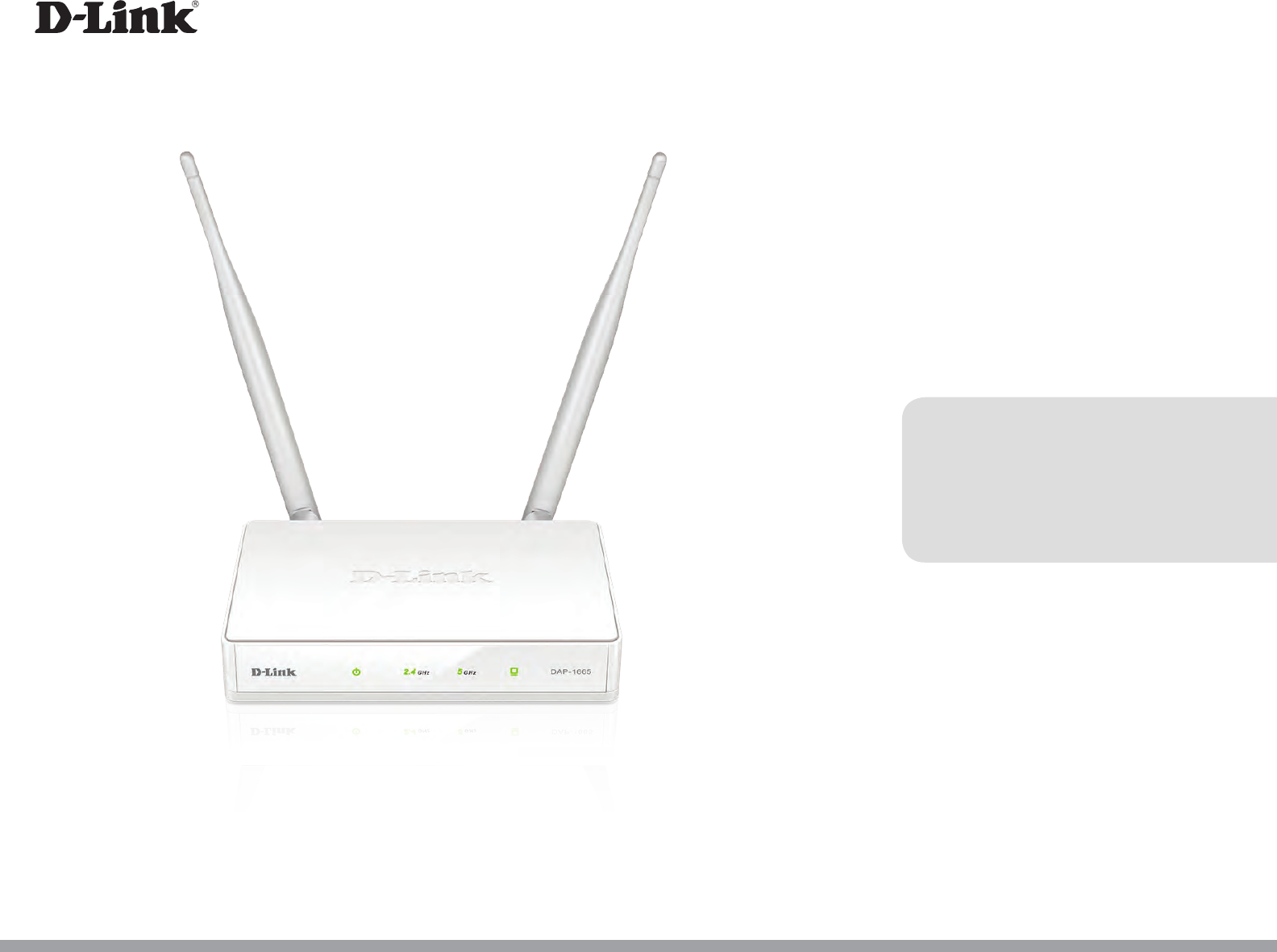
DAP-1665 AC1200 Wi-Fi Range Extender/Access Point
DAP-1665
User Manual
Version 1.20 |10/20/2016
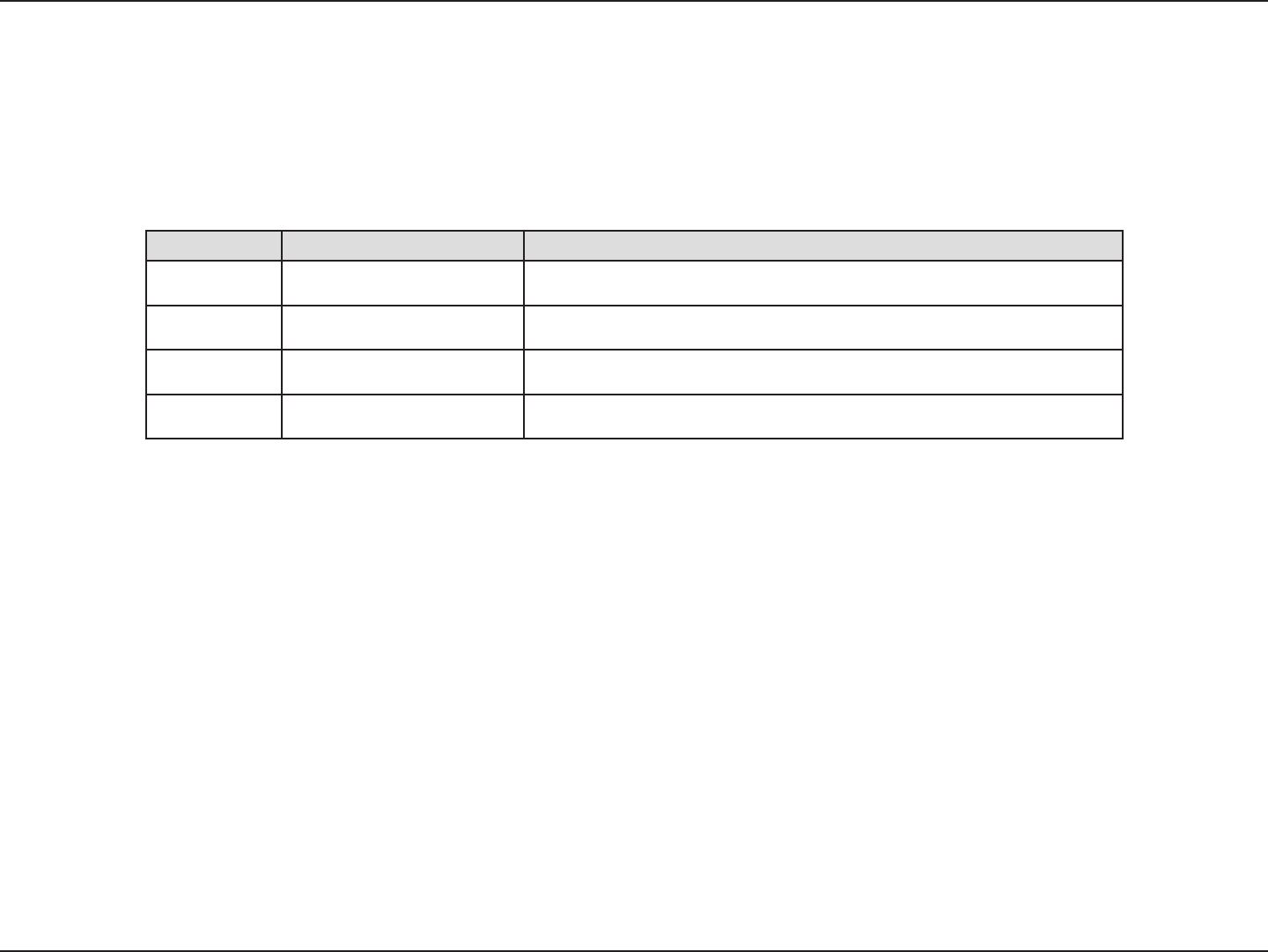
iiD-Link DAP-1665 User Manual
Section 1 - Product Overview
D-Link reserves the right to revise this publication and to make changes in the content hereof without obligation to notify any
person or organization of such revisions or changes.
Manual Revisions
Trademarks
D-Link and the D-Link logo are trademarks or registered trademarks of D-Link Corporation or its subsidiaries in the United States or other countries.
All other company or product names mentioned herein are trademarks or registered trademarks of their respective companies.
Apple®, Apple logo®, Safari®, iPhone®, iPad®, iPod touch® and Macintosh® are trademarks of Apple Inc., registered in the U.S. and other countries. App
StoreSM is a service mark of Apple Inc. Chrome™ browser, Google Play™ and Android™ are trademarks of Google Inc. Internet Explorer®, Windows®
and the Windows logo are trademarks of the Microsoft group of companies.
Copyright © 2016 by D-Link Corporation, Inc.
All rights reserved. This publication may not be reproduced, in whole or in part, without prior expressed written permission from D-Link Corporation, Inc.
Power Usage
This device is an Energy Related Product (ErP) that automatically switches to a power-saving Network Standby mode within 1 minute of no
packets being transmitted. It can also be turned o through a power switch to save energy when it is not needed.
Network Standby: 2.56 watts
Switched O: 0.07 watts
Preface
Revision Date Description
1.00 October 1, 2013 • Initial release
1.01 September 30, 2014 • Add Power Usage
1.10 April 21, 2016 • Updated FCC statement
1.20 October 19, 2016 • B1 rmware release

iiiD-Link DAP-1665 User Manual
Table of Contents
Preface ................................................................................ii
Manual Revisions .......................................................................... ii
Trademarks ..................................................................................... ii
Power Usage ................................................................................... ii
Product Overview ..............................................................4
Package Contents ......................................................................... 4
System Requirements .................................................................5
Introduction ................................................................................... 6
Features ............................................................................................7
Hardware Overview ..................................................................... 8
Connections ...........................................................................8
LEDs ........................................................................................... 9
WPS Button ...........................................................................10
Installation .......................................................................11
Operation Modes ........................................................................ 11
Access Point Mode .............................................................12
Wireless Client Mode .........................................................13
Repeater Mode ....................................................................14
Bridge Mode .........................................................................15
Bridge with AP Mode ........................................................16
WISP Client Router Mode ................................................. 17
WISP Repeater Mode .........................................................18
Wireless Installation Considerations ....................................19
Conguration ...................................................................20
Web-based Setup .......................................................................21
Setup Wizard ........................................................................22
Access Point Mode ........................................................23
Repeater Mode ...............................................................25
Wi-Fi Client Mode ..........................................................31
Extender ......................................................................................... 36
Settings ..................................................................................36
Access Point Mode ........................................................37
Repeater Mode ...............................................................43
Wi-Fi Client .......................................................................47
Bridge .................................................................................48
Bridge with AP Mode....................................................51
WISP Client .......................................................................56
WISP Repeater ................................................................. 57
Network Settings ........................................................................61
IPv4 ..........................................................................................62
Static IP ..............................................................................62
Dynamic IP (DHCP) ........................................................64
IPv6 ..........................................................................................65
Autoconguration (SLAAC/DHCPv6) ......................65
Static IPv6 .........................................................................66
Local Connectivity Only...............................................67
Management ................................................................................ 68
Time & Schedule .................................................................68
Log ...........................................................................................70
Admin .....................................................................................71
System ....................................................................................72
Upgrade .................................................................................73
Table of Contents

ivD-Link DAP-1665 User Manual
Table of Contents
Statistics .................................................................................74
Connecting to a Wireless Network .................................75
WPS Button ...................................................................................75
Mac OS ............................................................................................76
Windows® 10 ................................................................................78
Windows® 8 ...................................................................................80
Windows® 7 ...................................................................................84
Windows Vista® ...........................................................................86
Troubleshooting ..............................................................88
Technical Specications ..................................................92
GPL Code Statement........................................................93
Regulatory Statements .................................................106

4D-Link DAP-1665 User Manual
Section 1 - Product Overview
Note: Using a power supply with a dierent voltage rating than the one included with the DAP-1665 will cause damage and void the warranty
for this product.
1
The appearance of the external antennas may vary depending on region.
Product Overview
Package Contents
DAP-1665 AC1200 Wi-Fi Range Extender/Access Point
Ethernet Cable
Two Detachable Antennas1
Power Adapter
CD-ROM with Manual
If any of the above items are missing, please contact your reseller.

5D-Link DAP-1665 User Manual
Section 1 - Product Overview
System Requirements
Network Requirements
• An Ethernet-based Network
• IEEE 802.11ac/n/g/b/a wireless clients (AP/Repeater Mode)
• IEEE 802.11ac/n/g/b/a wireless network (Client/Bridge/Repeater
Mode)
• 10/100/1000 Mbps Ethernet
Web-based Conguration
Utility Requirements
Computer with the following:
• Windows®, Macintosh, or Linux-based operating system
• An installed Ethernet adapter
Browser Requirements:
• Internet Explorer® 10 or higher
• Firefox 28 or higher
• Chrome 28 or higher
• Safari 6.0 or higher
Windows® Users: Make sure you have the latest version of Java installed.
Visit www.java.com to download the latest version.

6D-Link DAP-1665 User Manual
Section 1 - Product Overview
Introduction
D-Link introduces the new D-Link DAP-1665 AC1200 Wi-Fi Range Extender/Access Point. With a maximum combined wireless
signal rate of up to 1200 Mbps1, the DAP-1665 expands high-speed wireless network access for your home or oce.
The DAP-1665 is compliant with the latest draft IEEE 802.11ac standard, which features beamforming and MU-MIMO for better
wireless performance. The DAP-1665 is also backward-compatible with 802.11n/g/b/a devices so older devices can easily
integrate into your network. The access point has the exibility to operate in 5 dierent modes: Access Point, Wireless Client,
Bridge, Bridge with AP, Repeater, WISP Client, and WISP Repeater. Its easy-to-use setup wizard makes sure that you will
be connected to a wireless network in minutes.
The DAP-1665 features Wi-Fi Protected Access (WPA-PSK/WPA2-PSK) to provide an enhanced level of security for wireless data
communications. The DAP-1665 also includes convenience features to keep your wireless connection safe from unauthorized
access. Finally, Wi-Fi Protected Setup (WPS) lets you easily set up your device in any mode by simply pressing a button.
1 Maximum wireless signal rate derived from draft 802.11ac specications. Actual data throughput will vary. Network conditions and environmental factors, including volume of
trac, building materials and construction, and network overhead, lower actual data throughput rate. Environmental factors will adversely aect wireless signal range. Wireless
range and speed rates are D-Link RELATIVE performance measurements based on the wireless range and speed rates of a standard Wireless N product from D-Link.

7D-Link DAP-1665 User Manual
Section 1 - Product Overview
• Faster Wireless Networking - Featuring Wireless AC, the DAP-1665 provides combined wireless speeds of up to 1200 Mbps1.
This capability allows users to participate in real-time activities online, such as video streaming, online gaming, and real-time
audio.
• Flexible Operation Modes - The DAP-1665 can operate as an Access Point, Repeater, Wireless Client, Bridge, Bridge with AP,
WISP Client, and WISP Repeater, meaning that you can customize its operation to suit your specic networking requirements.
• Gigabit Ethernet Port - The built-in Gigabit Ethernet port facilitates a wired connection of up to 1 Gbps, meaning that wired
devices can also take advantage of the DAP-1665’s high-speed wireless capabilities.
• Compatible with IEEE 802.11ac/n/g/b/a Devices - The DAP-1665 is still fully compatible with the 802.11n/g/b/a standards,
so it can connect with existing wireless adapters found on older devices.
• Robust Security - Support for industry-standard WPA/WPA2 security encryption, lets you rest assured your network is secure
from hackers.
• User-friendly Setup Wizard - Using its easy-to-use web-based user interface, the DAP-1665 lets you control what information
is accessible to those on the wireless network, whether from the Internet or from your company’s server. Congure your
access point to your specic settings within minutes.
Features
1 Maximum wireless signal rate derived from draft 802.11ac specications. Actual data throughput will vary. Network conditions and environmental factors, including volume of
network trac, building materials and construction, and network overhead, lower actual data throughput rate. Environmental factors will adversely aect wireless signal range.
Wireless range and speed rates are D-Link RELATIVE performance measurements based on the wireless range and speed rates of a standard Wireless N product from D-Link.
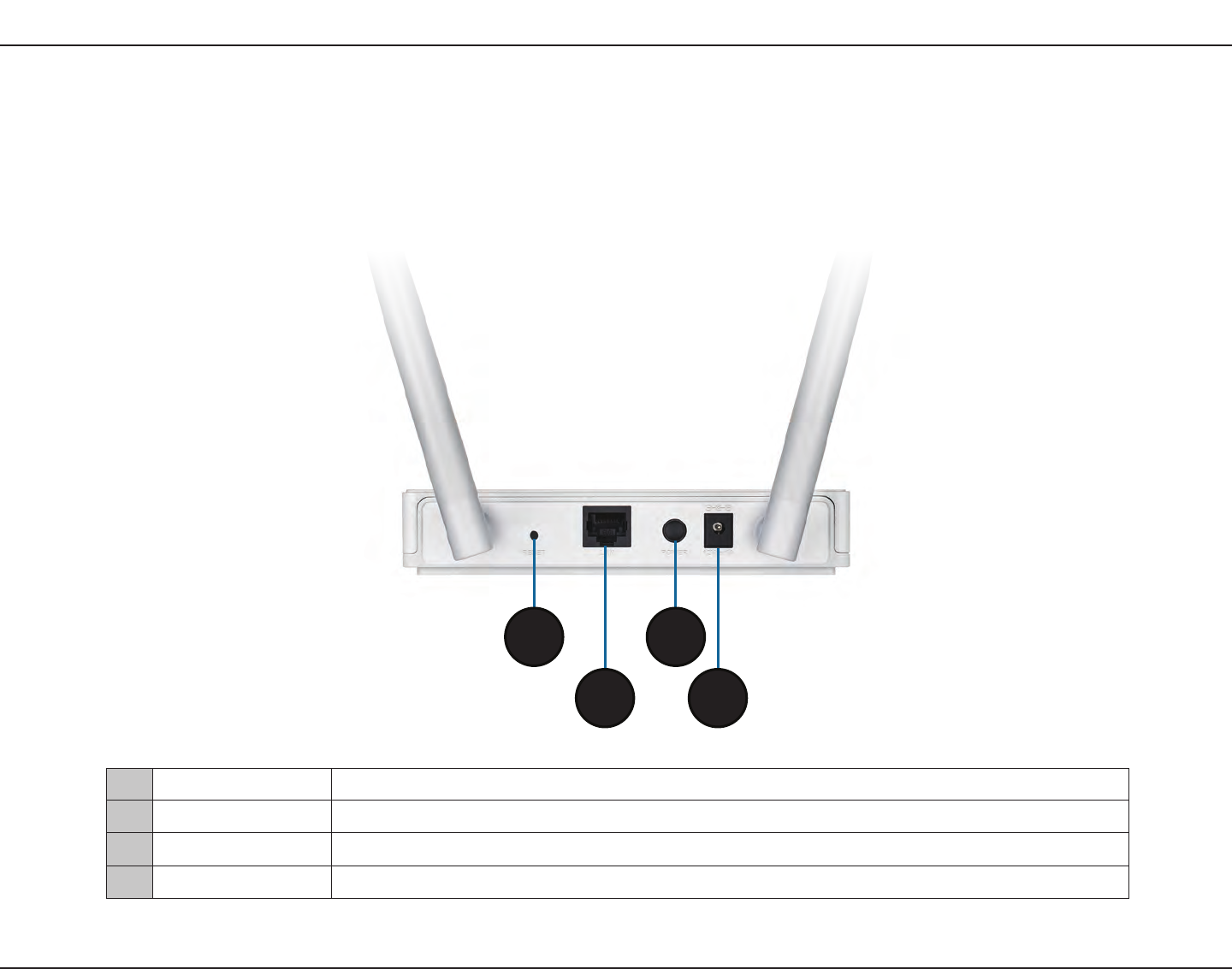
8D-Link DAP-1665 User Manual
Section 1 - Product Overview
Hardware Overview
Connections
1 Reset Button Press this button to restore the access point to its original factory default settings.
2 LAN Port Connect 10/100/1000 Ethernet devices such as computers, switches, and hubs.
3 Power Switch Press to power the unit on or o.
4 Power Receptor Receptor for the supplied power adapter.
1
2
3
4
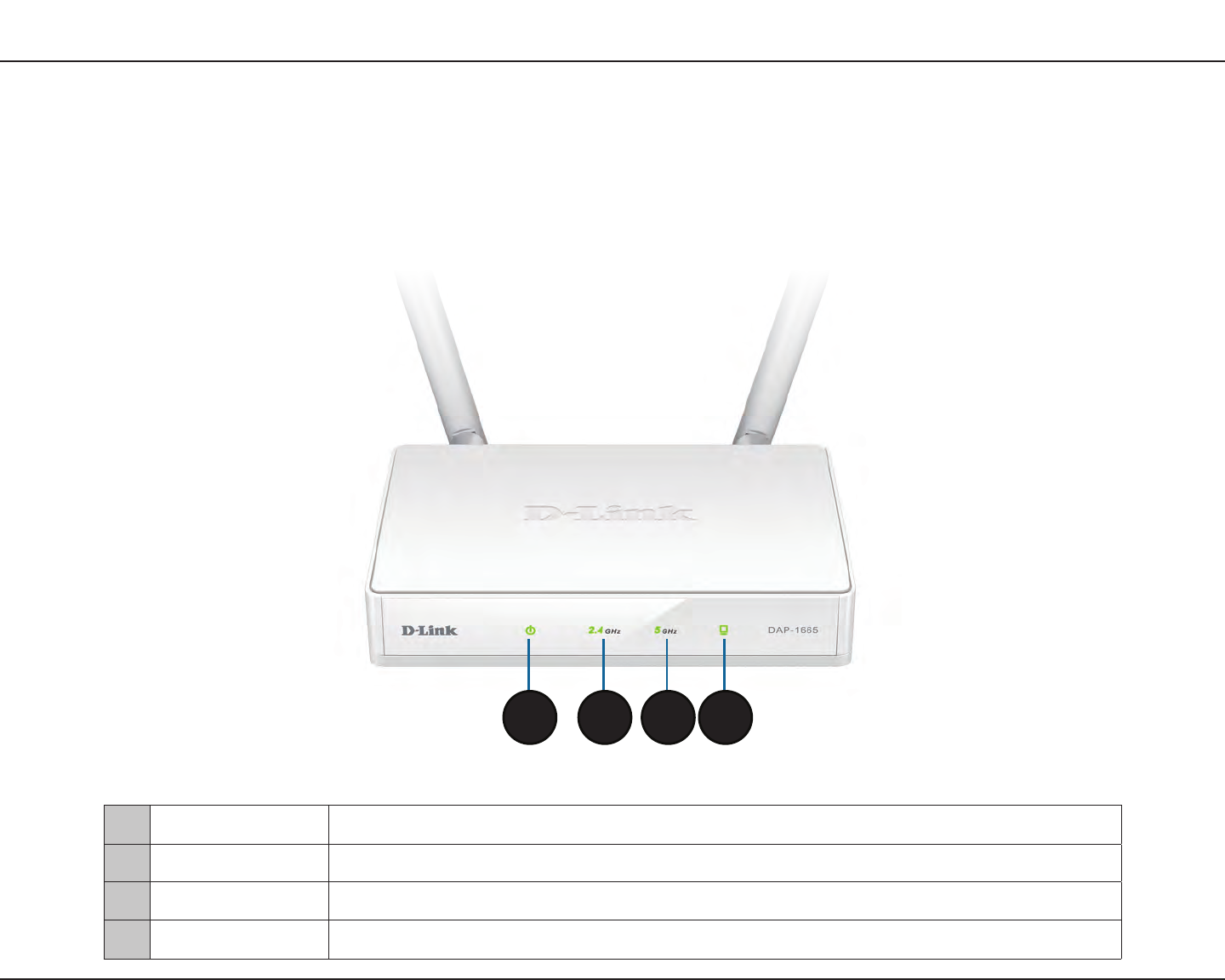
9D-Link DAP-1665 User Manual
Section 1 - Product Overview
Hardware Overview
LEDs
1
1 Power LED A solid green light indicates the device is receiving power.
22.4 GHz Wireless A solid green light indicates that the 2.4 GHz wireless band is active.
35 GHz Wireless A solid green light indicates that the 5 GHz wireless band is active.
4 LAN LED A solid green light indicates the LAN port connection is active.
2 3 4
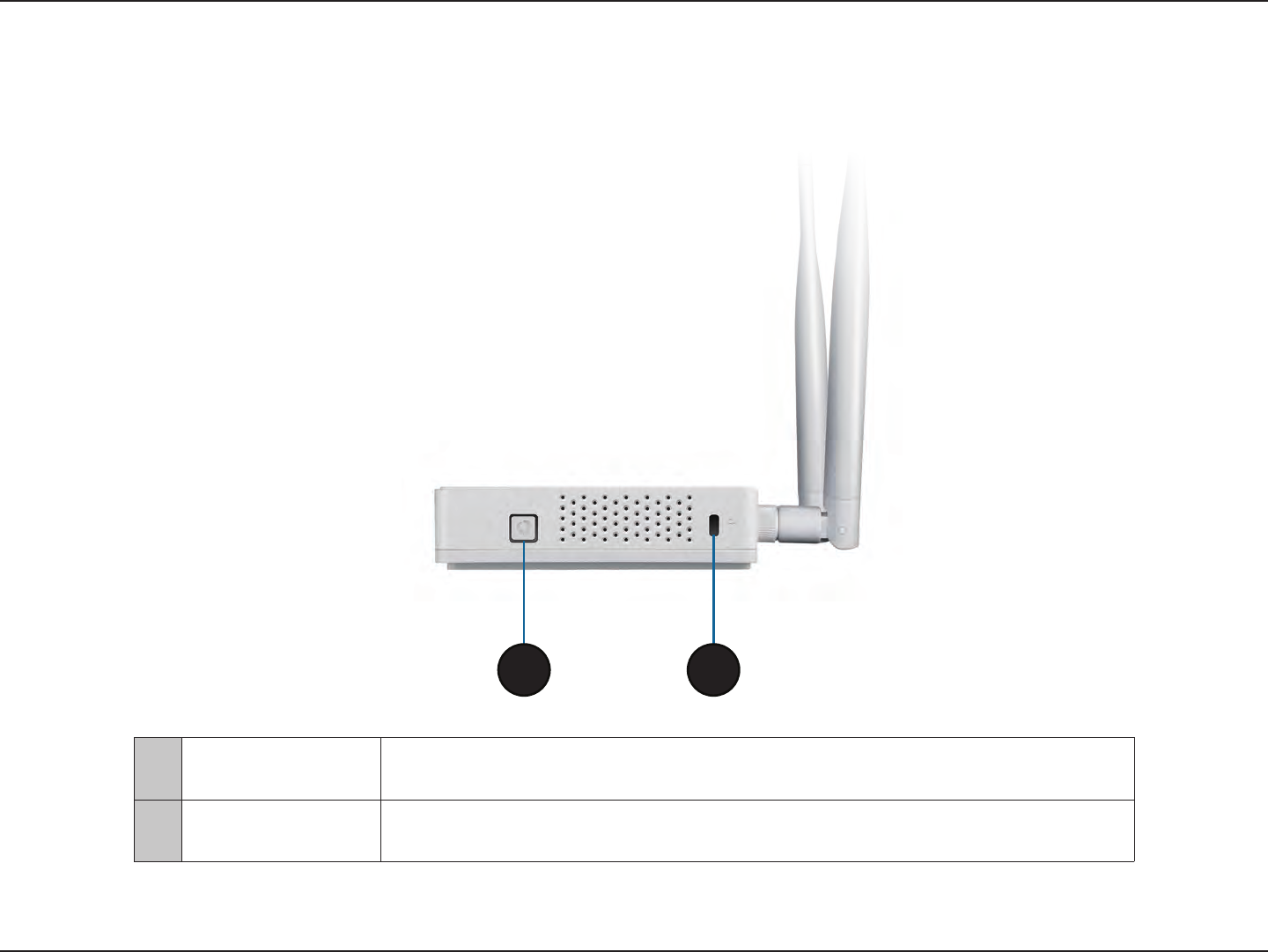
10D-Link DAP-1665 User Manual
Section 1 - Product Overview
Hardware Overview
WPS Button
1
1WPS Button Press this button to use WPS to establish a secure connection with other wireless
devices.
2 Kensington Slot Attach a Kensington® lock to protect your access point against theft.
2

11D-Link DAP-1665 User Manual
Section 2 - Installation
Installation
Please congure the DAP-1665 with a computer connected directly to the device. The following pages will explain the dierent
operational modes you can use.
Operation Modes
The DAP-1665 features a number of operation modes, enabling you to customize it to your networking requirements. Please
refer to the following sections to determine which mode is most suitable for your network.
• Access Point Mode on page 12
• Wireless Client Mode on page 13
• Repeater Mode on page 14
• Bridge Mode on page 15
• Bridge with AP Mode on page 16
• WISP Repeater Mode on page 18
• WISP Client Router Mode on page 17
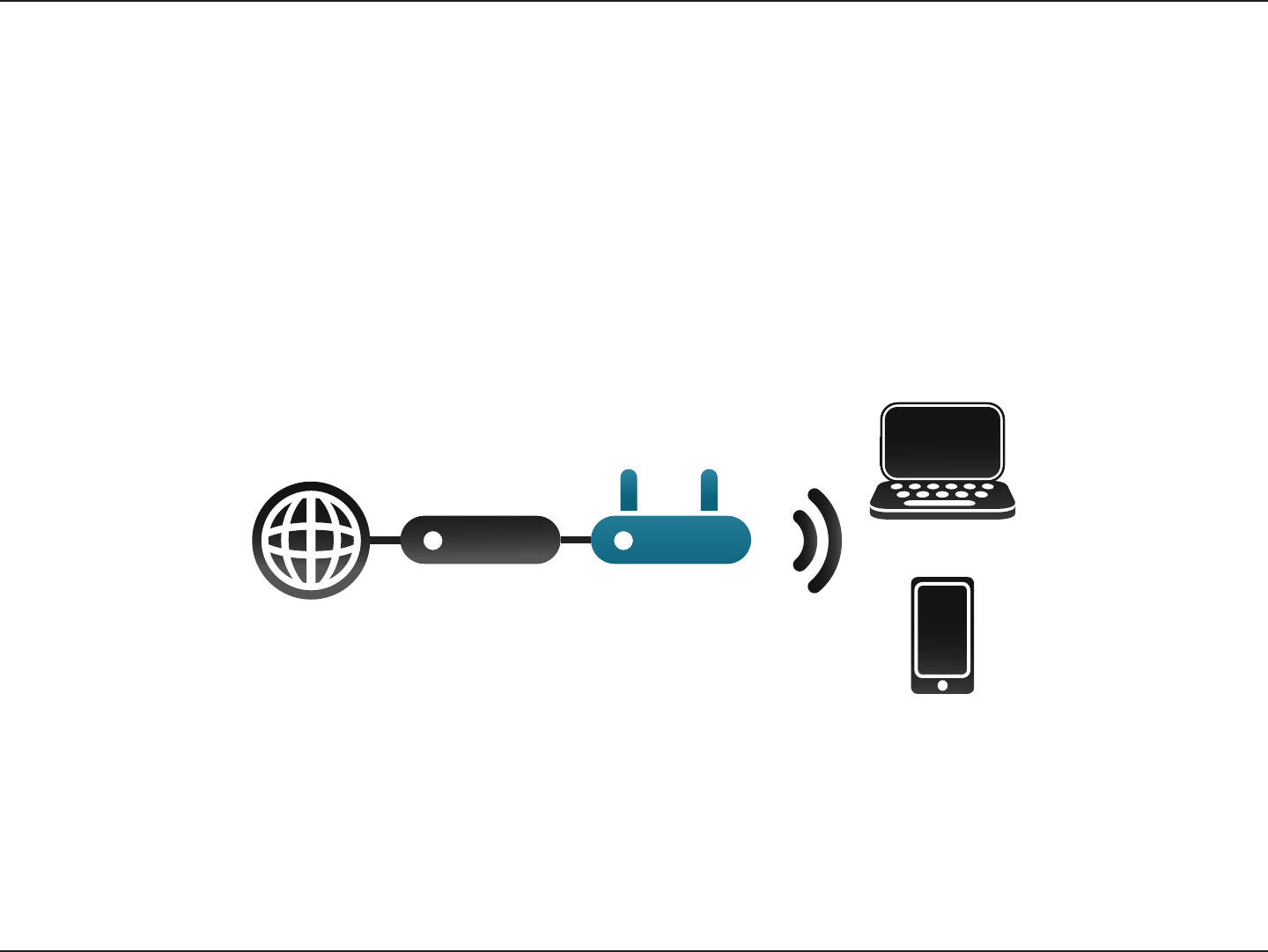
12D-Link DAP-1665 User Manual
Section 2 - Installation
Access Point Mode
Access Point (AP) mode adds wireless capability to your existing wired network. The DAP-1665 acts as a central connection
point for any computer (client) that has an 802.11ac or backwards compatible 802.11n/g/b/a wireless network interface and
is within range of the access point. Clients must connect to the network name (SSID) broadcast by the access point in order
to wirelessly access the network. If wireless security is enabled on the access point, the client will need to enter a password to
connect. In Access Point mode, multiple clients can connect wirelessly to the network at the same time.
Internet DAP-1665Router
Wireless Devices
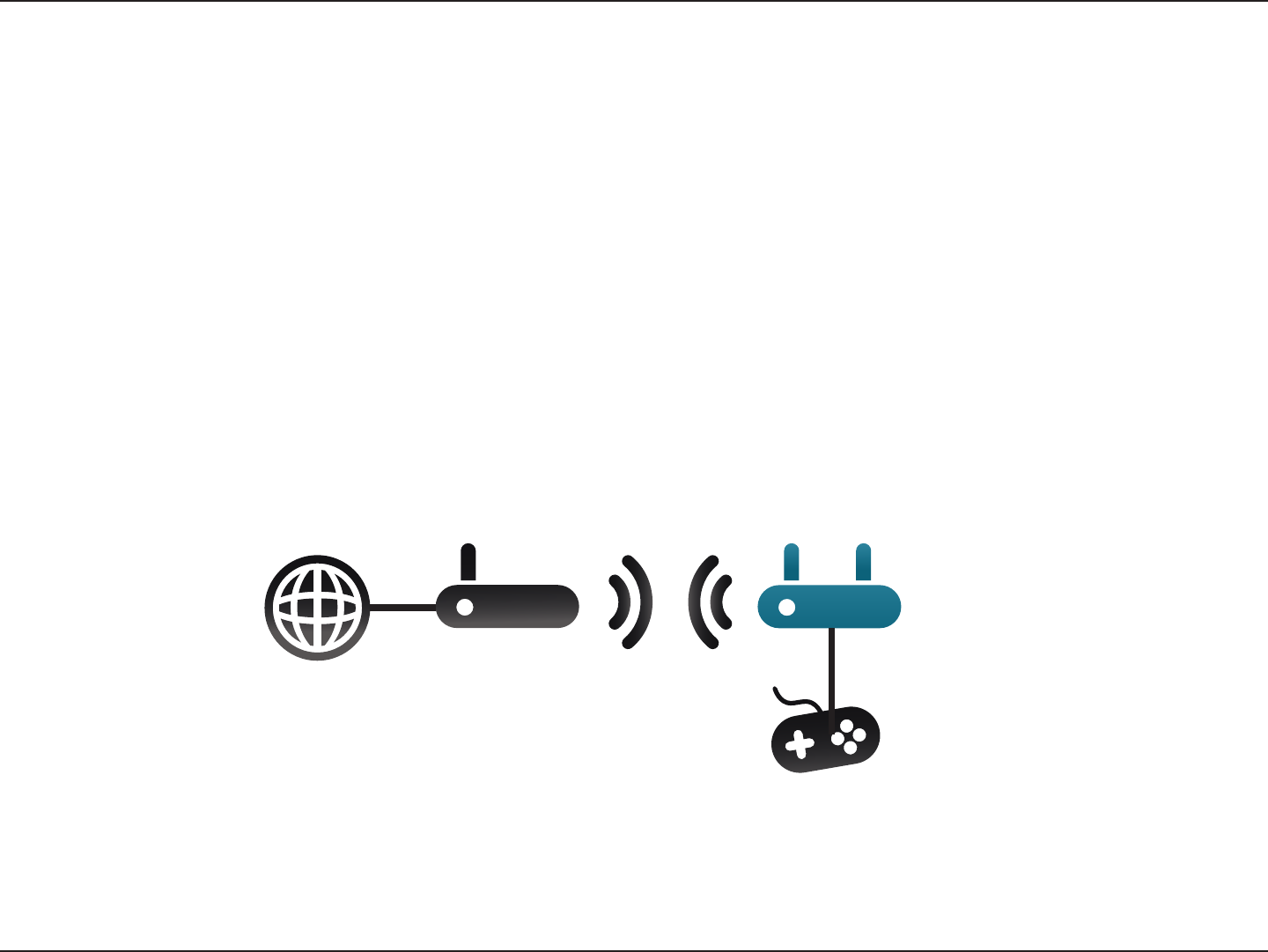
13D-Link DAP-1665 User Manual
Section 2 - Installation
Wireless Client Mode
In Wireless Client mode, the DAP-1665 acts as a wireless network adapter for your Ethernet-enabled device (such as a game
console or a TV set-top box). Connect your Ethernet-enabled device to the access point using an Ethernet cable, and enjoy
wired speeds of up to 1000 Mbps.
If you are going to connect several Ethernet-enabled devices to your DAP-1665, connect the LAN port of the DAP-1665 to an
Ethernet switch, then connect your devices to this switch.
Example: Connect a gaming console using an Ethernet cable to the DAP-1665. The unit is set to Wireless Client mode which
will wirelessly connect to a wireless router on your network.
Internet
Gaming Console
Wireless
Router
DAP-1665
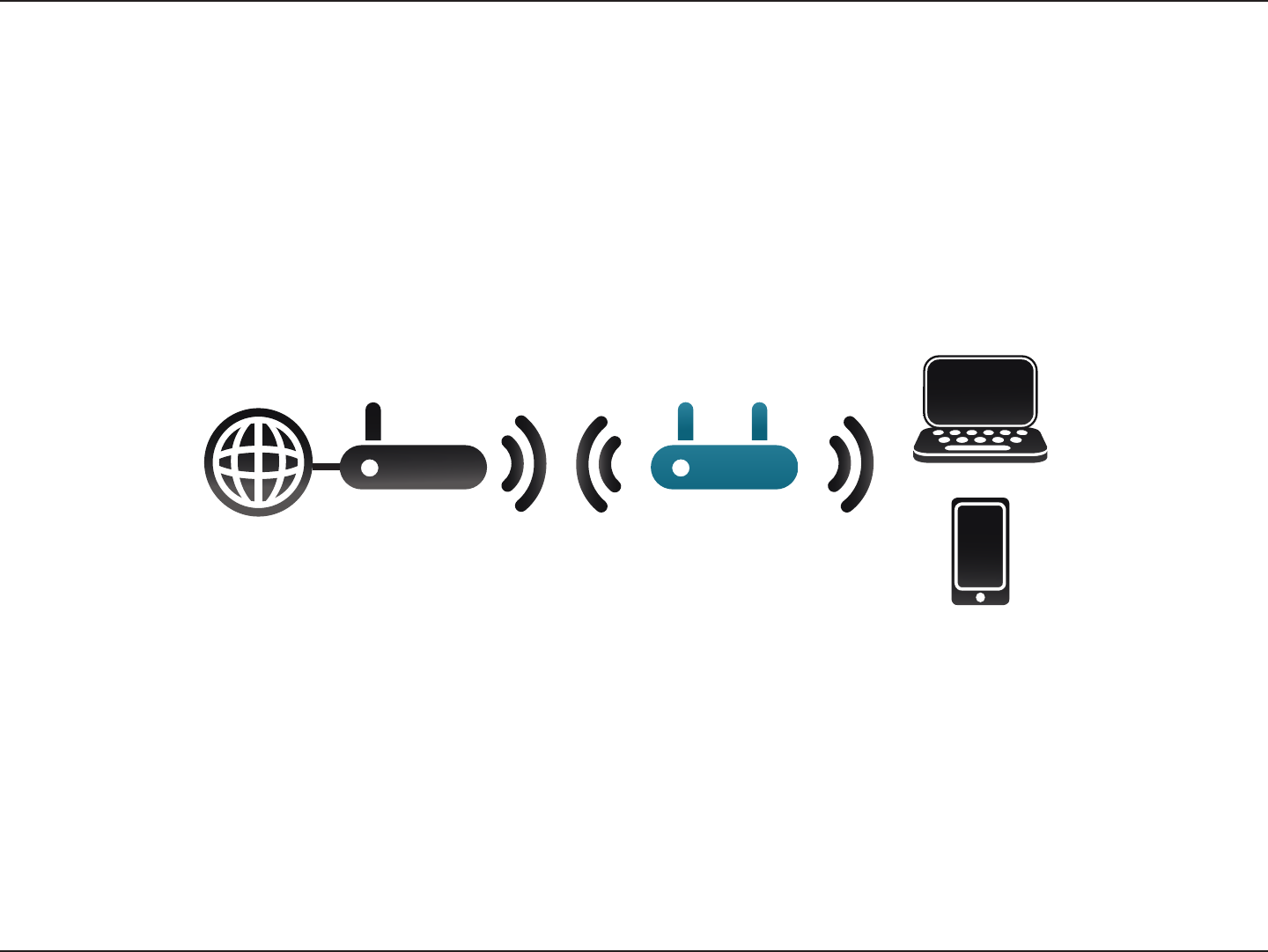
14D-Link DAP-1665 User Manual
Section 2 - Installation
Repeater Mode
In Repeater mode, the DAP-1665 extends the range of your existing wireless network by repeating the wireless signal of
another access point or wireless router. The DAP-1665 and wireless router (if used) must be within range of each other. The
extended wireless network can use the same SSID and security settings as the existing network, or you can choose to specify
a new network name and security method.
Internet DAP-1665
Wireless
Router
Wireless Devices
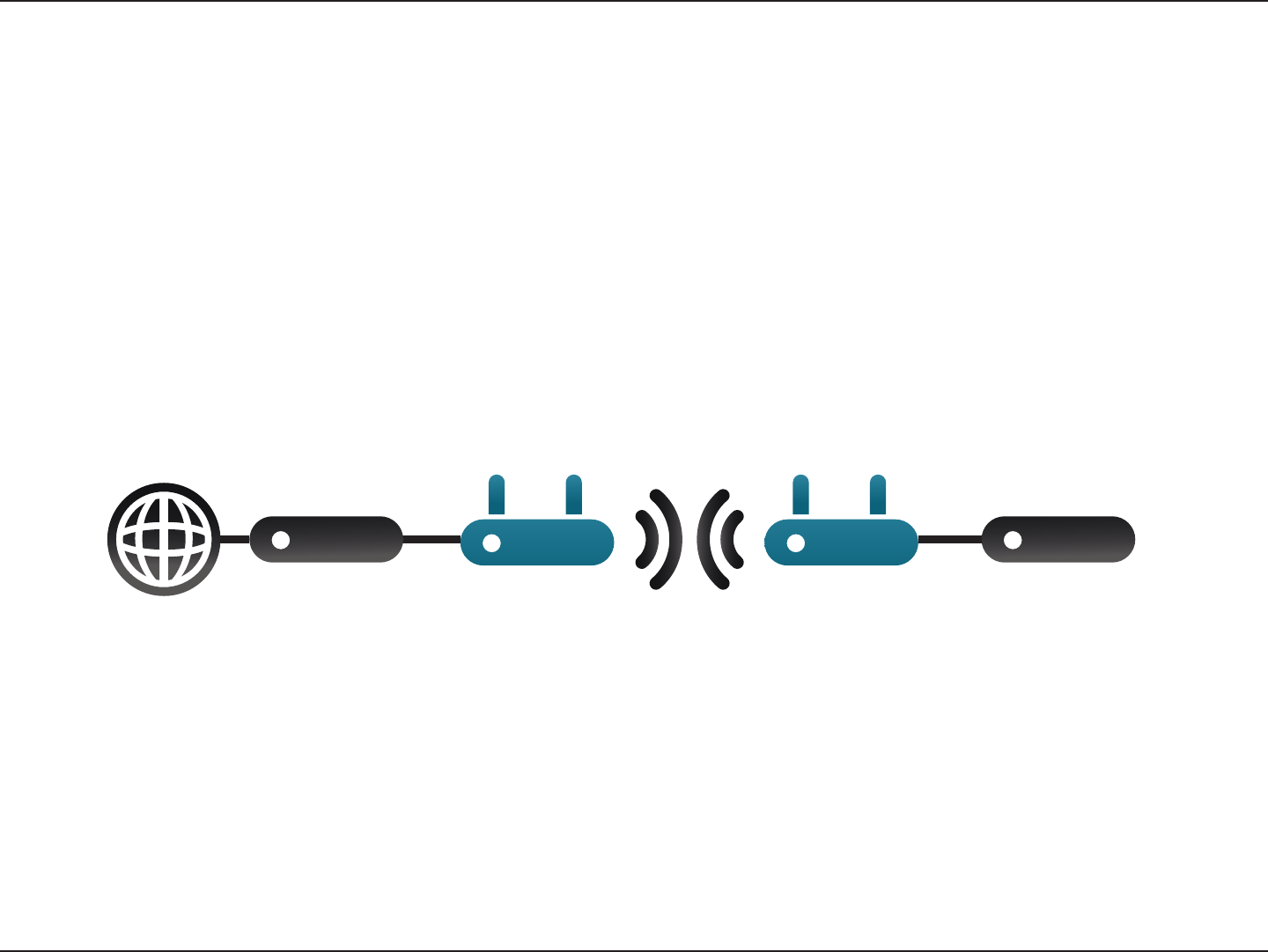
15D-Link DAP-1665 User Manual
Section 2 - Installation
Bridge Mode
In Bridge mode, the DAP-1665 creates a wireless link between two existing networks, enabling data to be shared between the
two networks without the need for a physical connection. The two networks must be within wireless reach of one another in
order for bridge mode to be eective.
Note: Bridge mode is not specied in the Wi-Fi or IEEE standards. This mode will only work using two DAP-1665 units. Compatibility
with other APs (even other D-Link APs) is not guaranteed.
Internet DAP-1665 DAP-1665 Router/
Switch
Router/
Switch
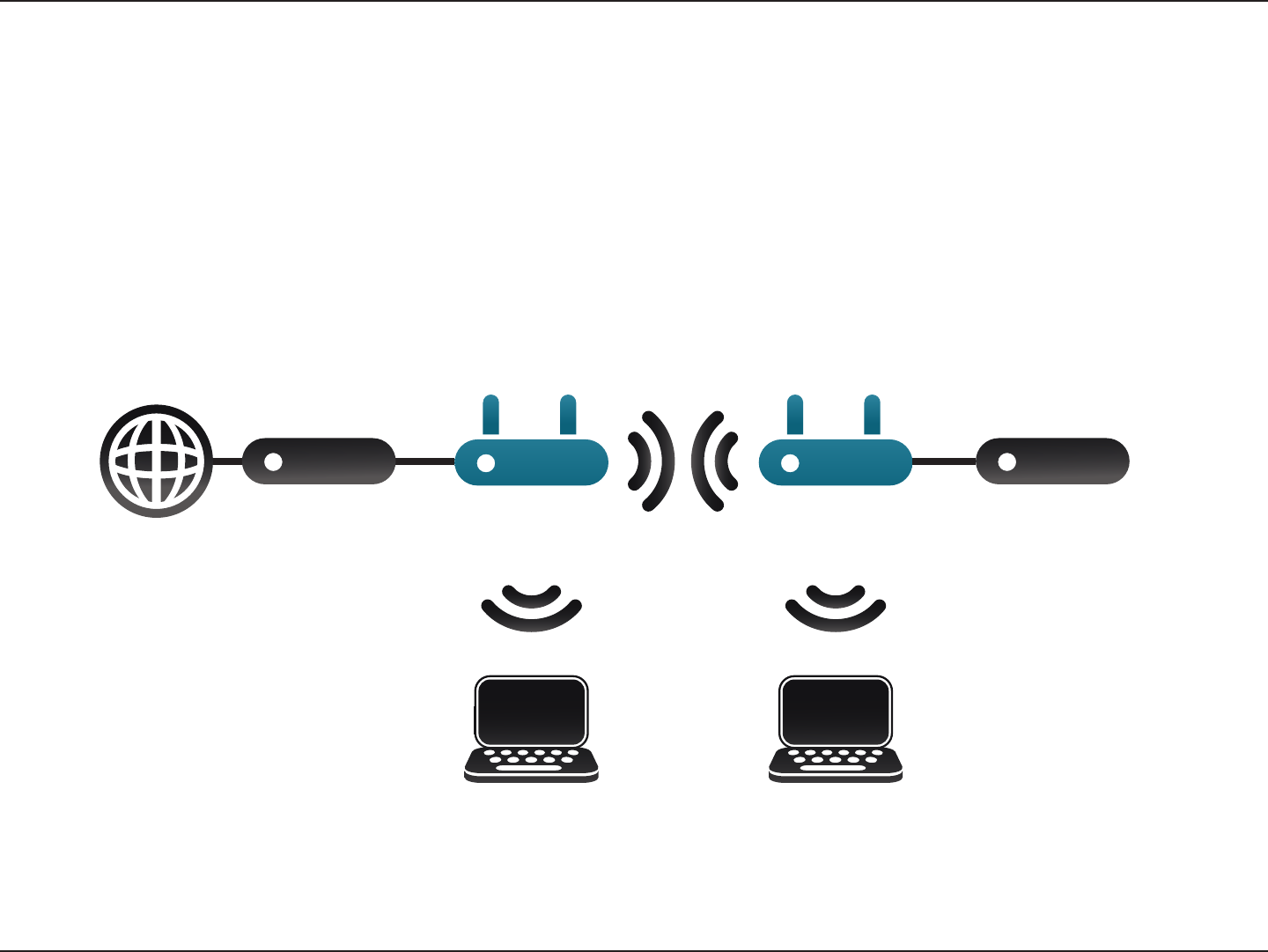
16D-Link DAP-1665 User Manual
Section 2 - Installation
Bridge with AP Mode
Bridge with AP mode has the same features of Bridge mode, but adds the functionality of Access Point mode, meaning that
wireless clients can connect to one of the DAP-1665s and have access to both networks via the wireless bridge.
Note: The Bridge with AP mode is not specied in the Wi-Fi or IEEE standards. This mode will only work using two DAP-1665 units.
Compatibility with other APs (even other D-Link APs) is not guaranteed.
Internet DAP-1665 DAP-1665 Router/
Switch
Router/
Switch
Wireless Devices Wireless Devices
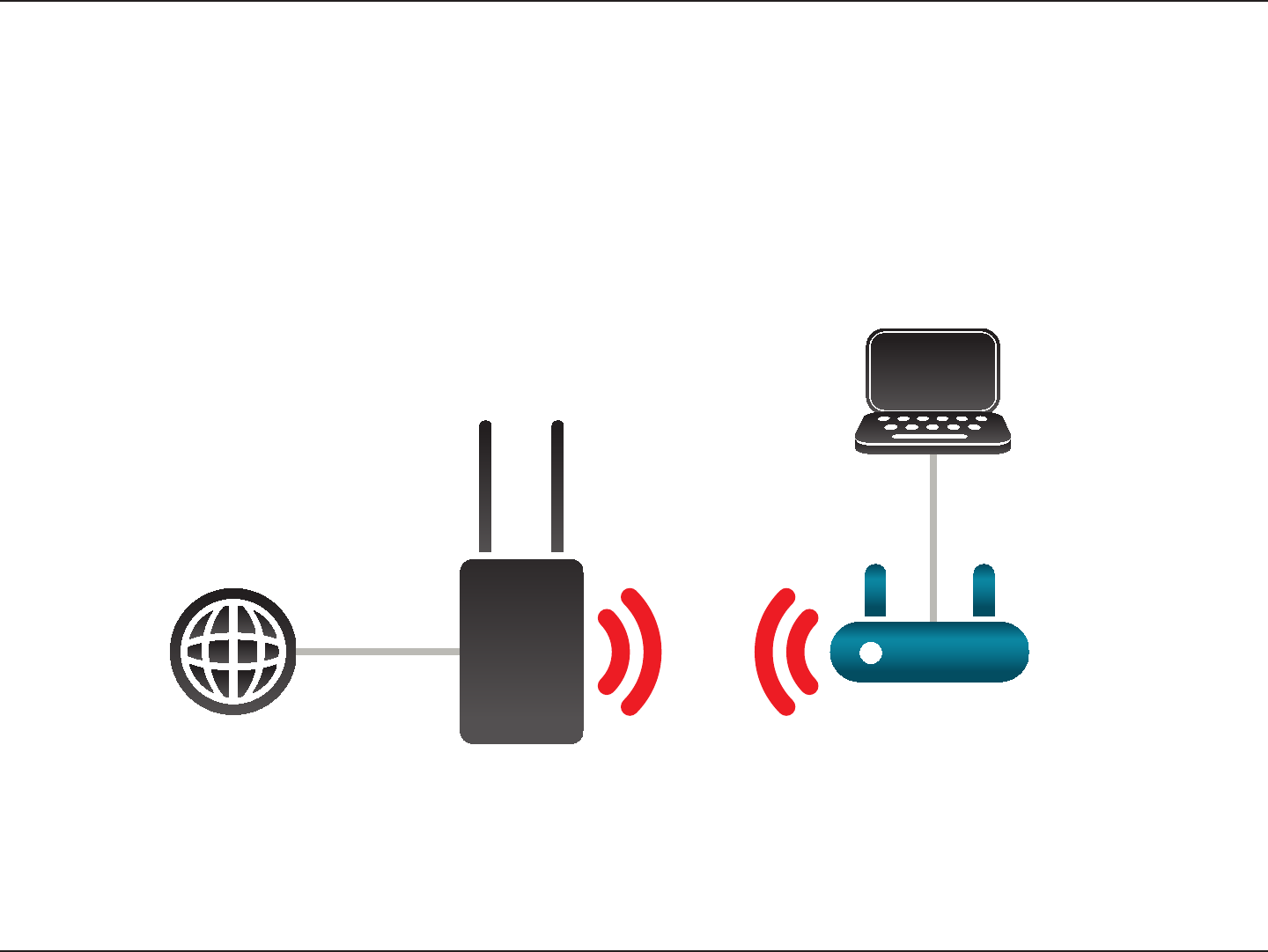
17D-Link DAP-1665 User Manual
Section 2 - Installation
WISP Client Router Mode
In the WISP Client Router mode, the DAP-1665 wirelessly connects to a WISP (Wireless Internet Service Provider) AP. In this
mode, the DAP-1665 also acts as a router for wired clients on your LAN and provides NAT (Network Address Translation) and
a DHCP server to generate IP addresses for wired clients only. NAT and the DHCP server allow many computers to share the
same wireless Internet connection.
If you are a WISP subscriber and want to access your WISP account using wired computers, connect your computers to the
DAP-1665 to get NAT, and then connect them to the WISP AP.
Internet
Computer
DAP-1360
(In WISP Client Mode)
WISP Outdoor AP
Connecting Wired PCs to the Internet Using the DAP-1665
DAP-1665
(in WISP Client Mode)
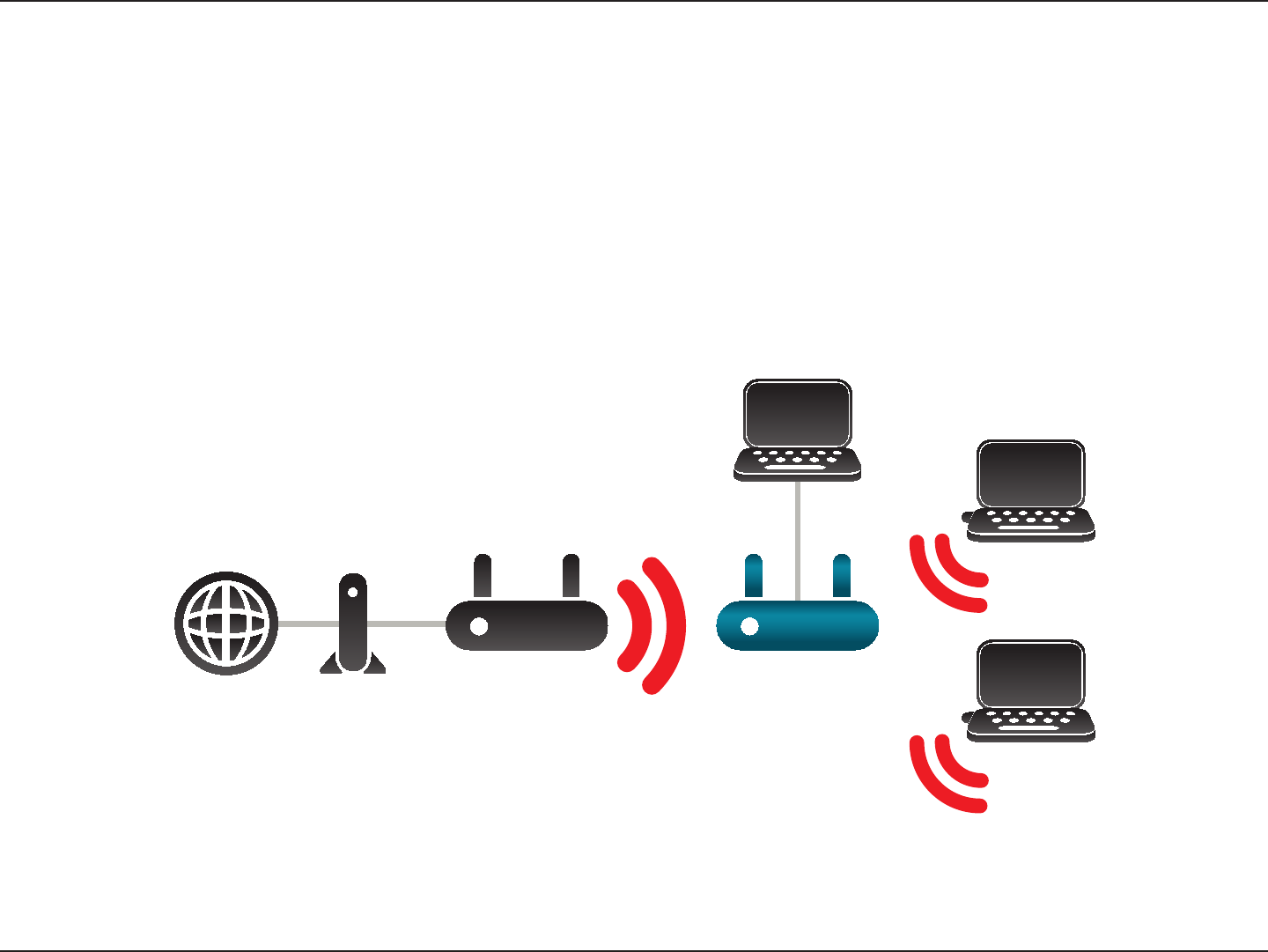
18D-Link DAP-1665 User Manual
Section 2 - Installation
WISP Repeater Mode
In the WISP Repeater mode, the DAP-1665 wirelessly connects to a WISP (Wireless Internet Service Provider) AP. In this mode,
the DAP-1665 also acts as a router for both wireless and wired clients on your LAN. The WISP Repeater mode provides NAT
(Network Address Translation) and a DHCP server to generate IP addresses for both wireless and wired clients. NAT and the
DHCP server allow many computers to share the same wireless Internet connection.
If you are a WISP subscriber and want to use your WISP account in your house, but the signals from the outdoor WISP AP are
not strong enough to reach all of the areas in the house, use the DAP-1665 to can extend the signals from the outdoor WISP
AP and provide access to wireless clients in your house. Using this mode, wireless as well as wired clients can connect to the
outdoor WISP AP through the DAP-1665.
Computer
InternetModemRouterDAP-1360
(In Repeater Mode)
Computer
Computer
Connecting Wired and Wireless PCs to the Internet Using the DAP-1665
DAP-1665
(in Repeater Mode)

19D-Link DAP-1665 User Manual
Section 2 - Installation
Wireless Installation Considerations
The DAP-1665 wireless access point lets you access your network using a wireless connection from virtually anywhere within
the operating range of the device. Keep in mind, however, that the number, thickness and location of walls, ceilings, or other
objects that the wireless signals must pass through, may limit the range. Typical ranges vary depending on the types of materials
and background RF (radio frequency) noise in your home or business. The key to maximizing wireless range is to follow these
basic guidelines:
1. Keep the number of walls and ceilings between the D-Link access point and other network devices to a minimum.
Each wall or ceiling can reduce your adapter’s range from 3-90 feet (1-30 meters.) Position your devices so that
the number of walls or ceilings is minimized.
2. Be aware of the direct line between network devices. A wall that is 1.5 feet thick (.5 meters), at a
45-degree angle appears to be almost 3 feet (1 meter) thick. At a 2-degree angle it appears over 42 feet (14
meters) thick! Position devices so that the signal will travel straight through a wall or ceiling (instead of at an
angle) for better reception.
3. Building materials make a dierence. A solid metal door or aluminum studs may have a negative eect on
range. Try to position access points, wireless routers, and computers so that the signal passes through drywall
or open doorways. Materials and objects such as glass, steel, metal, walls with insulation, water (sh tanks),
mirrors, le cabinets, brick, and concrete will degrade your wireless signal.
4. Keep your product away (at least 3-6 feet or 1-2 meters) from electrical devices or appliances that generate RF
noise.
5. If you are using 2.4 GHz cordless phones or X-10 (wireless products such as ceiling fans, lights, and home
security systems), your wireless connection may also be aected. Make sure your 2.4 GHz phone base is as far
away from your wireless devices as possible. The base transmits a signal even if the phone is not in use.
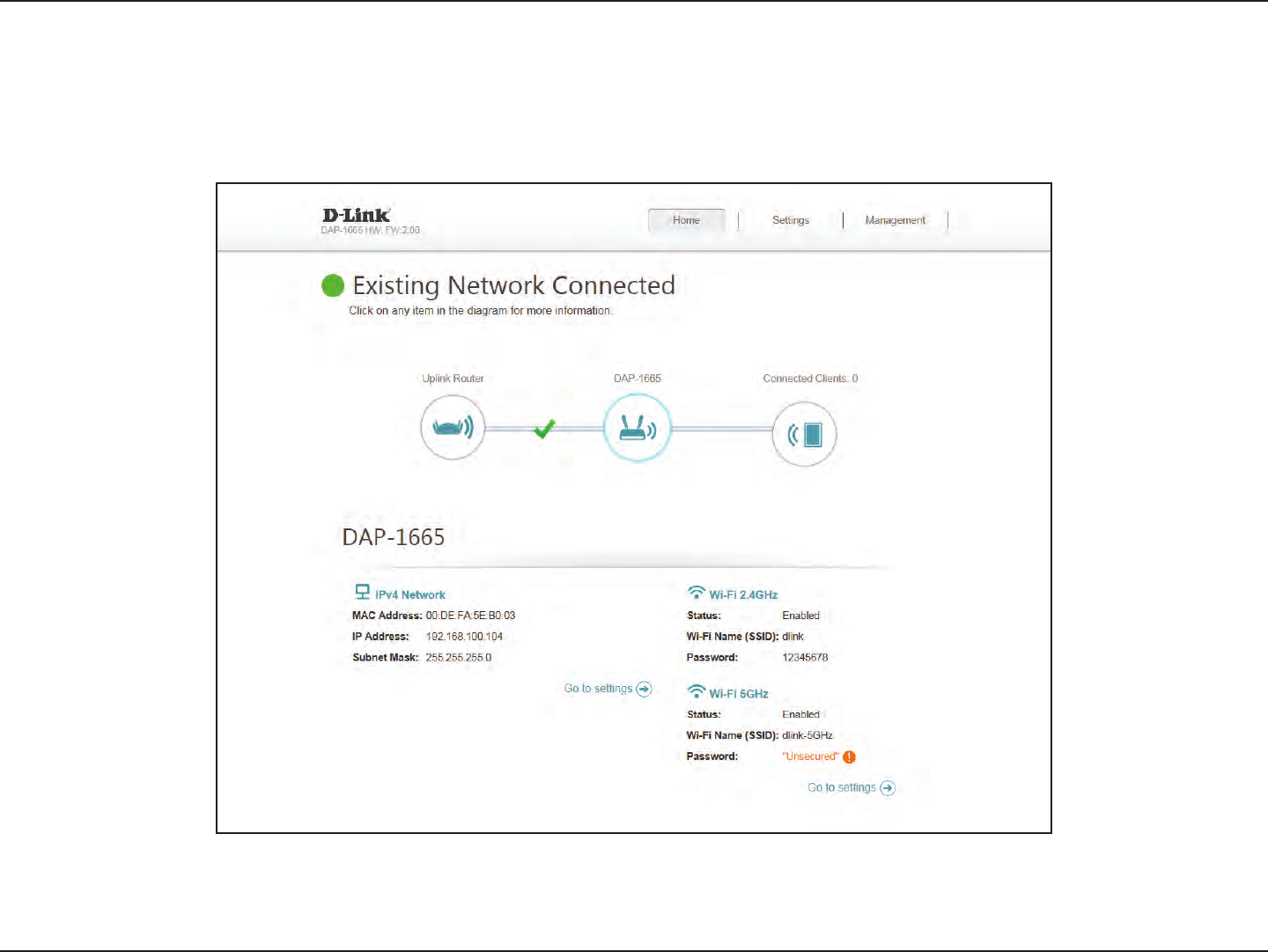
20D-Link DAP-1665 User Manual
Section 3 - Conguration
Conguration
This section will show you how to congure your D-Link wireless access point using the web-based conguration utility.
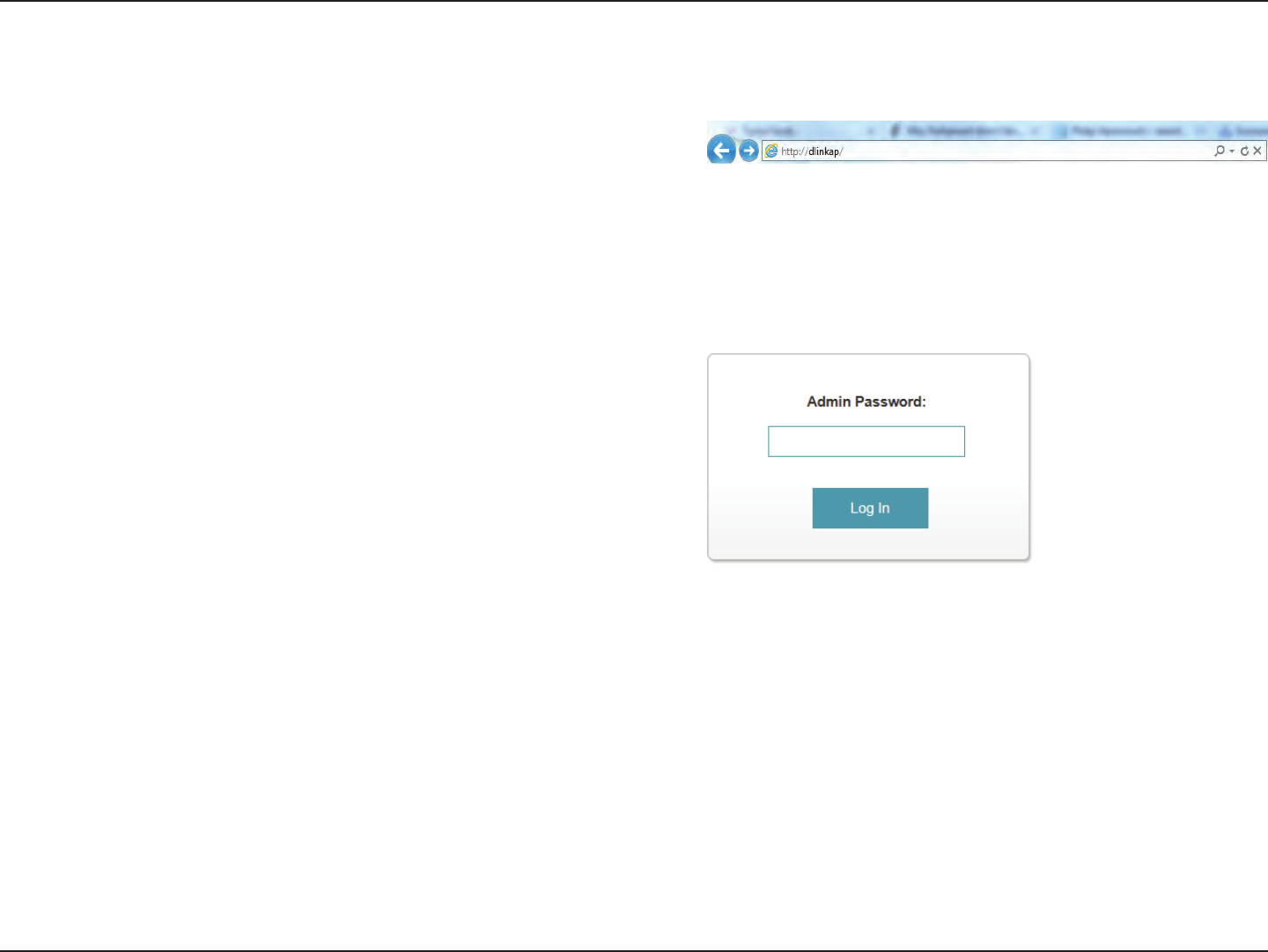
21D-Link DAP-1665 User Manual
Section 3 - Conguration
Web-based Setup
If you wish to change the default settings or adjust the conguration
of the DAP-1665, you may use the web-based conguration utility.
To access the conguration utility, open a web browser such as
Internet Explorer and enter http://dlinkap in the address eld.
If you have already run the setup wizard, enter your password in the
box. Otherwise, leave the password blank by default and click Log In.
If you get a Page Cannot be Displayed error, please refer to
Troubleshooting on page 89 for assistance.
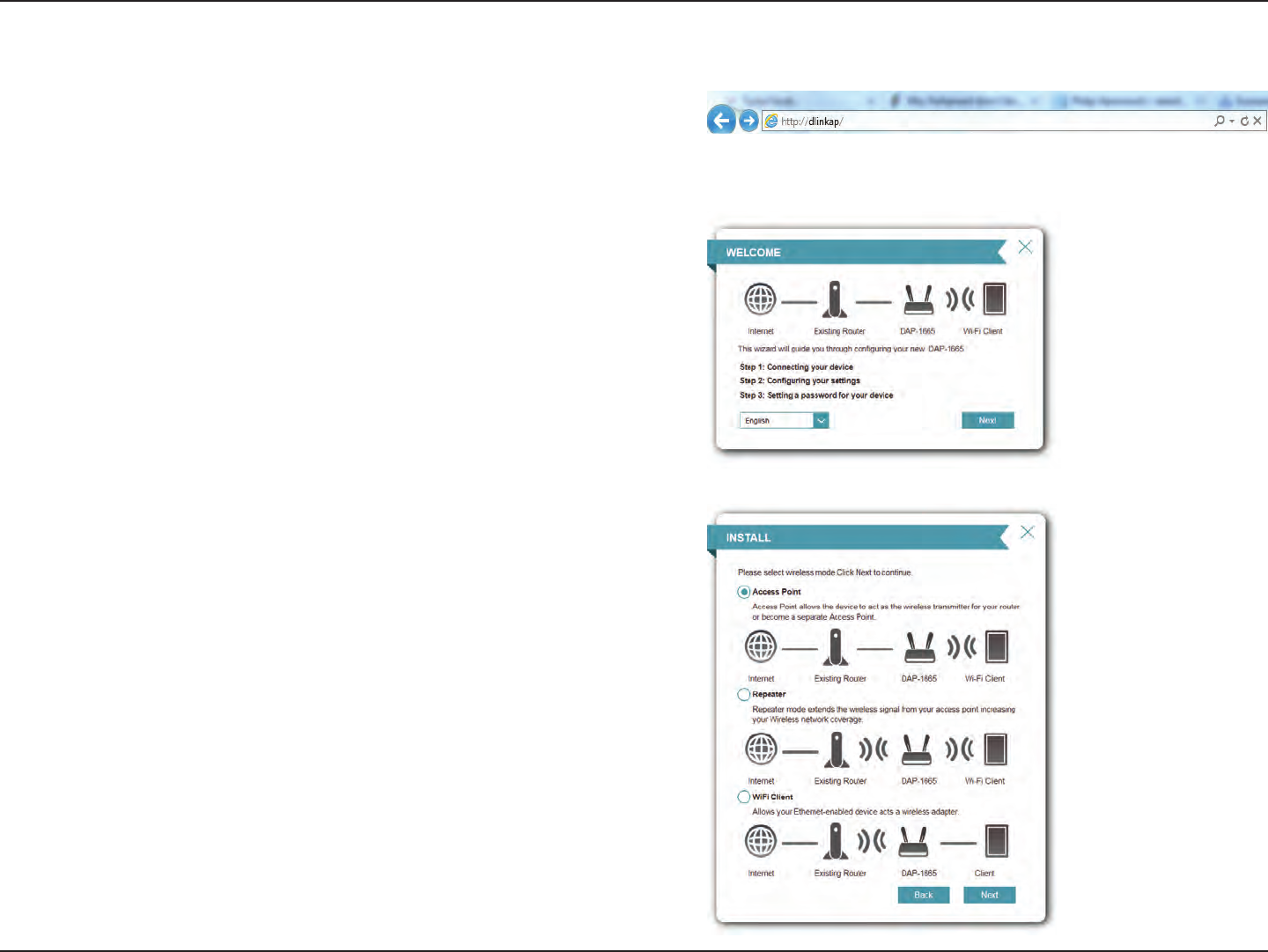
22D-Link DAP-1665 User Manual
Section 3 - Conguration
If this is the rst time you are setting up your DAP-1665, open a web
browser such as Internet Explorer and enter http://dlinkap in the
address eld to access the setup wizard.
Select a language from the drop-down menu and click Next to proceed
with the wizard.
If you want to congure the access point manually without running
the wizard, skip to Manual Conguration on page 36.
Setup Wizard
The next screen will display a list of modes for your DAP-1665 that
you may choose from. Click Next to continue.
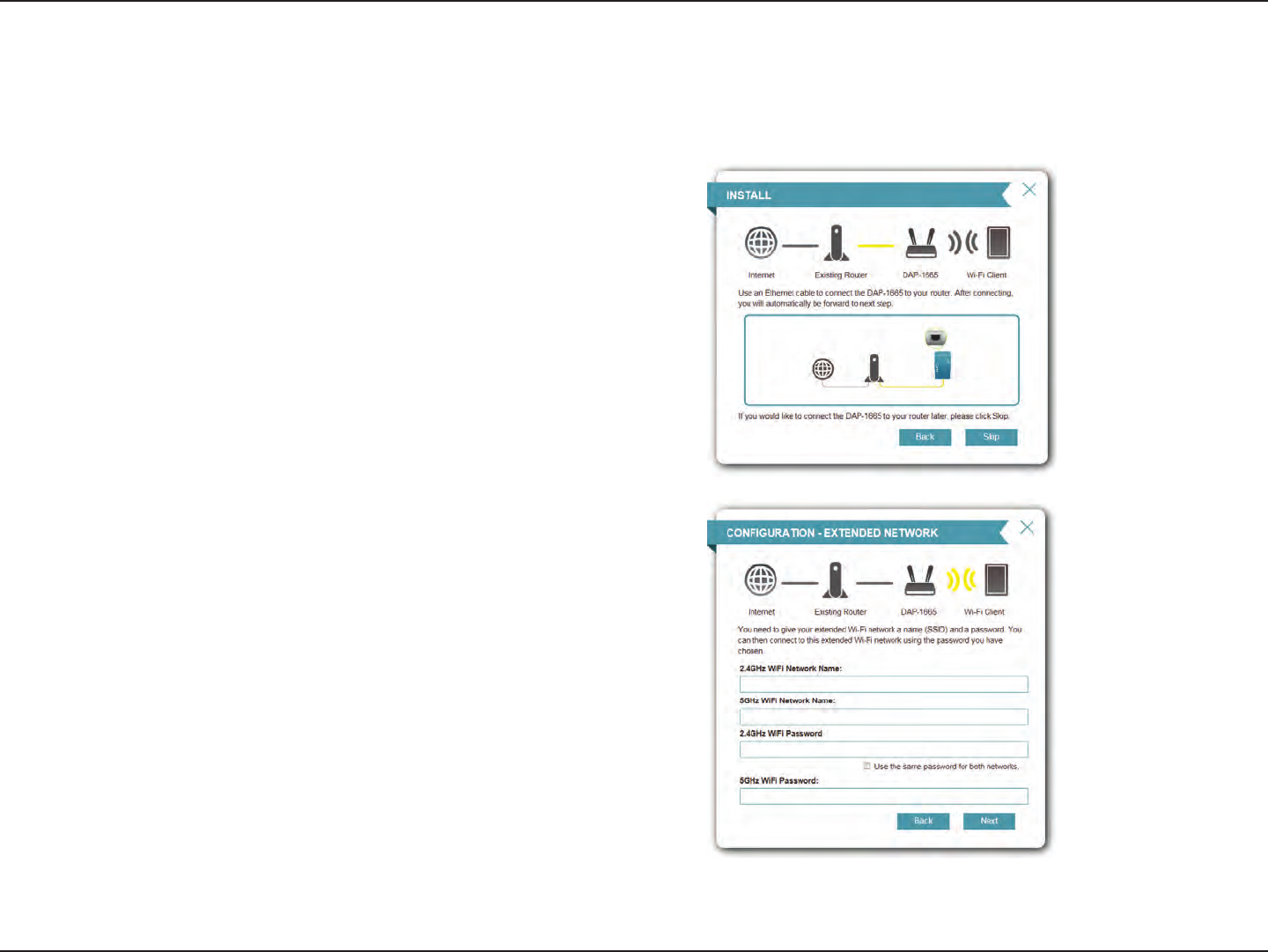
23D-Link DAP-1665 User Manual
Section 3 - Conguration
Access Point Mode
If you have already connected an Ethernet cable from your DAP-1665
to your router, the wizard will automatically detect it.
Click Skip to continue or Back to go back to the previous step.
This screen will help you to set a network name (SSID) and security
password for your wireless network. Specify an SSID for both the 2.4
GHz and 5 GHz bands (these names must not be the same). If you
wish to use the same wireless security password for both networks,
check the box and enter your desired password in the eld provided.
If you wish to use a dierent password for each network, uncheck the
box and enter the desired passwords in the 2.4 GHz Wi-Fi Password
and 5 GHz Wi-Fi Password elds.
Click Next to continue or Back to go back to the previous step.
This wizard is designed to assist you in conguring your DAP-1665 as a wireless access point for your existing network.
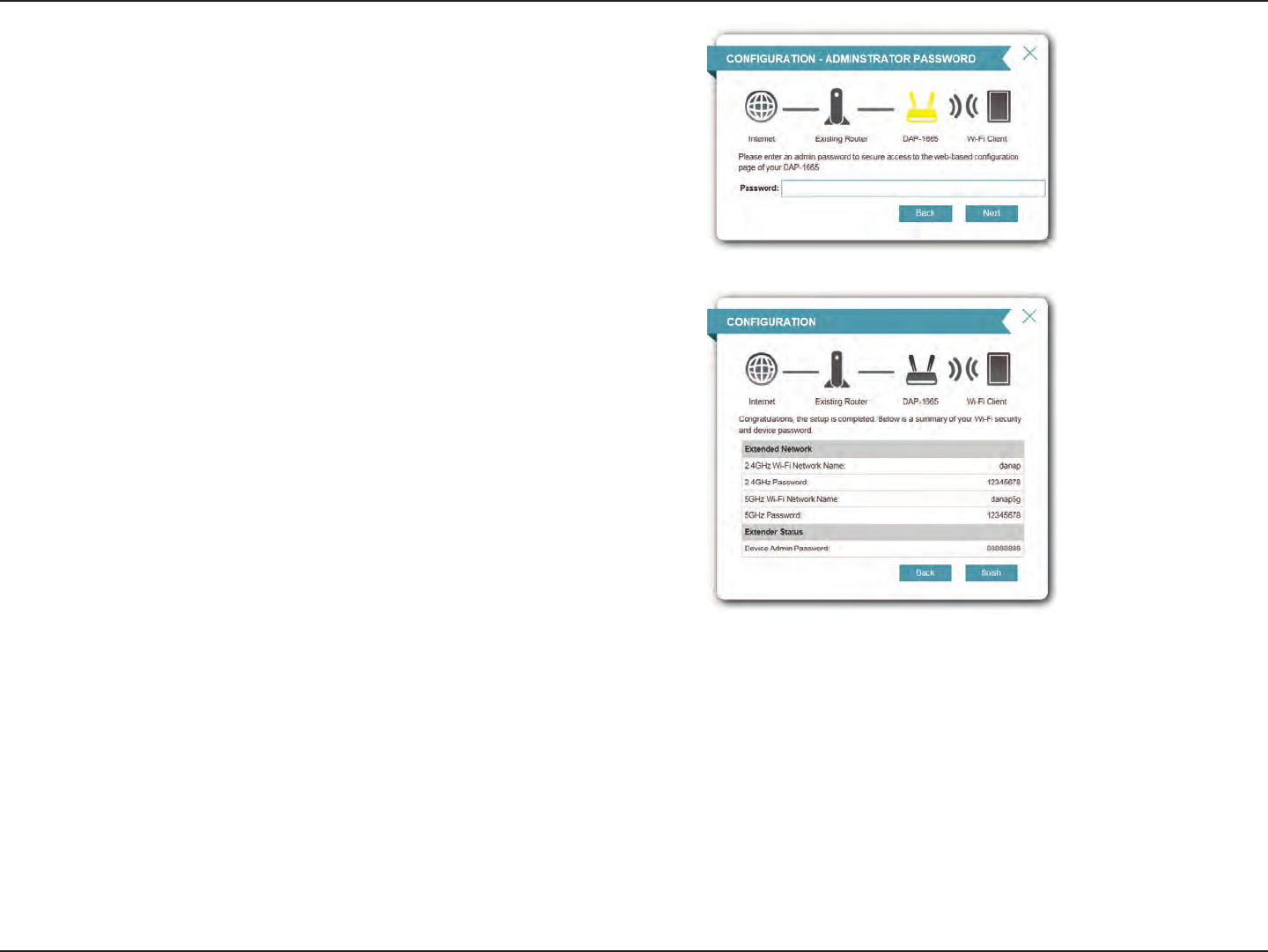
24D-Link DAP-1665 User Manual
Section 3 - Conguration
A summary page will be displayed, showing the current settings for
your 2.4 GHz and 5 GHz wireless networks. It is recommended that
you make a note of this information for future reference.
Click Finish to save your network settings.
In order for your network settings to take eect, the DAP-1665 will
reboot automatically.
When the device has nished rebooting the main screen will display.
Next, enter a password for your administrator account. This account
is used to log into the DAP-1665 for managing your network.
Click Next to proceed.
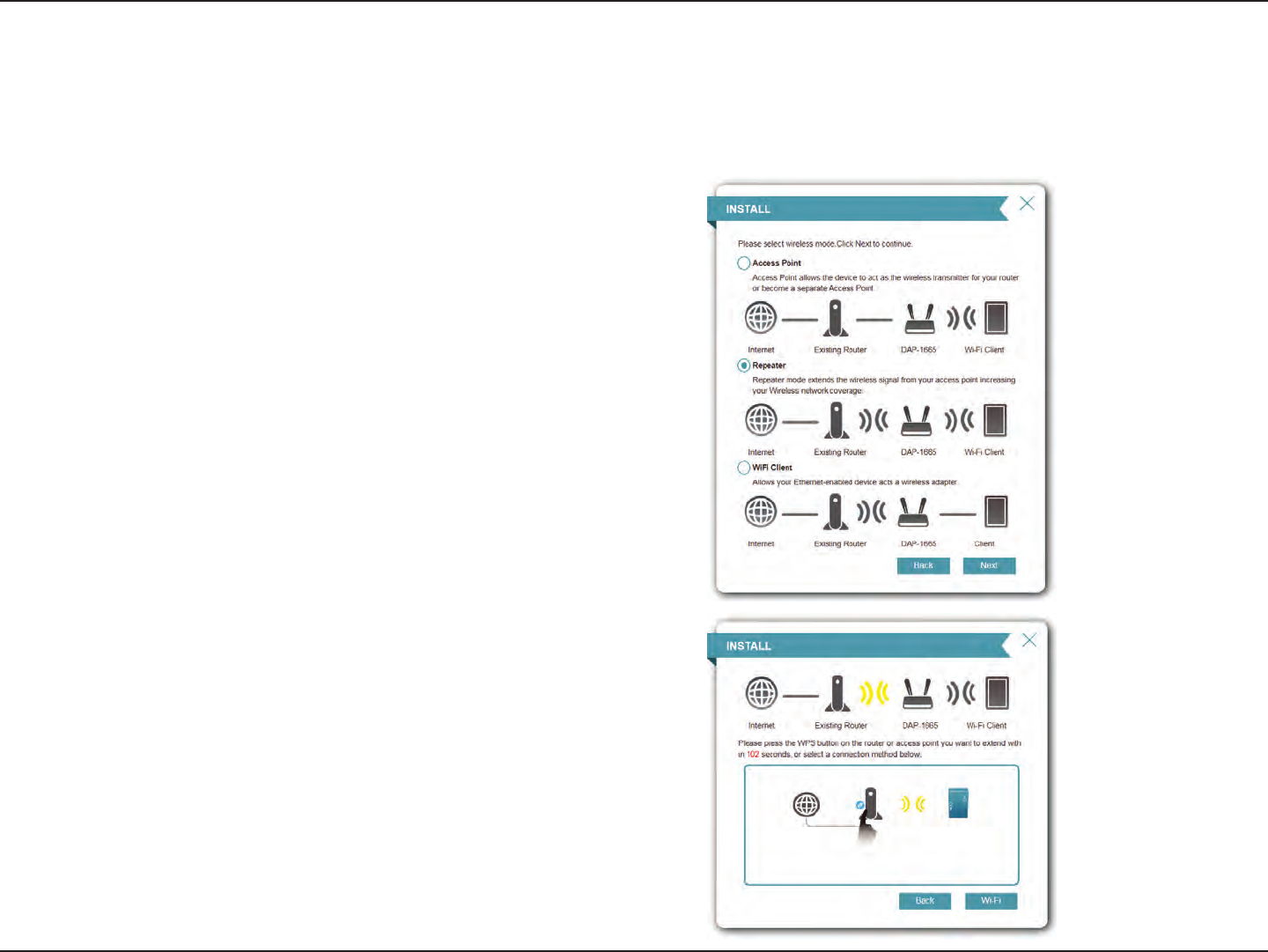
25D-Link DAP-1665 User Manual
Section 3 - Conguration
This wizard is designed to assist you in conguring your DAP-1665 as a repeater to extend the range of your existing wireless
network.
Repeater Mode
Select Repeater from the menu and click Next.
If your router does not support WPS, proceed to page 27.
Press the WPS Push Button on your existing wireless router with 120
seconds to complete the WPS setup process. A Retry button will
appear at the lower left if the time expired before you can press the
button.
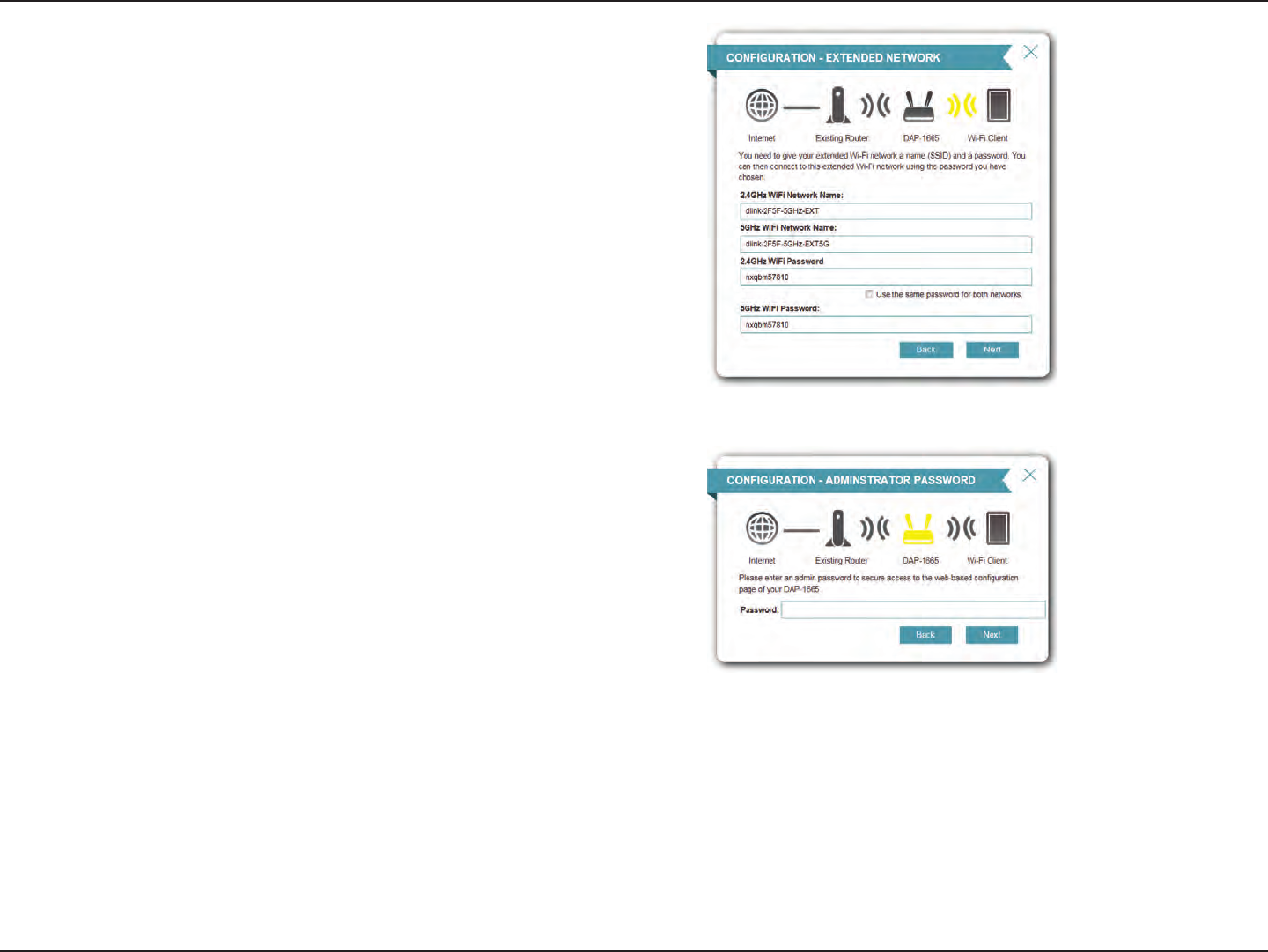
26D-Link DAP-1665 User Manual
Section 3 - Conguration
If a connection has been successfully made, click Next on the
following screen to complete the setup process.
Next, enter a password for your administrator account. This account
is used to log into the DAP-1665 for managing your network.
Click Next to proceed.
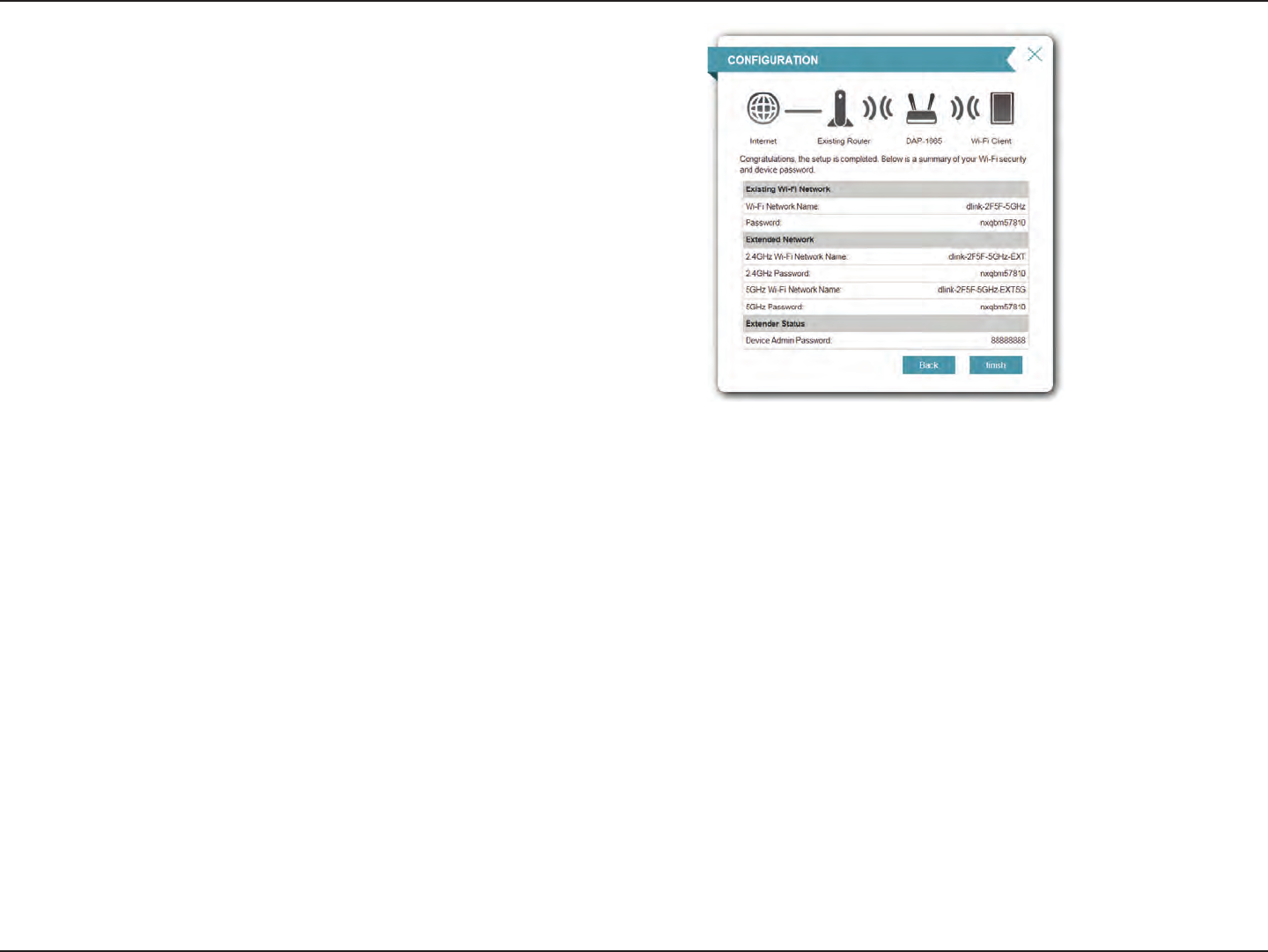
27D-Link DAP-1665 User Manual
Section 3 - Conguration
A summary page will be displayed, showing the current settings for
your 2.4 GHz and 5 GHz wireless networks. It is recommended that
you make a note of this information for future reference.
Click Finish to save your network settings.
In order for your network settings to take eect, the DAP-1665 will
reboot automatically.
When the device has nished rebooting the login page will display.
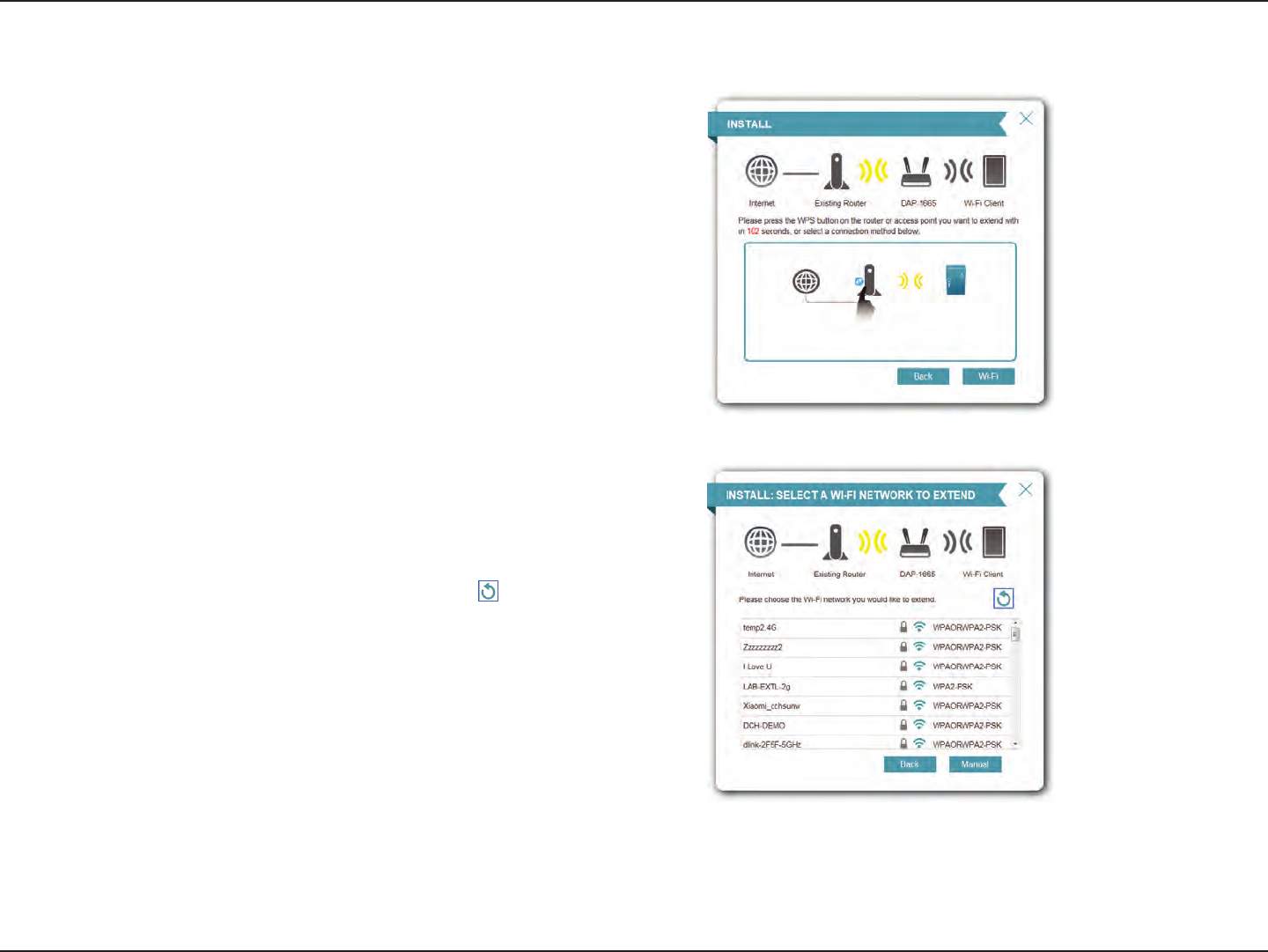
28D-Link DAP-1665 User Manual
Section 3 - Conguration
Select Wi-Fi to setup your network manually.
The wizard will then scan for available wireless networks within range
of the DAP-1665. Click on the SSID of the router or access point you
wish to extend.
If you do not see your network in the list, click to search again.
If you still do not see your network, type in the SSID of your network
manually, by clicking Manual.
If your router does not support WPS:
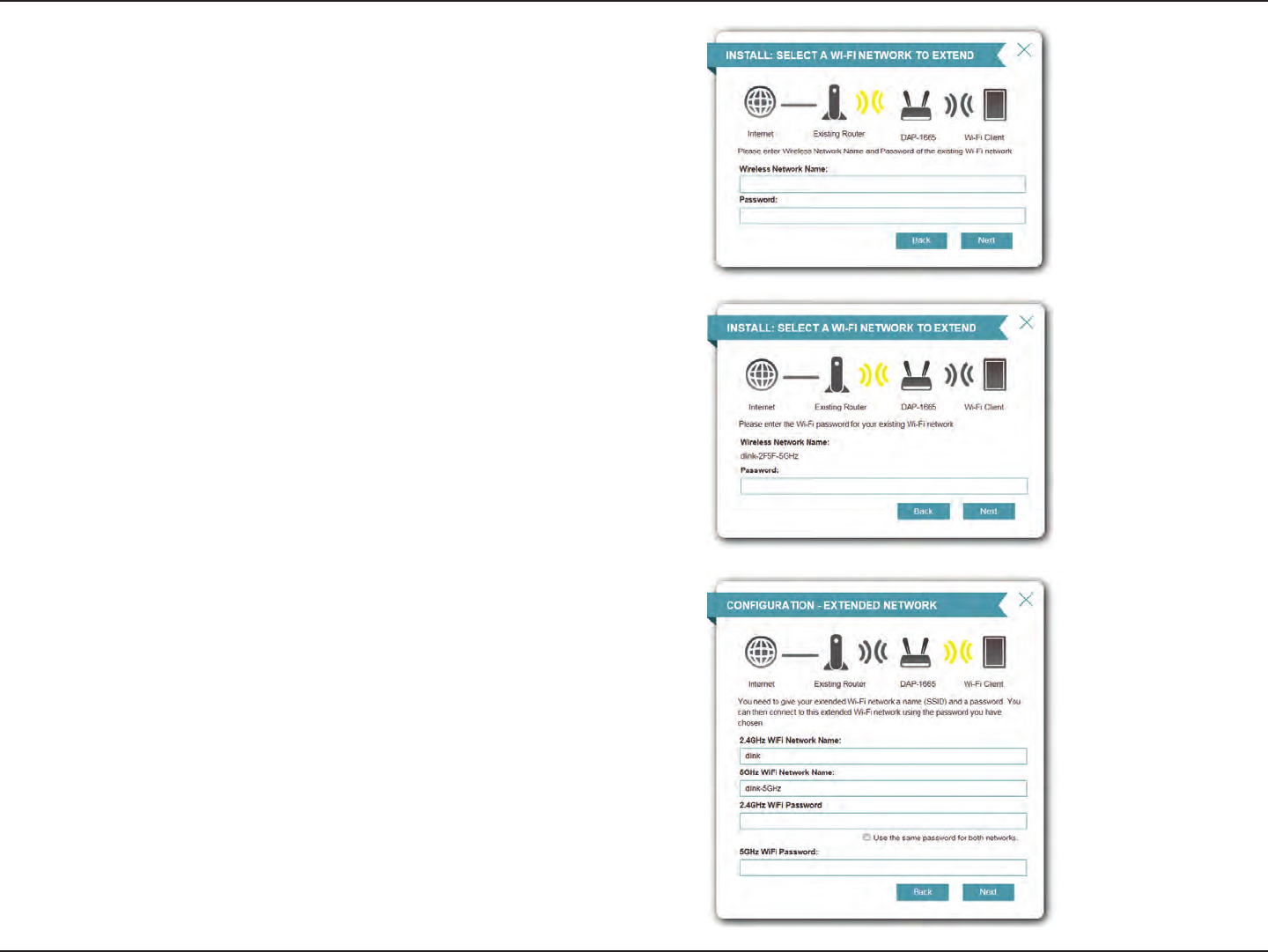
29D-Link DAP-1665 User Manual
Section 3 - Conguration
By default, the Wireless Network Name (SSID) eld will display the
same network name as the source network. If you wish to specify a
dierent name for the extended network, enter it in the eld provided.
If you wish to use the same network name for both 2.4 and 5 GHz
networks, check the box below.
The security password will be the same as that of the source network,
regardless of whether the network name is the same or not.
Click Next to continue.
If the existing wireless network uses wireless security, enter the Wi-Fi
Password in the eld provided.
Click Next to continue.
If you click Manual on the previous page, type in the SSID of the
network you wish to extend.
Click Next to continue.
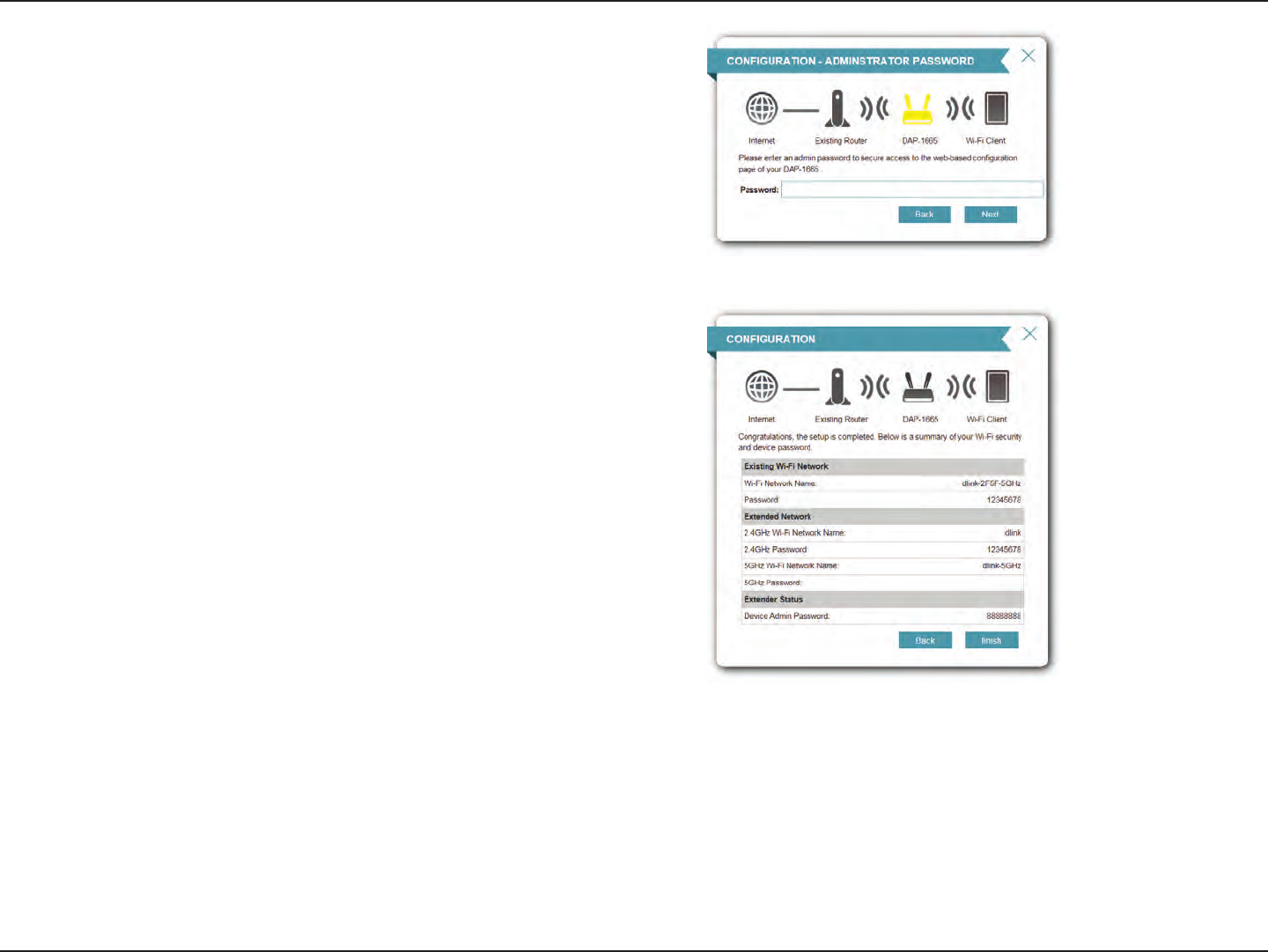
30D-Link DAP-1665 User Manual
Section 3 - Conguration
A summary page will be displayed showing the network name and
Wi-Fi password for the extended network. It is recommended that
you make a record of this information for future reference.
Click Finish to save the conguration.
In order for your network settings to take eect, the DAP-1665 will
reboot automatically.
When the device has nished rebooting the login page will display.
Next, enter a password for your administrator account. This account
is used to log into the DAP-1665 for managing your network.
Click Next to proceed.
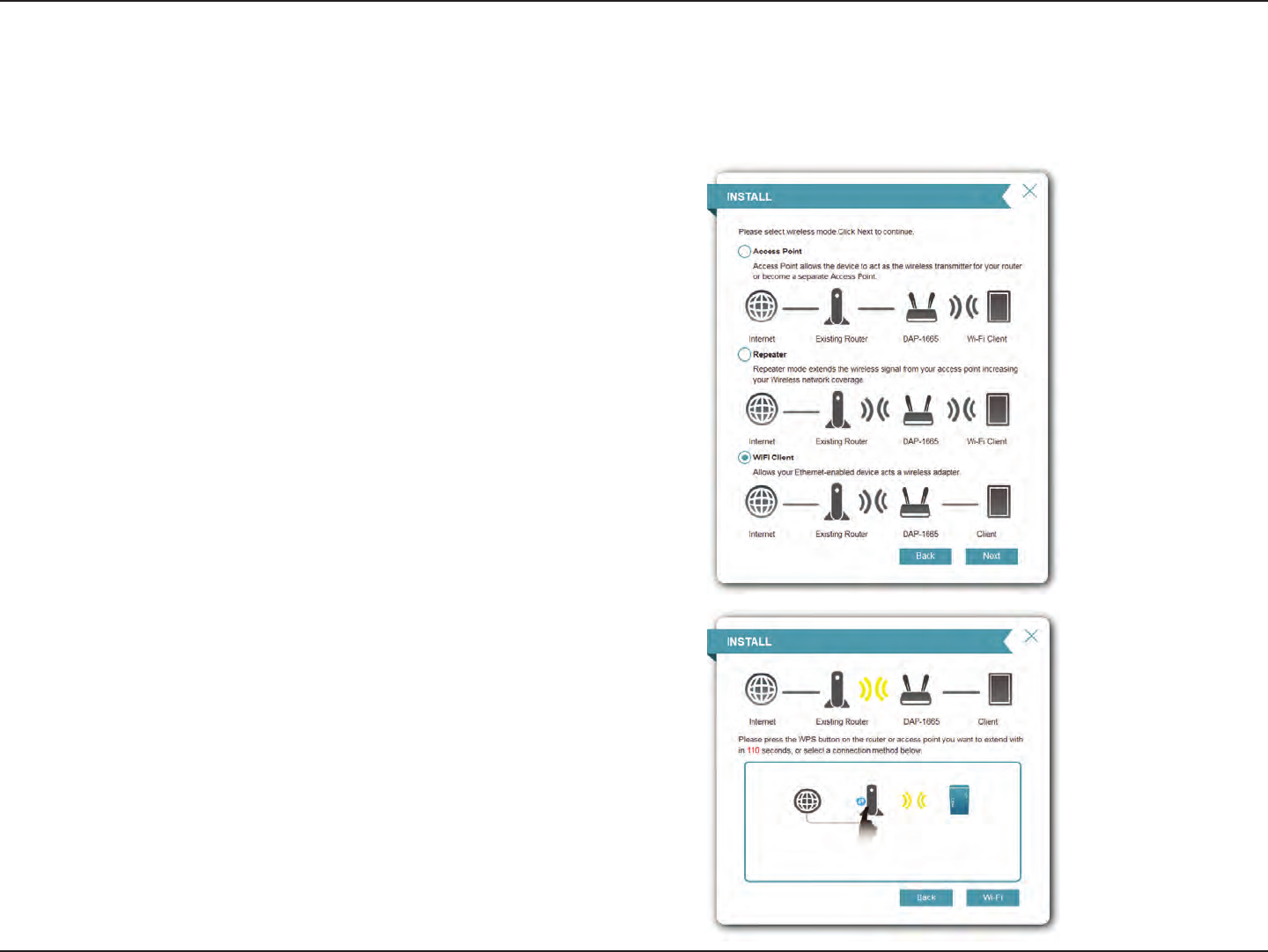
31D-Link DAP-1665 User Manual
Section 3 - Conguration
This wizard is designed to assist you in conguring your DAP-1665 as a wireless client.
Wi-Fi Client Mode
Select WiFi Client from the menu and click Next.
If your router does not support WPS, proceed to page 32.
Press the WPS Push Button on your existing wireless router with 120
seconds to complete the WPS setup process. A Retry button will
appear at the lower left if the time expired before you can press the
button.
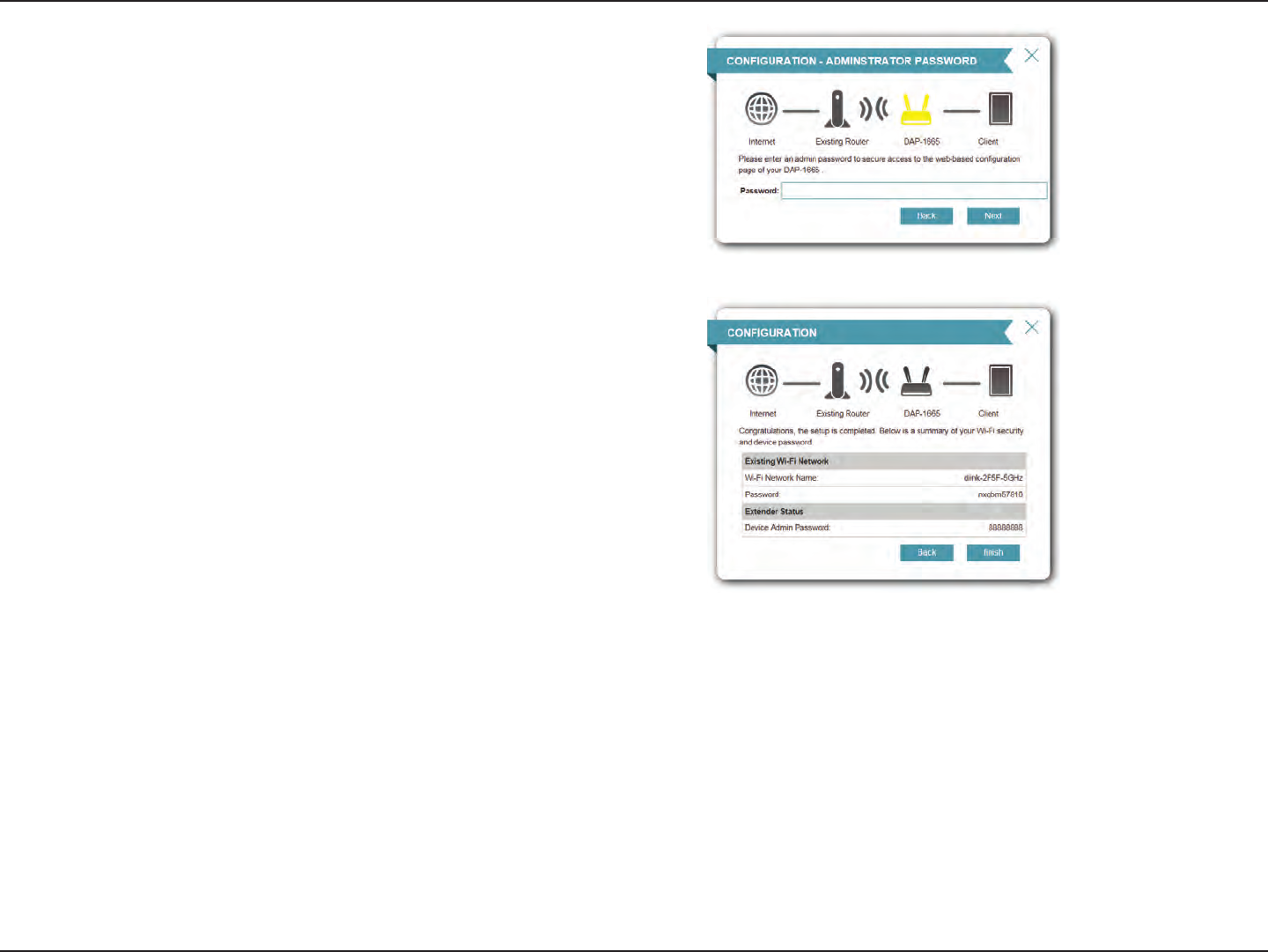
32D-Link DAP-1665 User Manual
Section 3 - Conguration
A summary page will be displayed showing the network name and
Wi-Fi password for the extended network. It is recommended that
you make a record of this information for future reference.
Click Finish to save the conguration.
In order for your network settings to take eect, the DAP-1665 will
reboot automatically.
When the device has nished rebooting the login page will display.
Next, enter a password for your administrator account. This account
is used to log into the DAP-1665 for managing your network.
Click Next to proceed.
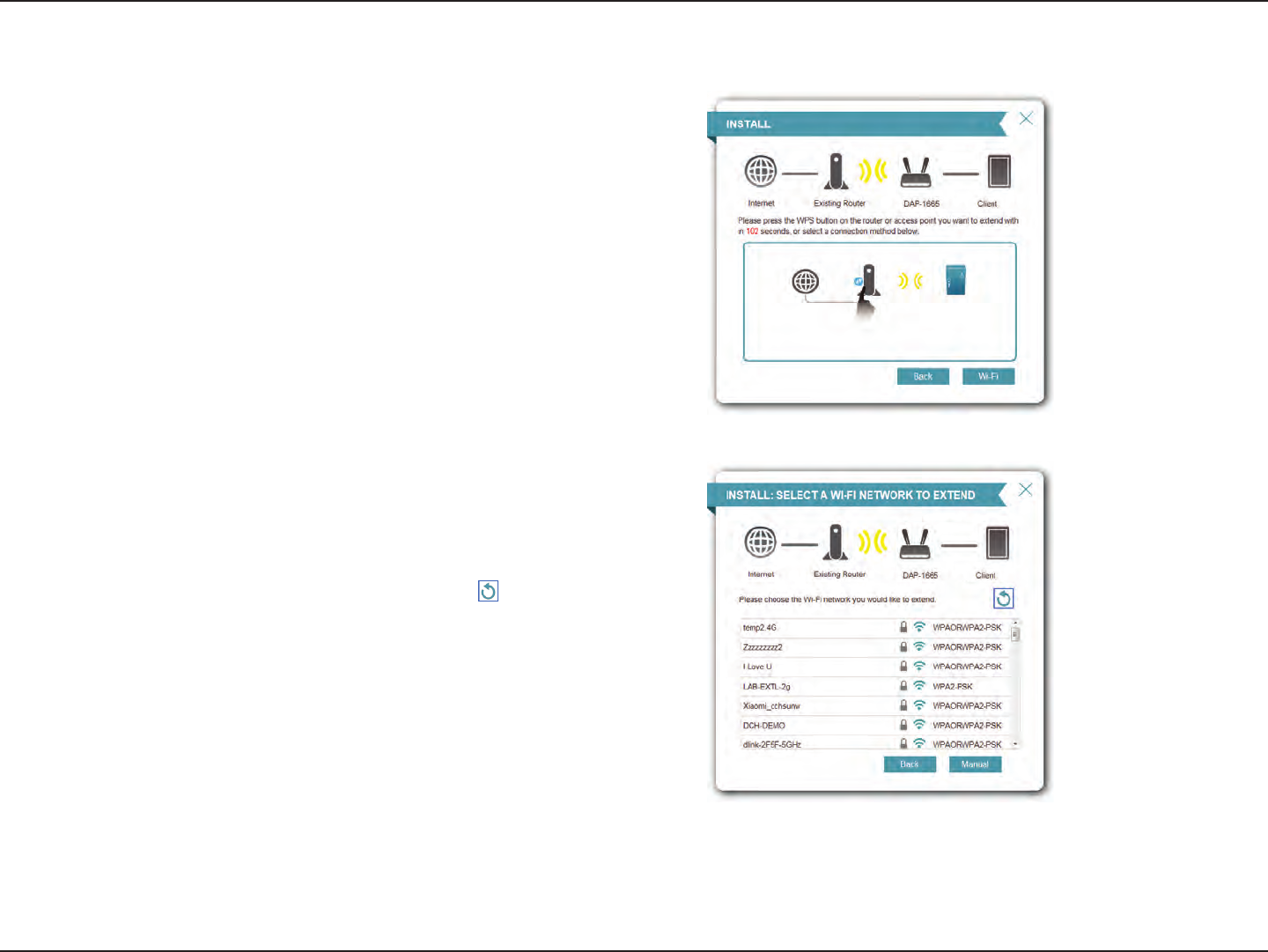
33D-Link DAP-1665 User Manual
Section 3 - Conguration
Click Wi-Fi to manually select your network.
The wizard will then scan for available wireless networks within range
of the DAP-1665. Click on the SSID of the router or access point you
wish to extend.
If you do not see your network in the list, click to search again.
If you still do not see your network, type in the SSID of your network
manually, by clicking Manual.
If your router does not support WPS:
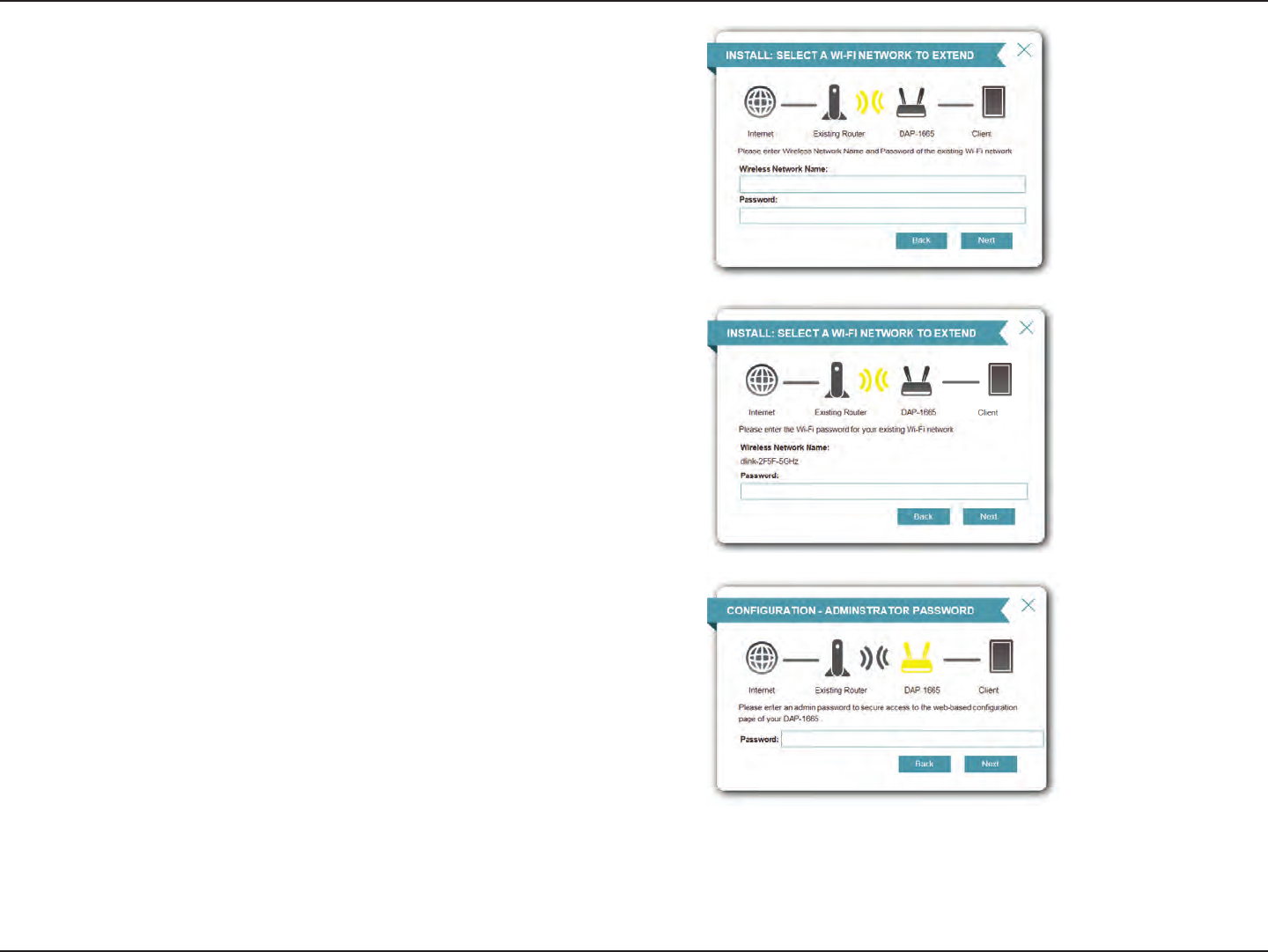
34D-Link DAP-1665 User Manual
Section 3 - Conguration
If the existing wireless network uses wireless security, enter the Wi-Fi
Password in the eld provided.
Click Next to continue.
If you click Manual on the previous page, type in the SSID of the
network you wish to extend.
Click Next to continue.
Next, enter a password for your administrator account. This account
is used to log into the DAP-1665 for managing your network.
Click Next to proceed.
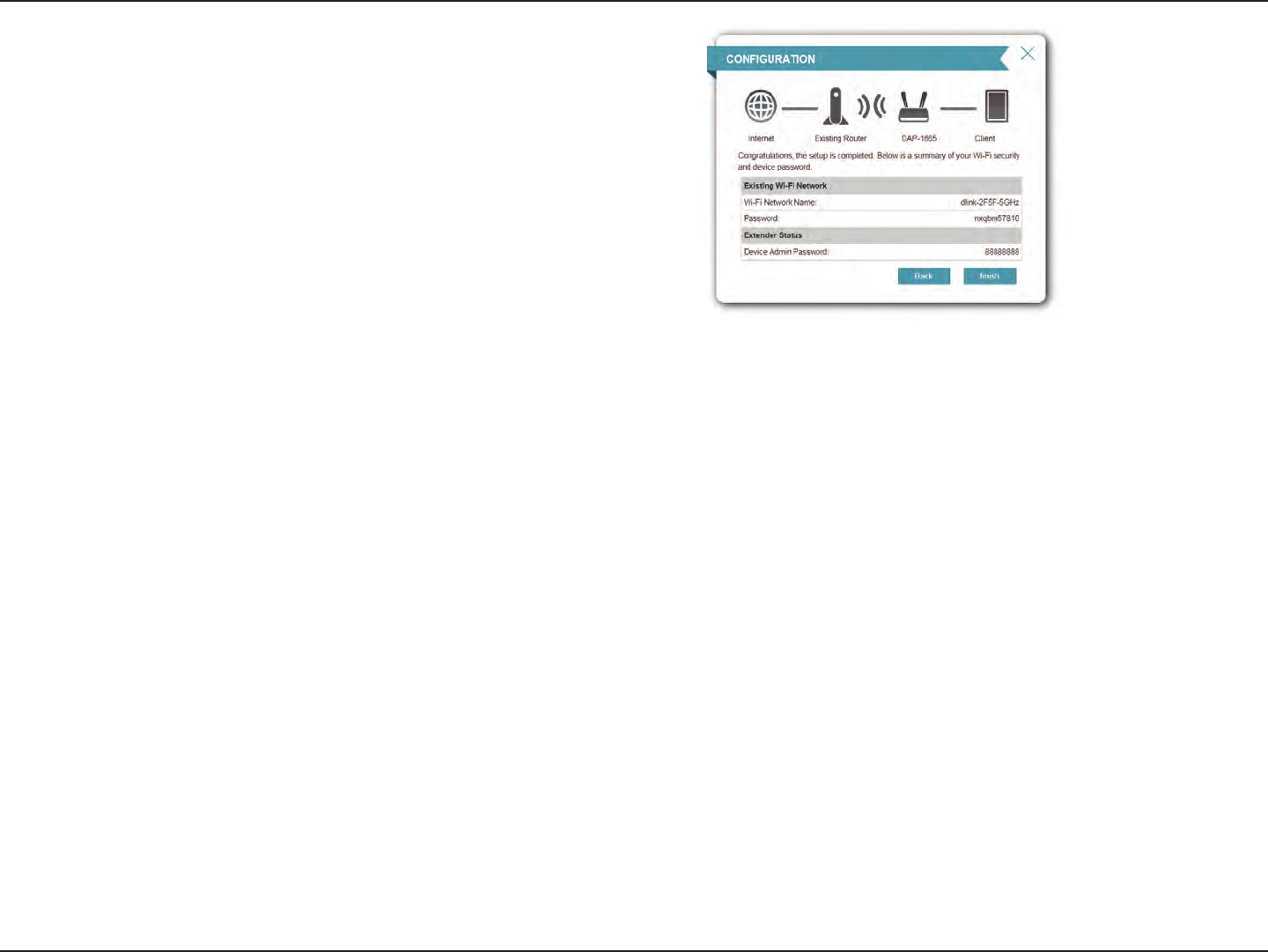
35D-Link DAP-1665 User Manual
Section 3 - Conguration
A summary page will be displayed showing the network name and
Wi-Fi password for the existing network. It is recommended that you
make a record of this information for future reference.
Click Finish to save the conguration.
In order for your network settings to take eect, the DAP-1665 will
reboot automatically.
When the device has nished rebooting the login page will display.

36D-Link DAP-1665 User Manual
Section 3 - Conguration
Extender
Settings
You may also manually congure your DAP-1665 instead of running the setup wizard. Please refer to the following pages for
detailed instructions on how to manually congure the DAP-1665 for your desired operation mode.
• Access Point Mode on page 37
• Wireless Client Mode on page 48
• Bridge Mode on page 49
• Bridge with AP Mode on page 52
• Repeater Mode on page 46
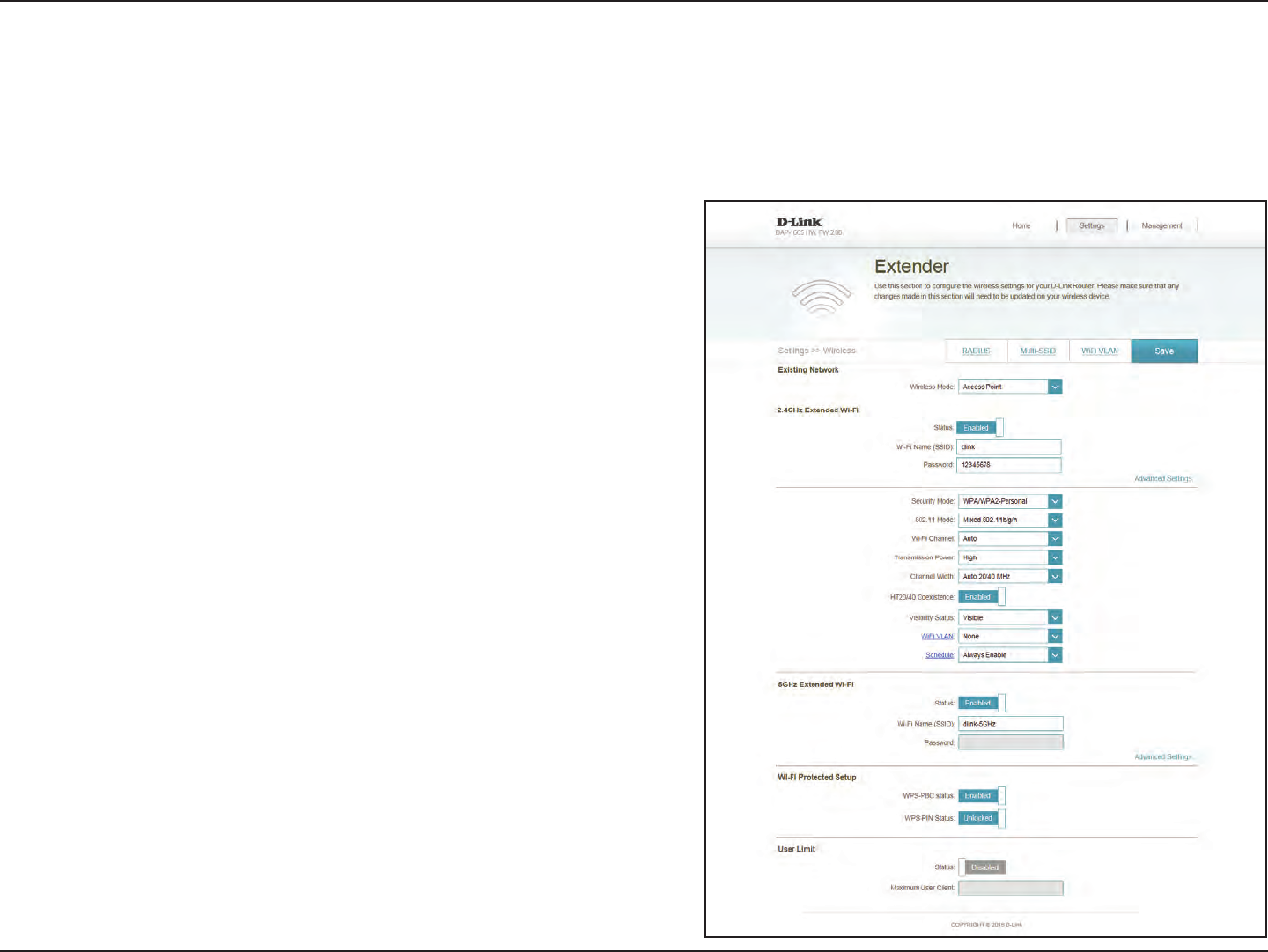
37D-Link DAP-1665 User Manual
Section 3 - Conguration
Access Point Mode
Wireless Mode:
Status:
Wi-Fi Name
(SSID):
Password:
Select Access Point from the drop-down menu.
Enables the wireless function for the 2.4 GHz band. If you do
not want to use wireless on this band, disable the slider. You
may also set up a specic time range (schedule).
Specify a network name (SSID) to identify the 2.4 GHz network.
This is the network name that wireless clients will search for
when connecting to your wireless network.
Enter a password for connecting to your 2.4 GHz network.
2.4 GHz Band
Security
Mode:
802.11 Mode:
Wi-Fi Channel:
Transmission
Power:
Select the type of wireless security you wish to use for the
extended network. Choose from WPA/WPA2-Personal/WPA/
WPA2-Enterprise/None.
Select one of the following:
802.11n Only - Select if you are only using 802.11n wireless
clients.
Mixed 802.11n and 802.11g - Select if you are using a mix of
802.11n and 802.11g wireless clients.
Mixed 802.11n, 802.11g and 802.11b - Select if you are using
a mix of 802.11n, 802.11g, and 802.11b wireless clients.
Choose from channels 1-11 for an existing wireless network or
to reduce interference in congested areas.
The Auto setting can be selected to allow the DAP-1665 to
automatically choose the channel with the least amount of
interference.
Depending on your wireless reception and coverage area, you
can choose between Low, Medium, or High power.
Advanced Settings:
This section lets you congure your DAP-1665 as a wireless access point for your existing network.
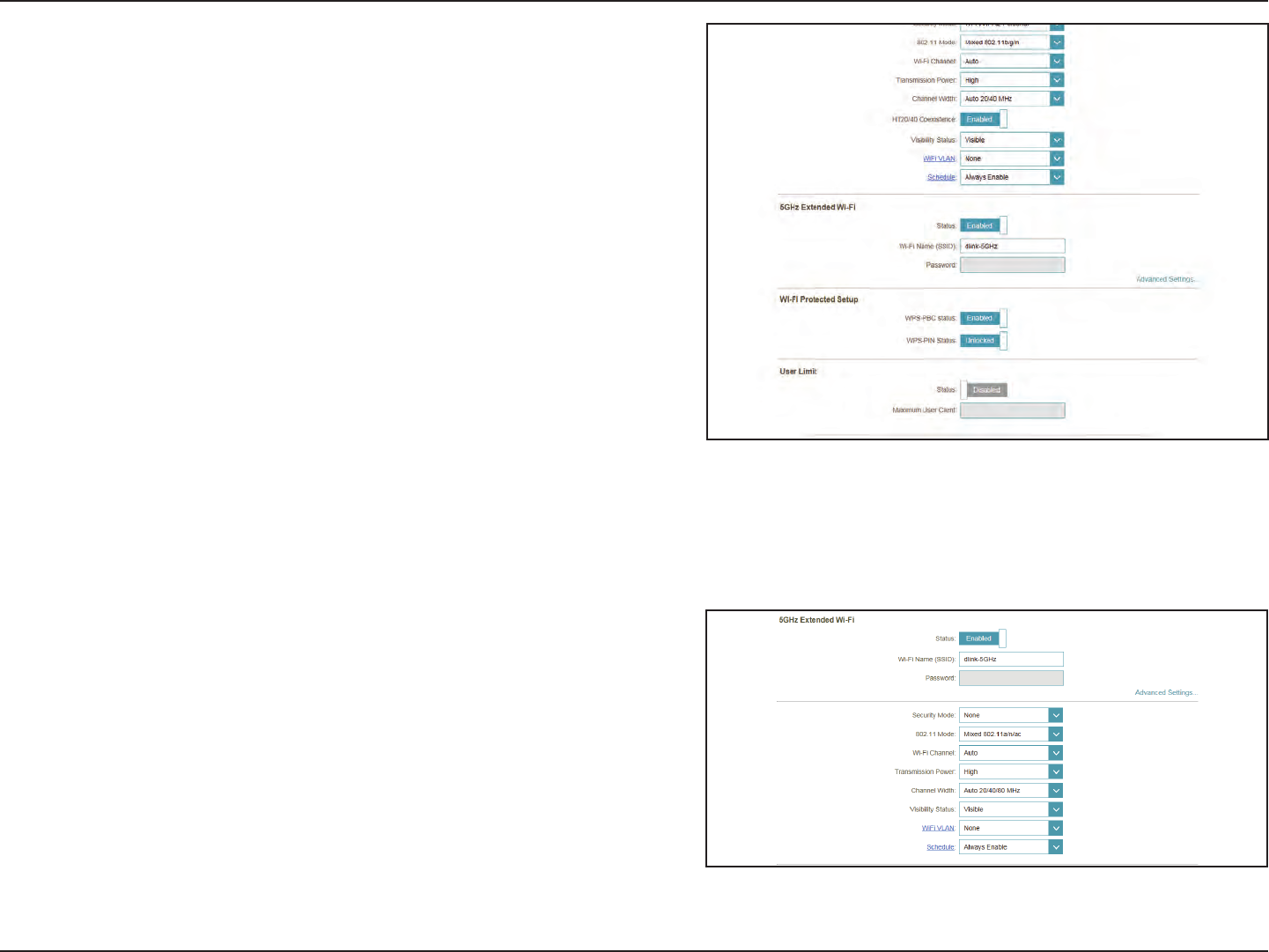
38D-Link DAP-1665 User Manual
Section 3 - Conguration
Channel
Width:
HT20/40
Coexistence:
Visibility
Status:
WiFi VLAN:
Schedule:
Select the Channel Width:
Auto 20/40 - Select if you are using both 802.11n and non-
802.11n wireless devices.
20 MHz - Select if you are not using any 802.11n wireless clients.
Enable or disable HT20/40 coexistence by toggling the slider.
Enabling this feature helps with device compatibility depending
on their 802.11 version.
Select whether you would like the network name (SSID) of your
wireless network to be Visible or Invisible to wireless clients.
If Invisible, the SSID of the DAP-1665 will not be seen by site
survey utilities, so wireless clients will have to manually enter
the SSID of your wireless network in order to connect to it.
If you have already dened VLAN IDs, you can choose if the
clients accessing the 2.4 or 5 GHz band will be able to see other
clients connected to that VLAN. The default setting is None.
If you have added a rule under Management >> Schedule, click
on the drop-down menu to choose whether the device will
be Always Enable or choose from the name of your custom
schedule. Click Save to store the setting and the device will
reboot to activate the selected schedule.
5 GHz Band
Check the box to enable the wireless function for the 5 GHz
band. If you do not want to use wireless, uncheck the box to
disable all wireless functions. You may also set up a specic
time range (schedule). Select a schedule from the drop-down
menu or click Add New to create a new schedule. By default,
the schedule is set to Always.
Specify a network name (SSID) to identify the 5 GHz network.
This is the network name that wireless clients will search for
when connecting to your wireless network. This name should
be dierent to that of the 2.4 GHz network congured above.
Enable Wireless:
Wireless
Network Name:

39D-Link DAP-1665 User Manual
Section 3 - Conguration
802.11
Mode:
Wireless
Channel:
Enable Auto
Channel
Scan:
Channel
Width:
Visibility
Status:
Select one of the following:
802.11a Only - Select if you are only using 802.11a wireless clients.
802.11n Only - Select if you are only using 802.11n wireless clients.
Mixed 802.11n and 802.11a - Select if you are using a mix of 802.11n and 802.11a wireless clients.
802.11ac Only - Select if you are only using 802.11ac wireless clients.
Mixed 802.11ac and 802.11n - Select if you are using a mix of 802.11ac and 802.11n wireless clients.
Mixed 802.11ac, 802.11n and 802.11a - Select if you are using a mix of 802.11ac, 802.11n, and 802.11a wireless clients.
Indicates the channel setting for the DAP-1665. The channel can be changed to t the channel setting for an existing wireless
network or to reduce interference in congested areas. If you enable Auto Channel Scan, this option will not be available.
The Auto Channel Scan setting can be selected to allow the DAP-1665 to automatically choose the channel with the least amount
of interference.
Select the Channel Width:
Auto 20/40/80 - Select this option if you are using a combination of 802.11ac, 802.11n, and other wireless devices.
Auto 20/40 - Select if you are using both 802.11n and non-802.11n wireless devices.
20 MHz - Select if you are not using any 802.11n wireless clients.
Select whether you would like the network name (SSID) of your wireless network to be Visible or Invisible to wireless clients. If
Invisible, the SSID of the DAP-1665 will not be seen by site survey utilities, so wireless clients will have to manually enter the SSID
of your wireless network in order to connect to it.
Click Save Settings at the top of the page to save the current conguration.
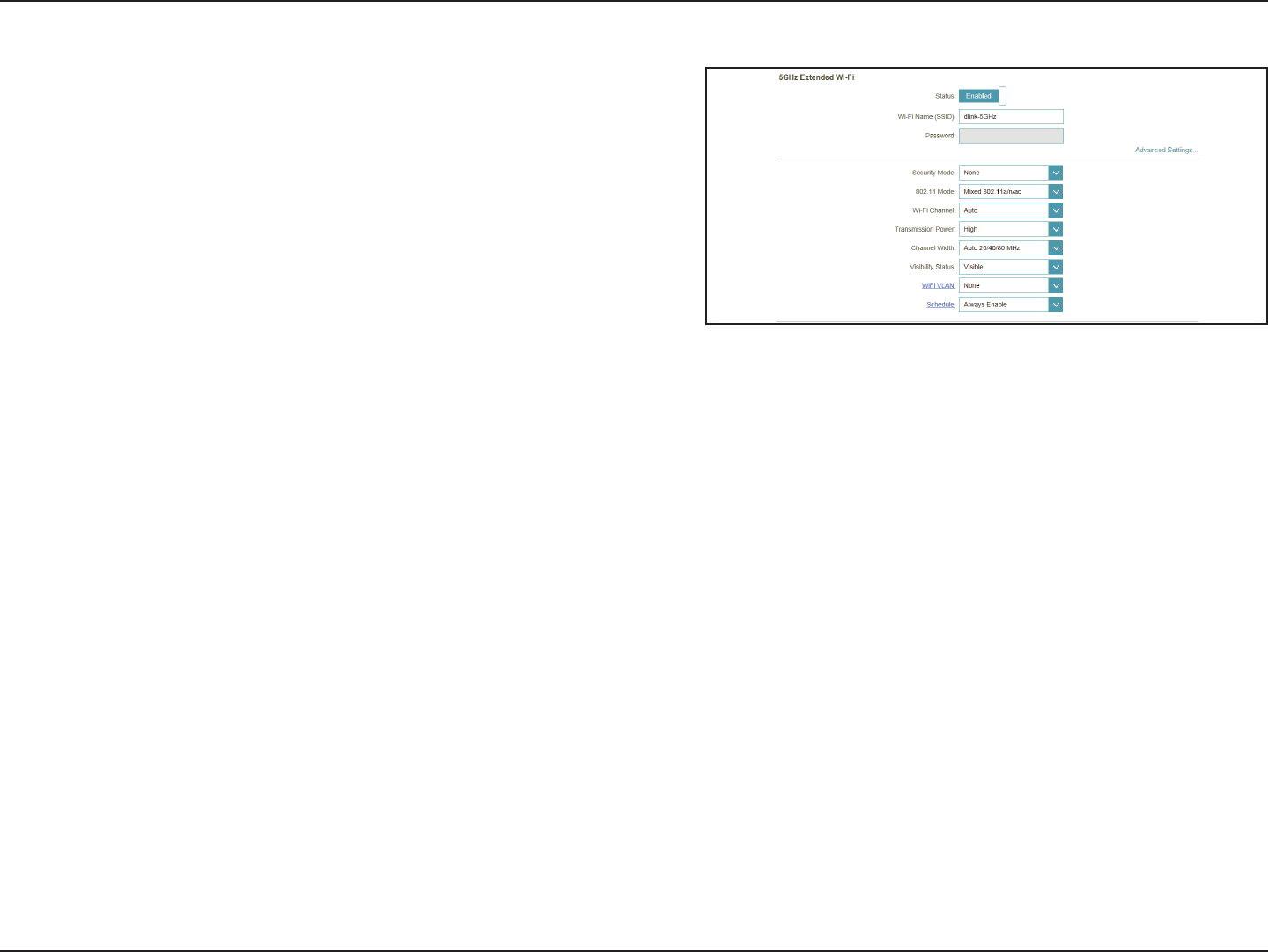
40D-Link DAP-1665 User Manual
Section 3 - Conguration
Advanced Settings:
Security
Mode:
802.11 Mode:
Wi-Fi Channel:
Transmission
Power:
Channel
Width:
Visibility
Status:
Select the type of wireless security you wish to use for the
extended network. Choose from WPA/WPA2-Personal/WPA/
WPA2-Enterprise/None.
Select one of the following:
802.11a Only - Select if you are only using 802.11a wireless
clients.
802.11n Only - Select if you are only using 802.11n wireless
clients.
Mixed 802.11a/n - Select if you are using a mix of 802.11n and
802.11a wireless clients.
802.11ac Only - Select if you are only using 802.11ac wireless
clients.
Mixed 802.11n/ac - Select if you are using a mix of 802.11ac
and 802.11n wireless clients.
Mixed 802.11a/n/ac - Select if you are using a mix of 802.11ac,
802.11n, and 802.11a wireless clients.
Choose from channels 1-11 for an existing wireless network or
to reduce interference in congested areas.
The Auto setting can be selected to allow the DAP-1665 to
automatically choose the channel with the least amount of
interference.
Depending on your wireless reception and coverage area, you
can choose between Low, Medium, or High power.
Select the Channel Width:
Auto 20/40 - Select if you are using both 802.11n and non-
802.11n wireless devices.
20/40/80 MHz - Select if you are not using any 802.11n wireless
clients.
Select whether you would like the network name (SSID) of your
wireless network to be Visible or Invisible to wireless clients.
If Invisible, the SSID of the DAP-1665 will not be seen by site
survey utilities, so wireless clients will have to manually enter
the SSID of your wireless network in order to connect to it.
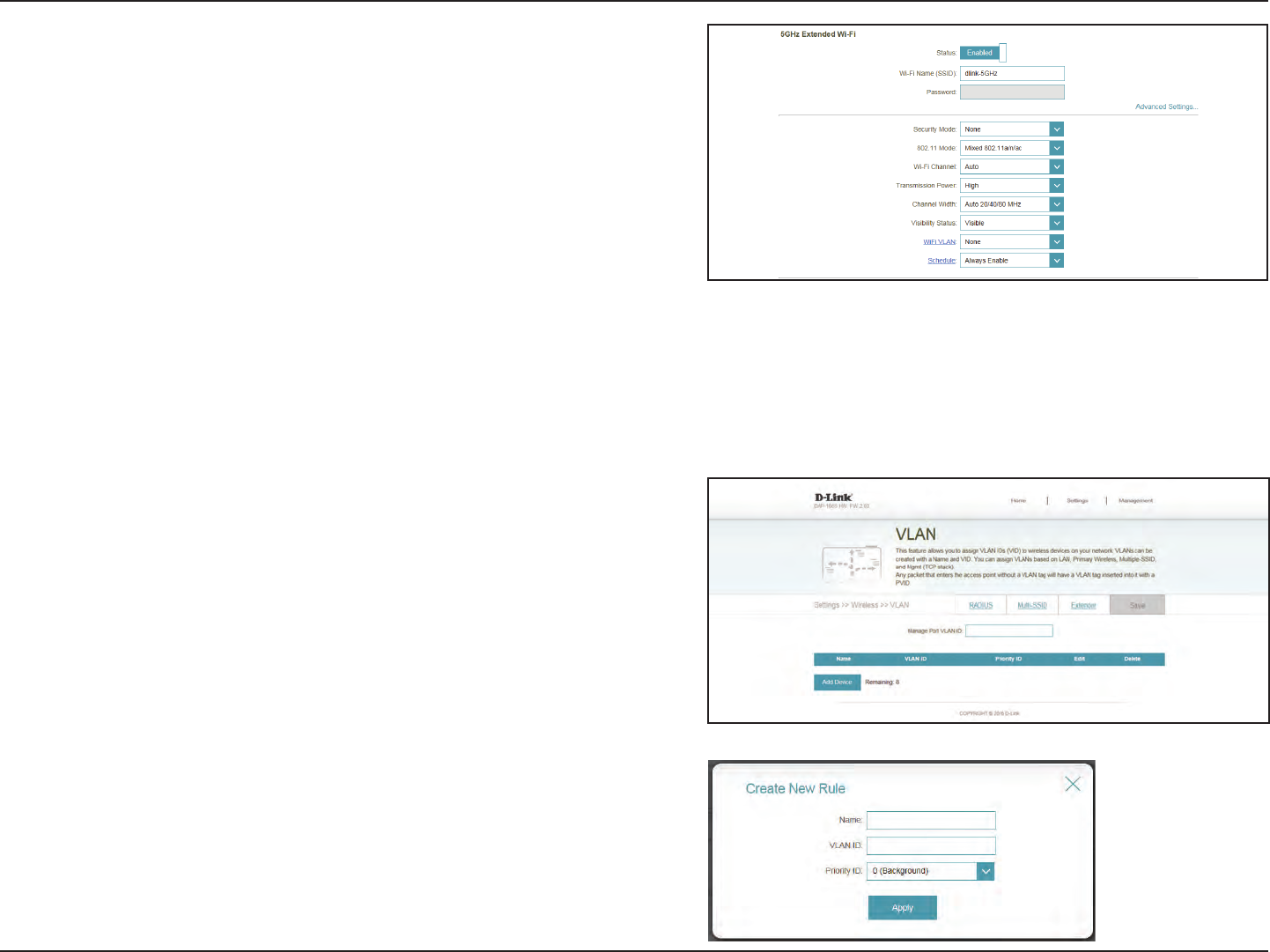
41D-Link DAP-1665 User Manual
Section 3 - Conguration
If you have already dened VLAN IDs, you can choose if the
clients accessing the 2.4 or 5 GHz band will be able to see other
clients connected to that VLAN. The default setting is None.
If you have added a rule under Management >> Schedule, click
on the drop-down menu to choose whether the device will
be Always Enable or choose from the name of your custom
schedule. Click Save to store the setting and the device will
reboot to activate the selected schedule.
Enable WPS-PBC status if you wish to allow push button
connections to this device.
Unlocked enables the use of the PIN method for Wi-Fi Protected
Setup (WPS).
Enable this function and enter a number in the Maximum
User Client box to limit the amount of client connections to
this device.
WiFi VLAN:
Schedule:
Wi-Fi
Protected
Setup:
User Limit:
VLAN
Name:
VLAN ID:
Priority ID:
Enter a name for this rule.
Enter an ID number for this VLAN.
Choose between 0 to 7 priorities levels. The type of priority you
wish to assign to this rule is described next to the number.
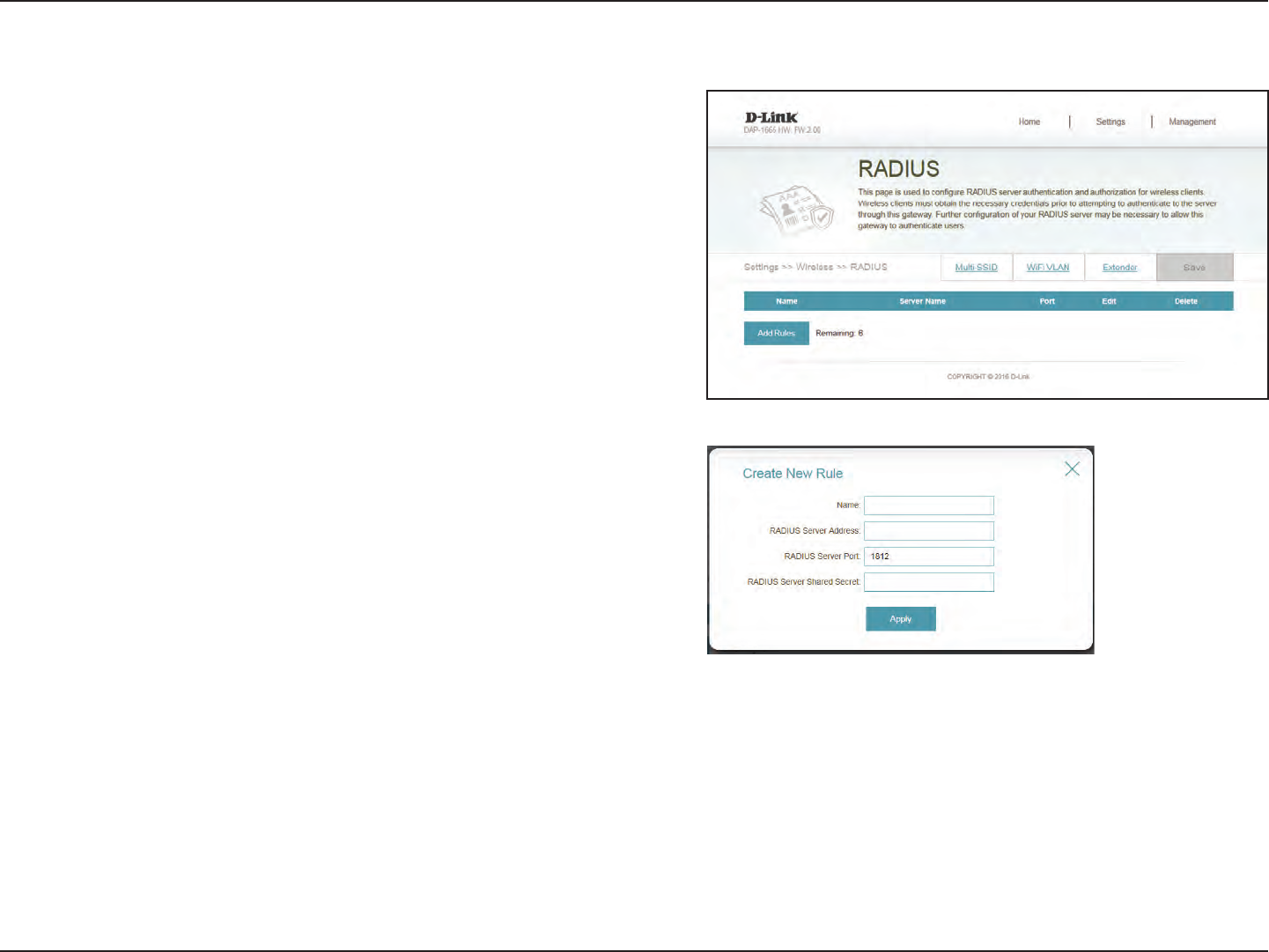
42D-Link DAP-1665 User Manual
Section 3 - Conguration
RADIUS
Name:
RADIUS Server
Address:
RADIUS Server
Port:
RADIUS Server
Shared Secret:
Enter a name for this rule.
Enter your RADIUS server’s IP address.
Enter the port your RADIUS server connects for authentication.
It is usually UDP port 1812.
Enter the shared secret for connecting to your RADIUS server
via an encrypted password.
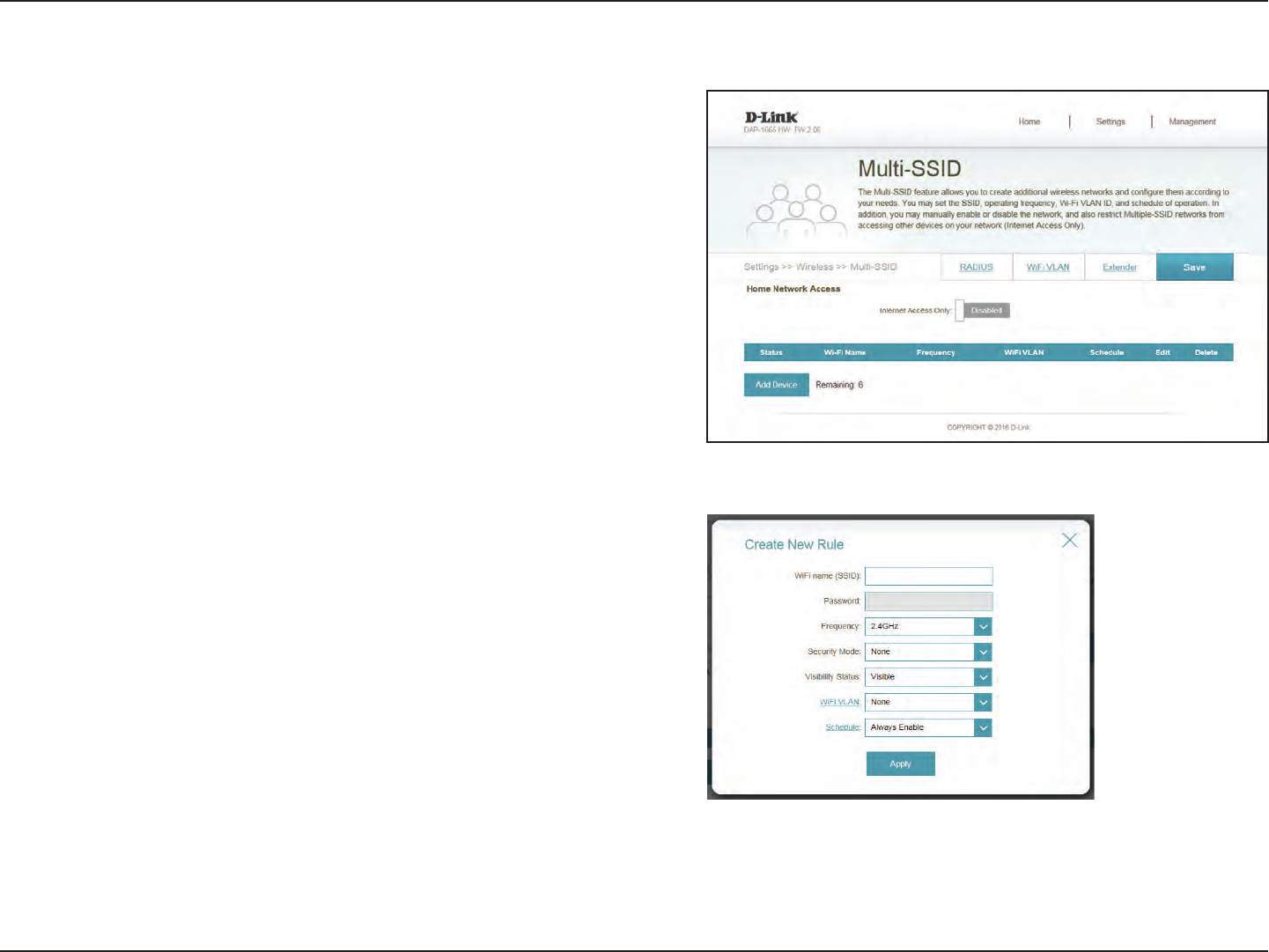
43D-Link DAP-1665 User Manual
Section 3 - Conguration
Multi-SSID
Internet Access
Only:
WiFi Name:
(SSID)
Password:
Frequency:
Security Mode:
Visibility Status:
WiFi VLAN:
Schedule:
Enable this to allow only access to the Internet when connected
to these SSID networks.
Enter a name for this new network.
Enter a password for this network.
Select between 2.4 or 5 GHz.
Select WPA/WPA2-Personal, WPA/WPA2-Enterprise, or None.
Select Visible or Invisible to allow this SSID to be scanned or
not.
Select an existing WiFi VLAN to apply that rule to this network.
Select an existing schedule to apply it to this network.
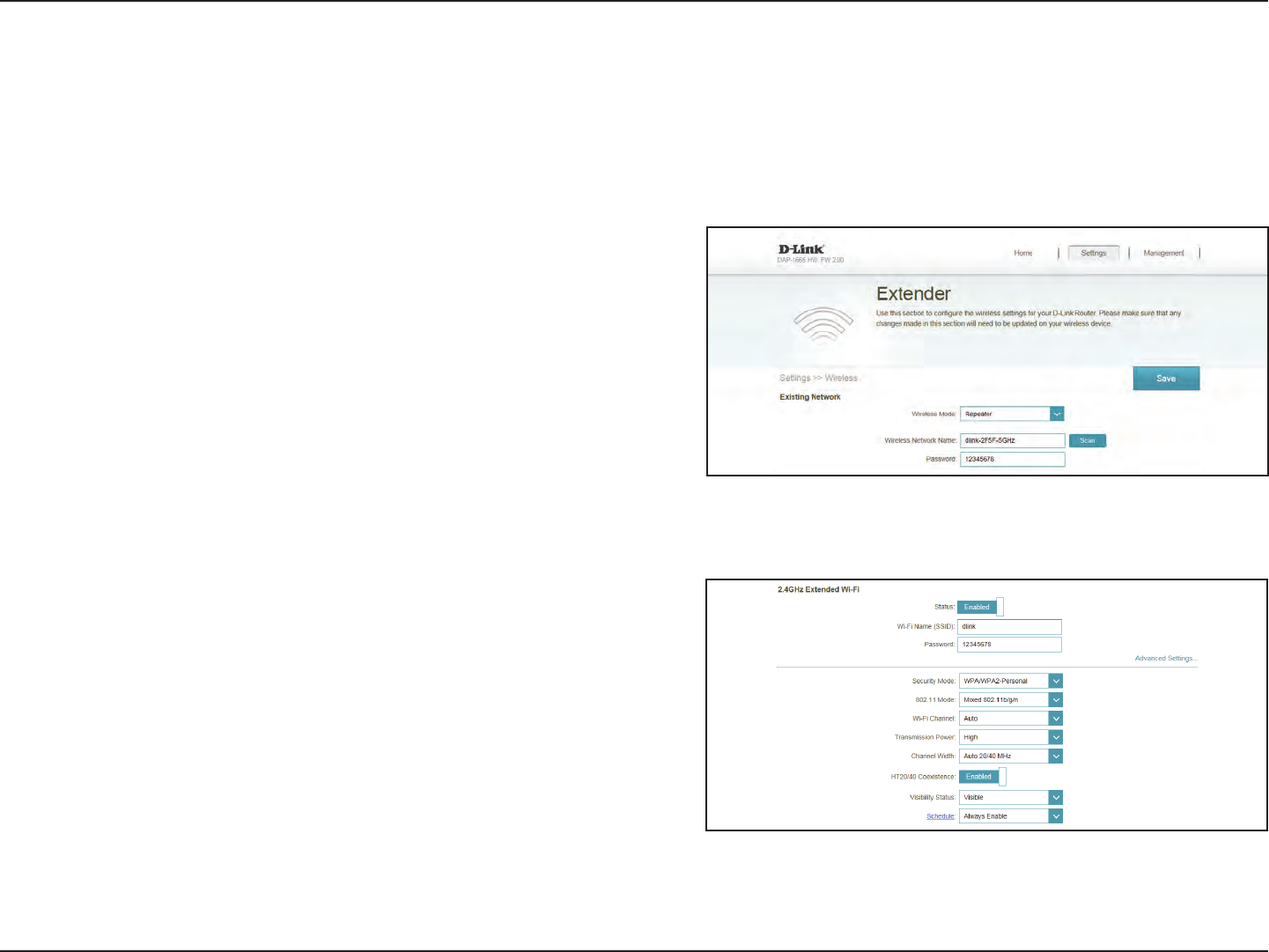
44D-Link DAP-1665 User Manual
Section 3 - Conguration
Wireless Mode:
Wireless Network
Name:
Password:
Select Repeater from the drop-down menu.
Click Scan to display a list of wireless networks in your area. In
the pop-up, click on the SSID, and click Select at the bottom
of the page to continue. The wireless network name will
automatically appear in the Repeater Network Name field
below, and the Repeater Network Band and Channel Width will
automatically be detected. You can also manually enter the SSID
of the access point you want to repeat the signal of.
Enter a custom password for the existing network.
Repeater Mode
Repeater mode re-broadcasts the wireless signal of an existing network to increase coverage. The existing wireless signal can
be repeated by the DAP-1665 using both the 2.4 GHz and 5 GHz bands.
Existing Network
2.4 GHz Extended Wi-Fi
Displays the name of the network to be repeated.
Specify a network name (SSID) to identify the 2.4 GHz network.
This is the network name that wireless clients will search for
when connecting to your wireless network.
Enter a password for connecting to your 2.4 GHz network.
Status:
Wi-Fi Name
(SSID):
Password:
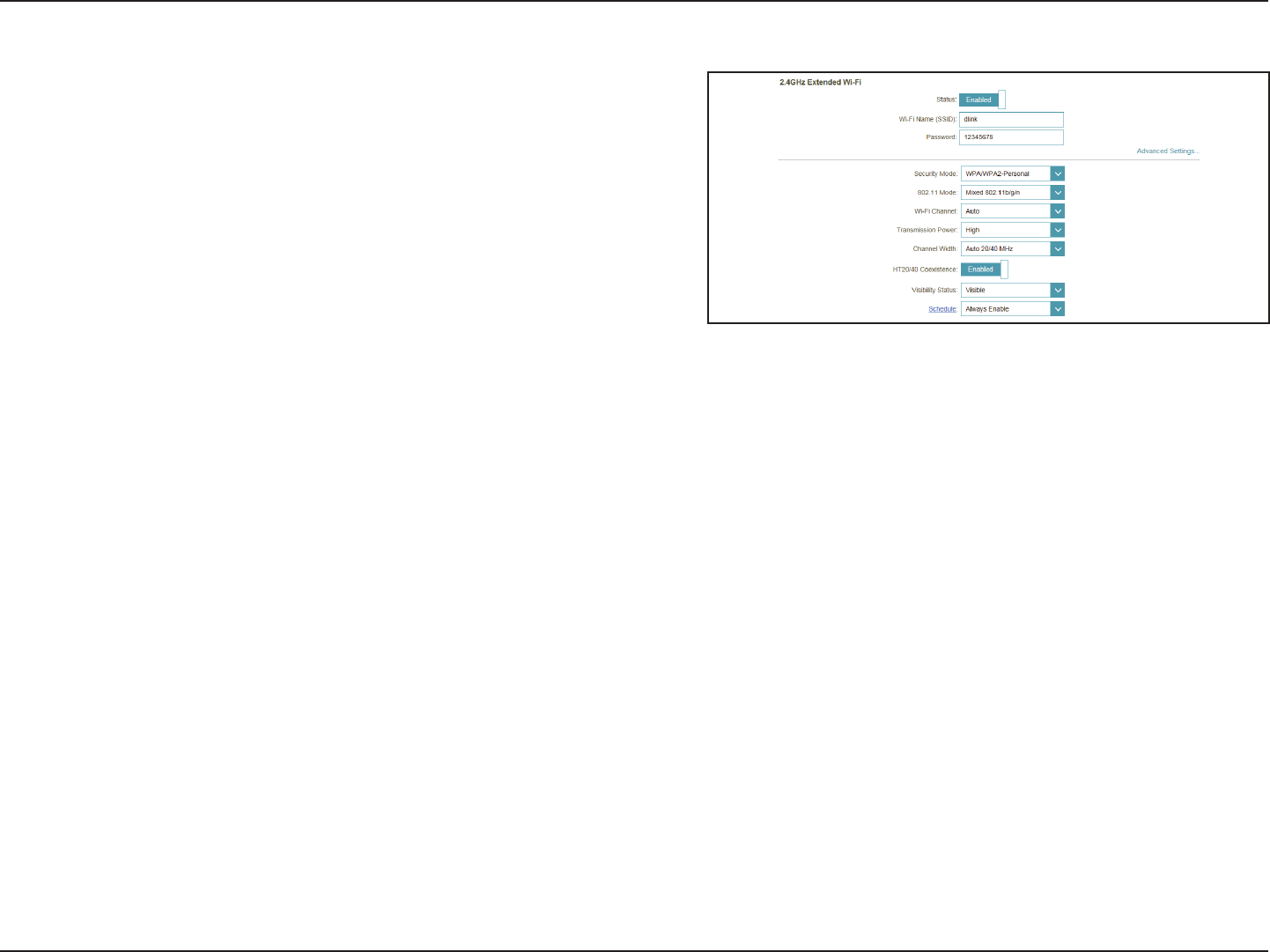
45D-Link DAP-1665 User Manual
Section 3 - Conguration
Security
Mode:
802.11 Mode:
Wi-Fi Channel:
Transmission
Power:
Channel
Width:
HT20/40
Coexistence:
Visibility
Status:
Schedule:
Select the type of wireless security you wish to use for the
extended network. Choose from WPA/WPA2-Personal/WPA/
WPA2-Enterprise/None.
Select one of the following:
802.11n Only - Select if you are only using 802.11n wireless
clients.
Mixed 802.11n and 802.11g - Select if you are using a mix of
802.11n and 802.11g wireless clients.
Mixed 802.11n, 802.11g and 802.11b - Select if you are using
a mix of 802.11n, 802.11g, and 802.11b wireless clients.
Choose from channels 1-11 for an existing wireless network or
to reduce interference in congested areas.
The Auto setting can be selected to allow the DAP-1665 to
automatically choose the channel with the least amount of
interference.
Depending on your wireless reception and coverage area, you
can choose between Low, Medium, or High power.
Select the Channel Width:
Auto 20/40 - Select if you are using both 802.11n and non-
802.11n wireless devices.
20 MHz - Select if you are not using any 802.11n wireless clients.
Enable or disable HT20/40 coexistence by toggling the slider.
Enabling this feature helps with device compatibility depending
on their 802.11 version.
Select whether you would like the network name (SSID) of your
wireless network to be Visible or Invisible to wireless clients.
If Invisible, the SSID of the DAP-1665 will not be seen by site
survey utilities, so wireless clients will have to manually enter
the SSID of your wireless network in order to connect to it.
If you have added a rule under Management >> Schedule, click
on the drop-down menu to choose whether the device will
be Always Enable or choose from the name of your custom
schedule. Click Save to store the setting and the device will
reboot to activate the selected schedule.
Advanced Settings:
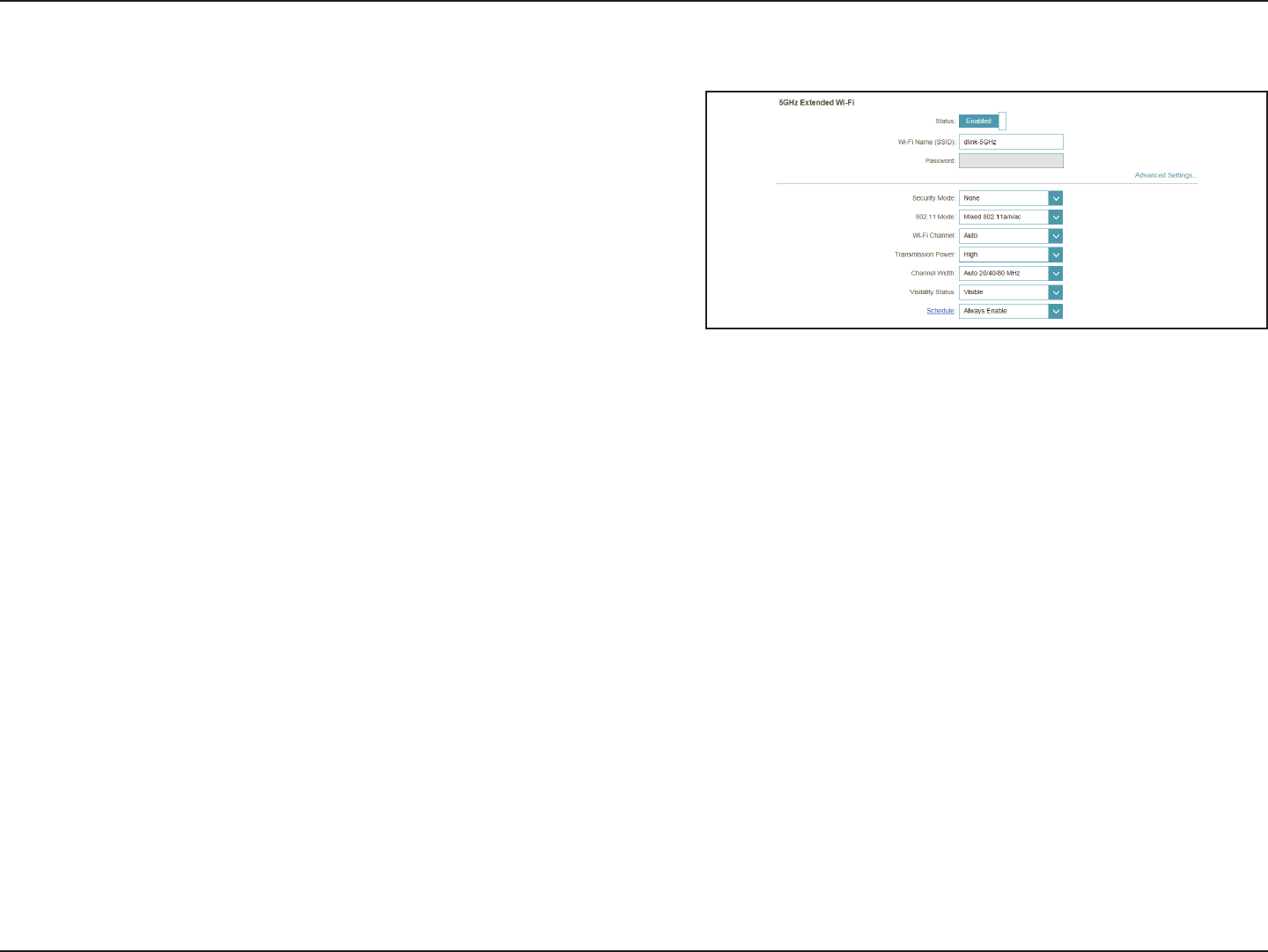
46D-Link DAP-1665 User Manual
Section 3 - Conguration
5 GHz Band
Click to enable the wireless function for the 5 GHz band. If you
do not want to use wireless, uncheck the box to disable all
wireless functions. You may also set up a specic time range
(schedule). Select a schedule from the drop-down menu or click
Add New to create a new schedule. By default, the schedule is
set to Always.
Specify a network name (SSID) to identify the 5 GHz network.
This is the network name that wireless clients will search for
when connecting to your wireless network. This name should
be dierent to that of the 2.4 GHz network congured above.
Status:
Wireless
Network Name:
Advanced Settings:
Security
Mode:
802.11 Mode:
Wi-Fi Channel:
Transmission
Power:
Select the type of wireless security you wish to use for the
extended network. Choose from WPA/WPA2-Personal/WPA/
WPA2-Enterprise/None.
Select one of the following:
802.11a Only - Select if you are only using 802.11a wireless
clients.
802.11n Only - Select if you are only using 802.11n wireless
clients.
Mixed 802.11a/n - Select if you are using a mix of 802.11n and
802.11a wireless clients.
802.11ac Only - Select if you are only using 802.11ac wireless
clients.
Mixed 802.11n/ac - Select if you are using a mix of 802.11ac
and 802.11n wireless clients.
Mixed 802.11a/n/ac - Select if you are using a mix of 802.11ac,
802.11n, and 802.11a wireless clients.
Choose from channels 1-11 for an existing wireless network or
to reduce interference in congested areas.
The Auto setting can be selected to allow the DAP-1665 to
automatically choose the channel with the least amount of
interference.
Depending on your wireless reception and coverage area, you
can choose between Low, Medium, or High power.
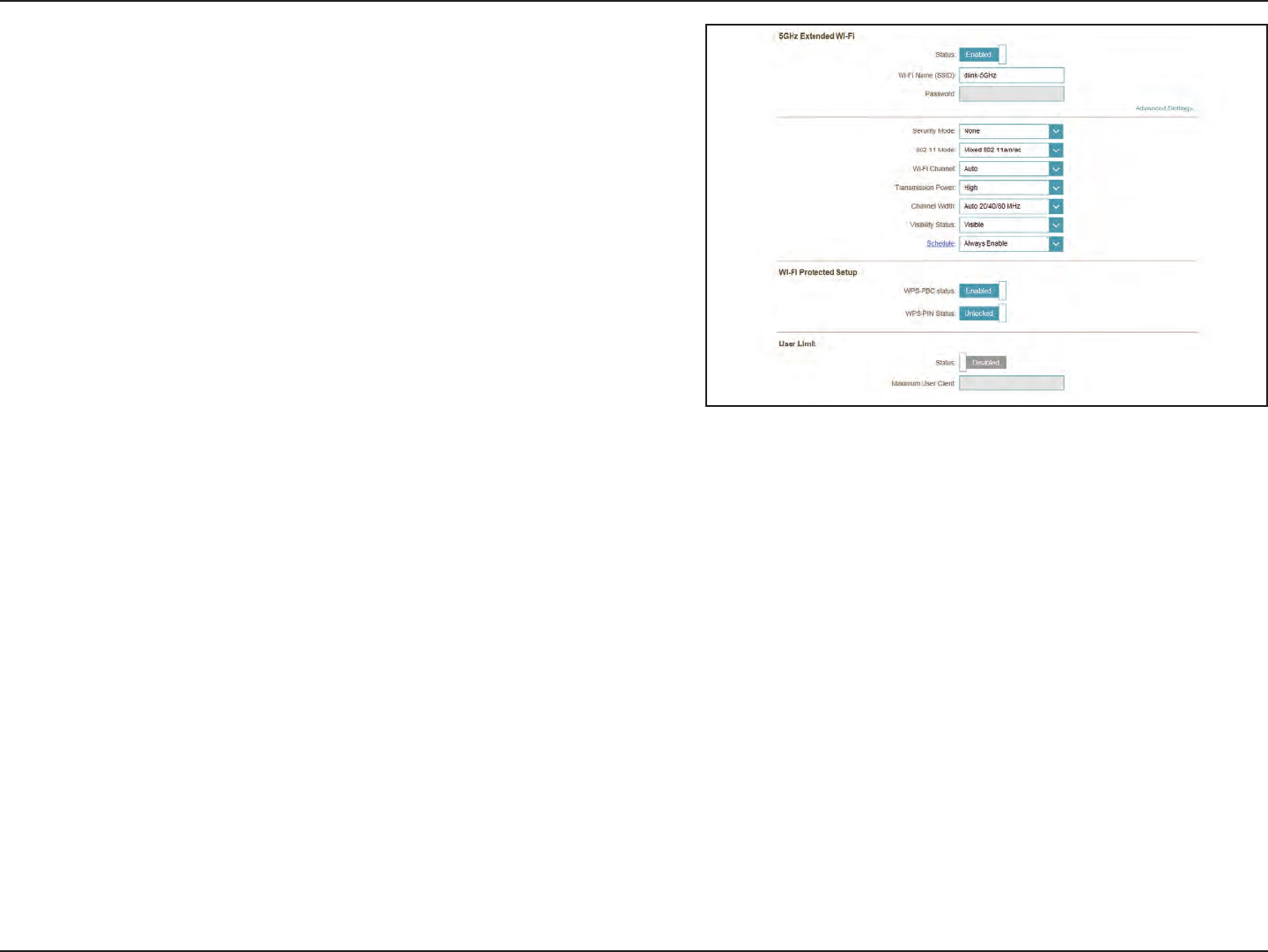
47D-Link DAP-1665 User Manual
Section 3 - Conguration
Select the Channel Width:
Auto 20/40 - Select if you are using both 802.11n and non-
802.11n wireless devices.
20/40/80 MHz - Select if you are not using any 802.11n wireless
clients.
Select whether you would like the network name (SSID) of your
wireless network to be Visible or Invisible to wireless clients.
If Invisible, the SSID of the DAP-1665 will not be seen by site
survey utilities, so wireless clients will have to manually enter
the SSID of your wireless network in order to connect to it.
If you have added a rule under Management >> Schedule, click
on the drop-down menu to choose whether the device will
be Always Enable or choose from the name of your custom
schedule. Click Save to store the setting and the device will
reboot to activate the selected schedule.
Enable WPS-PBC status if you wish to allow push button
connections to this device.
Unlocked enables the use of the PIN method for Wi-Fi Protected
Setup (WPS).
Enable this function and enter a number in the Maximum
User Client box to limit the amount of client connections to
this device.
Channel
Width:
Visibility
Status:
Schedule:
Wi-Fi
Protected
Setup:
User Limit:
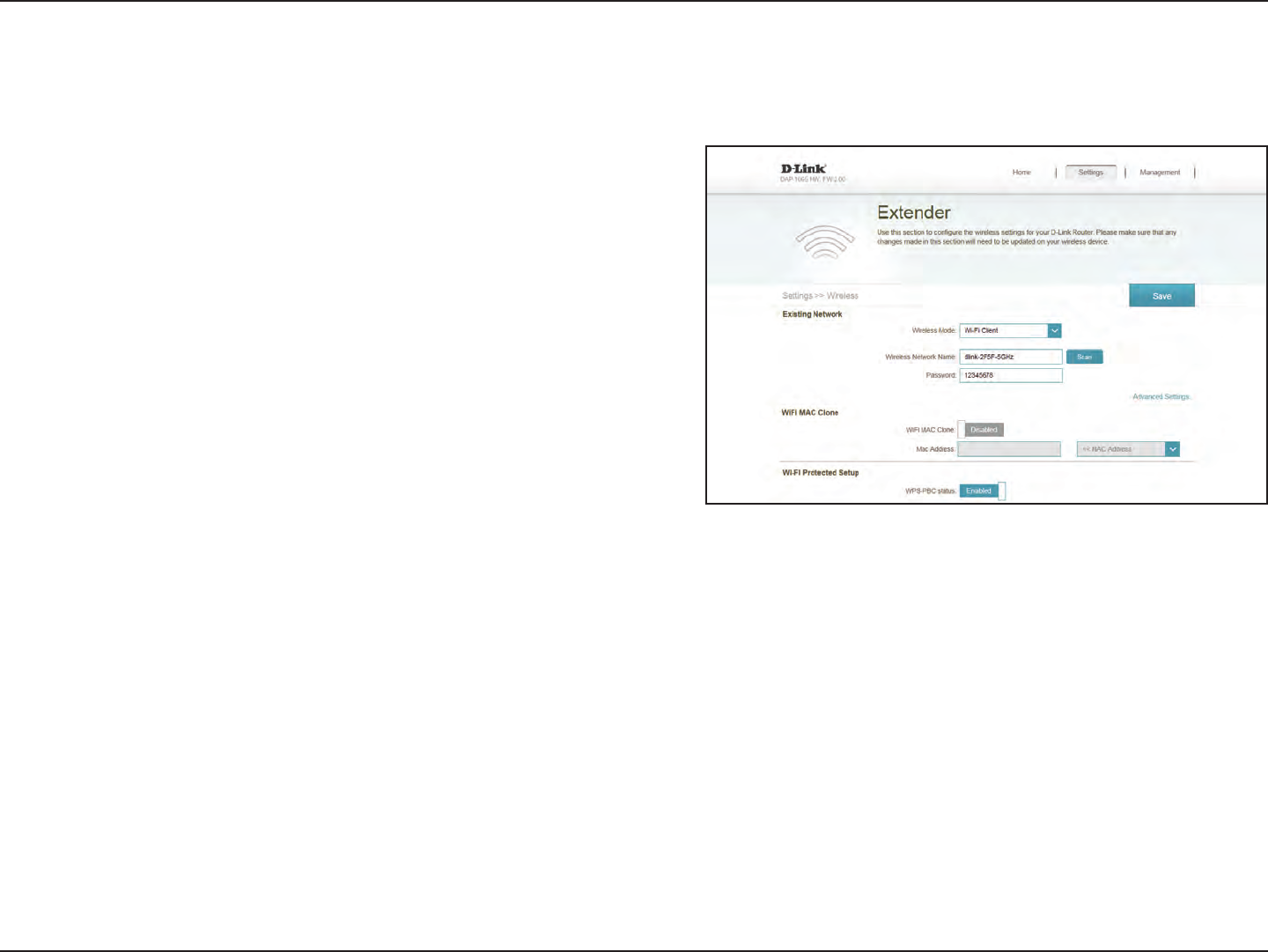
48D-Link DAP-1665 User Manual
Section 3 - Conguration
Wi-Fi Client
Wireless MAC
Clone: Tick Enable to clone the MAC address of another device.
Manually enter the MAC Address, or click on the drop-down
box to search through the MAC addresses of connected devices.
Wireless Mode:
Wireless Network
Name:
Password:
Select Wi-Fi Client from the drop-down menu.
Click Scan to display a list of wireless networks in your area. In
the pop-up, click on the SSID, and click Select at the bottom
of the page to continue. The wireless network name will
automatically appear in the Wireless Network Name eld below.
You can also manually enter the SSID of the network you want
to connect to.
Enter the password for the existing network. You may need to
ask the network administrator for this information.
Existing Network
Advanced Settings:
Wi-Fi Protected Setup
WPS-PBC
Status: Check Enable if you wish to enable the use of the PIN method
for Wi-Fi Protected Setup (WPS).
Click Save Settings to save the current conguration.
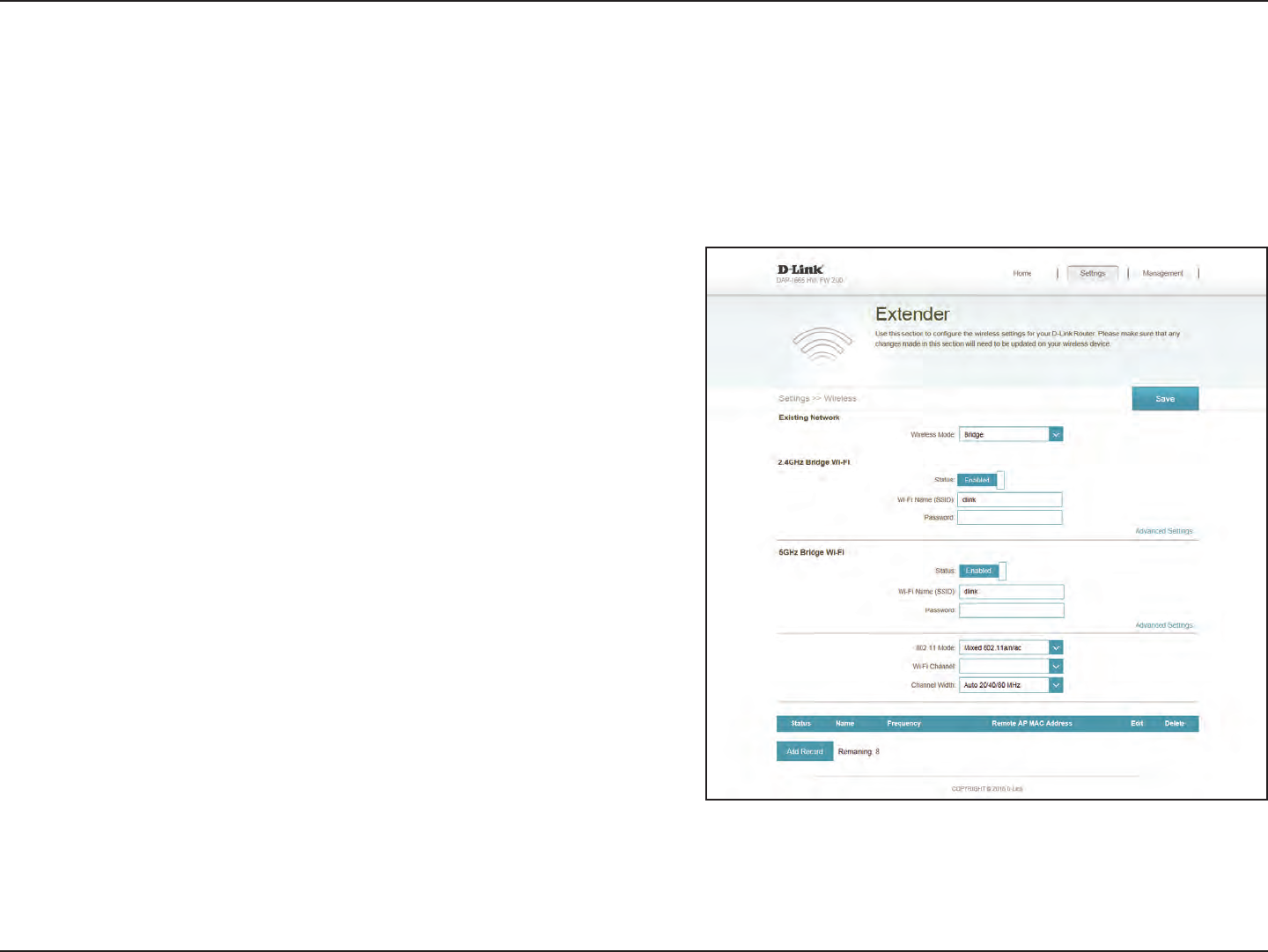
49D-Link DAP-1665 User Manual
Section 3 - Conguration
Bridge
Wireless Mode: Select Bridge from the drop-down menu.
Existing Network
Click to enable the wireless function for the 2.4 GHz band. If
you do not want to use wireless, uncheck the box to disable all
wireless functions.
Specify a network name (SSID) to identify the 2.4 GHz network.
This is the network name that wireless clients will search for
when connecting to your wireless network.
Enter a custom password for this network.
Select one of the following:
802.11n Only - Select if you are only using 802.11n wireless
clients.
Mixed 802.11n and 802.11g - Select if you are using a mix of
802.11n and 802.11g wireless clients.
Mixed 802.11n, 802.11g and 802.11b - Select if you are using
a mix of 802.11n, 802.11g, and 802.11b wireless clients.
Choose from channels 1-11 for an existing wireless network or
to reduce interference in congested areas.
The Auto setting can be selected to allow the DAP-1665 to
automatically choose the channel with the least amount of
interference.
Select the Channel Width:
Auto 20/40 - Select if you are using both 802.11n and non-
802.11n wireless devices.
20 MHz - Select if you are not using any 802.11n wireless clients.
Status:
Wi-Fi Name
(SSID):
Password:
802.11 Mode:
Wi-Fi Channel:
Channel Width:
2.4 GHz Bridge Wi-Fi
Advanced Settings:
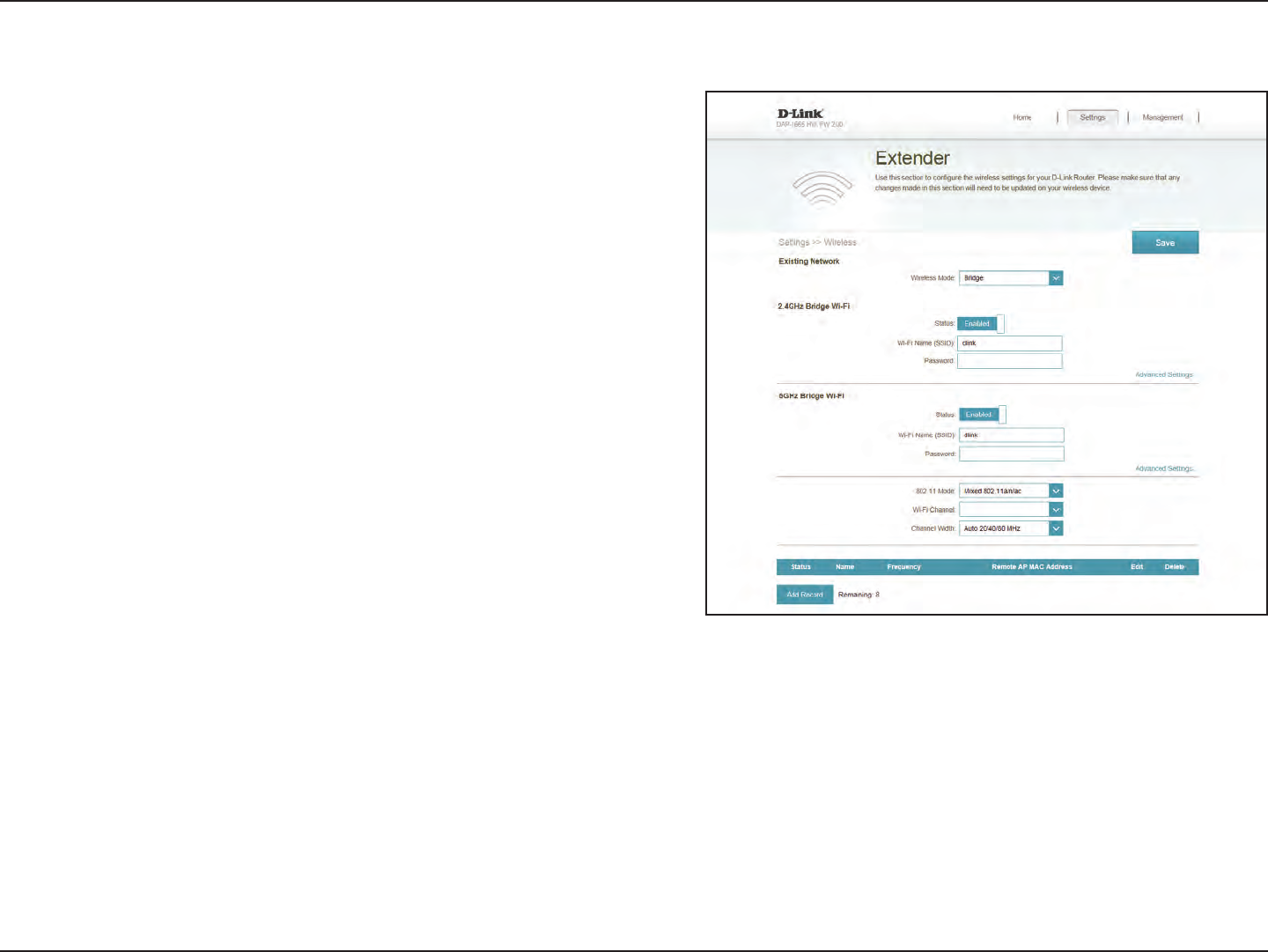
50D-Link DAP-1665 User Manual
Section 3 - Conguration
Click to enable the wireless function for the 5 GHz band. If you
do not want to use wireless, uncheck the box to disable all
wireless functions.
Specify a network name (SSID) to identify the 5 GHz network.
This is the network name that wireless clients will search for
when connecting to your wireless network.
Enter a custom password for this network.
Select one of the following:
802.11a Only - Select if you are only using 802.11a wireless
clients.
802.11n Only - Select if you are only using 802.11n wireless
clients.
Mixed 802.11a/n - Select if you are using a mix of 802.11n and
802.11a wireless clients.
802.11ac Only - Select if you are only using 802.11ac wireless
clients.
Mixed 802.11n/ac - Select if you are using a mix of 802.11ac
and 802.11n wireless clients.
Mixed 802.11a/n/ac - Select if you are using a mix of 802.11ac,
802.11n, and 802.11a wireless clients.
Choose a channel from the drop-down list for an existing
wireless network or to reduce interference in congested areas.
Select the Channel Width:
Auto 20/40 - Select this if you are using both 802.11n and non-
802.11n wireless devices.
Auto 20/40/80 MHz - Select this if you are not using any 802.11n
wireless clients.
Status:
Wi-Fi Name
(SSID):
Password:
802.11 Mode:
Wi-Fi Channel:
Channel Width:
5 GHz Bridge Wi-Fi
Advanced Settings:
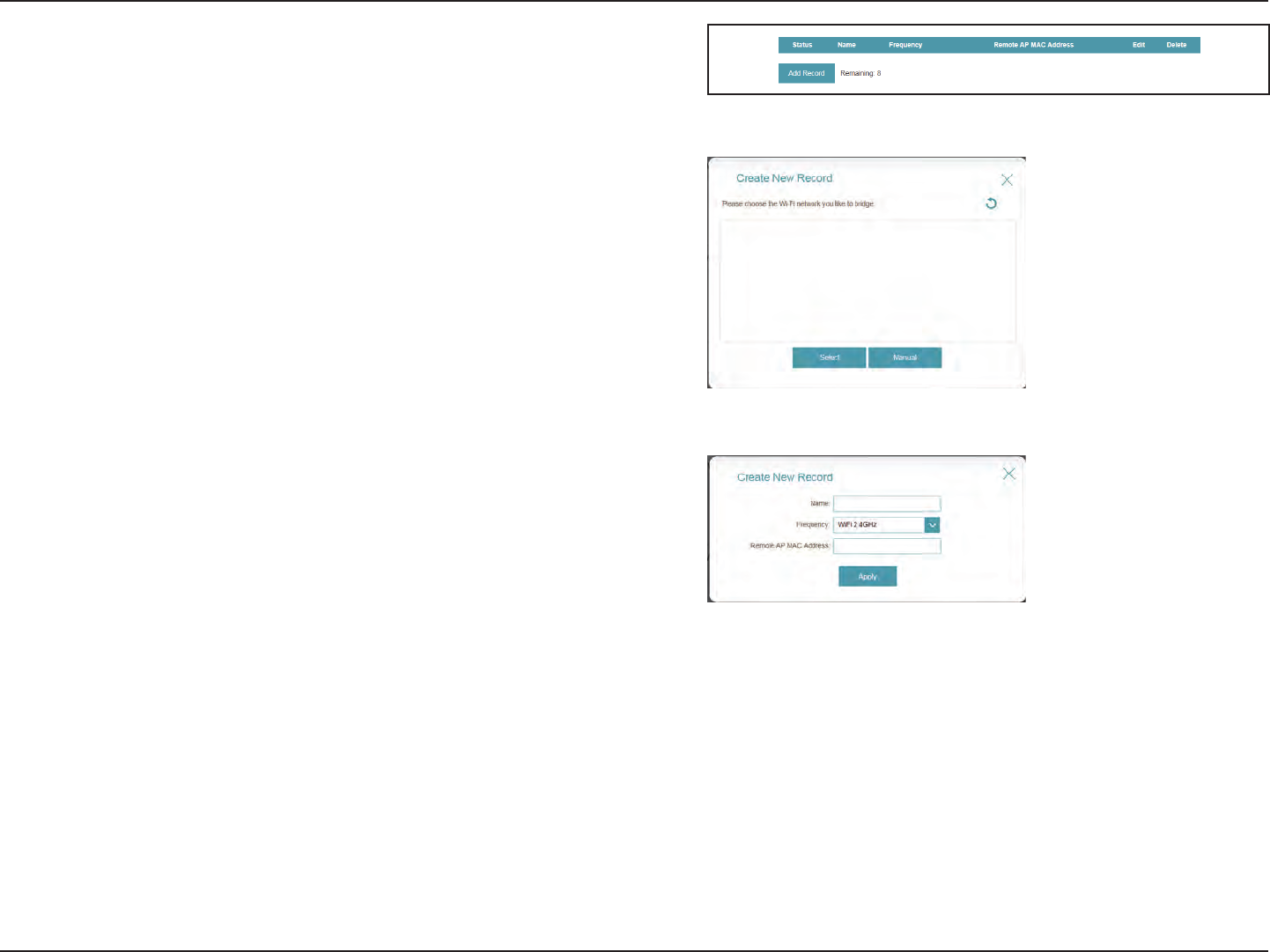
51D-Link DAP-1665 User Manual
Section 3 - Conguration
At the bottom of the page, click Add Record to create a new record of the
network you would like to bridge. A list of wireless networks will appear for you
to select from.
If the desired network is not listed, click Manual and type in the Name, select
the Frequency and type in the Remote AP MAC Address. Click Apply to save
the record.
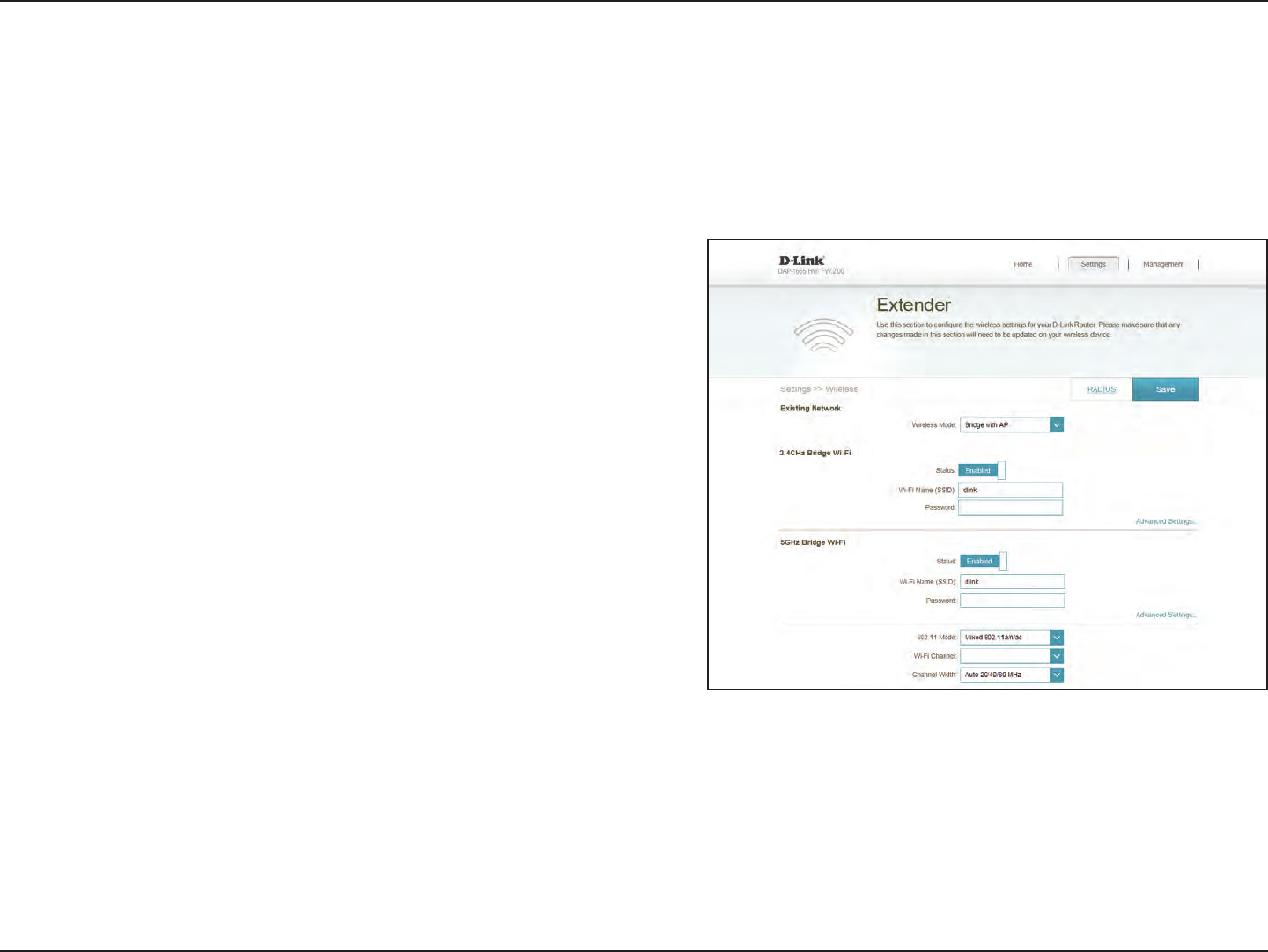
52D-Link DAP-1665 User Manual
Section 3 - Conguration
Bridge with AP Mode
Wireless Mode: Select Bridge with AP from the drop-down menu.
Existing Network
2.4 GHz Bridge Wi-Fi
Click to enable the wireless function for the 2.4 GHz band. If
you do not want to use wireless, uncheck the box to disable all
wireless functions.
Specify a network name (SSID) to identify the 2.4 GHz network.
This is the network name that wireless clients will search for
when connecting to your wireless network.
Enter a custom password for this network.
Select one of the following:
802.11n Only - Select if you are only using 802.11n wireless
clients.
Mixed 802.11n and 802.11g - Select if you are using a mix of
802.11n and 802.11g wireless clients.
Mixed 802.11n, 802.11g and 802.11b - Select if you are using
a mix of 802.11n, 802.11g, and 802.11b wireless clients.
Choose from channels 1-11 for an existing wireless network or
to reduce interference in congested areas.
Select the Channel Width:
Auto 20/40 - Select if you are using both 802.11n and non-
802.11n wireless devices.
20 MHz - Select if you are not using any 802.11n wireless clients.
Status:
Wi-Fi Name
(SSID):
Password:
802.11 Mode:
Wi-Fi Channel:
Channel Width:
Advanced Settings:
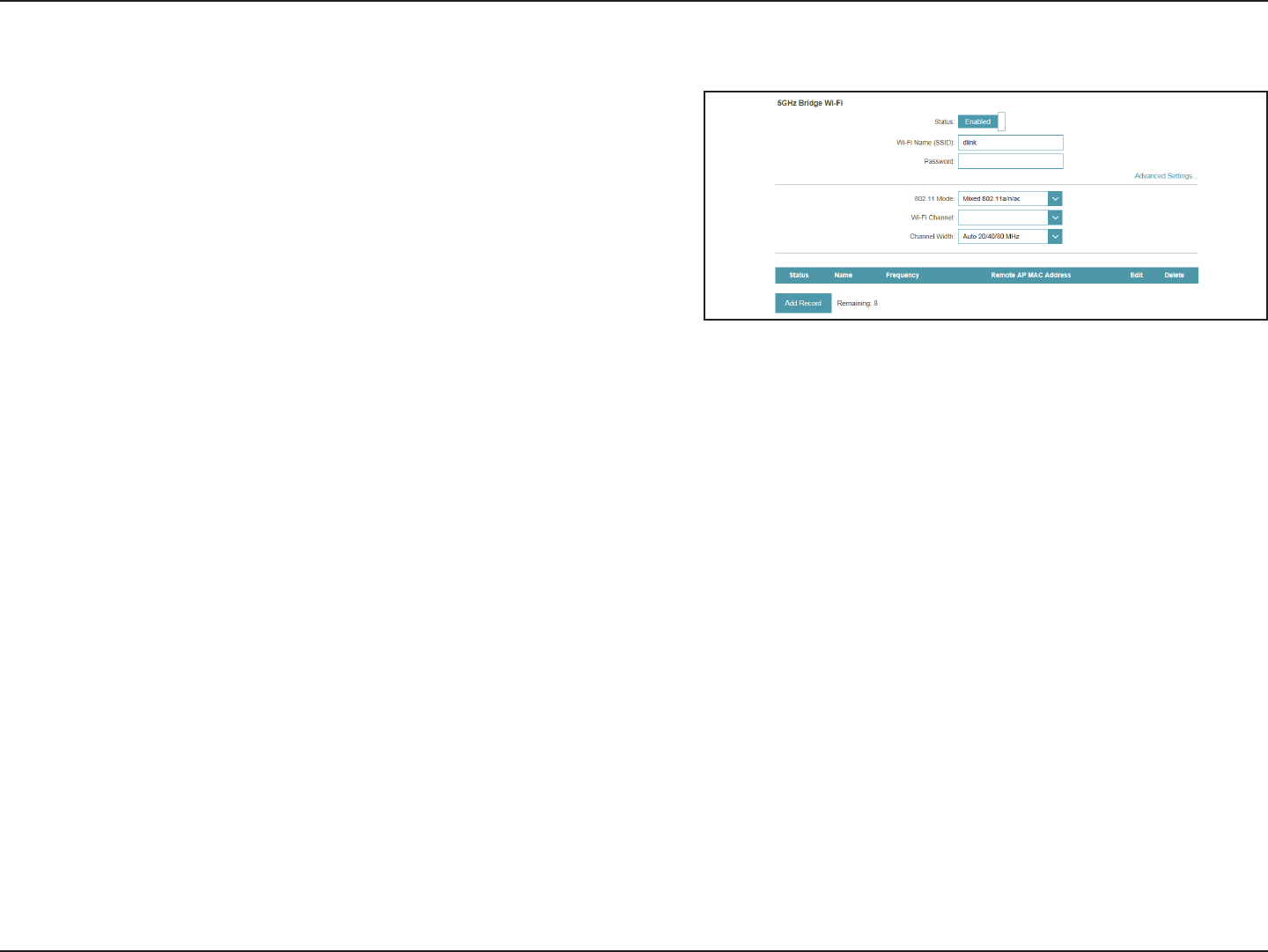
53D-Link DAP-1665 User Manual
Section 3 - Conguration
5 GHz Bridge Wi-Fi
Click to enable the wireless function for the 5 GHz band. If you
do not want to use wireless, uncheck the box to disable all
wireless functions.
Specify a network name (SSID) to identify the 5 GHz network.
This is the network name that wireless clients will search for
when connecting to your wireless network.
Enter a custom password for this network.
Select one of the following:
802.11a Only - Select if you are only using 802.11a wireless
clients.
802.11n Only - Select if you are only using 802.11n wireless
clients.
Mixed 802.11a/n - Select if you are using a mix of 802.11n and
802.11a wireless clients.
802.11ac Only - Select if you are only using 802.11ac wireless
clients.
Mixed 802.11n/ac - Select if you are using a mix of 802.11ac
and 802.11n wireless clients.
Mixed 802.11a/n/ac - Select if you are using a mix of 802.11ac,
802.11n, and 802.11a wireless clients.
Choose a channel from the drop-down list for an existing
wireless network or to reduce interference in congested areas.
Select the Channel Width:
Auto 20/40 - Select this if you are using both 802.11n and non-
802.11n wireless devices.
Auto 20/40/80 MHz - Select this if you are not using any 802.11n
wireless clients.
Status:
Wi-Fi Name
(SSID):
Password:
802.11 Mode:
Wi-Fi Channel:
Channel Width:
Advanced Settings:
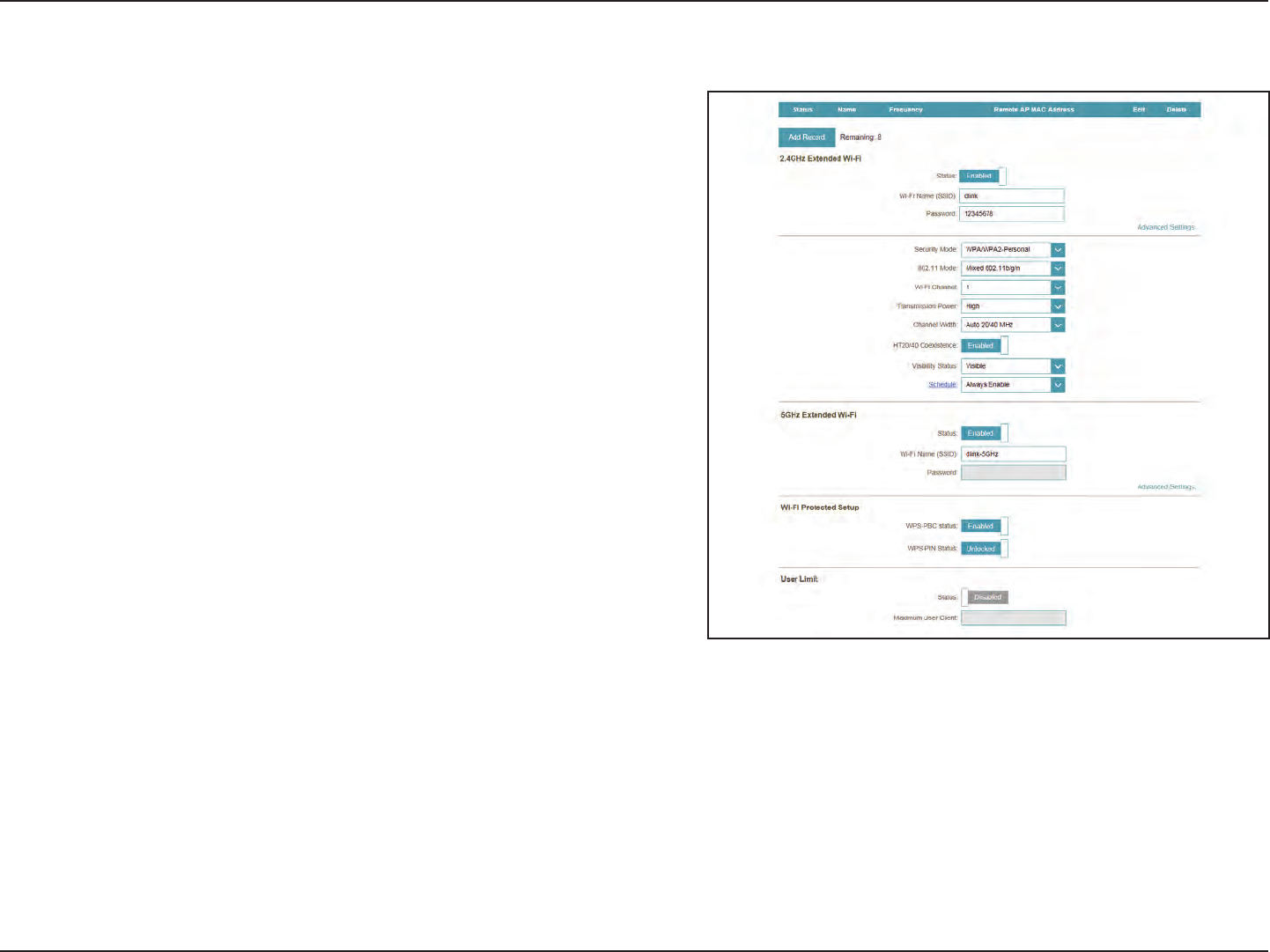
54D-Link DAP-1665 User Manual
Section 3 - Conguration
2.4 GHz Extended Wi-Fi
Click to enable the wireless function for the 2.4 GHz band. If
you do not want to use wireless, uncheck the box to disable all
wireless functions.
Specify a network name (SSID) to identify the 2.4 GHz network.
This is the network name that wireless clients will search for
when connecting to your wireless network.
Enter a custom password for this network.
Select one of the following:
802.11n Only - Select if you are only using 802.11n wireless
clients.
Mixed 802.11n and 802.11g - Select if you are using a mix of
802.11n and 802.11g wireless clients.
Mixed 802.11n, 802.11g and 802.11b - Select if you are using
a mix of 802.11n, 802.11g, and 802.11b wireless clients.
Choose from channels 1-11 for an existing wireless network or
to reduce interference in congested areas.
Depending on your wireless reception and coverage area, you
can choose between Low, Medium, or High power.
Select the Channel Width:
Auto 20/40 - Select if you are using both 802.11n and non-
802.11n wireless devices.
20 MHz - Select if you are not using any 802.11n wireless clients.
Enable or disable HT20/40 coexistence by toggling the slider.
Enabling this feature helps with device compatibility depending
on their 802.11 version.
Select whether you would like the network name (SSID) of your
wireless network to be Visible or Invisible to wireless clients.
If Invisible, the SSID of the DAP-1665 will not be seen by site
survey utilities, so wireless clients will have to manually enter
the SSID of your wireless network in order to connect to it.
Status:
Wi-Fi Name
(SSID):
Password:
802.11 Mode:
Wi-Fi Channel:
Transmission
Power:
Channel Width:
HT20/40
Coexistence:
Visibility Status:
Advanced Settings:
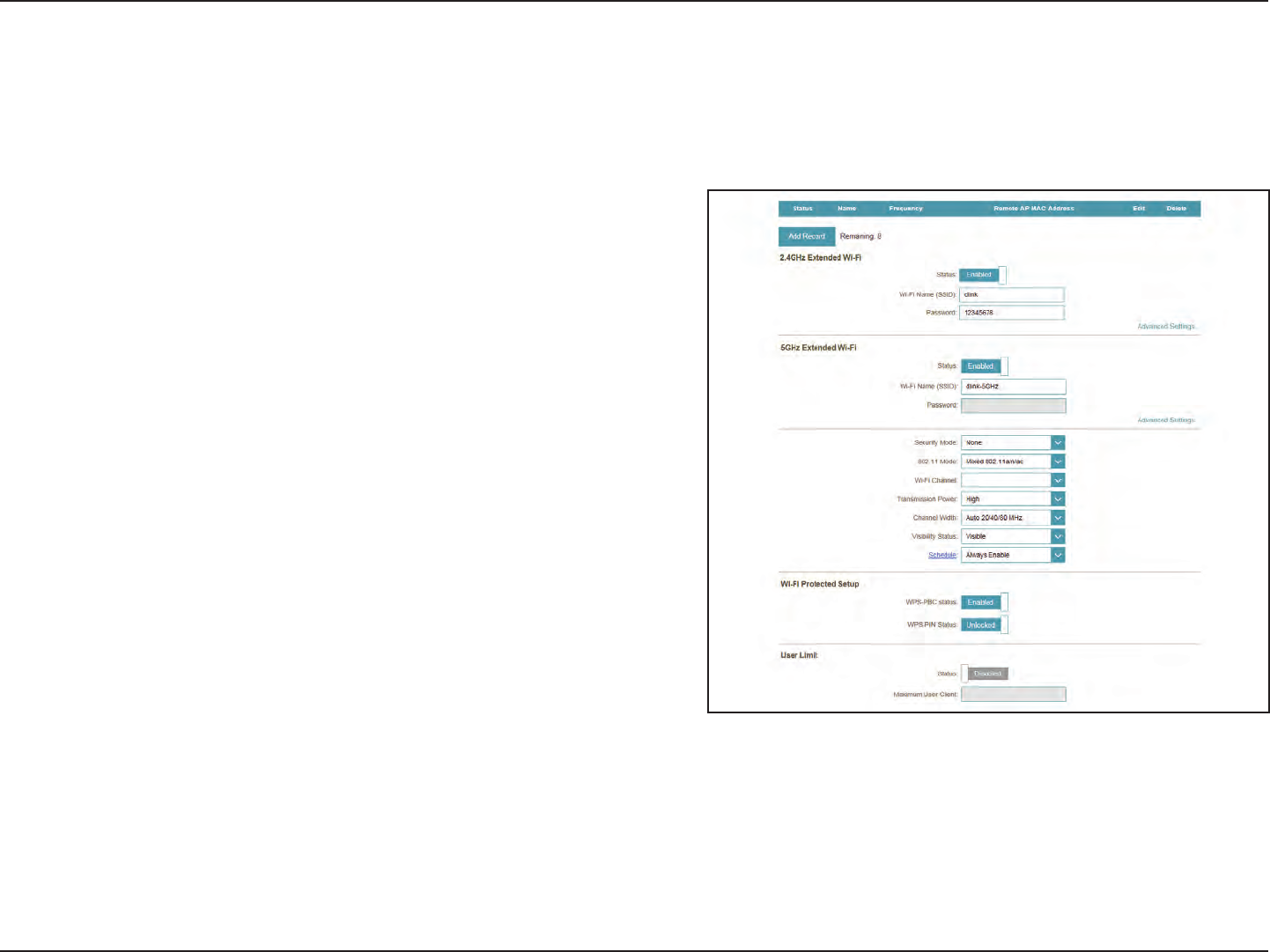
55D-Link DAP-1665 User Manual
Section 3 - Conguration
5 GHz Extended Wi-Fi
If you have added a rule under Management >> Schedule, click
on the drop-down menu to choose whether the device will
be Always Enable or choose from the name of your custom
schedule. Click Save to store the setting and the device will
reboot to activate the selected schedule.
Schedule:
Click to enable the wireless function for the 5 GHz band. If you
do not want to use wireless, uncheck the box to disable all
wireless functions.
Specify a network name (SSID) to identify the 5 GHz network.
This is the network name that wireless clients will search for
when connecting to your wireless network.
Enter a custom password for this network.
Select the type of wireless security you wish to use for the
extended network. Choose from WPA/WPA2-Personal/WPA/
WPA2-Enterprise/None.
Select one of the following:
802.11a Only - Select if you are only using 802.11a wireless
clients.
802.11n Only - Select if you are only using 802.11n wireless
clients.
Mixed 802.11a/n - Select if you are using a mix of 802.11n and
802.11a wireless clients.
802.11ac Only - Select if you are only using 802.11ac wireless
clients.
Mixed 802.11n/ac - Select if you are using a mix of 802.11ac
and 802.11n wireless clients.
Mixed 802.11a/n/ac - Select if you are using a mix of 802.11ac,
802.11n, and 802.11a wireless clients.
Choose a channel from the drop-down menu for an existing
wireless network or to reduce interference in congested areas.
Depending on your wireless reception and coverage area, you
can choose between Low, Medium, or High power.
Status:
Wi-Fi Name
(SSID):
Password:
Security
Mode:
802.11
Mode:
Wi-Fi
Channel:
Transmission
Power:
Advanced Settings:
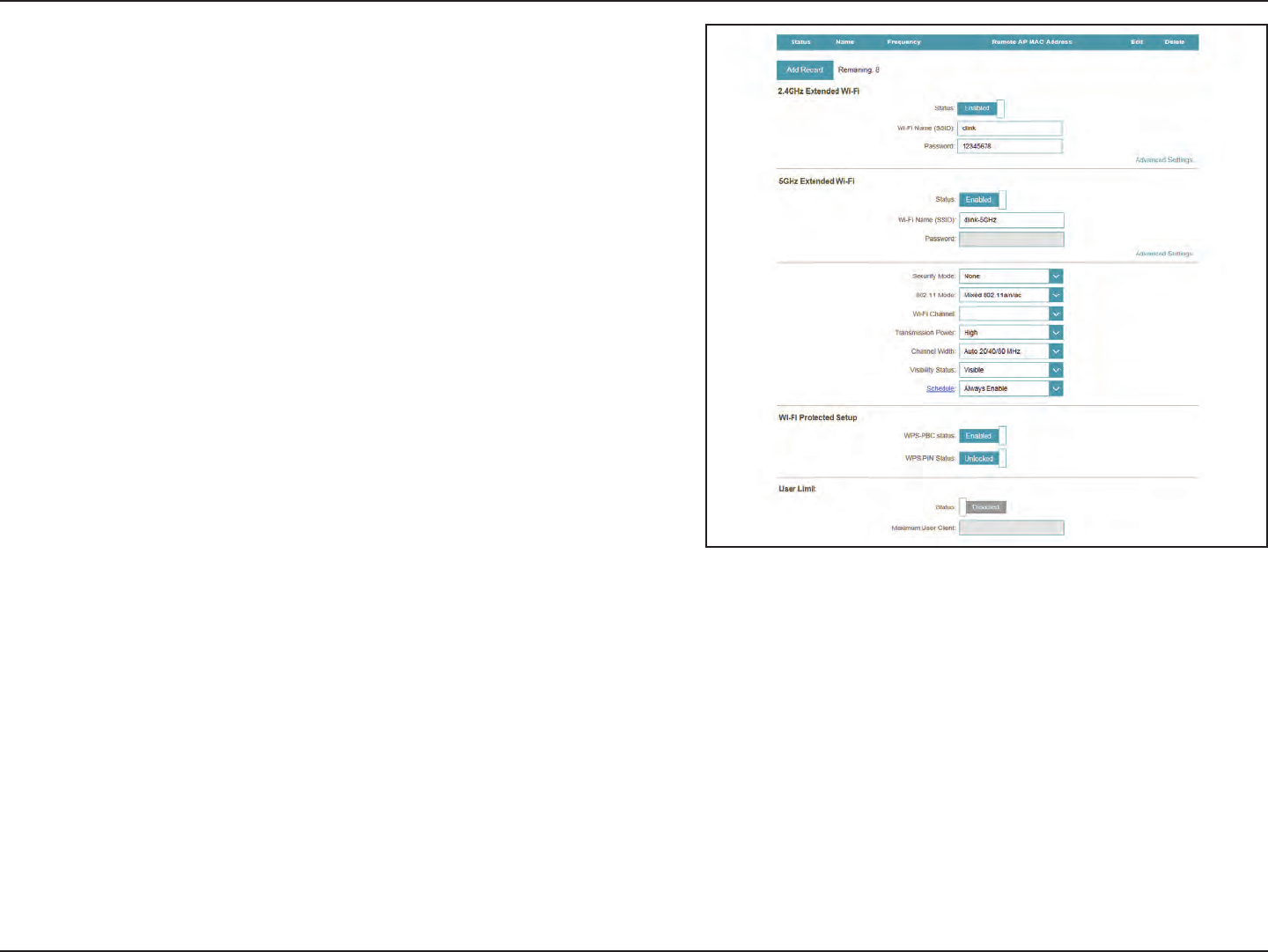
56D-Link DAP-1665 User Manual
Section 3 - Conguration
Channel
Width:
Visibility
Status:
Schedule:
Wi-Fi
Protected
Setup:
User Limit:
Select the Channel Width:
Auto 20/40 - Select if you are using both 802.11n and non-
802.11n wireless devices.
20/40/80 MHz - Select if you are not using any 802.11n wireless
clients.
Select whether you would like the network name (SSID) of your
wireless network to be Visible or Invisible to wireless clients.
If Invisible, the SSID of the DAP-1665 will not be seen by site
survey utilities, so wireless clients will have to manually enter
the SSID of your wireless network in order to connect to it.
If you have added a rule under Management >> Schedule, click
on the drop-down menu to choose whether the device will
be Always Enable or choose from the name of your custom
schedule. Click Save to store the setting and the device will
reboot to activate the selected schedule.
Enable WPS-PBC status if you wish to allow push button
connections to this device.
Unlocked enables the use of the PIN method for Wi-Fi Protected
Setup (WPS).
Enable this function and enter a number in the Maximum
User Client box to limit the amount of client connections to
this device.
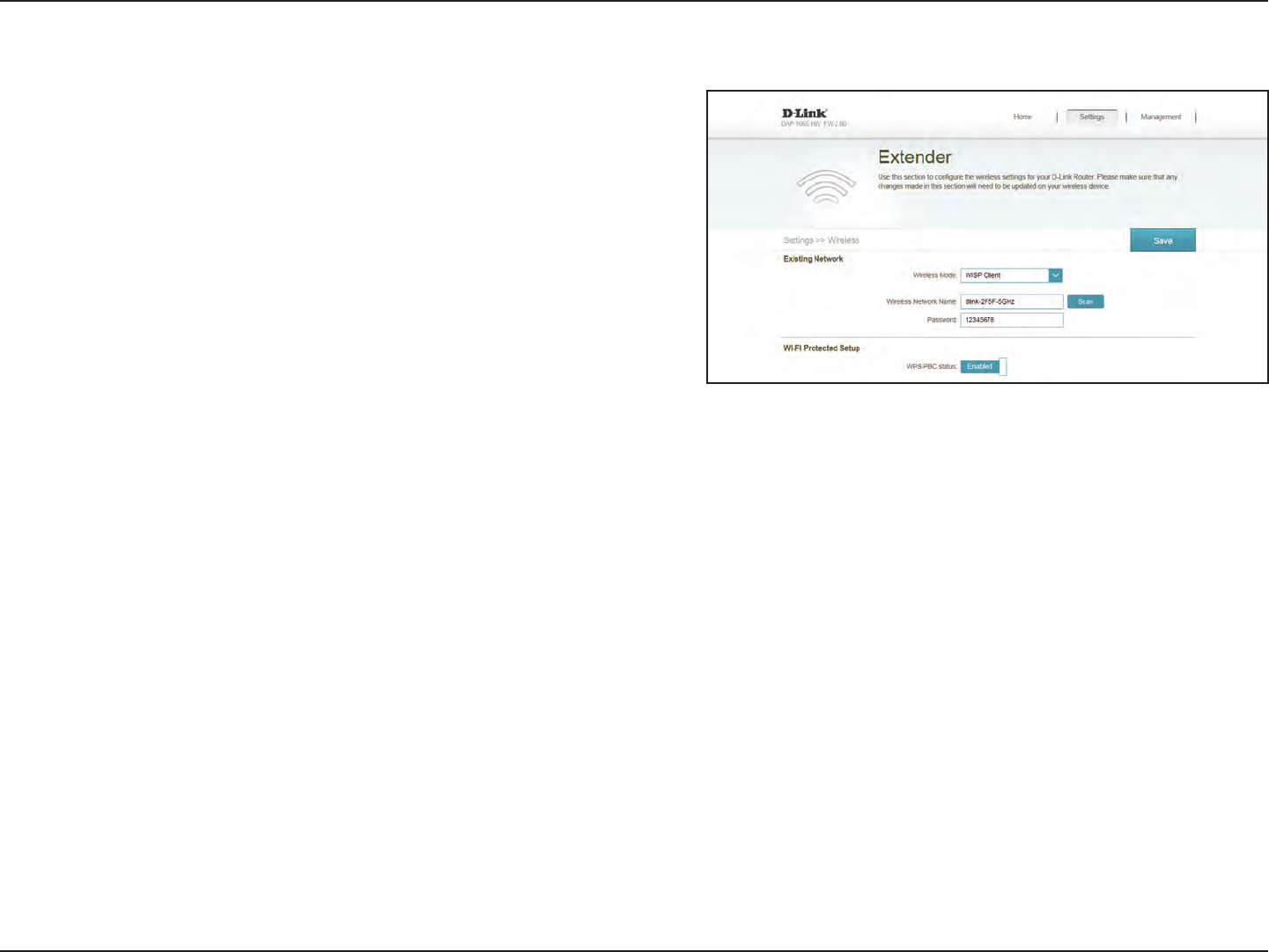
57D-Link DAP-1665 User Manual
Section 3 - Conguration
WISP Client
Wireless Mode:
Wireless Network
Name:
Password:
Select WISP Client from the drop-down menu.
Click Scan to display a list of wireless networks in your area. In
the pop-up, click on the SSID, and click Select at the bottom
of the page to continue. The wireless network name will
automatically appear in the Wireless Network Name eld below.
You can also manually enter the SSID of the network you want
to connect to.
Enter the password for the selected network. You may need to
ask the network administrator for this information.
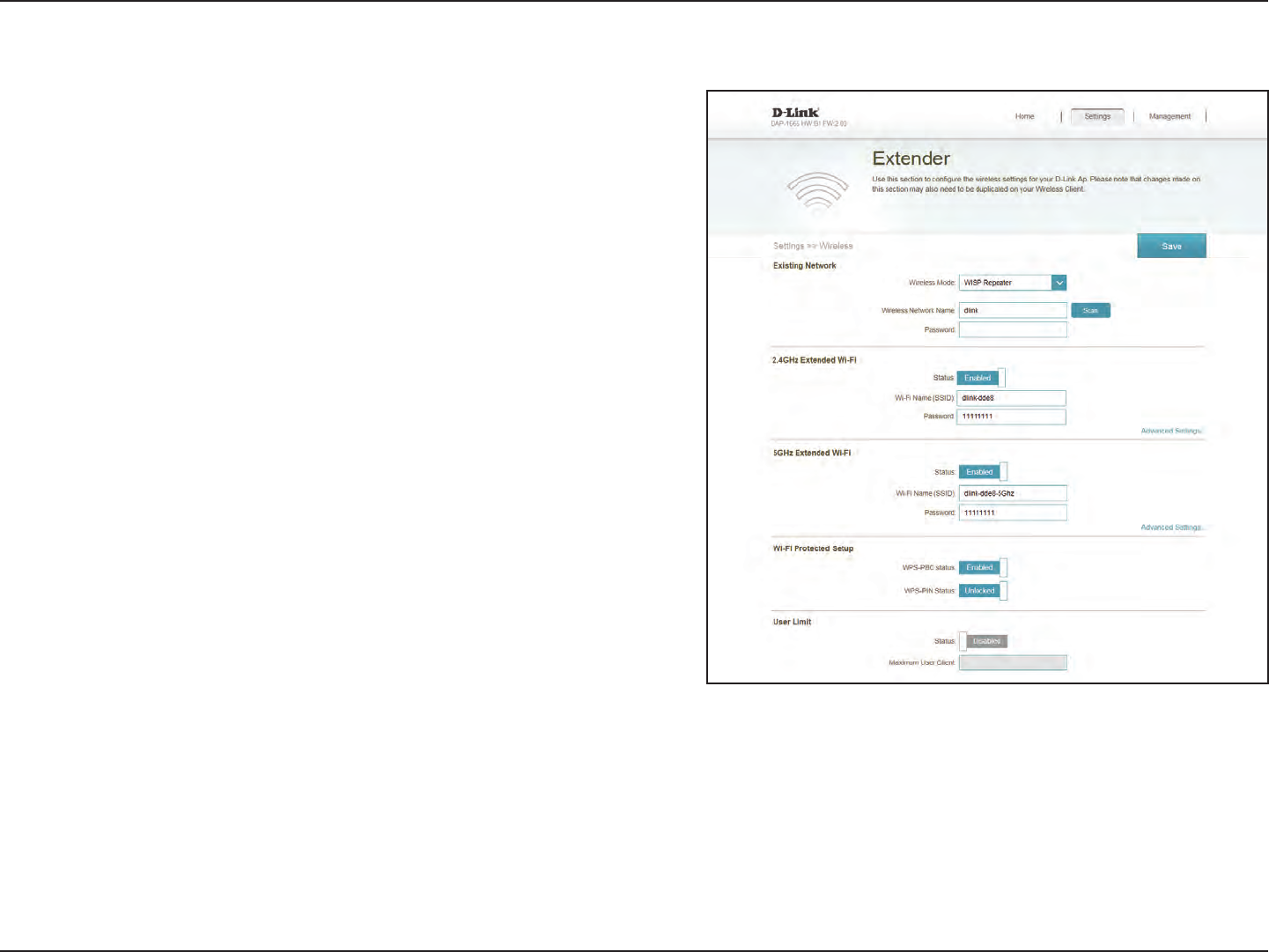
58D-Link DAP-1665 User Manual
Section 3 - Conguration
WISP Repeater
Wireless Mode:
Wireless Network
Name:
Password:
Select WISP Repeater from the drop-down menu.
Click Scan to display a list of wireless networks in your area. In
the pop-up, click on the SSID, and click Select at the bottom
of the page to continue. The wireless network name will
automatically appear in the Wireless Network Name eld below.
You can also manually enter the SSID of the network you want
to connect to.
Enter the password for the selected network. You may need to
ask the network administrator for this information.
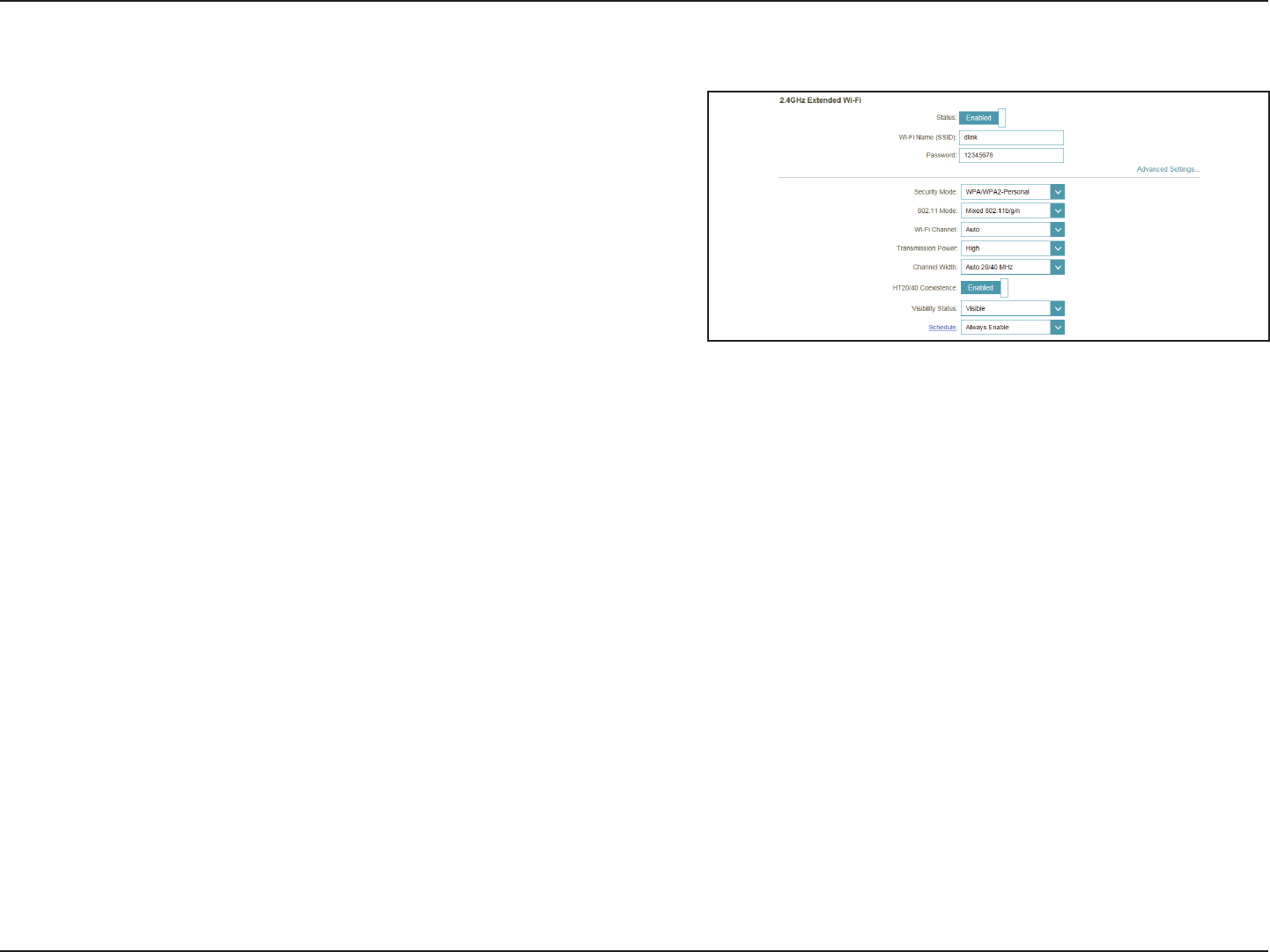
59D-Link DAP-1665 User Manual
Section 3 - Conguration
2.4 GHz Extended Wi-Fi
Click to enable the wireless function for the 2.4 GHz band. If
you do not want to use wireless, uncheck the box to disable all
wireless functions.
Specify a network name (SSID) to identify the extended 2.4
GHz network. This is the network name that wireless clients will
search for when connecting to your wireless network.
Enter a custom password for this network.
Select one of the following:
802.11n Only - Select if you are only using 802.11n wireless
clients.
Mixed 802.11n and 802.11g - Select if you are using a mix of
802.11n and 802.11g wireless clients.
Mixed 802.11n, 802.11g and 802.11b - Select if you are using
a mix of 802.11n, 802.11g, and 802.11b wireless clients.
This is set on Auto for best performance when using WISP.
Depending on your wireless reception and coverage area, you
can choose between Low, Medium, or High power.
Select the Channel Width:
Auto 20/40 - Select if you are using both 802.11n and non-
802.11n wireless devices.
20 MHz - Select if you are not using any 802.11n wireless clients.
Enable or disable HT20/40 coexistence by toggling the slider.
Enabling this feature helps with device compatibility depending
on their 802.11 version.
Select whether you would like the network name (SSID) of your
wireless network to be Visible or Invisible to wireless clients.
If Invisible, the SSID of the DAP-1665 will not be seen by site
survey utilities, so wireless clients will have to manually enter
the SSID of your wireless network in order to connect to it.
Status:
Wi-Fi Name
(SSID):
Password:
802.11 Mode:
Wi-Fi Channel:
Transmission
Power:
Channel Width:
HT20/40
Coexistence:
Visibility Status:
Advanced Settings:
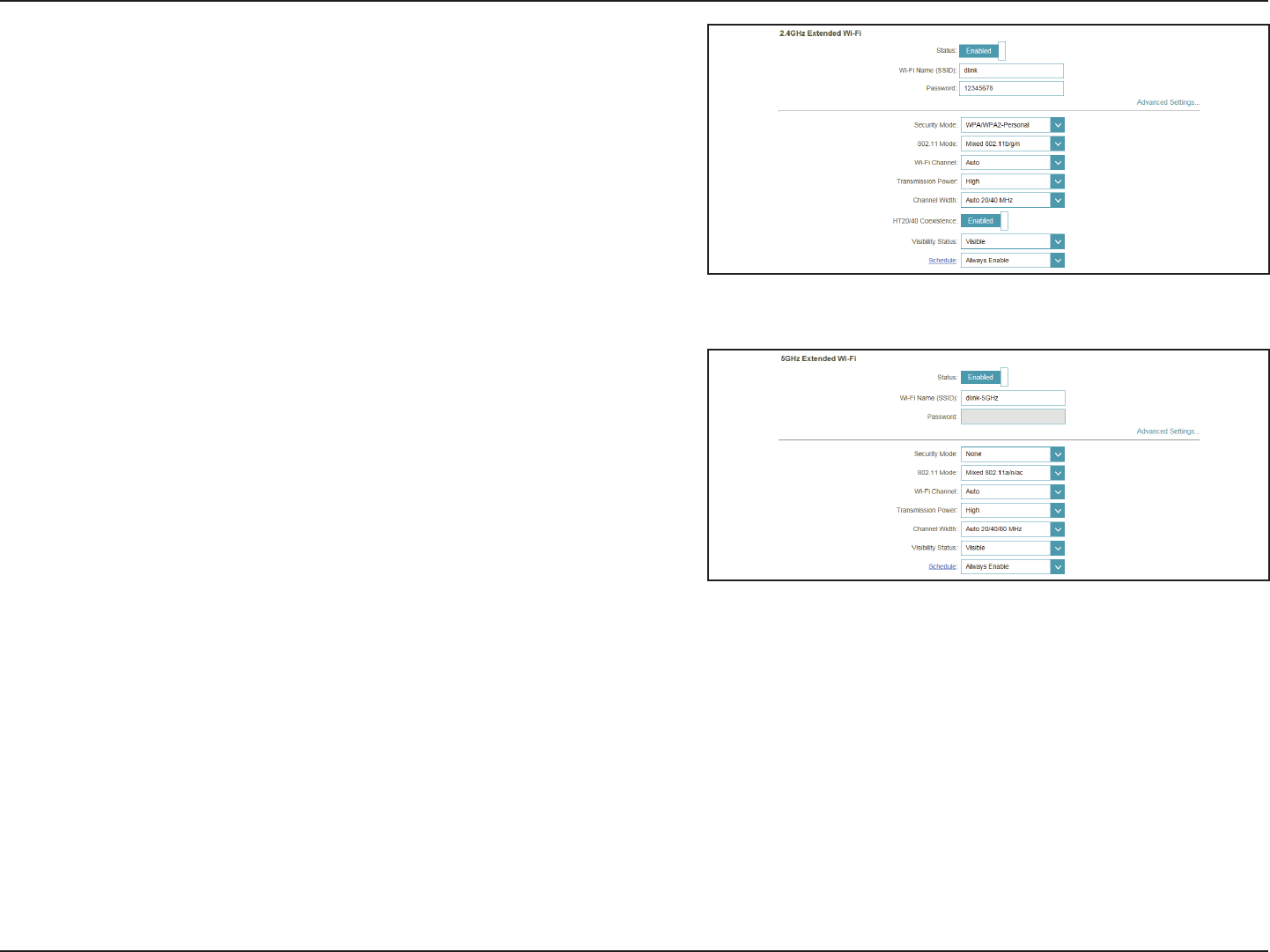
60D-Link DAP-1665 User Manual
Section 3 - Conguration
If you have added a rule under Management >> Schedule, click
on the drop-down menu to choose whether the device will
be Always Enable or choose from the name of your custom
schedule. Click Save to store the setting and the device will
reboot to activate the selected schedule.
Schedule:
5 GHz Extended Wi-Fi
Click to enable the wireless function for the 5 GHz band. If you
do not want to use wireless, uncheck the box to disable all
wireless functions.
Specify a network name (SSID) to identify the 5 GHz network.
This is the network name that wireless clients will search for
when connecting to your wireless network.
Enter a custom password for this network.
Select the type of wireless security you wish to use for the
extended network. Choose from WPA/WPA2-Personal/WPA/
WPA2-Enterprise/None.
Select one of the following:
802.11a Only - Select if you are only using 802.11a wireless
clients.
802.11n Only - Select if you are only using 802.11n wireless
clients.
Mixed 802.11a/n - Select if you are using a mix of 802.11n and
802.11a wireless clients.
802.11ac Only - Select if you are only using 802.11ac wireless
clients.
Mixed 802.11n/ac - Select if you are using a mix of 802.11ac
and 802.11n wireless clients.
Mixed 802.11a/n/ac - Select if you are using a mix of 802.11ac,
802.11n, and 802.11a wireless clients.
Status:
Wi-Fi Name
(SSID):
Password:
Security
Mode:
802.11
Mode:
Advanced Settings:
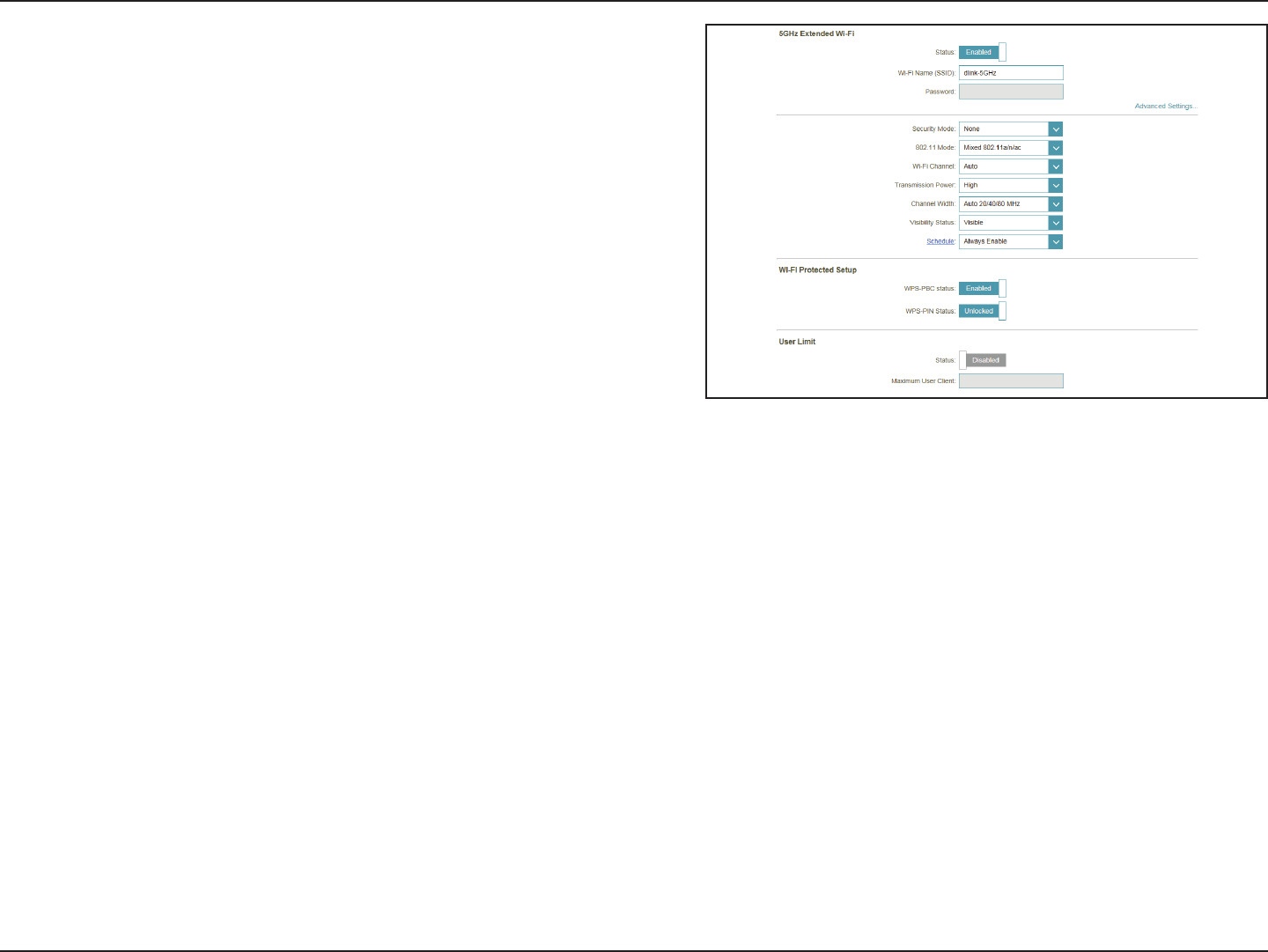
61D-Link DAP-1665 User Manual
Section 3 - Conguration
Wi-Fi
Channel:
Transmission
Power:
Channel
Width:
Visibility
Status:
Schedule:
Wi-Fi
Protected
Setup:
User Limit:
Choose a channel from the drop-down menu for an existing
wireless network or to reduce interference in congested areas.
Depending on your wireless reception and coverage area, you
can choose between Low, Medium, or High power.
Select the Channel Width:
Auto 20/40 - Select if you are using both 802.11n and non-
802.11n wireless devices.
20/40/80 MHz - Select if you are not using any 802.11n wireless
clients.
Select whether you would like the network name (SSID) of your
wireless network to be Visible or Invisible to wireless clients.
If Invisible, the SSID of the DAP-1665 will not be seen by site
survey utilities, so wireless clients will have to manually enter
the SSID of your wireless network in order to connect to it.
If you have added a rule under Management >> Schedule, click
on the drop-down menu to choose whether the device will
be Always Enable or choose from the name of your custom
schedule. Click Save to store the setting and the device will
reboot to activate the selected schedule.
Enable WPS-PBC status if you wish to allow push button
connections to this device.
Unlocked enables the use of the PIN method for Wi-Fi Protected
Setup (WPS).
Enable this function and enter a number in the Maximum
User Client box to limit the amount of client connections to
this device.
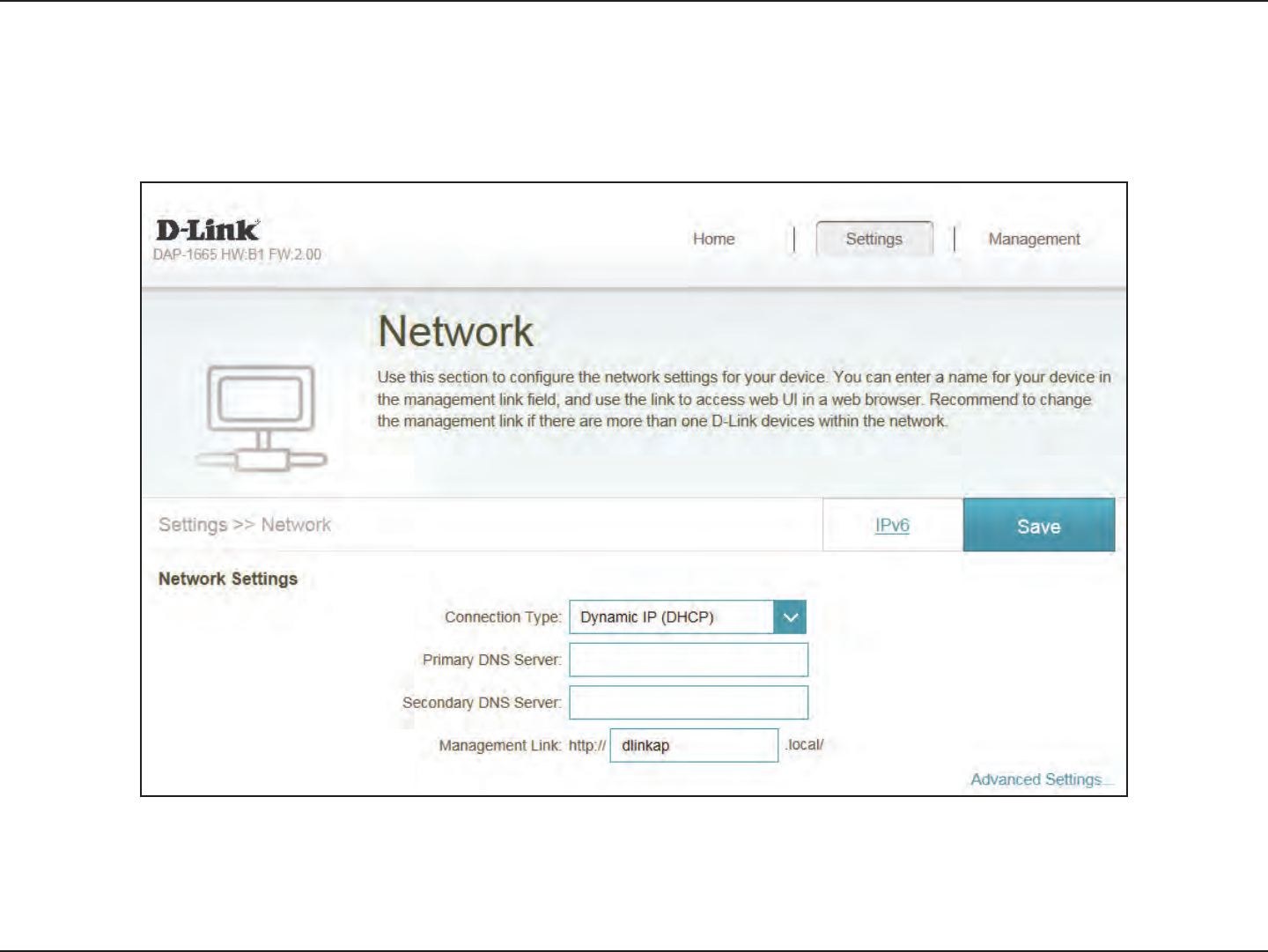
62D-Link DAP-1665 User Manual
Section 3 - Conguration
Network Settings
This page lets you congure the network settings for the DAP-1665. To access this page, click the Settings at the top of the
page, then select Network. Click Save at any time to save the changes you have made on this page.
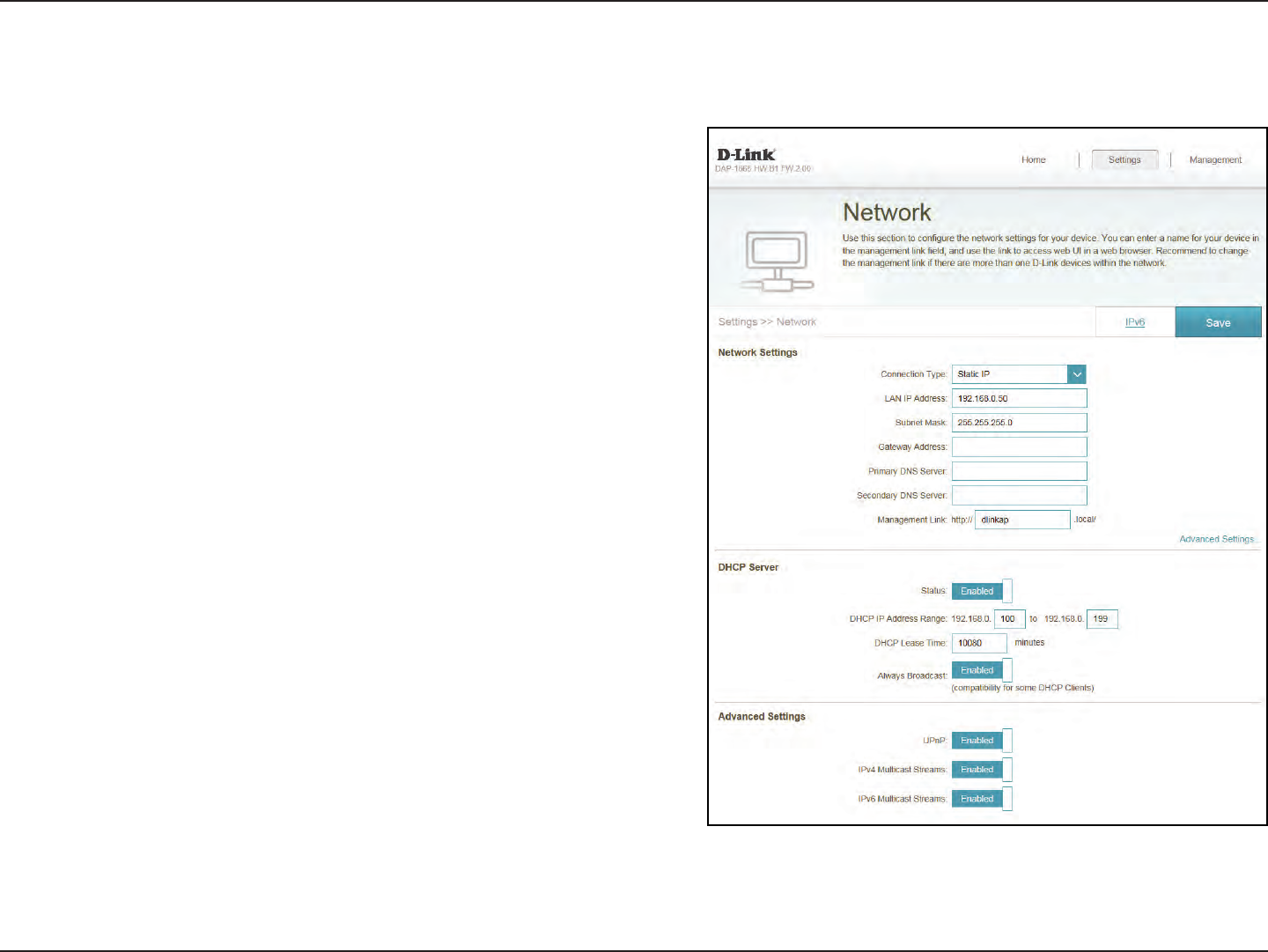
63D-Link DAP-1665 User Manual
Section 3 - Conguration
Static IP
Connection
Type:
LAN IP Address:
Subnet Mask:
Gateway
Address:
Primary DNS
Server:
Secondary DNS
Server:
Management
Link:
Select Static IP to manually assign an IP address to the
DAP-1665.
Enter the IPv4 address that you want to assign to the network
AP. This address should be outside of the uplink router’s DHCP
address pool.
Enter the subnet mask.
Enter the gateway address. This is usually the IP address of the
uplink router.
Enter the address of the primary DNS server.
Enter the address of the secondary DNS server. This is optional
but will provide backup if the primary server fails.
Enter a custom URL link to access this management interface.
IPv4
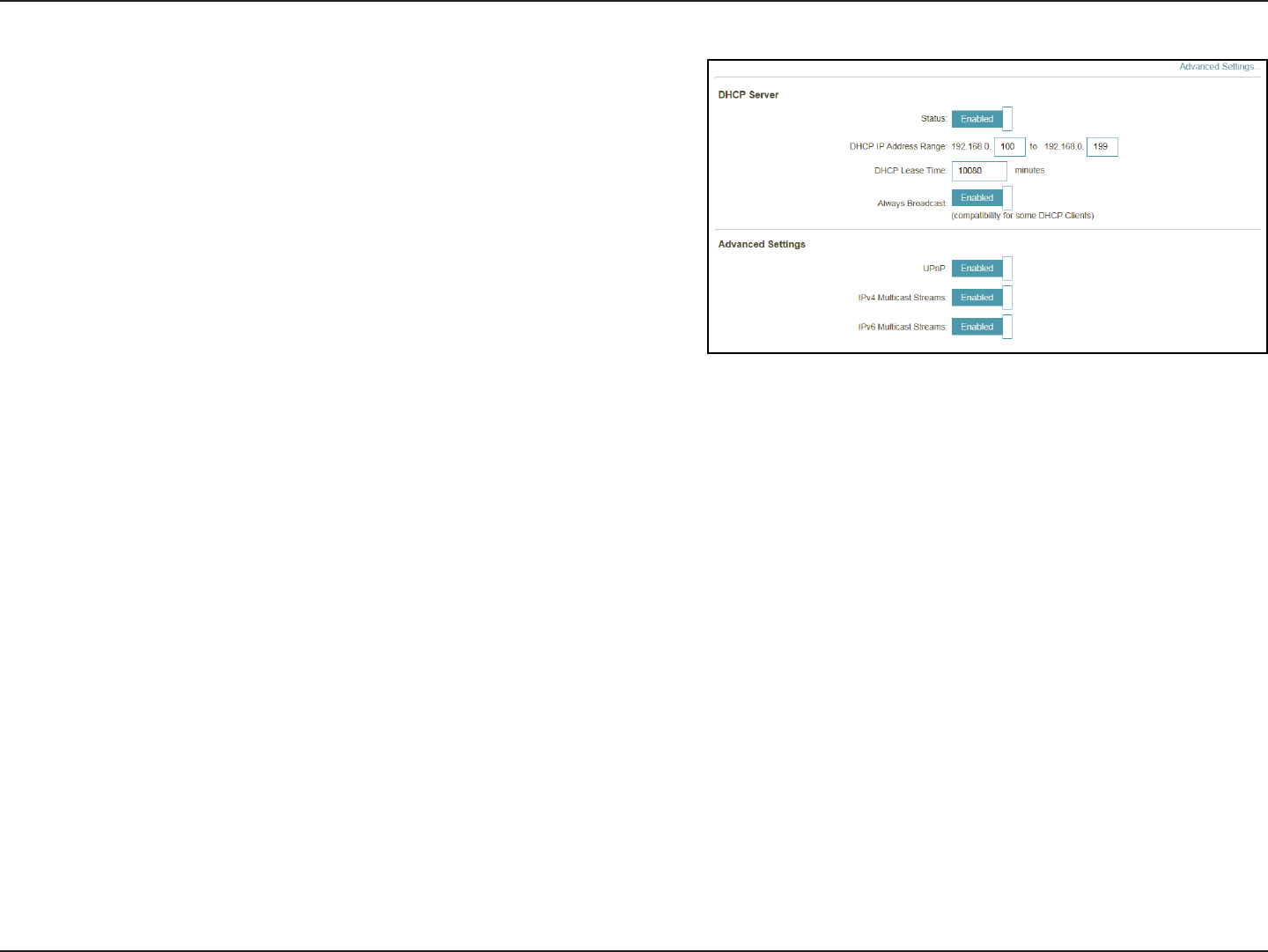
64D-Link DAP-1665 User Manual
Section 3 - Conguration
Status:
DHCP IP Address
Range:
DHCP Lease Time:
Always
Broadcast:
UPnP:
IPv4/IPv6
Multicast
Streams:
Click to enable the DHCP server function.
Enter the range of the DHCP address pool from which requesting
clients can be assigned addresses. You should ensure that the
access point’s static IP address is outside of this range in order
to avoid any IP address conicts.
Enter the length of time IP addresses assigned by the server
will be valid for.
Check the box to have the DHCP server always broadcast its
response to clients. This can help to avoid problems when clients
fail to obtain an IP address from the DHCP server.
Enable this to allow universal Plug and Play functionality.
Enable each on to allow multicasting to clients on IPv4/IPv6
networks.
Advanced Settings:
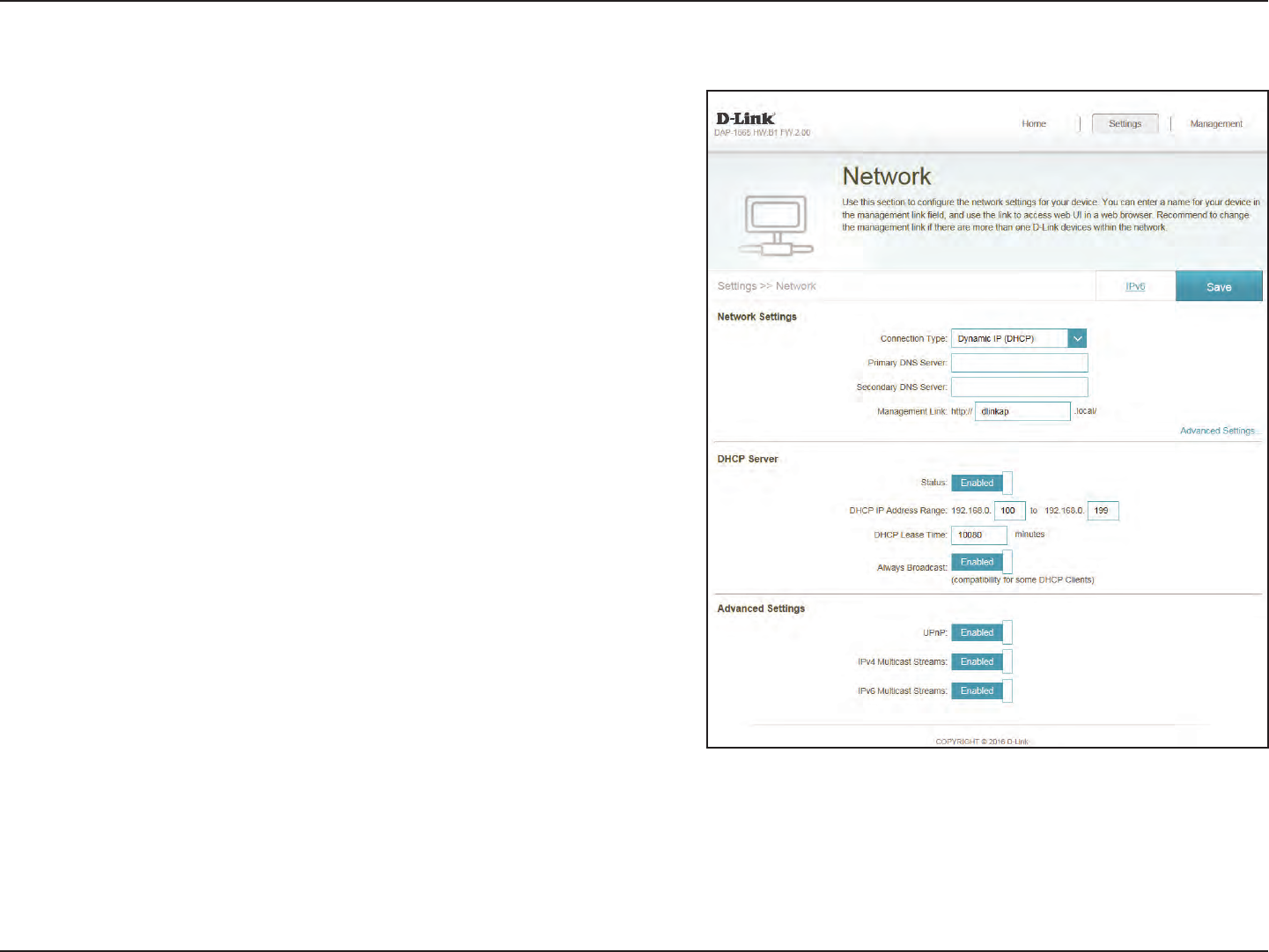
65D-Link DAP-1665 User Manual
Section 3 - Conguration
Dynamic IP (DHCP)
Connection
Type:
Primary DNS
Server:
Secondary DNS
Server:
Management
Link:
Select Dynamic IP to automatically assign an IP address to the
DAP-1665.
Enter the address of the primary DNS server.
Enter the address of the secondary DNS server. This is optional
but will provide backup if the primary server fails.
Enter a custom URL link to access this management interface.
Status:
DHCP IP Address
Range:
DHCP Lease Time:
Always
Broadcast:
UPnP:
IPv4/IPv6
Multicast
Streams:
Click to enable the DHCP server function.
Enter the range of the DHCP address pool from which requesting
clients can be assigned addresses. You should ensure that the
access point’s static IP address is outside of this range in order
to avoid any IP address conicts.
Enter the length of time IP addresses assigned by the server
will be valid for.
Check the box to have the DHCP server always broadcast its
response to clients. This can help to avoid problems when clients
fail to obtain an IP address from the DHCP server.
Enable this to allow universal Plug and Play functionality.
Enable each on to allow multicasting to clients on IPv4/IPv6
networks.
Advanced Settings:
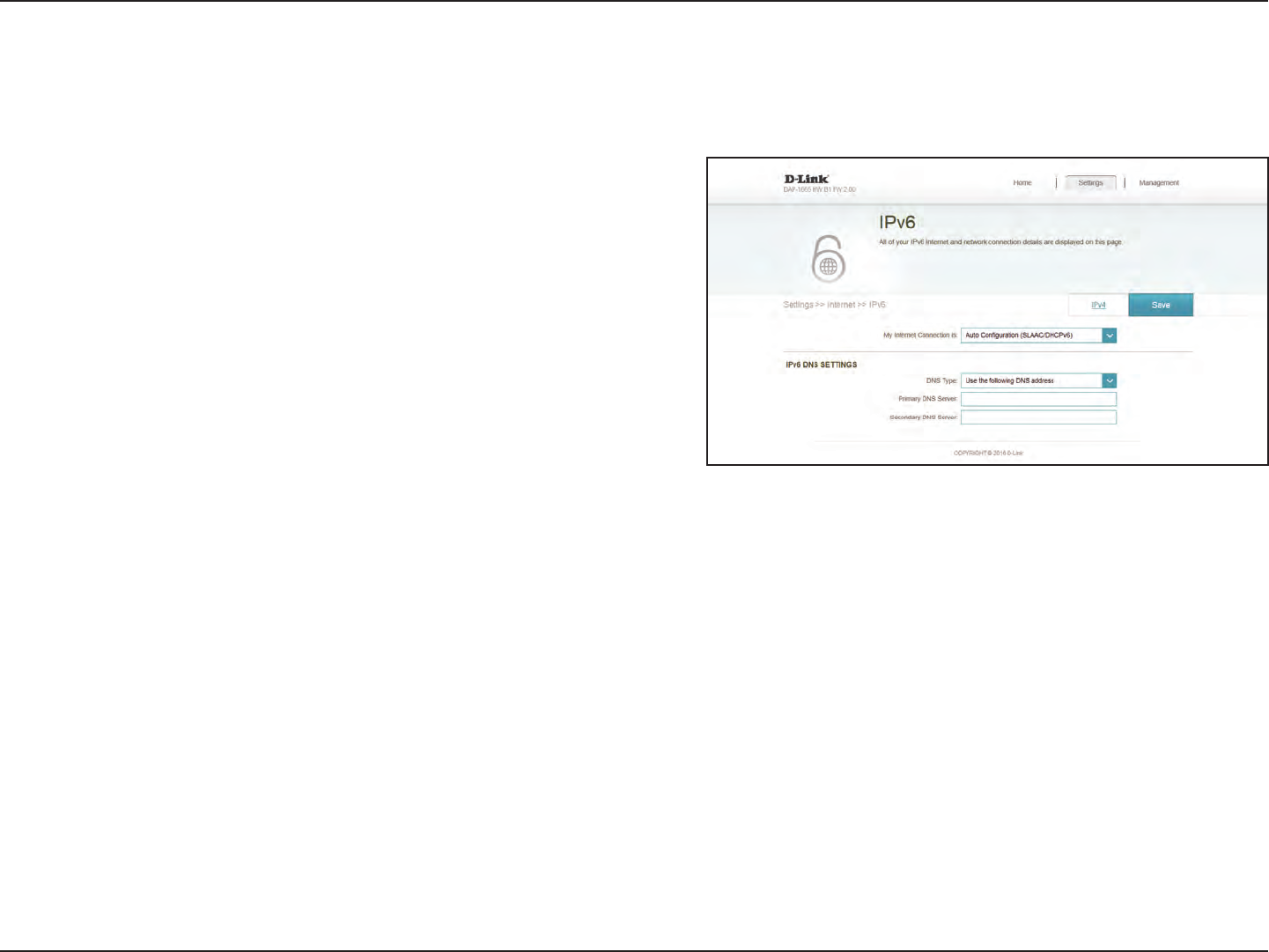
66D-Link DAP-1665 User Manual
Section 3 - Conguration
My Internet
Connection is:
DNS Type:
Primary DNS
Server:
Secondary DNS
Server:
Select Autoconfiguration (SLAAC/DHCPv6) to have the
DAP-1665 automatically receive an IPv6 address from the uplink
router.
You can select to obtain IPv6 DNS server information
automatically, or you can select to configure DNS servers
manually and ll in the boxes accordingly.
For manual settings, enter the primary IPv6 DNS server address.
For manual settings, enter the secondary IPv6 DNS server
address. This is optional but will provide backup if the primary
server fails.
Autoconguration (SLAAC/DHCPv6)
IPv6
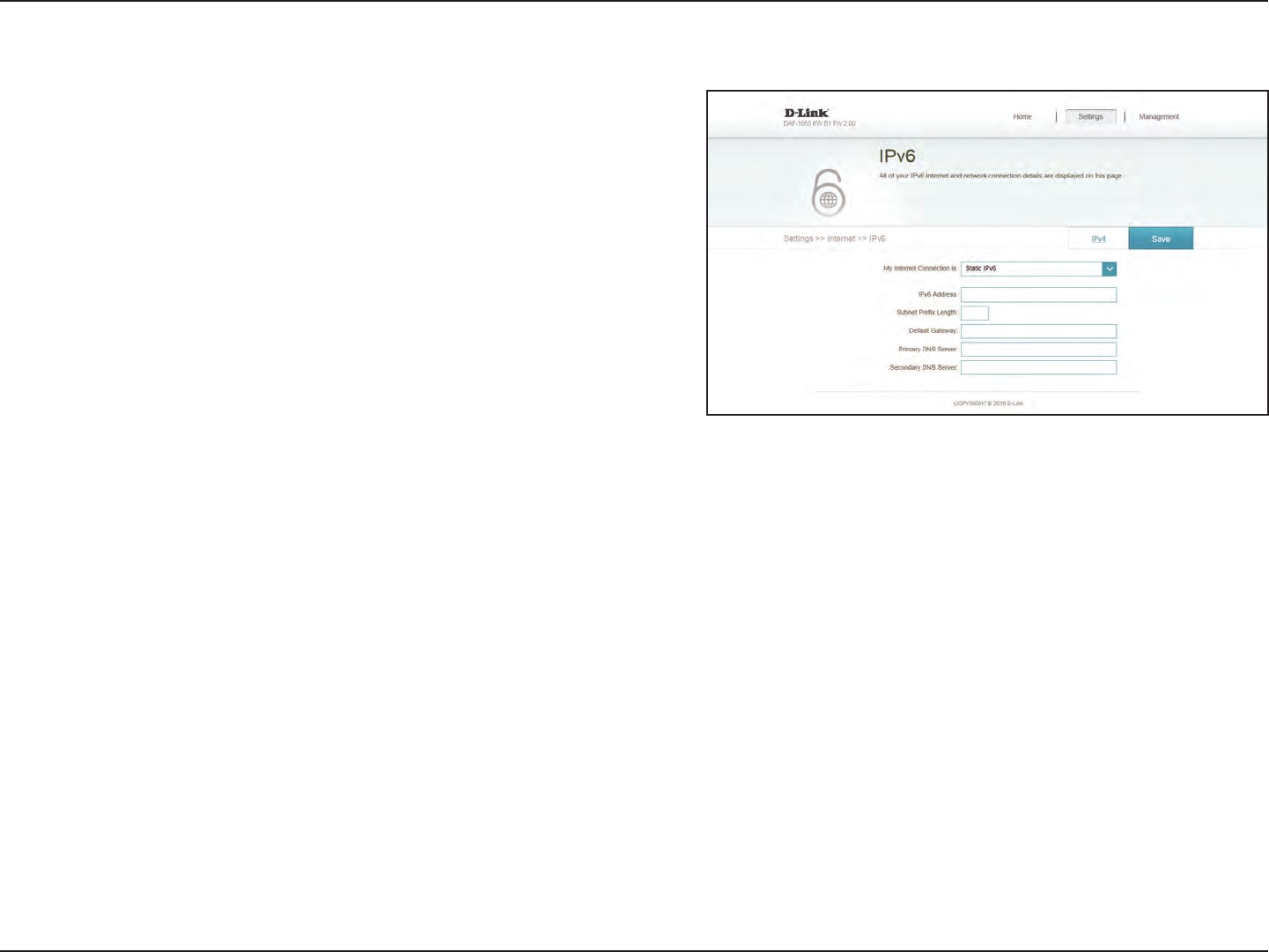
67D-Link DAP-1665 User Manual
Section 3 - Conguration
My Internet
Connection is:
IPv6 Address:
Subnet Prex
Length:
Default
Gateway:
Primary DNS
Server:
Secondary DNS
Server:
Select Static IPv6 to manually assign an IP address to the
DAP-1665.
Enter the IPv6 address that you want to assign to the extended
network AP. This address should be outside of the uplink router’s
DHCP address pool.
Enter the length of the IPv6 subnet prex.
Enter the default gateway.
Enter the primary IPv6 DNS server address.
Enter the secondary IPv6 DNS server address. This is optional
but will provide backup if the primary server fails.
Static IPv6
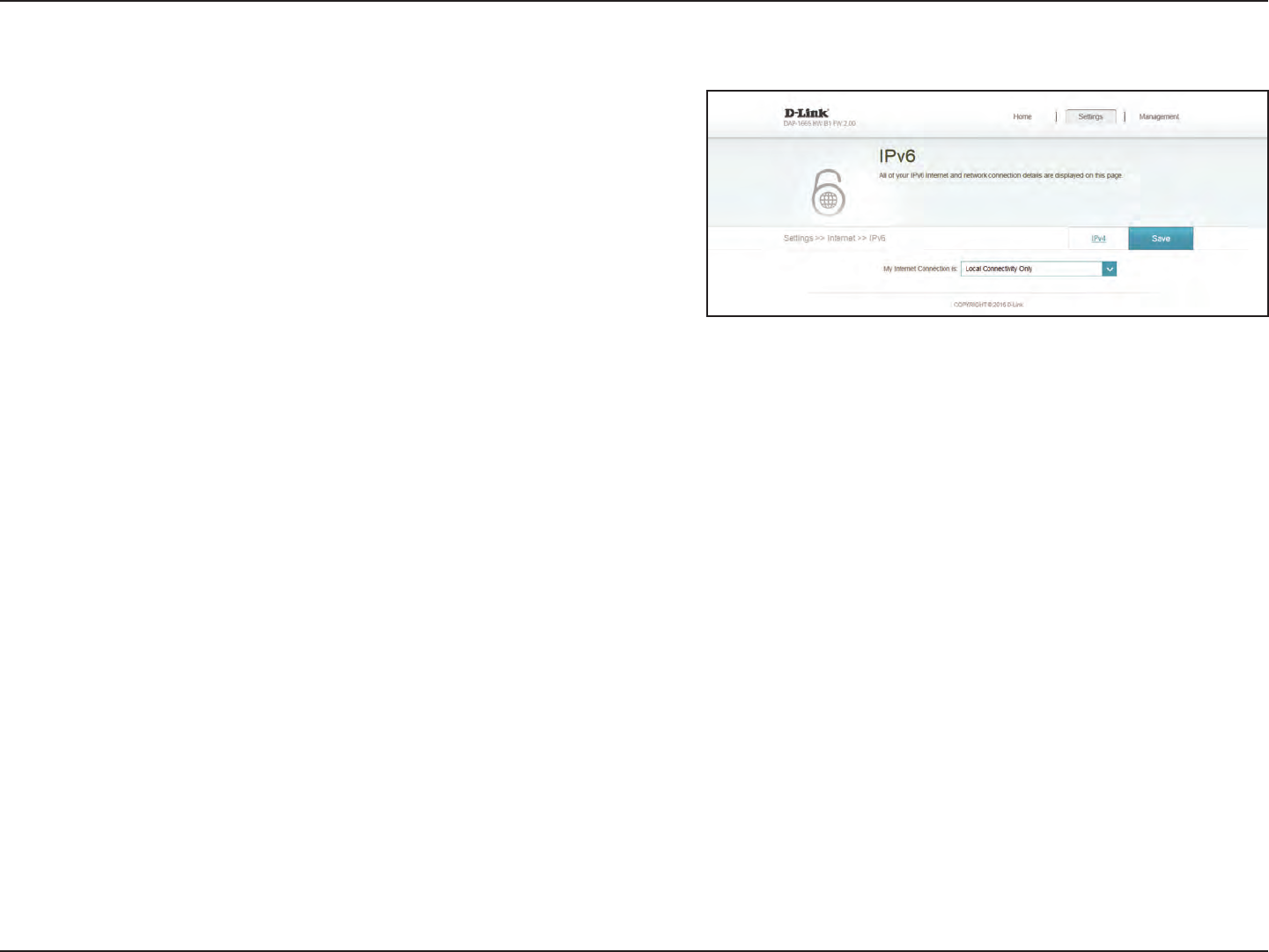
68D-Link DAP-1665 User Manual
Section 3 - Conguration
My Internet
Connection is:
LAN IPv6 Link-
Local Address:
Select Link-local only to only set an IPv6 address for the local
network.
Shows the link-local address of the DAP-1665.
Local Connectivity Only
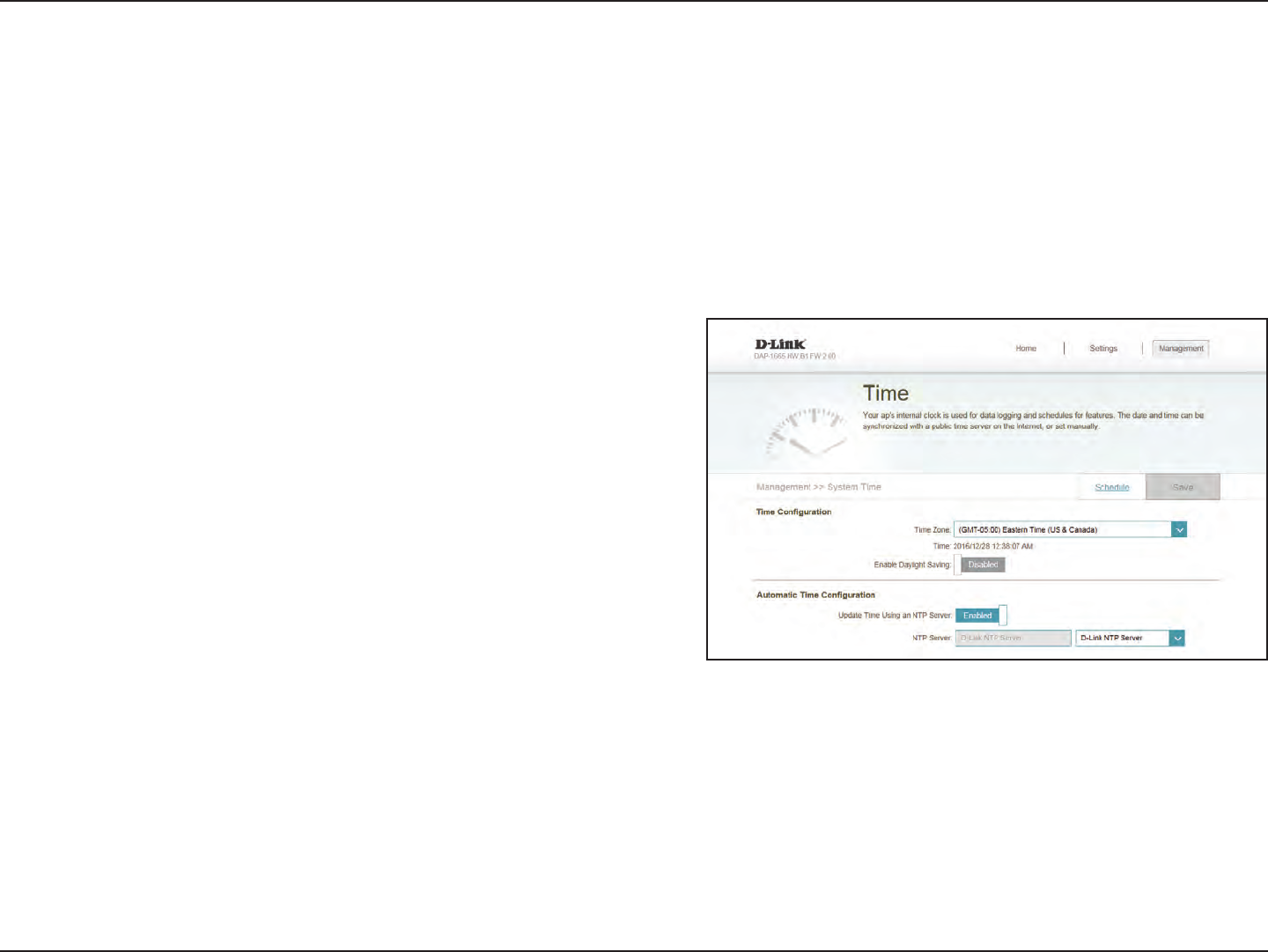
69D-Link DAP-1665 User Manual
Section 3 - Conguration
Management
The Management section allows you to adjust the administrative settings of the router such as time and date, administrator
password, and update the device’s rmware. Click Save to apply your settings.
Time
Conguration:
Automatic Time
Conguration:
Select the Time Zone from the drop-down box and Enable or
disable Daylight Saving
Enable Update Time Using an NTP Server if you have a valid
connection to an NTP server you with to use.
You can type in a custom IP address in the NTP Server eld if
you have selected Manual from the drop-down box.
Time & Schedule
Use the Time page to congure the time and date settings of the access point. You can also congure daylight saving adjustments
and synchronize the access point’s clock and calendar with an Internet-based Network Time Protocol (NTP) server.
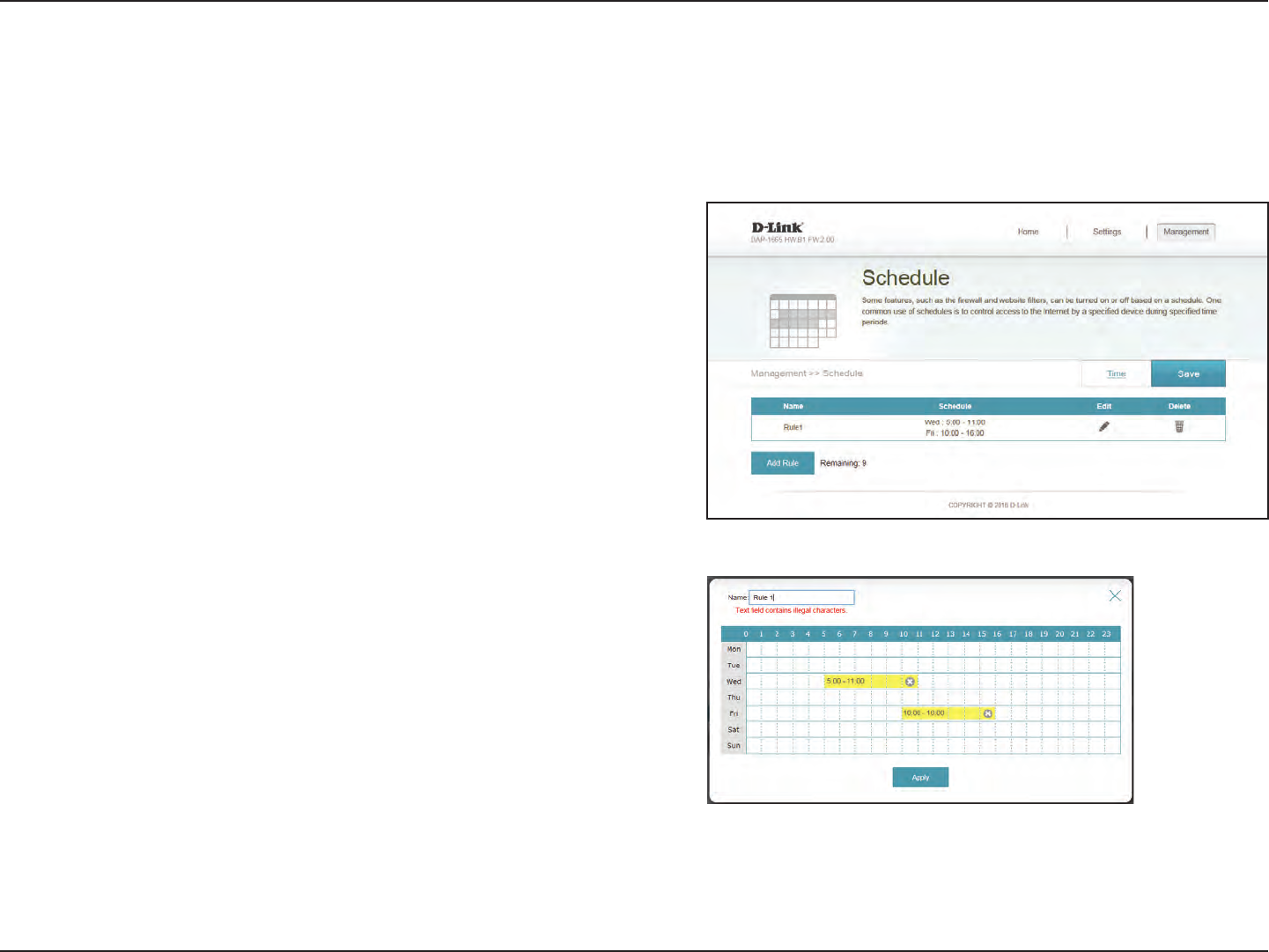
70D-Link DAP-1665 User Manual
Section 3 - Conguration
Schedule
Click Add Rule to add a schedule for times that can be used to control the
device’s specic features.
On this page, you can Edit and Delete the rule. Click Save to apply the rules.
You can draw the times slots in the pop-up window and type in a custom rule
name. Click Apply to add the rule.
Use the Schedule page to create new schedule rules for various device functions. Schedules created here will be available for
selection from schedule selection drop-down menus throughout the conguration utility.
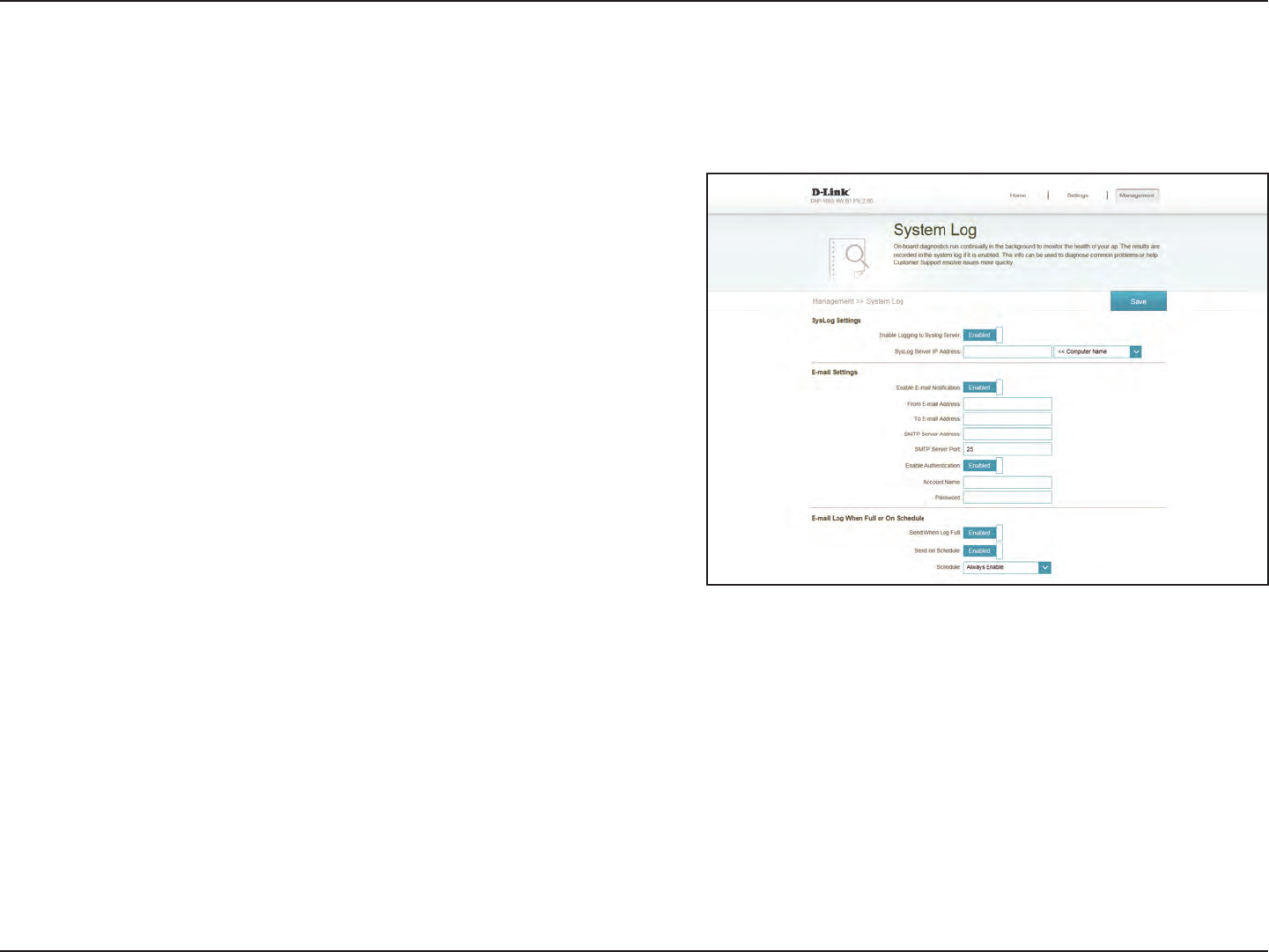
71D-Link DAP-1665 User Manual
Section 3 - Conguration
SysLog Settings:
E-mail Settings:
E-mail Log
When Full or On
Schedule:
Enable Logging to Syslog Server if you have one on your
network. You can then manually enter the IP address of the
server or select from the drop-down list on the right.
Enable E-mail Notification and enter your desired From/
To E-mail Addresses, SMTP information, and authentication
information for your account.
You can enable automatic sending of logs when they are full
or schedule logs to be sent via a preset schedule.
The DAP-1665 keeps a running log of events and activities occurring on the access point. If the device is rebooted, the logs
will automatically be cleared. Click Save to apply your changes.
Log
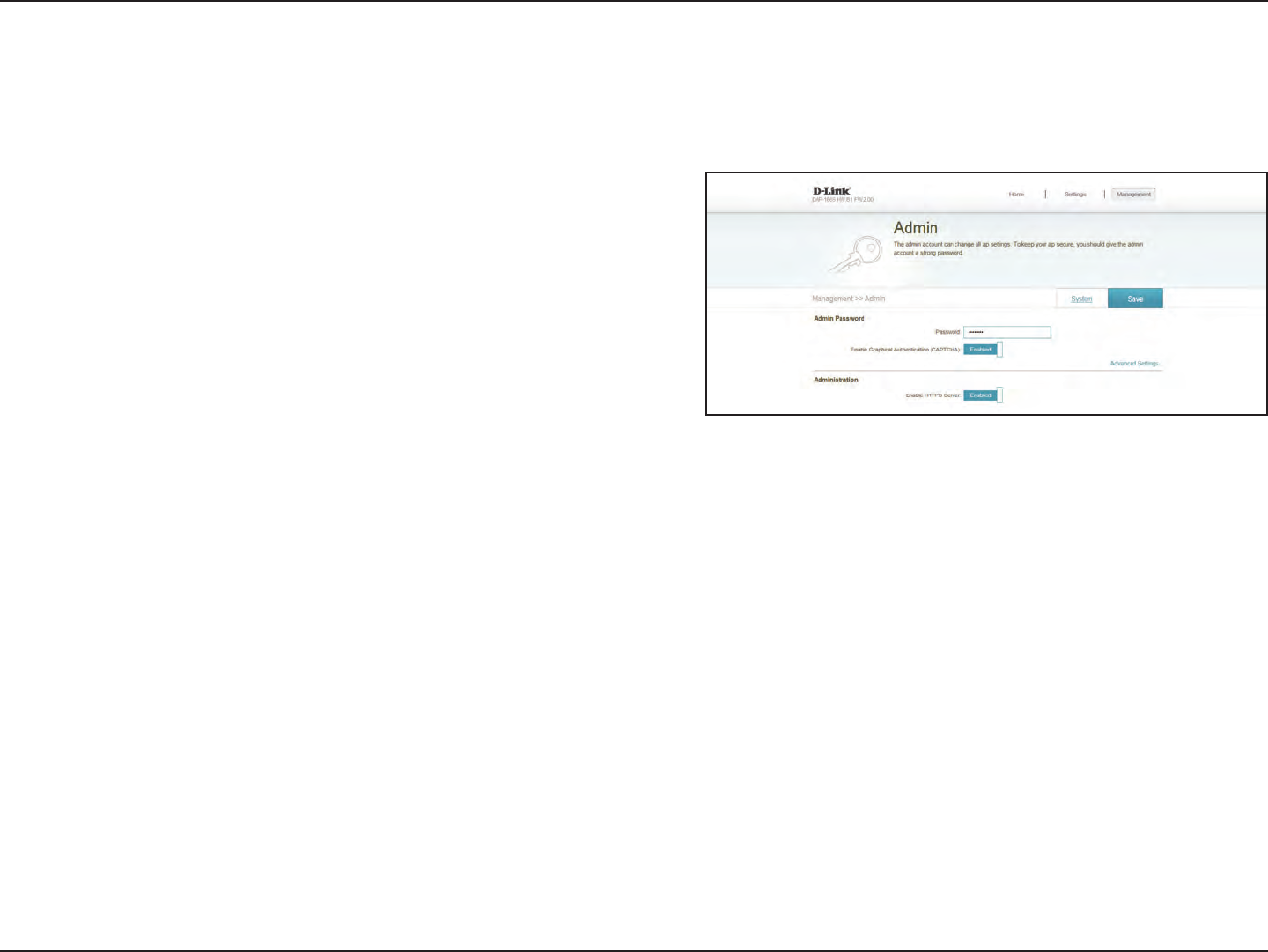
72D-Link DAP-1665 User Manual
Section 3 - Conguration
Admin
Enter a custom password for your admin account in this box. You
can also enable a graphical authentication for better security
against bots here.
Enable HTTPS Server to encrypt the connection to your device’s
management page.
Admin Password:
Administration:
You can change the admin password and congure system settings from the Admin page. Click Save to apply settings.
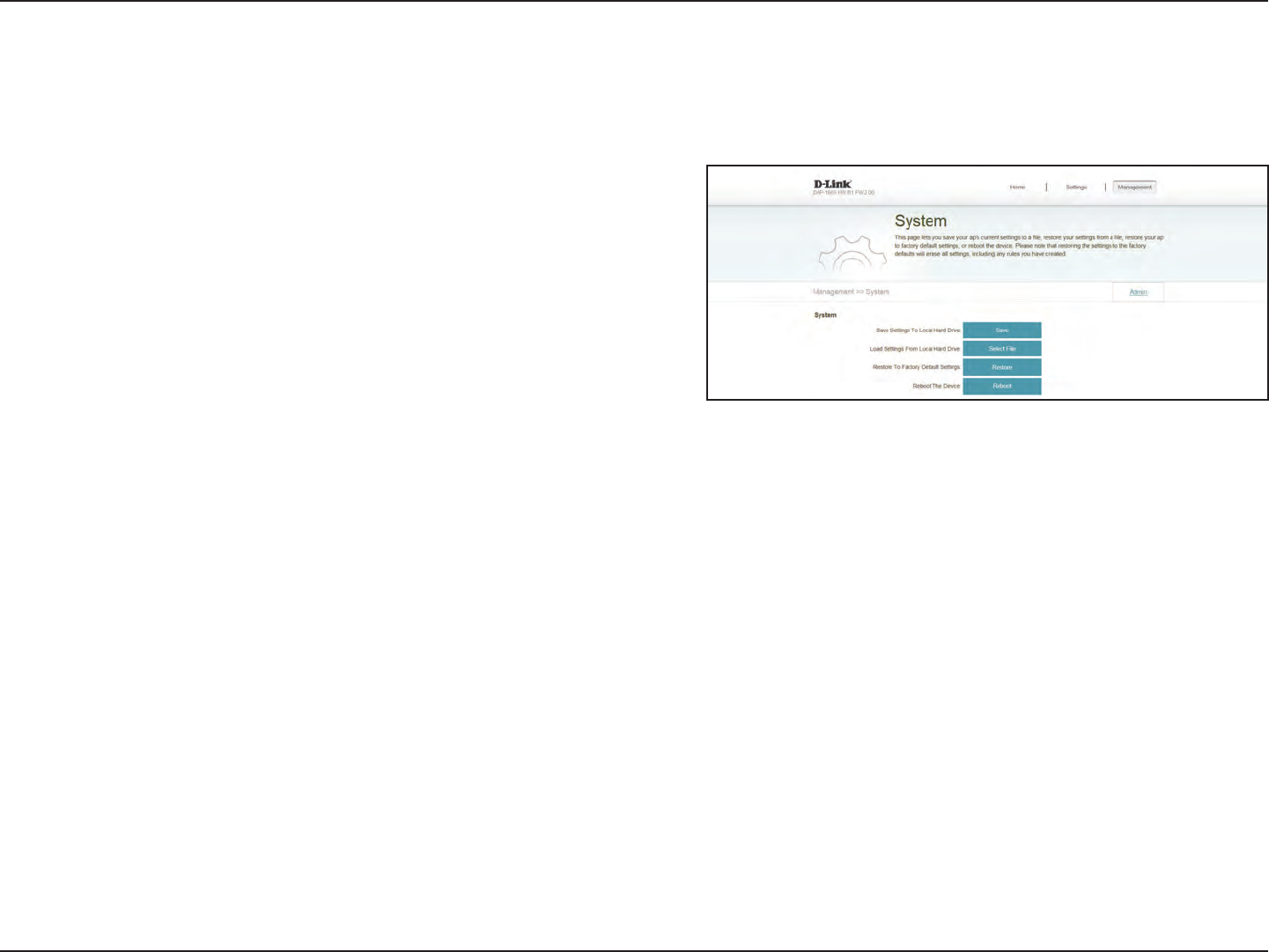
73D-Link DAP-1665 User Manual
Section 3 - Conguration
System
Click Save to save the access point’s current conguration to
a le on your local computer. After clicking, a Save File dialog
will appear, prompting you to save the conguration le on
your computer.
Click Browse to locate a previously saved conguration le
on your local computer. Once the le has been located, click
Upload Settings to apply the conguration in the le to the
access point.
Note: This will overwrite any current conguration.
Click Restore Device to reset the DAP-1665’s settings to the
factory defaults.
Warning: This will erase all current settings and cannot be
undone.
Click Reboot to reboot the device. You will need to log in to the
device again once the reboot has been completed.
Save Settings to
Local Hard Drive:
Load Settings
From Local Hard
Drive:
Restore to
Factory Default
Settings:
Reboot the
Device:
You can save your DAP-1665’s settings to a le as a backup from this page.
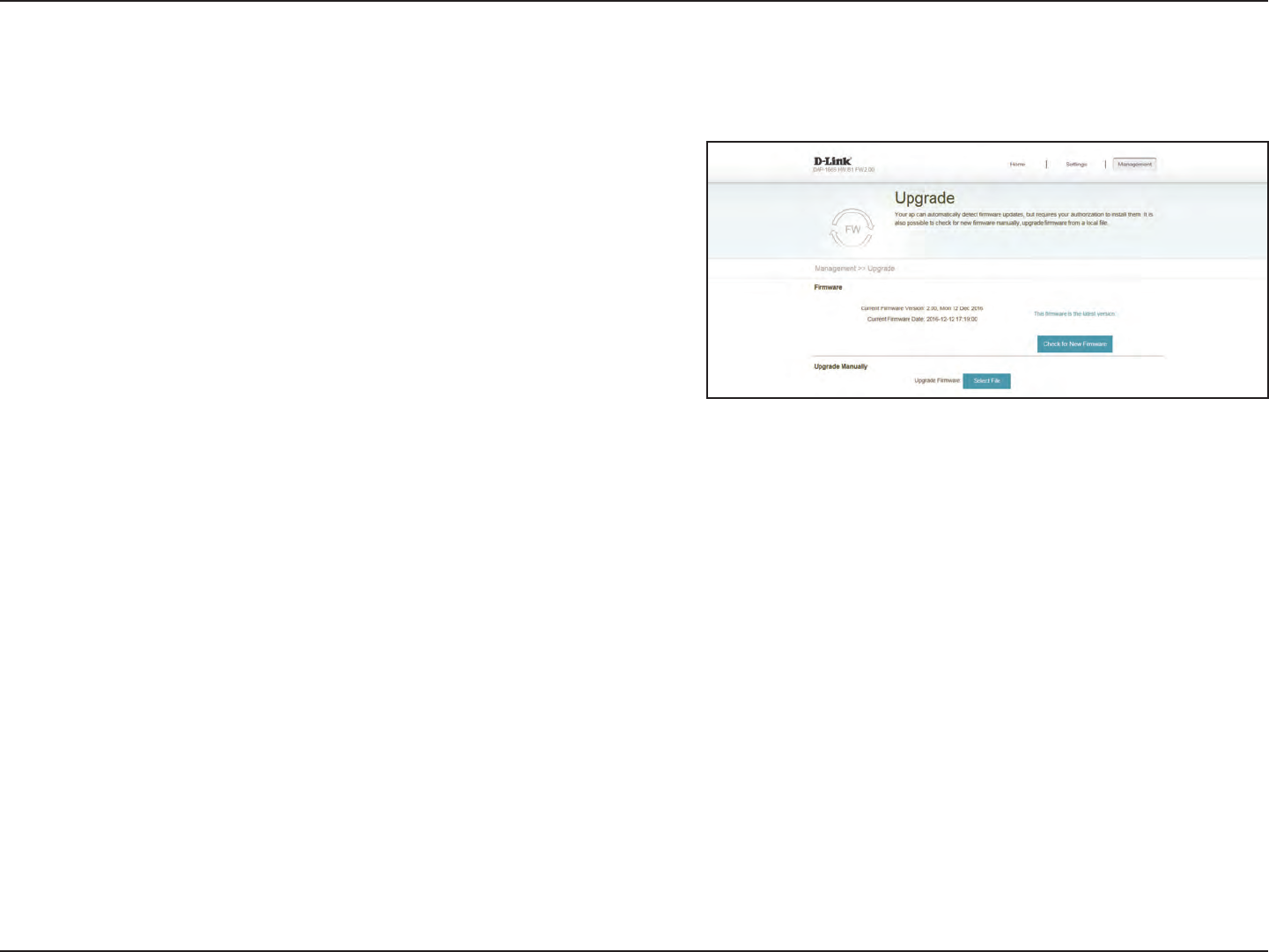
74D-Link DAP-1665 User Manual
Section 3 - Conguration
Upgrade
This section displays information about the device’s current
rmware and language pack. Click Check for New Firmware
to check for new rmware or language pack versions.
Note: The access point must have an active Internet connected
to check for rmware updates.
If the above check for rmware and language packs detected
updates, the details will displayed here. Click Download to
download the update les to your computer.
Click Select File to locate a rmware le on your computer.
Once located, click Upload to commence the rmware upgrade
process. It is recommended that you save your current router
configuration using the System page before you begin a
rmware upgrade.
Warning: You must use a wired connection to the access point
to update the rmware.
Firmware
Check the Latest
Firmware and
Language Pack
Versions:
Upgrade
Manually:
Use the Upgrade page to update the device’s rmware.
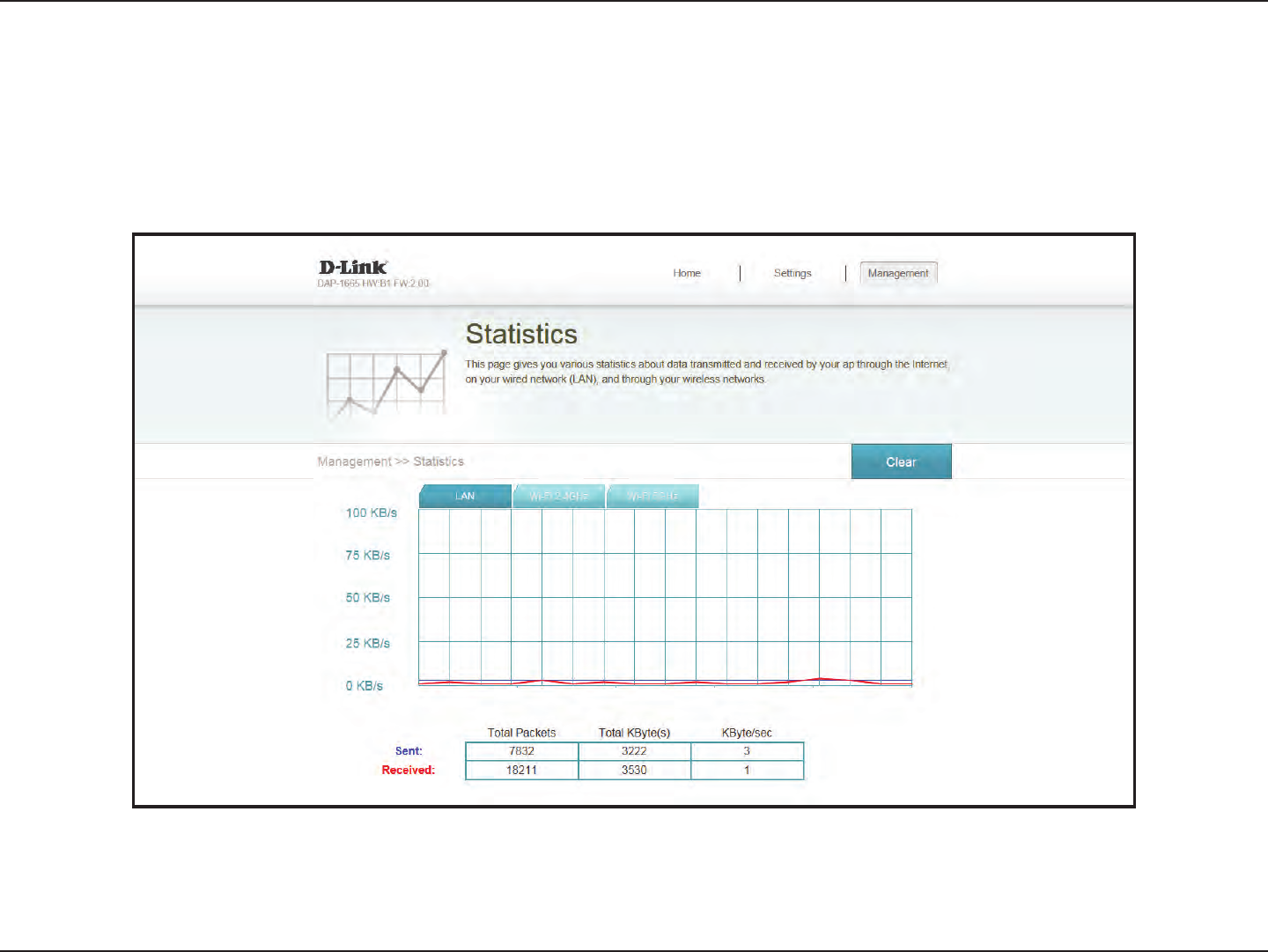
75D-Link DAP-1665 User Manual
Section 3 - Conguration
Statistics
The DAP-1665 keeps statistics of the trac that passes through it. You can view the amount of packets that pass through the LAN
and wireless portions of the network. The trac counter will reset if the access point is rebooted. Use the tabs at the top of the graph
or click Clear to clear the statistics.

76D-Link DAP-1665 User Manual
Section 4 - Security
Connecting to a Wireless Network
WPS Button
Once an uplink network has been established, you may use the DAP-1665’s WPS function to add additional wireless clients to
your extended network. Many wireless devices such as wireless routers, media players, printers, and cameras will have a WPS
button (or a software utility with WPS) that you can press to connect to the DAP-1665. Please refer to the user manual for the
wireless device you want to connect to make sure you understand how to enable WPS. Once you know, follow the steps below:
Step 1 - Press the WPS button on the DAP-1665 for about 1 second. The Status/WPS LED on the DAP-1330 will start blinking
green. You can also use the WPS option in the setup wizard section of the web interface.
Step 2 - Within 120 seconds, press the WPS button on your wireless device.
Step 3 - Allow up to 1 minute to congure. Once the LED light stops blinking and turns solid green, you will be connected and
your wireless connection will be secured with WPA2.
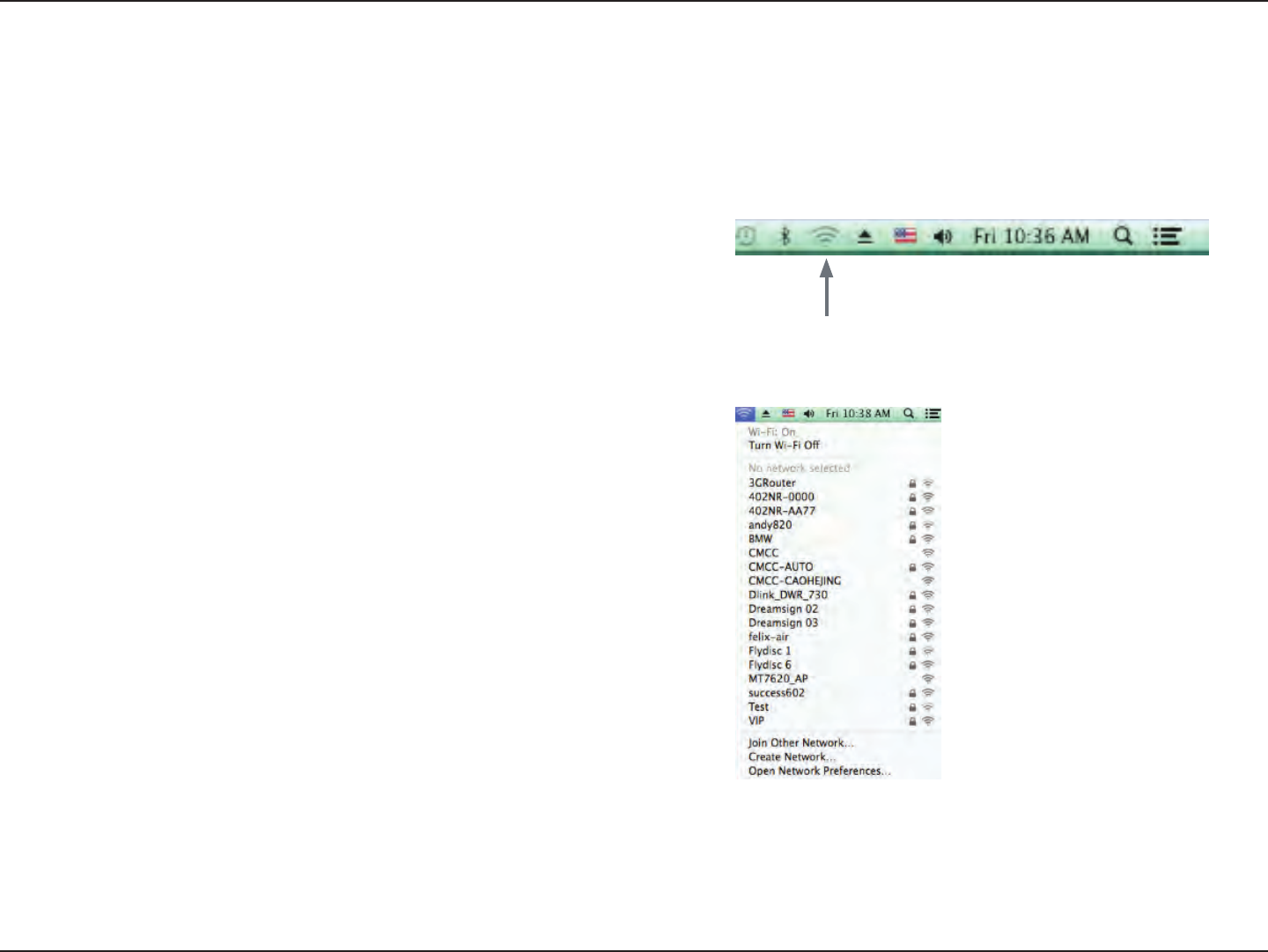
77D-Link DAP-1665 User Manual
Section 4 - Security
It is recommended to enable wireless security (WPA/WPA2) on your wireless router or access point before conguring your
wireless adapter. If you are joining an existing network, you will need to know the security key (Wi-Fi password) being used.
To quickly access your Wi-Fi information and settings, click the Wi-Fi
icon on the menu bar.
Mac OS
Clicking on this icon will display a list of all wireless networks within
range of your computer. Select the desired network by clicking on
the network name.
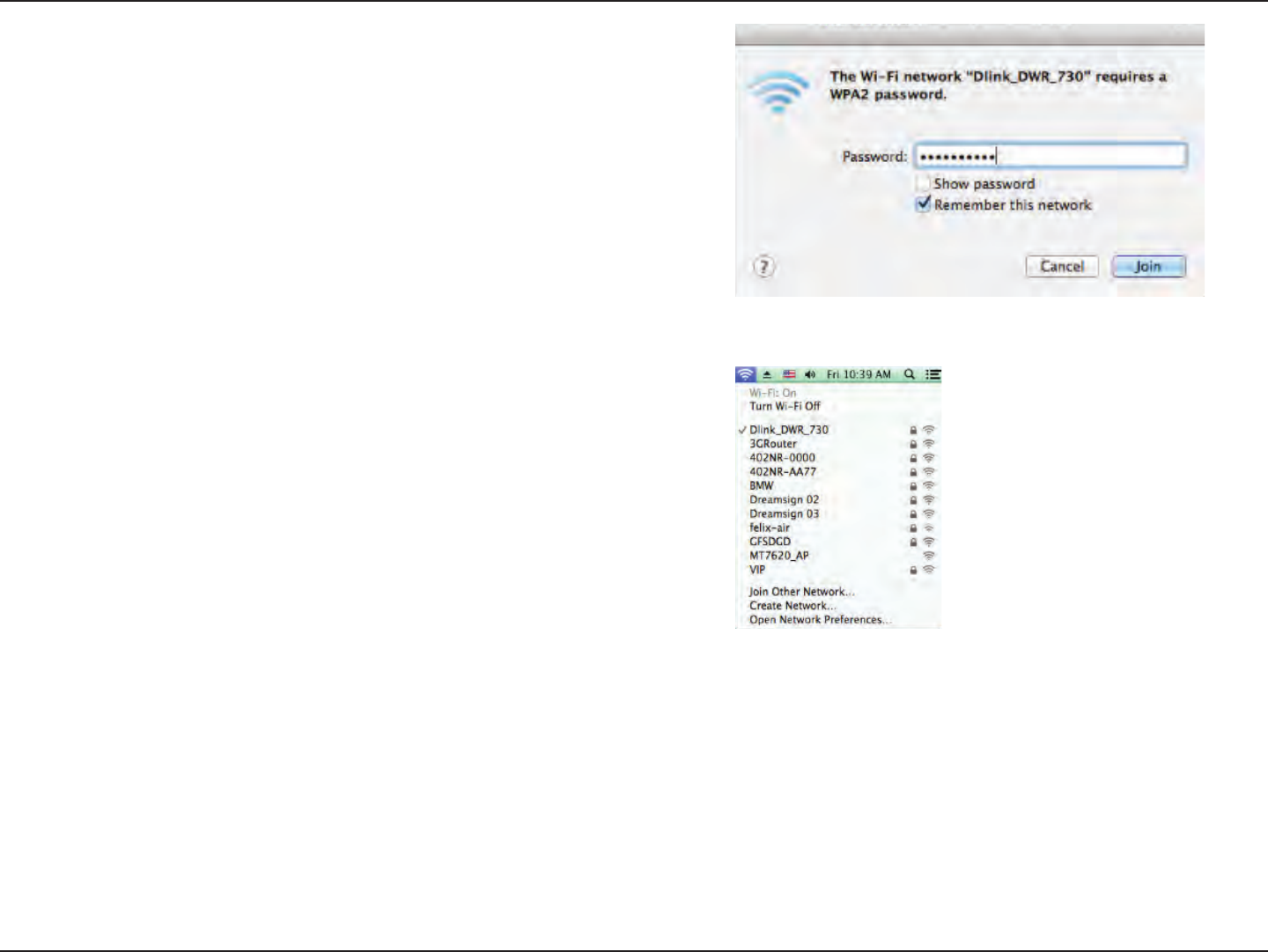
78D-Link DAP-1665 User Manual
Section 4 - Security
You will then be prompted to enter the network security key (Wi-Fi
password) for the wireless network. Enter the password into the box
and click Join.
Note: To avoid having to enter your network security key each time
you connect, check Remember this network.
Once the connection is successfully established, you will see a check
by the name of your wireless network.
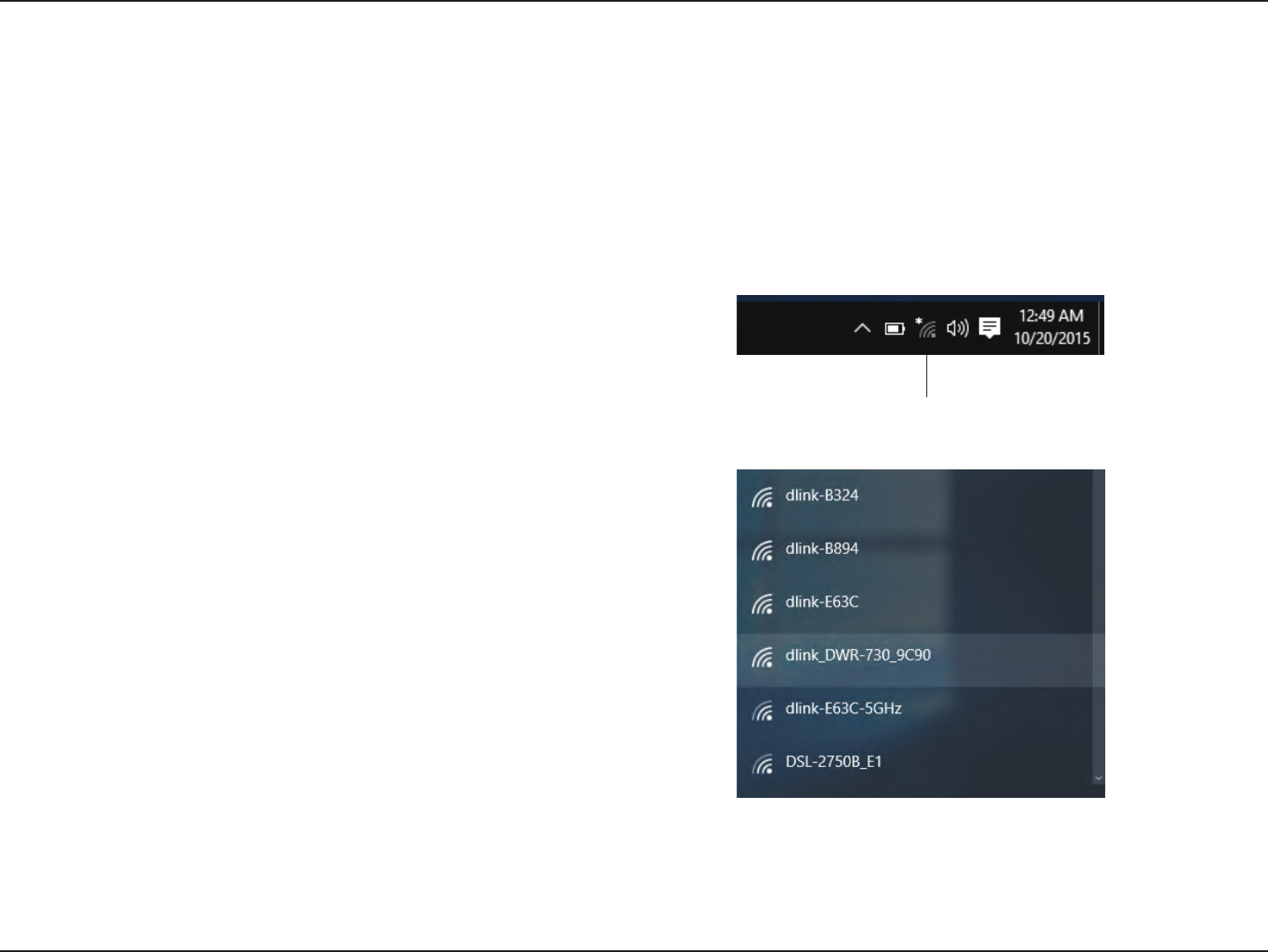
79D-Link DAP-1665 User Manual
Section 4 - Security
Windows® 10
When connecting to the DAP-1665 wirelessly for the rst time, you will need to input the wireless network name (SSID) and
Wi-Fi password (security key) of the device you are connecting to. If your product has a Wi-Fi Conguration Card, you can nd
the default network name and Wi-Fi password here. Otherwise refer to the product label for the default Wi-Fi network SSID
and password, or enter the Wi-Fi credentials set during the product conguration.
To join an existing network, locate the wireless network icon in the
taskbar, next to the time display and click on it.
Clicking on this icon will display a list of wireless networks which are
within range of your computer. Select the desired network by clicking
on the SSID.
Wireless Icon
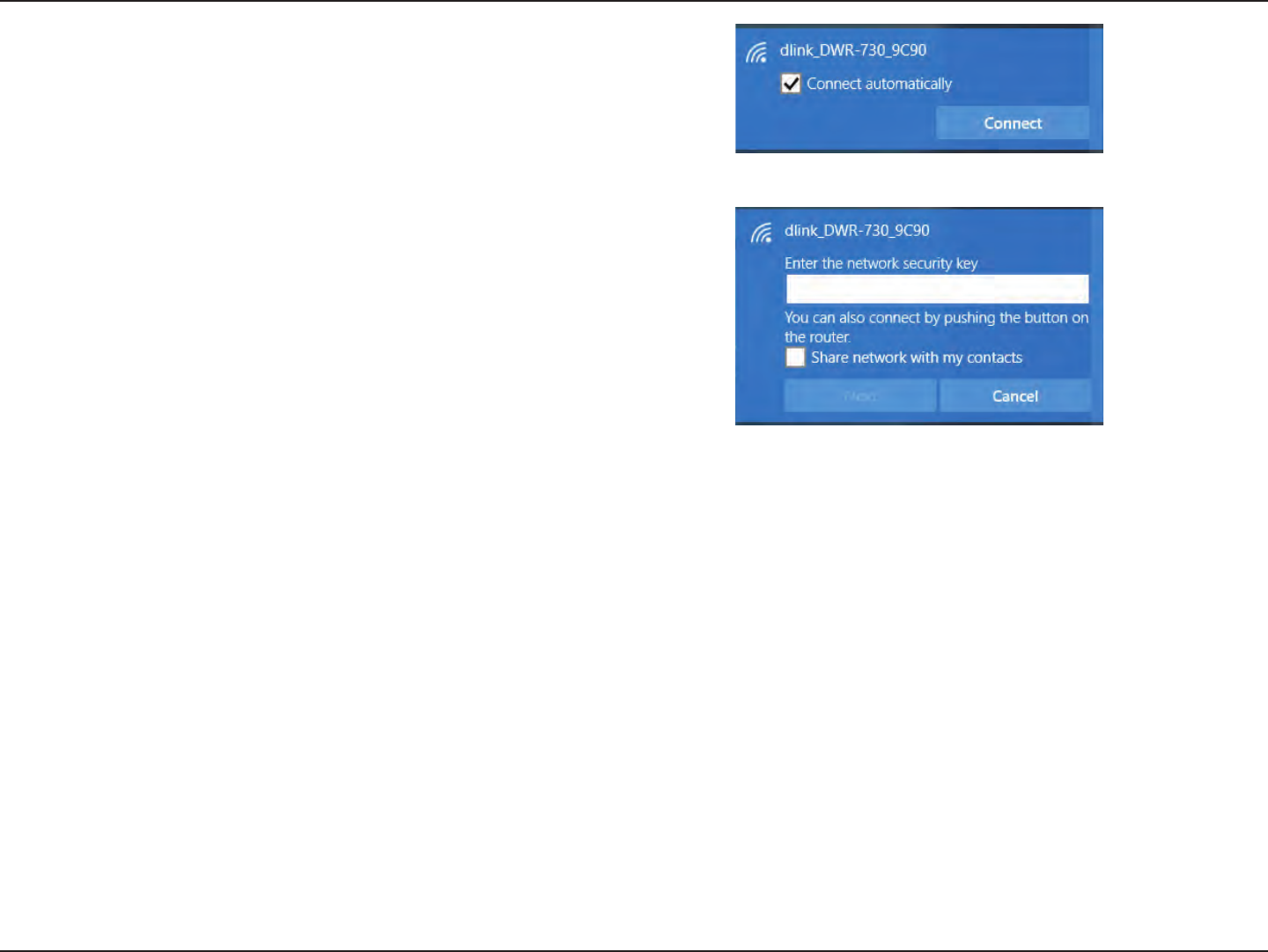
80D-Link DAP-1665 User Manual
Section 4 - Security
To connect to the SSID, click Connect.
To automatically connect with the router when your device next
detects the SSID, click the Connect Automatically check box.
You will then be prompted to enter the Wi-Fi password (network
security key) for the wireless network. Enter the password into the
box and click Next to connect to the network. Your computer will now
automatically connect to this wireless network when it is detected.
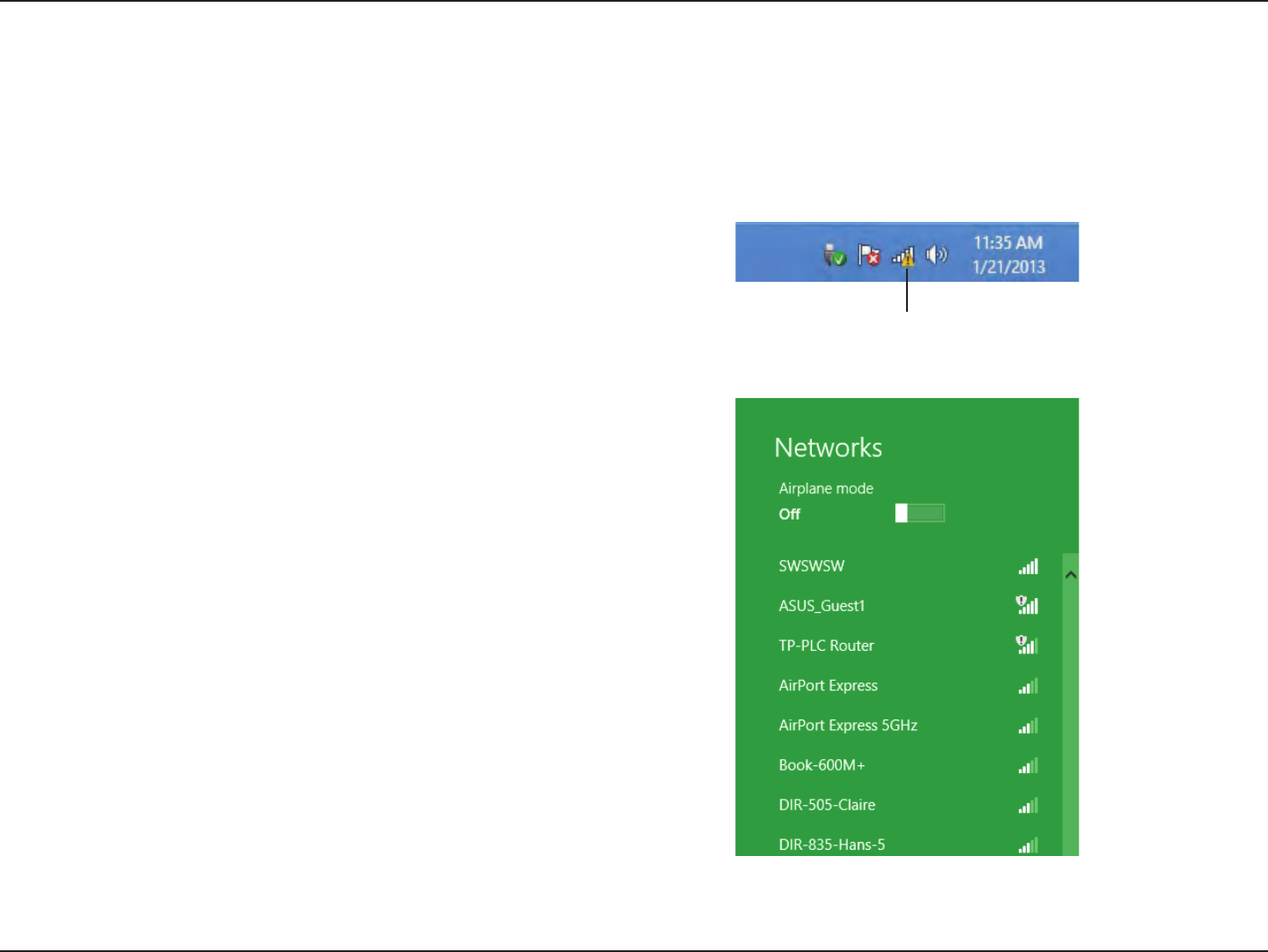
81D-Link DAP-1665 User Manual
Section 5 - Connecting to a Wireless Network
Windows® 8
It is recommended to enable wireless security (WPA/WPA2) on your wireless router or access point before conguring your
wireless adapter. If you are joining an existing network, you will need to know the security key (Wi-Fi password) being used.
To join an existing network, locate the wireless network icon in the
taskbar, next to the time display.
Wireless Icon
Clicking on this icon will display a list of wireless networks which are
within connecting proximity of your computer. Select the desired
network by clicking on the network name.
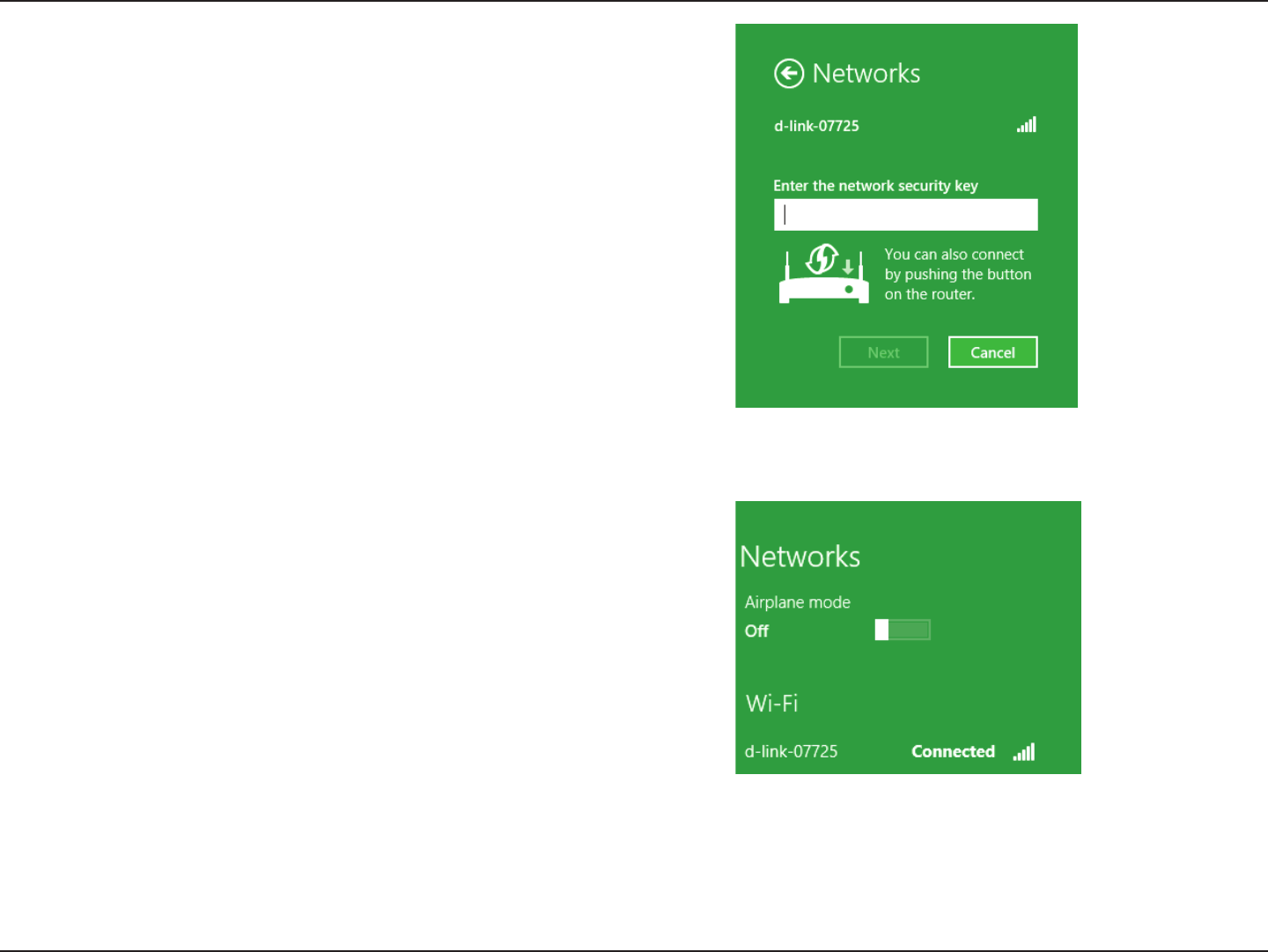
82D-Link DAP-1665 User Manual
Section 5 - Connecting to a Wireless Network
You will then be prompted to enter the network security key (Wi-Fi
password) for the wireless network. Enter the password into the box
and click Next.
If you wish to use Wi-Fi Protected Setup (WPS) to connect to the
router, you can also press the WPS button on your router at this point
to enable the WPS function.
When you have established a successful connection to a wireless
network, the word Connected will appear next to the name of the
network to which you are connected.
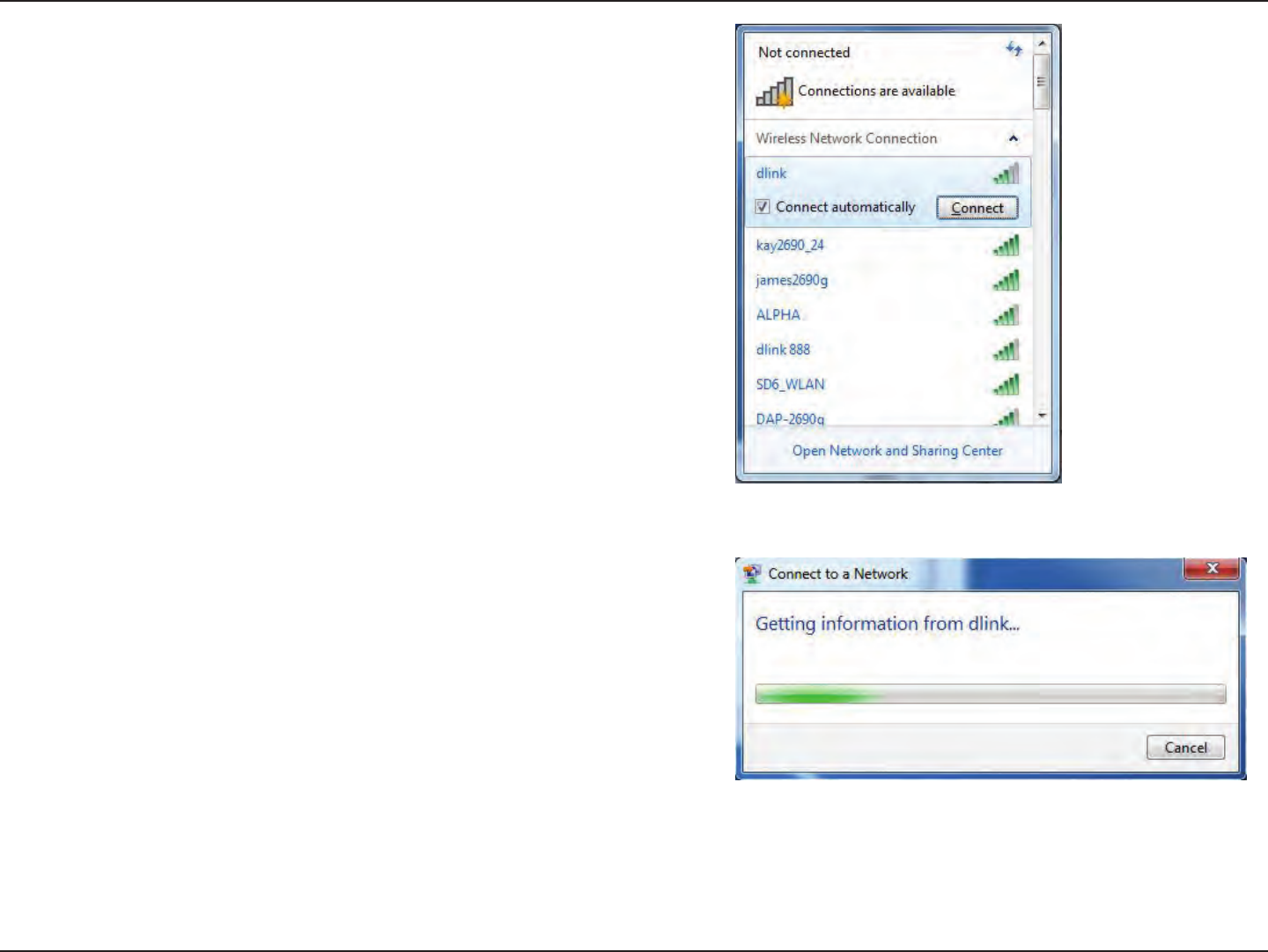
83D-Link DAP-1665 User Manual
Section 5 - Connecting to a Wireless Network
Highlight the wireless network (SSID) you would like to connect to
and click the Connect button. The Wi-Fi Conguration Card will list
your device’s specic network, it will not be simply dlink.
If you get a good signal but cannot access the Internet, check your
TCP/IP settings for your wireless adapter. Refer to the Networking
Basics section in this manual for more information.
The following window appears while your computer tries to connect
to the router.
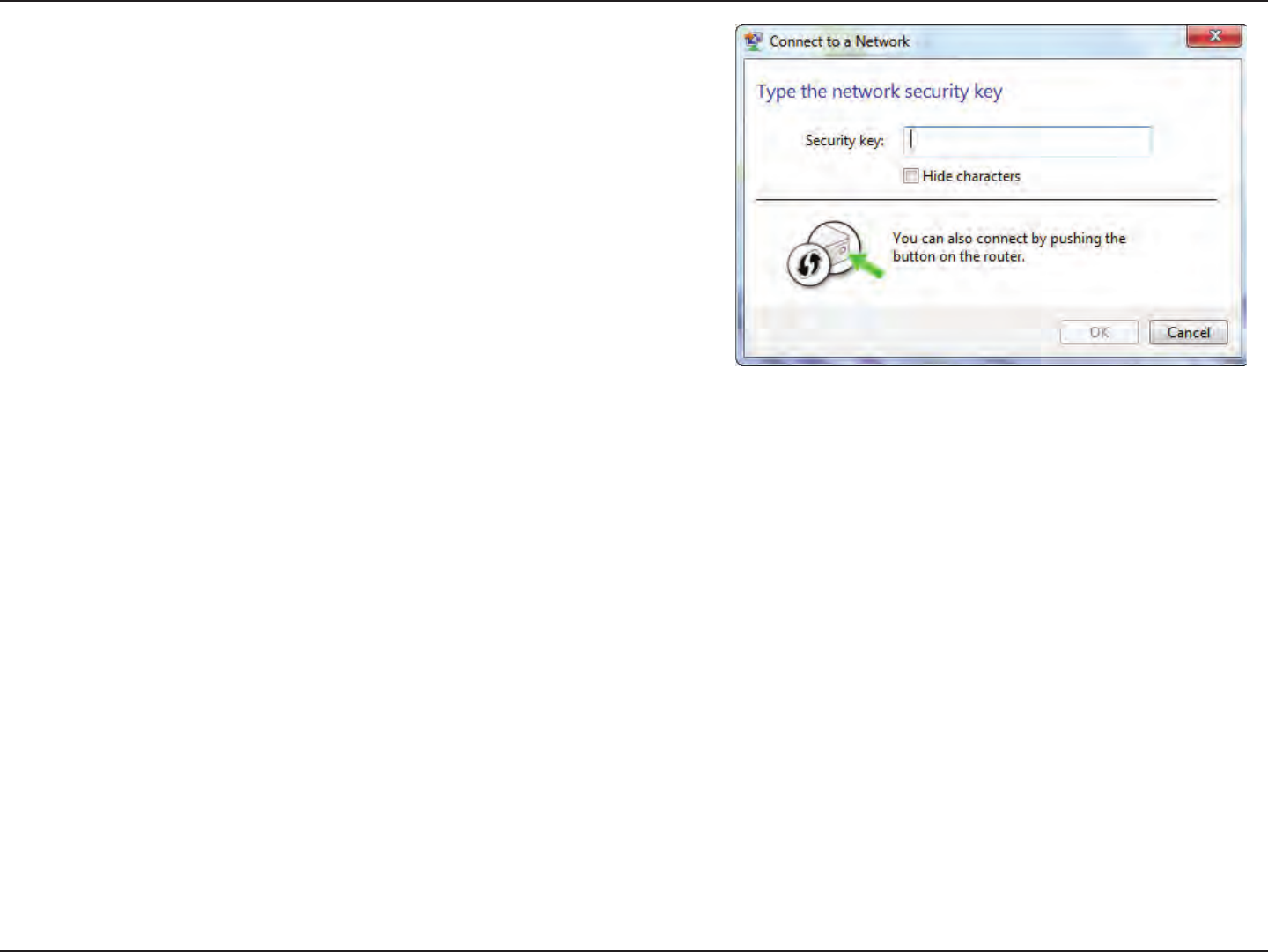
84D-Link DAP-1665 User Manual
Section 5 - Connecting to a Wireless Network
Enter the same security key or passphrase that is on your DAP-1665
and click Connect.
It may take 20-30 seconds to connect to the wireless network. If the
connection fails, please verify that the security settings are correct. The
key or passphrase must be exactly the same as on the wireless router.
Additionally, you may connect using Wi-Fi Protected Setup (WPS)
and Push Button Conguration (PBC). When the window to the right
is displayed, press the Simple Connect Button on the DAP-1665.
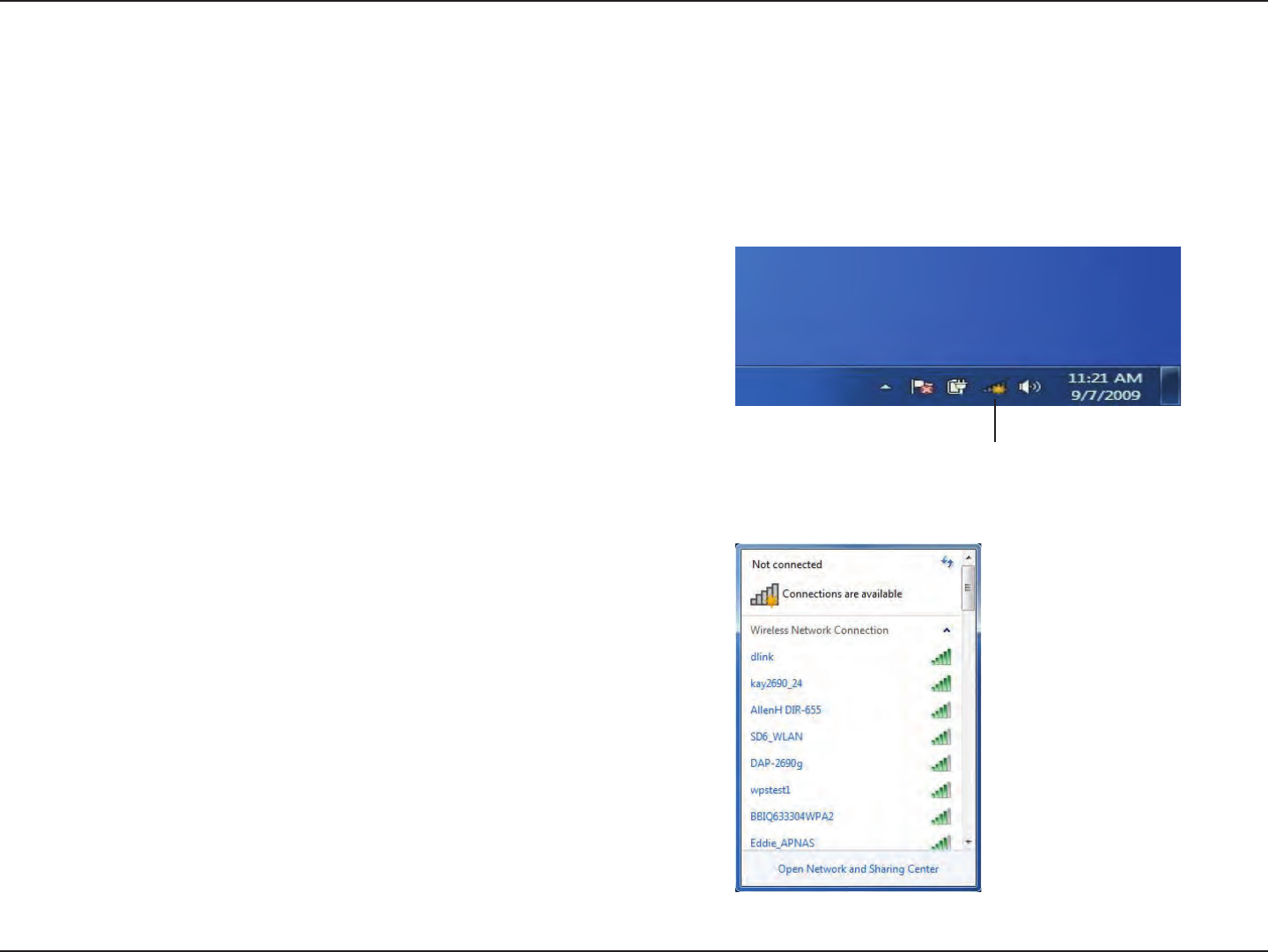
85D-Link DAP-1665 User Manual
Section 5 - Connecting to a Wireless Network
Windows® 7
It is recommended to enable wireless security (WPA/WPA2) on your DAP-1665 before conguring your wireless adapter. If you
are joining an existing network, you will need to know the security key or passphrase being used.
Click on the wireless icon in your system tray (lower-right corner).
The utility will display any available wireless networks in your area.
Wireless Icon
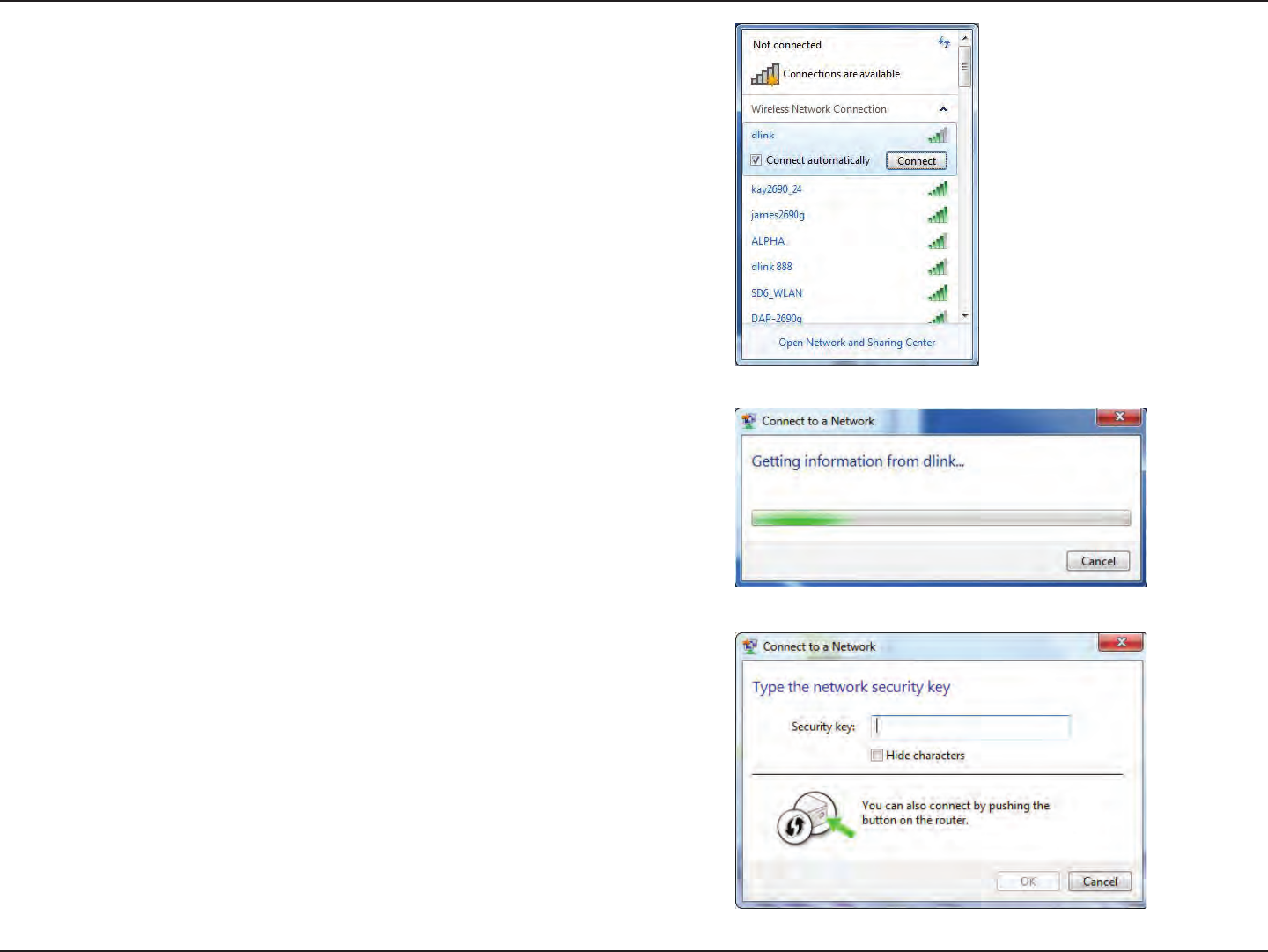
86D-Link DAP-1665 User Manual
Section 5 - Connecting to a Wireless Network
Highlight the wireless network (SSID) you would like to connect to
and click the Connect button. The Wi-Fi Conguration Card will list
your device’s specic network.
If you get a good signal but cannot access the Internet, check your
TCP/IP settings for your wireless adapter. Refer to Networking Basics
on page <?> for more information.
The following window appears while your computer tries to connect
to the router.
Enter the same security key or passphrase that is on your DAP-1665
and click Connect.
It may take 20-30 seconds to connect to the wireless network. If the
connection fails, please verify that the security settings are correct. The
key or passphrase must be exactly the same as on the wireless router.
Additionally, you may connect using Wi-Fi Protected Setup (WPS)
and Push Button Conguration (PBC). When the window to the right
is displayed, press the Simple Connect Button on the DAP-1665.
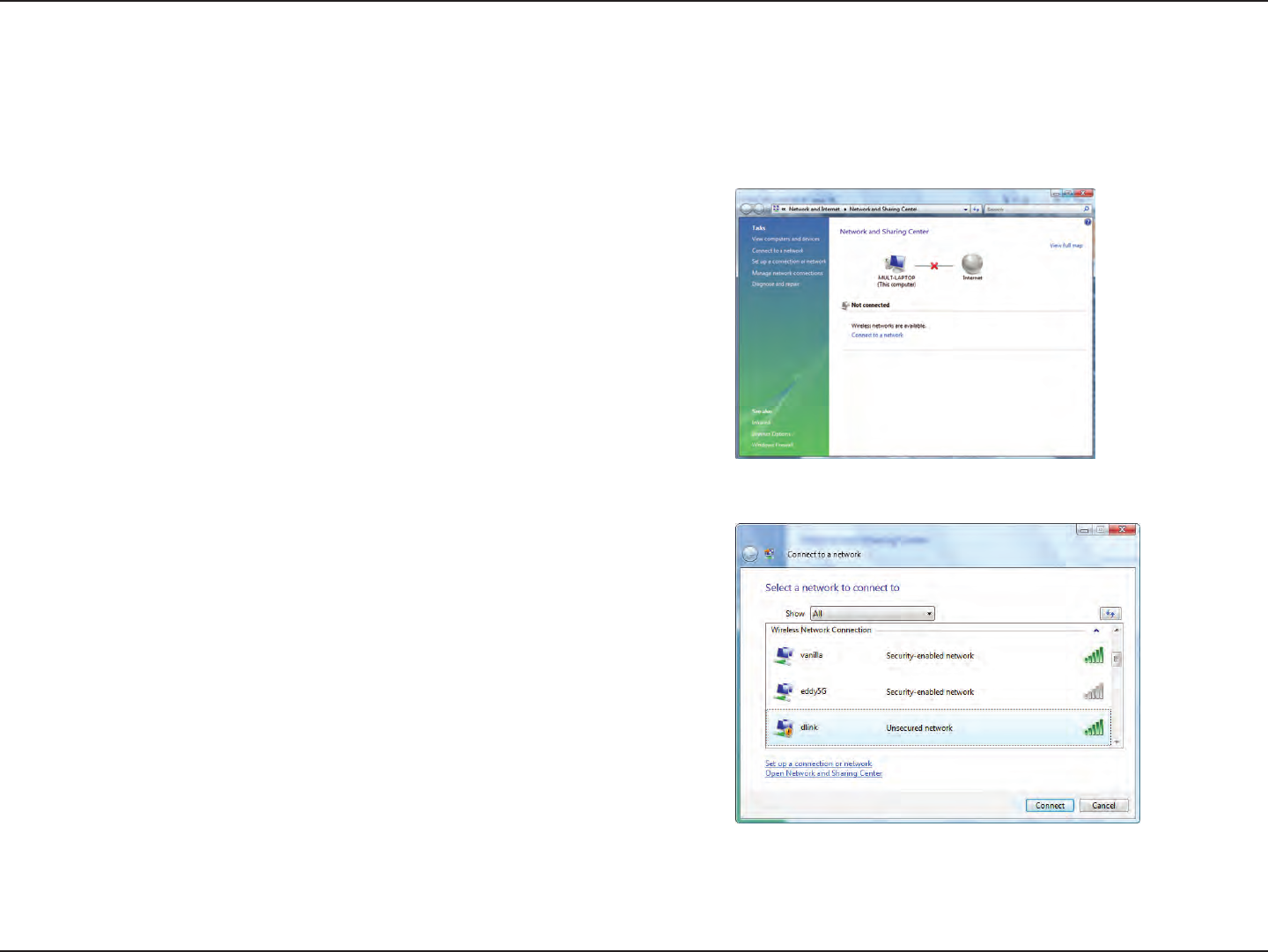
87D-Link DAP-1665 User Manual
Section 5 - Connecting to a Wireless Network
Windows Vista®
Windows Vista® users may use the convenient, built-in wireless utility. Follow these instructions:
From the Start menu, go to Control Panel, and then click on Network
and Sharing Center.
The utility will display any available wireless networks in your area.
Click on a network (displayed using the SSID) and click the Connect
button. The Wi-Fi Conguration Card will list your device’s specic
network.
If you get a good signal but cannot access the Internet, check your
TCP/IP settings for your wireless adapter. Refer to the Networking
Basics section in this manual for more information.
Click Connect to continue.
Select Connect to a network.
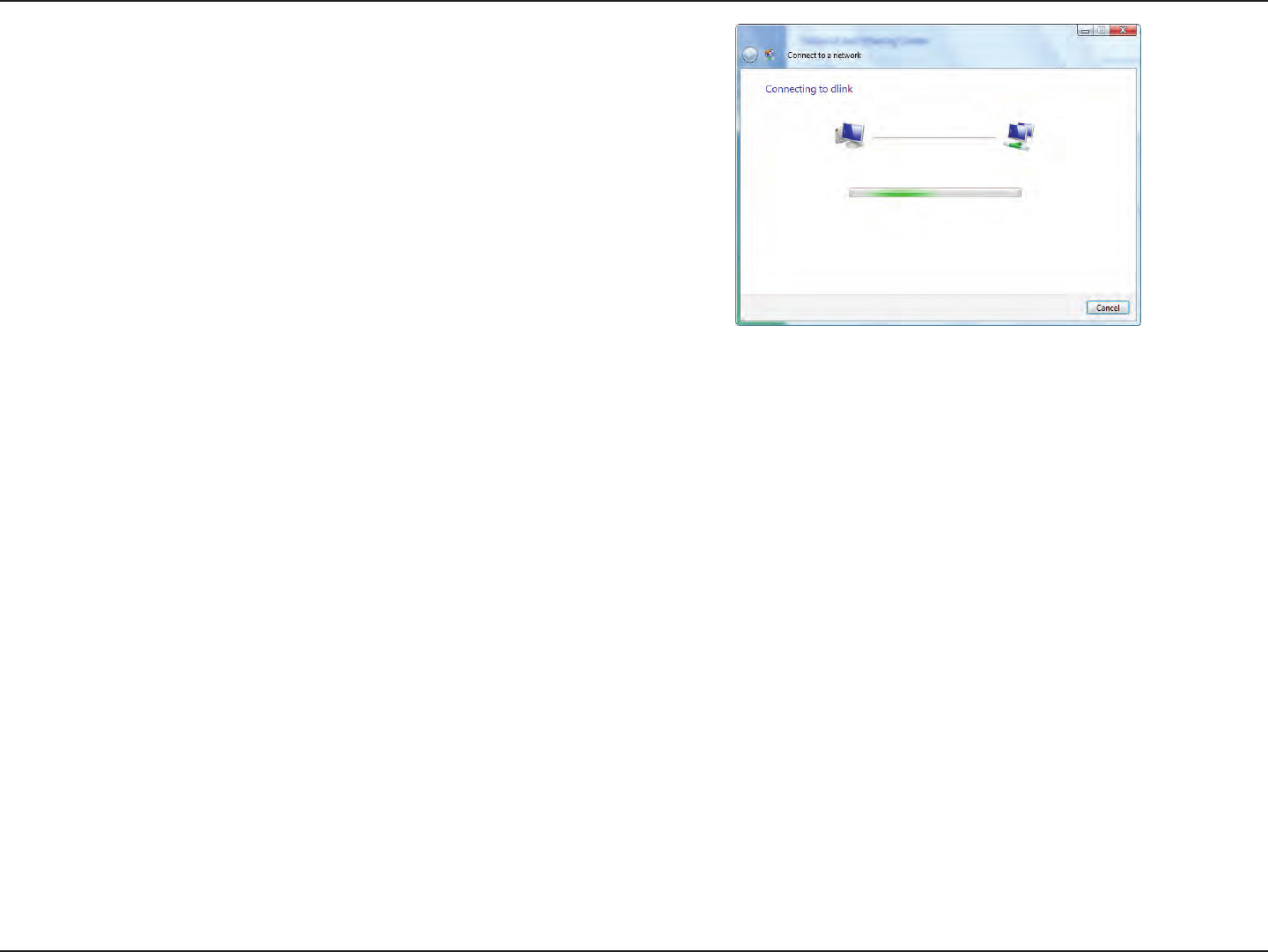
88D-Link DAP-1665 User Manual
Section 5 - Connecting to a Wireless Network
The utility will display the following window to indicate a connection
is being made.
The final window indicates a successful connection has been
established.
The next two pages display the windows used to connect to a WPA-
PSK wireless network.

89D-Link DAP-1665 User Manual
Section 6 - Troubleshooting
Troubleshooting
This chapter provides solutions to problems that can occur during the installation and operation of the DAP-1665. Read the
following descriptions if you are having problems.
1. Why can’t I access the web-based conguration utility?
When entering the name or IP address of the D-Link access point (192.168.0.50 for example), you are not connecting to a
website on the Internet or have to be connected to the Internet. The device has the utility built-in to a ROM chip in the device
itself. Your computer must be on the same IP subnet to connect to the web-based utility.
• Make sure you have an updated Java-enabled web browser. We recommend the following:
• Microsoft Internet Explorer® 7.0 or higher
• Mozilla Firefox® 12.0 or higher
• Google Chrome™ 20.0 or higher
• Apple Safari® 4.0 or higher
• Verify physical connectivity by checking for solid link lights on the device. If you do not get a solid link light, try using a
dierent cable. If the computer is turned o, the link light may not be on.
• Disable any Internet security software running on the computer. Software rewalls such as ZoneAlarm, BlackICE, Sygate,
Norton Personal Firewall, and Windows® XP rewall may block access to the conguration pages. Check the help les included
with your rewall software for more information on disabling or conguring it.

90D-Link DAP-1665 User Manual
Section 6 - Troubleshooting
• Congure your Internet settings:
• Go to Start > Settings > Control Panel. Double-click the Internet Options Icon. From the Security tab, click
the button to restore the settings to their defaults.
• Click the Connection tab and set the dial-up option to Never Dial a Connection. Click the LAN Settings button.
Make sure nothing is checked. Click OK.
• Go to the Advanced tab and click the button to restore these settings to their defaults. Click OK three times.
• Close your web browser (if open) and open it.
• Access the web management. Open your web browser and enter the IP address of your D-Link access point in the address
bar. This should open the login page for your the web management.
• If you still cannot access the conguration, unplug the power to the access point for 10 seconds and plug back in. Wait about
30 seconds and try accessing the conguration. If you have multiple computers, try connecting using a dierent computer.
2. What can I do if I forgot my password?
If you forgot your password, you must reset your access point. Unfortunately this process will change all your settings back to
the factory defaults.
To reset the access point, locate the reset button (hole) on the rear panel of the unit. With the access point powered on, use a
paperclip to hold the button down for 10 seconds. Release the button and the access point will go through its reboot process.
Wait about 30 seconds to access the access point. The default IP address is 192.168.0.50. When logging in, the username is
Admin and leave the password box empty.
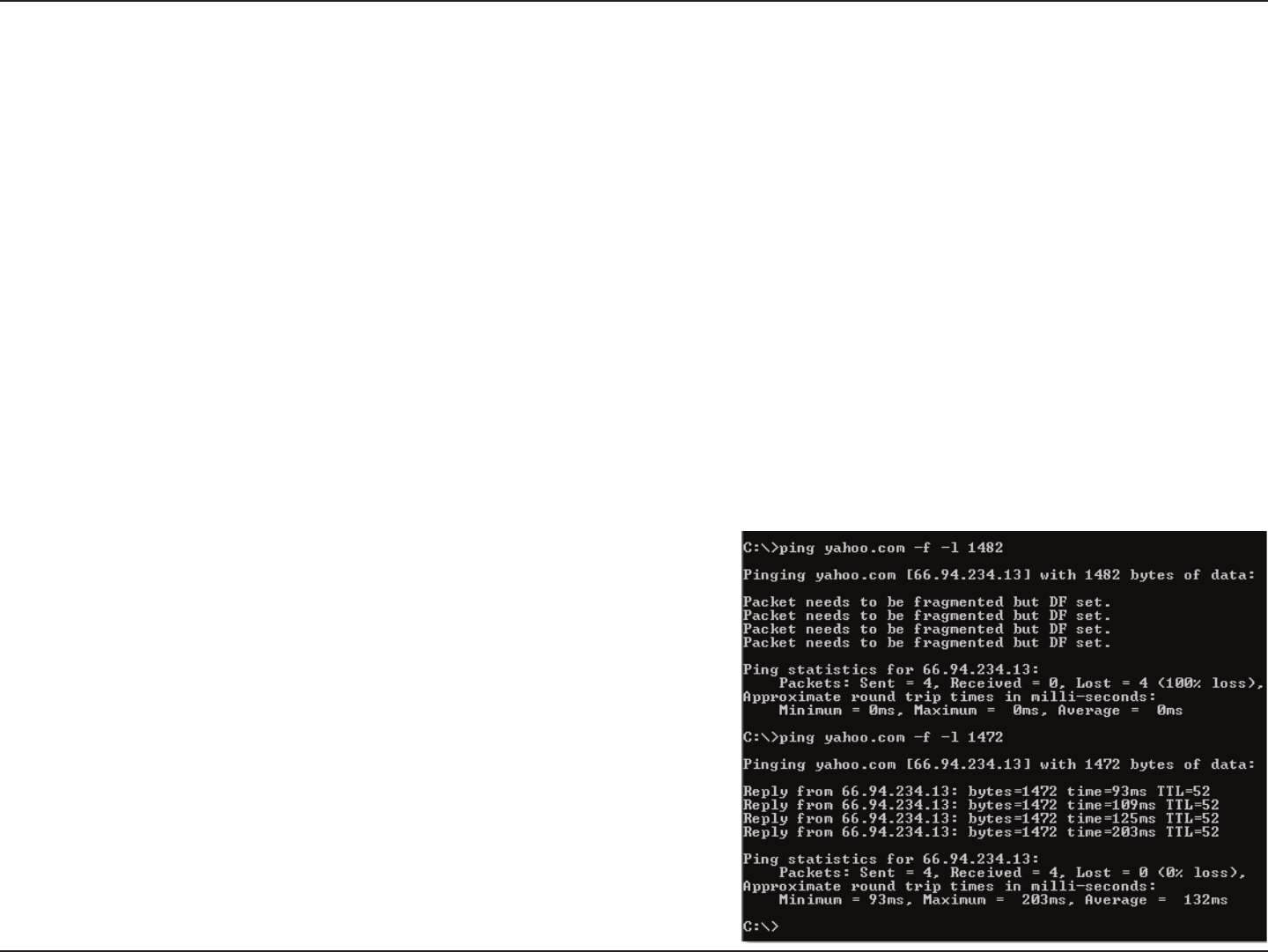
91D-Link DAP-1665 User Manual
Section 6 - Troubleshooting
3. Why can’t I connect to certain sites or send and receive emails when connecting through my access point?
If you are having a problem sending or receiving email, or connecting to secure sites such as eBay, banking sites, and Hotmail,
we suggest lowering the MTU in increments of ten (Ex. 1492, 1482, 1472, etc).
Note: AOL DSL+ users must use MTU of 1400.
To nd the proper MTU Size, you’ll have to do a special ping of the destination you’re trying to go to. A destination could be
another computer, or a URL.
• Click on Start and then click Run.
• Windows® 95, 98, and ME users type in command (Windows® NT, 2000, and XP users type in cmd) and press Enter
(or click OK).
• Once the window opens, you’ll need to do a special ping. Use the following syntax:
ping [url] [-f] [-l] [MTU value]
Example: ping yahoo.com -f -l 1472

92D-Link DAP-1665 User Manual
Section 6 - Troubleshooting
You should start at 1472 and work your way down by 10 each time. Once you get a reply, go up by 2 until you get a fragmented
packet. Take that value and add 28 to the value to account for the various TCP/IP headers. For example, lets say that 1452 was the
proper value, the actual MTU size would be 1480, which is the optimum for the network we’re working with (1452+28=1480).
Once you nd your MTU, you can now congure your access point with the proper MTU size.
To change the MTU rate on your access point follow the steps below:
• Open your browser, enter the IP address of your access point (192.168.0.50) and click OK.
• Enter your username (Admin) and password (blank by default). Click OK to enter the web conguration page
for the device.
• Click on Setup and then click Manual Congure.
• To change the MTU enter the number in the MTU eld and click Save Settings to save your settings.
• Test your email. If changing the MTU does not resolve the problem, continue changing the MTU in increments
of ten.

93D-Link DAP-1665 User Manual
Appendix B - Technical Specications
Technical Specications
Standards
• IEEE 802.11ac
• IEEE 802.11n
• IEEE 802.11gF
Security
• WPA/WPA2
- Personal
- Enterprise
Wireless Signal Rate
• Up to 1200 Mbps
Maximum Operating Voltage
- 12 V 1A
Power Consumption
• 5.7 W
Frequency Range3
• 2.4 GHz Band:
- 2.4 - 2.4835 GHz
• 5 GHz Band:
- 5.15 GHz to 5.25 GHz
- 5.725 GHz to 5.85 GHz
Antennas
• Two 2.4 GHz 5.12 dBi, 5 GHz 5.10 dBi external antenna2
LEDs
• Power
• 2.4 GHz wireless
Temperature
• Operating
- 32°F to 131°F ( 0°C to 55°C)
• Storage
- -20 to 65 °C (-4 to 149 °F)
Humidity
• Operating
- 10 - 90% (non-condensing)
• Storage
- 5 - 95% (non-condensing)
Safety & Emissions
• CE
• FCC
Dimensions
• 47 x 108 x 27.8 mm (5.79 x 4.25 x 1.1 inches)
Weight
• 222 grams (0.489 lbs)
1 Maximum wireless signal rate derived from IEEE Standard draft 802.11ac, 802.11n and 802.11g specications. Actual data throughput will vary. Network
conditions and environmental factors, including volume of network trac, building materials and construction, and network overhead, lower actual data
throughput rate. Environmental conditions will adversely aect wireless signal range.
2 All Maximum transmission power values expressed are for dual-chain mode. Maximum transmission power and included antennas may vary depending
on regional regulations.
3 Range may vary depending on regional regulations.
• IEEE 802.11b
• IEEE 802.3
• IEEE 802.3u
• WEP
• WPS
• ISED
• 5 GHz wireless
• LAN

94D-Link DAP-1665 User Manual
Appendix C - GPL Code Statement
GPL Code Statement
This D-Link product includes software code developed by third parties, including software code subject to the GNU General Public License (“GPL”)
or GNU Lesser General Public License (“LGPL”). As applicable, the terms of the GPL and LGPL, and information on obtaining access to the GPL
code and LGPL code used in this product, are available to you at:
http://tsd.dlink.com.tw/GPL.asp
The GPL code and LGPL code used in this product is distributed WITHOUT ANY WARRANTY and is subject to the copyrights of one or more
authors. For details, see the GPL code and the LGPL code for this product and the terms of the GPL and LGPL.
WRITTEN OFFER FOR GPL AND LGPL SOURCE CODE
Where such specic license terms entitle you to the source code of such software, D-Link will provide upon written request via email and/or
traditional paper mail the applicable GPL and LGPLsource code files via CD-ROM for a nominal cost to cover shipping and media charges as
allowed under the GPL and LGPL.
Please direct all inquiries to:
Email: GPLCODE@DLink.com
Snail Mail:
Attn: GPLSOURCE REQUEST
D-Link Systems, Inc.
17595 Mt. Herrmann Street
Fountain Valley, CA 92708
GNU GENERAL PUBLIC LICENSE
Version 3, 29 June 2007
Copyright (C) 2007 Free Software Foundation, Inc. http://fsf.org/ Everyone is permitted to copy and distribute verbatim copies of this license
document, but changing it is not allowed.

95D-Link DAP-1665 User Manual
Appendix C - GPL Code Statement
Preamble
The GNU General Public License is a free, copyleft license for software and other kinds of works.
The licenses for most software and other practical works are designed to take away your freedom to share and change the works. By contrast, the
GNU General Public License is intended to guarantee your freedom to share and change all versions of a program--to make sure it remains free
software for all its users. We, the Free Software Foundation, use the GNU General Public License for most of our software; it applies also to any other
work released this way by its authors. You can apply it to your programs, too.
When we speak of free software, we are referring to freedom, not price. Our General Public Licenses are designed to make sure that you have the
freedom to distribute copies of free software (and charge for them if you wish), that you receive source code or can get it if you want it, that you
can change the software or use pieces of it in new free programs, and that you know you can do these things.
To protect your rights, we need to prevent others from denying you these rights or asking you to surrender the rights. Therefore, you have certain
responsibilities if you distribute copies of the software, or if you modify it: responsibilities to respect the freedom of others.
For example, if you distribute copies of such a program, whether gratis or for a fee, you must pass on to the recipients the same freedoms that you
received. You must make sure that they, too, receive or can get the source code. And you must show them these terms so they know their rights.
Developers that use the GNU GPL protect your rights with two steps:
(1) assert copyright on the software, and (2) oer you this License giving you legal permission to copy, distribute and/or modify it.
For the developers’ and authors’ protection, the GPL clearly explains that there is no warranty for this free software. For both users’ and authors’
sake, the GPL requires that modied versions be marked as changed, so that their problems will not be attributed erroneously to authors of
previous versions.
Some devices are designed to deny users access to install or run modied versions of the software inside them, although the manufacturer can
do so. This is fundamentally incompatible with the aim of protecting users’ freedom to change the software. The systematic pattern of such abuse
occurs in the area of products for individuals to use, which is precisely where it is most unacceptable. Therefore, we have designed this version of
the GPL to prohibit the practice for those products. If such problems arise substantially in other domains, we stand ready to extend this provision
to those domains in future versions of the GPL, as needed to protect the freedom of users.
Finally, every program is threatened constantly by software patents. States should not allow patents to restrict development and use of software
on general-purpose computers, but in those that do, we wish to avoid the special danger that patents applied to a free program could make it
eectively proprietary. To prevent this, the GPL assures that patents cannot be used to render the program non-free.
The precise terms and conditions for copying, distribution and modication follow.

96D-Link DAP-1665 User Manual
Appendix C - GPL Code Statement
TERMS AND CONDITIONS
0. Denitions.
“This License” refers to version 3 of the GNU General Public License.
“Copyright” also means copyright-like laws that apply to other kinds of works, such as semiconductor masks.
“The Program” refers to any copyrightable work licensed under this License. Each licensee is addressed as “you”. “Licensees” and “recipients” may
be individuals or organizations.
To “modify” a work means to copy from or adapt all or part of the work in a fashion requiring copyright permission, other than the making of an
exact copy. The resulting work is called a “modied version” of the earlier work or a work “based on” the earlier work.
A “covered work” means either the unmodied Program or a work based on the Program.
To “propagate” a work means to do anything with it that, without permission, would make you directly or secondarily liable for infringement under
applicable copyright law, except executing it on a computer or modifying a private copy. Propagation includes copying, distribution (with or
without modication), making available to the public, and in some countries other activities as well.
To “convey” a work means any kind of propagation that enables other parties to make or receive copies. Mere interaction with a user through a
computer network, with no transfer of a copy, is not conveying.
An interactive user interface displays “Appropriate Legal Notices” to the extent that it includes a convenient and prominently visible feature that
(1) displays an appropriate copyright notice, and (2) tells the user that there is no warranty for the work (except to the extent that warranties are
provided), that licensees may convey the work under this License, and how to view a copy of this License. If the interface presents a list of user
commands or options, such as a menu, a prominent item in the list meets this criterion.

97D-Link DAP-1665 User Manual
Appendix C - GPL Code Statement
1. Source Code.
The “source code” for a work means the preferred form of the work for making modications to it. “Object code” means any non-source form of a
work.
A “Standard Interface” means an interface that either is an ocial standard dened by a recognized standards body, or, in the case of interfaces
specied for a particular programming language, one that is widely used among developers working in that language.
The “System Libraries” of an executable work include anything, other than the work as a whole, that (a) is included in the normal form of packaging
a Major Component, but which is not part of that Major Component, and (b) serves only to enable use of the work with that Major Component,
or to implement a Standard Interface for which an implementation is available to the public in source code form. A “Major Component”, in this
context, means a major essential component (kernel, window system, and so on) of the specic operating system (if any) on which the executable
work runs, or a compiler used to produce the work, or an object code interpreter used to run it.
The “Corresponding Source” for a work in object code form means all the source code needed to generate, install, and (for an executable work)
run the object code and to modify the work, including scripts to control those activities. However, it does not include the work’s System Libraries,
or general-purpose tools or generally available free programs which are used unmodied in performing those activities but which are not part of
the work. For example, Corresponding Source includes interface denition les associated with source les for the work, and the source code for
shared libraries and dynamically linked subprograms that the work is specically designed to require, such as by intimate data communication or
control ow between those subprograms and other parts of the work.
The Corresponding Source need not include anything that users can regenerate automatically from other parts of the Corresponding Source.
The Corresponding Source for a work in source code form is that same work.

98D-Link DAP-1665 User Manual
Appendix C - GPL Code Statement
2. Basic Permissions.
All rights granted under this License are granted for the term of copyright on the Program, and are irrevocable provided the stated conditions
are met. This License explicitly arms your unlimited permission to run the unmodied Program. The output from running a covered work is
covered by this License only if the output, given its content, constitutes a covered work. This License acknowledges your rights of fair use or other
equivalent, as provided by copyright law.
You may make, run and propagate covered works that you do not convey, without conditions so long as your license otherwise remains in force.
You may convey covered works to others for the sole purpose of having them make modications exclusively for you, or provide you with facilities
for running those works, provided that you comply with the terms of this License in conveying all material for which you do not control copyright.
Those thus making or running the covered works for you must do so exclusively on your behalf, under your direction and control, on terms that
prohibit them from making any copies of your copyrighted material outside their relationship with you.
Conveying under any other circumstances is permitted solely under the conditions stated below. Sublicensing is not allowed; section 10 makes it
unnecessary.
3. Protecting Users’ Legal Rights From Anti-Circumvention Law.
No covered work shall be deemed part of an eective technological measure under any applicable law fullling obligations under article 11 of the
WIPO copyright treaty adopted on 20 December 1996, or similar laws prohibiting or restricting circumvention of such measures.
When you convey a covered work, you waive any legal power to forbid circumvention of technological measures to the extent such circumvention
is eected by exercising rights under this License with respect to the covered work, and you disclaim any intention to limit operation or modication
of the work as a means of enforcing, against the work’s users, your or third parties’ legal rights to forbid circumvention of technological measures.
4. Conveying Verbatim Copies.
You may convey verbatim copies of the Program’s source code as you receive it, in any medium, provided that you conspicuously and appropriately
publish on each copy an appropriate copyright notice; keep intact all notices stating that this License and any non-permissive terms added in
accord with section 7 apply to the code; keep intact all notices of the absence of any warranty; and give all recipients a copy of this License along
with the Program.
You may charge any price or no price for each copy that you convey, and you may oer support or warranty protection for a fee.

99D-Link DAP-1665 User Manual
Appendix C - GPL Code Statement
5. Conveying Modied Source Versions.
You may convey a work based on the Program, or the modications to produce it from the Program, in the form of source code under the terms of
section 4, provided that you also meet all of these conditions:
a) The work must carry prominent notices stating that you modied it, and giving a relevant date.
b) The work must carry prominent notices stating that it is released under this License and any conditions added under section 7.
This requirement modies the requirement in section 4 to “keep intact all notices”.
c) You must license the entire work, as a whole, under this License to anyone who comes into possession of a copy. This License
will therefore apply, along with any applicable section 7 additional terms, to the whole of the work, and all its parts, regardless
of how they are packaged. This License gives no permission to license the work in any other way, but it does not invalidate such
permission if you have separately received it.
d) If the work has interactive user interfaces, each must display Appropriate Legal Notices; however, if the Program has interactive
interfaces that do not display Appropriate Legal Notices, your work need not make them do so.
A compilation of a covered work with other separate and independent works, which are not by their nature extensions of the covered work, and
which are not combined with it such as to form a larger program, in or on a volume of a storage or distribution medium, is called an “aggregate”
if the compilation and its resulting copyright are not used to limit the access or legal rights of the compilation’s users beyond what the individual
works permit. Inclusion of a covered work in an aggregate does not cause this License to apply to the other parts of the aggregate.

100D-Link DAP-1665 User Manual
Appendix C - GPL Code Statement
6. Conveying Non-Source Forms.
You may convey a covered work in object code form under the terms of sections 4 and 5, provided that you also convey the machine-readable
Corresponding Source under the terms of this License, in one of these ways:
a) Convey the object code in, or embodied in, a physical product (including a physical distribution medium), accompanied by the
Corresponding Source xed on a durable physical medium customarily used for software interchange.
b) Convey the object code in, or embodied in, a physical product (including a physical distribution medium), accompanied by a
written oer, valid for at least three years and valid for as long as you oer spare parts or customer support for that product
model, to give anyone who possesses the object code either (1) a copy of the Corresponding Source for all the software in the
product that is covered by this License, on a durable physical medium customarily used for software interchange, for a price no
more than your reasonable cost of physically performing this conveying of source, or (2) access to copy the Corresponding Source
from a network server at no charge.
c) Convey individual copies of the object code with a copy of the written oer to provide the Corresponding Source. This alternative
is allowed only occasionally and noncommercially, and only if you received the object code with such an oer, in accord with
subsection 6 b.
d) Convey the object code by oering access from a designated place (gratis or for a charge), and oer equivalent access to the
Corresponding Source in the same way through the same place at no further charge. You need not require recipients to copy the
Corresponding Source along with the object code. If the place to copy the object code is a network server, the Corresponding
Source may be on a dierent server (operated by you or a third party) that supports equivalent copying facilities, provided you
maintain clear directions next to the object code saying where to nd the Corresponding Source. Regardless of what server hosts
the Corresponding Source, you remain obligated to ensure that it is available for as long as needed to satisfy these requirements.
e) Convey the object code using peer-to-peer transmission, provided you inform other peers where the object code and
Corresponding Source of the work are being oered to the general public at no charge under subsection 6d.
A separable portion of the object code, whose source code is excluded from the Corresponding Source as a System Library, need not be
included in conveying the object code work.

101D-Link DAP-1665 User Manual
Appendix C - GPL Code Statement
A “User Product” is either (1) a “consumer product”, which means any tangible personal property which is normally used for personal, family, or
household purposes, or (2) anything designed or sold for incorporation into a dwelling. In determining whether a product is a consumer product,
doubtful cases shall be resolved in favor of coverage. For a particular product received by a particular user, “normally used” refers to a typical
or common use of that class of product, regardless of the status of the particular user or of the way in which the particular user actually uses,
or expects or is expected to use, the product. A product is a consumer product regardless of whether the product has substantial commercial,
industrial or non-consumer uses, unless such uses represent the only signicant mode of use of the product.
“Installation Information” for a User Product means any methods, procedures, authorization keys, or other information required to install and
execute modied versions of a covered work in that User Product from a modied version of its Corresponding Source. The information must
suce to ensure that the continued functioning of the modied object code is in no case prevented or interfered with solely because modication
has been made.
If you convey an object code work under this section in, or with, or specically for use in, a User Product, and the conveying occurs as part of a
transaction in which the right of possession and use of the User Product is transferred to the recipient in perpetuity or for a xed term (regardless of
how the transaction is characterized), the Corresponding Source conveyed under this section must be accompanied by the Installation Information.
But this requirement does not apply if neither you nor any third party retains the ability to install modied object code on the User Product (for
example, the work has been installed in ROM).
The requirement to provide Installation Information does not include a requirement to continue to provide support service, warranty, or updates
for a work that has been modied or installed by the recipient, or for the User Product in which it has been modied or installed. Access to a network
may be denied when the modication itself materially and adversely aects the operation of the network or violates the rules and protocols for
communication across the network.
Corresponding Source conveyed, and Installation Information provided, in accord with this section must be in a format that is publicly documented
(and with an implementation available to the public in source code form), and must require no special password or key for unpacking, reading or
copying.
7. Additional Terms.
“Additional permissions” are terms that supplement the terms of this License by making exceptions from one or more of its conditions. Additional
permissions that are applicable to the entire Program shall be treated as though they were included in this License, to the extent that they are valid
under applicable law. If additional permissions apply only to part of the Program, that part may be used separately under those permissions, but
the entire Program remains governed by this License without regard to the additional permissions.

102D-Link DAP-1665 User Manual
Appendix C - GPL Code Statement
When you convey a copy of a covered work, you may at your option remove any additional permissions from that copy, or from any part of it.
(Additional permissions may be written to require their own removal in certain cases when you modify the work). You may place additional
permissions on material, added by you to a covered work, for which you have or can give appropriate copyright permission.
Notwithstanding any other provision of this License, for material you add to a covered work, you may (if authorized by the copyright holders of
that material) supplement the terms of this License with terms:
a) Disclaiming warranty or limiting liability dierently from the terms of sections 15 and 16 of this License; or
b) Requiring preservation of specied reasonable legal notices or author attributions in that material or in the Appropriate Legal
Notices displayed by works containing it; or
c) Prohibiting misrepresentation of the origin of that material, or requiring that modied versions of such material be marked in
reasonable ways as dierent from the original version; or
d) Limiting the use for publicity purposes of names of licensors or authors of the material; or
e) Declining to grant rights under trademark law for use of some trade names, trademarks, or service marks; or
f) Requiring indemnication of licensors and authors of that material by anyone who conveys the material (or modied versions of
it) with contractual assumptions of liability to the recipient, for any liability that these contractual assumptions directly impose
on those licensors and authors.
All other non-permissive additional terms are considered “further restrictions” within the meaning of section 10. If the Program as you received
it, or any part of it, contains a notice stating that it is governed by this License along with a term that is a further restriction, you may remove that
term. If a license document contains a further restriction but permits relicensing or conveying under this License, you may add to a covered work
material governed by the terms of that license document, provided that the further restriction does not survive such relicensing or conveying.
If you add terms to a covered work in accord with this section, you must place, in the relevant source les, a statement of the additional terms that
apply to those les, or a notice indicating where to nd the applicable terms.
Additional terms, permissive or non-permissive, may be stated in the form of a separately written license, or stated as exceptions; the above
requirements apply either way.

103D-Link DAP-1665 User Manual
Appendix C - GPL Code Statement
8. Termination.
You may not propagate or modify a covered work except as expressly provided under this License. Any attempt otherwise to propagate or modify
it is void, and will automatically terminate your rights under this License (including any patent licenses granted under the third paragraph of
section 11).
However, if you cease all violation of this License, then your license from a particular copyright holder is reinstated (a) provisionally, unless and until
the copyright holder explicitly and nally terminates your license, and (b) permanently, if the copyright holder fails to notify you of the violation
by some reasonable means prior to 60 days after the cessation.
Moreover, your license from a particular copyright holder is reinstated permanently if the copyright holder noties you of the violation by some
reasonable means, this is the rst time you have received notice of violation of this License (for any work) from that copyright holder, and you cure
the violation prior to 30 days after your receipt of the notice.
Termination of your rights under this section does not terminate the licenses of parties who have received copies or rights from you under this
License. If your rights have been terminated and not permanently reinstated, you do not qualify to receive new licenses for the same material
under section 10.
9. Acceptance Not Required for Having Copies.
You are not required to accept this License in order to receive or run a copy of the Program. Ancillary propagation of a covered work occurring
solely as a consequence of using peer-to-peer transmission to receive a copy likewise does not require acceptance. However, nothing other than
this License grants you permission to propagate or modify any covered work. These actions infringe copyright if you do not accept this License.
Therefore, by modifying or propagating a covered work, you indicate your acceptance of this License to do so.
10. Automatic Licensing of Downstream Recipients.
Each time you convey a covered work, the recipient automatically receives a license from the original licensors, to run, modify and propagate that
work, subject to this License. You are not responsible for enforcing compliance by third parties with this License.
An “entity transaction” is a transaction transferring control of an organization, or substantially all assets of one, or subdividing an organization, or
merging organizations. If propagation of a covered work results from an entity transaction, each party to that transaction who receives a copy of
the work also receives whatever licenses to the work the party’s predecessor in interest had or could give under the previous paragraph, plus a
right to possession of the Corresponding Source of the work from the predecessor in interest, if the predecessor has it or can get it with reasonable
eorts.

104D-Link DAP-1665 User Manual
Appendix C - GPL Code Statement
You may not impose any further restrictions on the exercise of the rights granted or armed under this License. For example, you may not impose
a license fee, royalty, or other charge for exercise of rights granted under this License, and you may not initiate litigation (including a cross-claim
or counterclaim in a lawsuit) alleging that any patent claim is infringed by making, using, selling, oering for sale, or importing the Program or any
portion of it.
11. Patents.
A “contributor” is a copyright holder who authorizes use under this License of the Program or a work on which the Program is based. The work thus
licensed is called the contributor’s “contributor version”.
A contributor’s “essential patent claims” are all patent claims owned or controlled by the contributor, whether already acquired or hereafter acquired,
that would be infringed by some manner, permitted by this License, of making, using, or selling its contributor version, but do not include claims
that would be infringed only as a consequence of further modication of the contributor version. For purposes of this denition, “control” includes
the right to grant patent sublicenses in a manner consistent with the requirements of this License.
Each contributor grants you a non-exclusive, worldwide, royalty-free patent license under the contributor’s essential patent claims, to make, use,
sell, oer for sale, import and otherwise run, modify and propagate the contents of its contributor version.
In the following three paragraphs, a “patent license” is any express agreement or commitment, however denominated, not to enforce a patent
(such as an express permission to practice a patent or covenant not to sue for patent infringement). To “grant” such a patent license to a party
means to make such an agreement or commitment not to enforce a patent against the party.
If you convey a covered work, knowingly relying on a patent license, and the Corresponding Source of the work is not available for anyone to
copy, free of charge and under the terms of this License, through a publicly available network server or other readily accessible means, then you
must either (1) cause the Corresponding Source to be so available, or (2) arrange to deprive yourself of the benet of the patent license for this
particular work, or (3) arrange, in a manner consistent with the requirements of this License, to extend the patent license to downstream recipients.
“Knowingly relying” means you have actual knowledge that, but for the patent license, your conveying the covered work in a country, or your
recipient’s use of the covered work in a country, would infringe one or more identiable patents in that country that you have reason to believe
are valid.
If, pursuant to or in connection with a single transaction or arrangement, you convey, or propagate by procuring conveyance of, a covered work,
and grant a patent license to some of the parties receiving the covered work authorizing them to use, propagate, modify or convey a specic copy
of the covered work, then the patent license you grant is automatically extended to all recipients of the covered work and works based on it.

105D-Link DAP-1665 User Manual
Appendix C - GPL Code Statement
A patent license is “discriminatory” if it does not include within the scope of its coverage, prohibits the exercise of, or is conditioned on the non-
exercise of one or more of the rights that are specically granted under this License. You may not convey a covered work if you are a party to an
arrangement with a third party that is in the business of distributing software, under which you make payment to the third party based on the
extent of your activity of conveying the work, and under which the third party grants, to any of the parties who would receive the covered work
from you, a discriminatory patent license (a) in connection with copies of the covered work conveyed by you (or copies made from those copies), or
(b) primarily for and in connection with specic products or compilations that contain the covered work, unless you entered into that arrangement,
or that patent license was granted, prior to 28 March 2007.
Nothing in this License shall be construed as excluding or limiting any implied license or other defenses to infringement that may otherwise be
available to you under applicable patent law.
12. No Surrender of Others’ Freedom.
If conditions are imposed on you (whether by court order, agreement or otherwise) that contradict the conditions of this License, they do not
excuse you from the conditions of this License. If you cannot convey a covered work so as to satisfy simultaneously your obligations under this
License and any other pertinent obligations, then as a consequence you may not convey it at all. For example, if you agree to terms that obligate
you to collect a royalty for further conveying from those to whom you convey the Program, the only way you could satisfy both those terms and
this License would be to refrain entirely from conveying the Program.
13. Use with the GNU Aero General Public License.
Notwithstanding any other provision of this License, you have permission to link or combine any covered work with a work licensed under version
3 of the GNU Aero General Public License into a single combined work, and to convey the resulting work. The terms of this License will continue
to apply to the part which is the covered work, but the special requirements of the GNU Aero General Public License, section 13, concerning
interaction through a network will apply to the combination as such.

106D-Link DAP-1665 User Manual
Appendix C - GPL Code Statement
14. Revised Versions of this License.
The Free Software Foundation may publish revised and/or new versions of the GNU General Public License from time to time. Such new versions
will be similar in spirit to the present version, but may dier in detail to address new problems or concerns.
Each version is given a distinguishing version number. If the Program species that a certain numbered version of the GNU General Public License
“or any later version” applies to it, you have the option of following the terms and conditions either of that numbered version or of any later version
published by the Free Software Foundation. If the Program does not specify a version number of the GNU General Public License, you may choose
any version ever published by the Free Software Foundation. If the Program species that a proxy can decide which future versions of the GNU
General Public License can be used, that proxy’s public statement of acceptance of a version permanently authorizes you to choose that version
for the Program.
Later license versions may give you additional or dierent permissions. However, no additional obligations are imposed on any author or copyright
holder as a result of your choosing to follow a later version.
15. Disclaimer of Warranty.
THERE IS NO WARRANTY FOR THE PROGRAM, TO THE EXTENT PERMITTED BY APPLICABLE LAW. EXCEPT WHEN OTHERWISE STATED IN WRITING
THE COPYRIGHT HOLDERS AND/OR OTHER PARTIES PROVIDE THE PROGRAM “AS IS” WITHOUT WARRANTY OF ANY KIND, EITHER EXPRESSED OR
IMPLIED, INCLUDING, BUT NOT LIMITED TO, THE IMPLIED WARRANTIES OF MERCHANTABILITY AND FITNESS FOR A PARTICULAR PURPOSE. THE
ENTIRE RISK AS TO THE QUALITY AND PERFORMANCE OF THE PROGRAM IS WITH YOU. SHOULD THE PROGRAM PROVE DEFECTIVE, YOU ASSUME
THE COST OF ALL NECESSARY SERVICING, REPAIR OR CORRECTION.
16. Limitation of Liability.
IN NO EVENT UNLESS REQUIRED BY APPLICABLE LAW OR AGREED TO IN WRITING WILL ANY COPYRIGHT HOLDER, OR ANY OTHER PARTY WHO
MODIFIES AND/OR CONVEYS THE PROGRAM AS PERMITTED ABOVE, BE LIABLE TO YOU FOR DAMAGES, INCLUDING ANY GENERAL, SPECIAL,
INCIDENTAL OR CONSEQUENTIAL DAMAGES ARISING OUT OF THE USE OR INABILITY TO USE THE PROGRAM (INCLUDING BUT NOT LIMITED TO
LOSS OF DATA OR DATA BEING RENDERED INACCURATE OR LOSSES SUSTAINED BY YOU OR THIRD PARTIES OR A FAILURE OF THE PROGRAM TO
OPERATE WITH ANY OTHER PROGRAMS), EVEN IF SUCH HOLDER OR OTHER PARTY HAS BEEN ADVISED OF THE POSSIBILITY OF SUCH DAMAGES.
17. Interpretation of Sections 15 and 16.
If the disclaimer of warranty and limitation of liability provided above cannot be given local legal eect according to their terms, reviewing courts
shall apply local law that most closely approximates an absolute waiver of all civil liability in connection with the Program, unless a warranty or
assumption of liability accompanies a copy of the Program in return for a fee.

107D-Link DAP-1665 User Manual
Appendix C - Regulatory Information
Regulatory Statements
Federal Communication Commission Interference Statement
This equipment has been tested and found to comply with the limits for a Class B digital device, pursuant to Part 15 of the FCC Rules. These limits
are designed to provide reasonable protection against harmful interference in a residential installation. This equipment generates, uses and
can radiate radio frequency energy and, if not installed and used in accordance with the instructions, may cause harmful interference to radio
communications. However, there is no guarantee that interference will not occur in a particular installation. If this equipment does cause harmful
interference to radio or television reception, which can be determined by turning the equipment o and on, the user is encouraged to try to
correct the interference by one of the following measures:
- Reorient or relocate the receiving antenna.
- Increase the separation between the equipment and receiver.
- Connect the equipment into an outlet on a circuit dierent from that to which the receiver is connected.
- Consult the dealer or an experienced radio/TV technician for help.
Non-modications Statement:
Any changes or modications not expressly approved by the party responsible for compliance could void the user’s authority to operate this
equipment.
Caution:
This device complies with Part 15 of the FCC Rules. Operation is subject to the following two conditions:
(1) This device may not cause harmful interference, and (2) this device must accept any interference received, including interference that
may cause undesired operation.
This device and its antenna(s) must not be co-located or operating in conjunction with any other antenna or transmitter except in accordance
with FCC multi-transmitter product procedures. For product available in the USA/Canada market, only channel 1~11 can be operated. Selection
of other channels is not possible.
Note
The country code selection is for non-USA models only and is not available to all USA models. Per FCC regulations, all WiFi product marketed in
the USA must be xed to USA operational channels only.

108D-Link DAP-1665 User Manual
Appendix C - Regulatory Information
RF Frequency Requirements
This device is for indoor use only when using all channels in the 5.150-5.250 GHz frequency range. High power radars are allocated as primary
users of the 5.250-5.350 GHz bands. These radar stations can cause interference with and/or damage this device. This device will not operate on
channels which overlap the 5600-5650 MHz band.
It is restricted to indoor environments only.
IMPORTANT NOTICE:
FCC Radiation Exposure Statement
This equipment complies with FCC radiation exposure limits set forth for an uncontrolled environment. This equipment should be installed and
operated with minimum distance 20 cm between the radiator and your body.
Innovation, Science and Economic Development Canada (ISED) Statement:
This Class B digital apparatus complies with Canadian ICES-003.
Cet appareil numérique de la classe B est conforme à la norme NMB-003 du Canada.
Innovation, Science and Economic Development Canada (ISED) Statement:
This device complies with Industry Canada’s licence-exempt RSS standard(s). Operation is subject to the following two conditions:
(1) this device may not cause interference, and
(2) this device must accept any interference, including interference that may cause undesired operation of the device.
Le présent appareil est conforme aux CNR d'ISED applicables aux appareils radio exempts de licence. L'exploitation est autorisée aux deux
conditions suivantes :
(1) l'appareil ne doit pas produire de brouillage, et
(2) l'utilisateur de l'appareil doit accepter tout brouillage radioélectrique subi, même si le brouillage est susceptible d'en compromettre le
fonctionnement.

109D-Link DAP-1665 User Manual
Appendix C - Regulatory Information
This radio transmitter (IC: 4216A-AP1665B1) has been approved by Industry Canada to operate with the antenna types listed below with the
maximum permissible gain and required antenna impedance for each antenna type indicated. Antenna types not included in this list, having a
gain greater than the maximum gain indicated for that type, are strictly prohibited for use with this device.
Le présent émetteur radio (IC: 4216A-AP1665B1) a été approuvé par Industrie Canada pour fonctionner avec les types d'antenne énumérés
ci-dessous et ayant un gain admissible maximal et l'impédance requise pour chaque type d'antenne. Les types d'antenne non inclus dans cette
liste, ou dont le gain est supérieur au gain maximal indiqué, sont strictement interdits pour l'exploitation de l'émetteur.
The device meets the exemption from the routine evaluation limits in section 2.5 of RSS 102 and compliance with RSS-102 RF exposure, users can
obtain Canadian information on RF exposure and compliance.
Le dispositif rencontre l’exemption des limites courantes d’évaluation dans la section 2.5 de RSS 102 et la conformité à l’exposition de RSS-102 rf,
utilisateurs peut obtenir l’information canadienne sur l’exposition et la conformité de rf.
This transmitter must not be co-located or operating in conjunction with any other antenna or transmitter. This equipment should be installed and
operated with a minimum distance of 20 centimeters between the radiator and your body.
Cet émetteur ne doit pas être Co-placé ou ne fonctionnant en même temps qu’aucune autre antenne ou émetteur. Cet équipement devrait être
installé et actionné avec une distance minimum de 20 centimètres entre le radiateur et votre corps.
the device for operation in the band 5150-5250 MHz is only for indoor use to reduce the potential for harmful interference to co-channel mobile
satellite systems
les dispositifs fonctionnant dans la bande 5150-5250 MHz sont réservés uniquement pour une utilisation à l’intérieur an de réduire les risques de
brouillage préjudiciable aux systèmes de satellites mobiles utilisant les mêmes canaux;
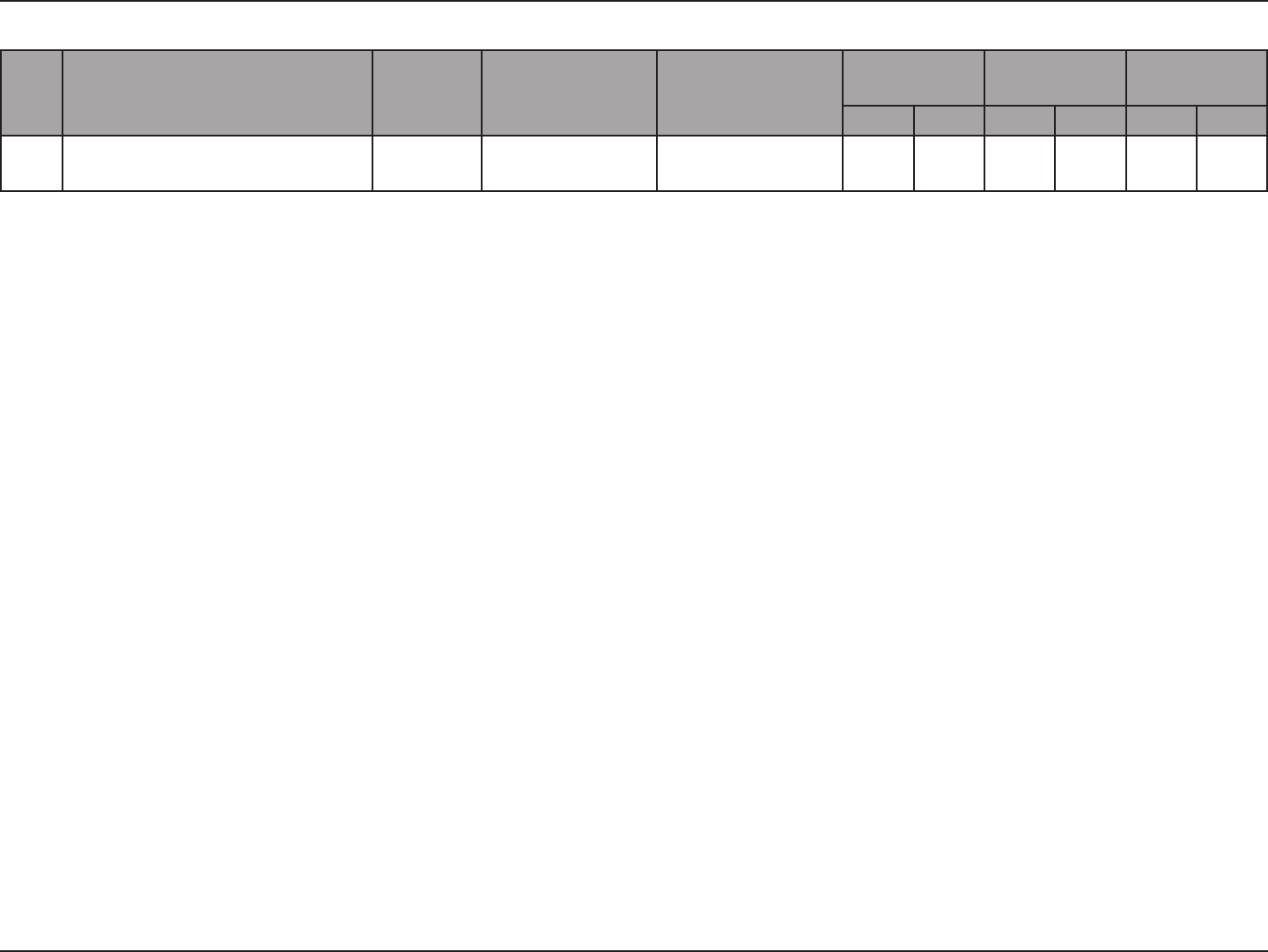
110D-Link DAP-1665 User Manual
Appendix C - Regulatory Information
Table for Filed Antenna
Ant. Brand P/N Antenna Type Connector Antenna
Gain (dBi)
Cable Loss
(dBi)
True Gain
(dBi)
2.4 G 5 G 2.4 G 5 G 2.4 G 5 G
1Whayu and Ren Feng
(second source) 290-20187 Dipole Antenna SMA Plug Reverse 1.8 2.8 0.5 1 1.3 1.8
Radiation Exposure Statement
This equipment complies with ISED radiation exposure limits set forth for an uncontrolled environment. This equipment should be installed and
operated with minimum distance 20 cm between the radiator and your body.
Déclaration d'exposition aux radiations
Cet équipement est conforme aux limites d'exposition aux rayonnements ISED établies pour un environnement non contrôlé. Cet équipement
doit être installé et utilisé avec un minimum de 20 cm de distance entre la source de rayonnement et votre corps.
Japan Voluntary Control Council for Interference Statement
この装置は、クラス B情報技術装置です。この装置は、家庭環境で使用することを目的としていますが、この装置がラジオやテレビジョン受信
機に近接して使用されると、受信障害を引き起こすことがあります。
取扱説明書に従って正しい取り扱いをして下さい。
VCCI-B
Japan Voluntary Control Council for Interference Statement
This is a Class B product based on the standard of the VCCI Council. If this is used near a radio or television receiver in a domestic environment, it
may cause radio interference. Install and use the equipment according to the instruction manual.
電波法により5GHz帯は屋内使用に限ります。

111D-Link DAP-1665 User Manual
Appendix C - Regulatory Information
Frequency Band(s)
Frequenzband
Fréquence bande(s)
Bandas de Frecuencia
Frequenza/e
Frequentie(s)
Max. Output Power (EIRP)
Max. Output Power
Consommation d’énergie max.
Potencia máxima de Salida
Potenza max. Output
Max. Output Power
5 G
5.15 – 5.25 GHz 200 mW
5.25 – 5.35 GHz 200 mW
5.47 – 5.725 GHz 1 W
2.4 G 2.4 – 2.4835 GHz 100 mW

112D-Link DAP-1665 User Manual
Appendix C - Regulatory Information
European Community Declaration of Conformity:
Česky [Czech]
Tímto D-Link Corporation prohlašuje, že tento produkt, jeho příslušenství a software jsou v souladu se směrnicí
2014/53/EU. Celý text ES prohlášení o shodě vydaného EU a o rmwaru produktu lze stáhnout na stránkách k
produktu www.dlink.com.
Dansk [Danish]
D-Link Corporation erklærer herved, at dette produkt, tilbehør og software er i overensstemmelse med direktiv
2014/53/EU. Den fulde tekst i EU-overensstemmelseserklæringen og produktrmware kan wnloades fra
produktsiden hos www.dlink.com.
Deutsch [German]
Hiermit erklärt die D-Link Corporation, dass dieses Produkt, das Zubehör und die Software der Richtlinie 2014/53/
EU entsprechen. Der vollständige Text der Konformitätserklärung der Europäischen Gemeinschaft sowie die
Firmware zum Produkt stehen Ihnen zum Herunterladen von der Produktseite im Internet auf www.dlink.com zur
Verfügung.
Eesti [Estonian]
Käesolevaga kinnitab D-Link Corporation, et see toode, tarvikud ja tarkvara on kooskõlas direktiiviga 2014/53/EL.
Euroopa Liidu vastavusdeklaratsiooni täistekst ja toote püsivara on allalaadimiseks saadaval tootelehel www.dlink.
com.
English
Hereby, D-Link Corporation, declares that this product, accessories, and software are in compliance with directive
2014/53/EU. The full text of the EU Declaration of Conformity and product rmware are available for download
from the product page at www.dlink.com
Español [Spanish]
Por la presente, D-Link Corporation declara que este producto, accesorios y software cumplen con las directivas
2014/53/UE. El texto completo de la declaración de conformidad de la UE y el rmware del producto están
disponibles y se pueden descargar desde la página del producto en www.dlink.com.
Ελληνική [Greek]
Με την παρούσα, η D-Link Corporation δηλώνει ότι αυτό το προϊόν, τα αξεσουάρ και το λογισμικό
συμμορφώνονται με την Οδηγία 2014/53/ΕΕ. Το πλήρες κείμενο της δήλωσης συμμόρφωσης της ΕΕ και το
υλικολογισμικό του προϊόντος είναι διαθέσιμα για λήψη από τη σελίδα του προϊόντος στην τοποθεσία www.dlink.
com.
Français [French]
Par les présentes, D-Link Corporation déclare que ce produit, ces accessoires et ce logiciel sont conformes aux
directives 2014/53/UE.Le texte complet de la déclaration de conformité de l'UE et le icroprogramme du produit
sont disponibles au téléchargement sur la page des produits à www.dlink.com.
Italiano [Italian]
Con la presente, D-Link Corporation dichiara che questo prodotto, i relativi accessori e il software sono conformi
alla direttiva 2014/53/UE. Il testo completo della dichiarazione di conformità UE e il rmware del prodotto sono
disponibili per il download dalla pagina del prodotto su www.dlink.com.

113D-Link DAP-1665 User Manual
Appendix C - Regulatory Information
Latviski [Latvian]
Ar šo uzņēmums D-Link Corporation apliecina, ka šis produkts, piederumi un programmatūra atbilst direktīvai
2014/53/ES. ES atbilstības deklarācijas pilno tekstu un produkta aparātprogrammatūru var lejupielādēt attiecīgā
produkta lapā vietnē www.dlink.com.
Lietuvių [Lithuanian]
Šiuo dokumentu „D-Link Corporation“ pareiškia, kad šis gaminys, priedai ir programinė įranga atitinka direktyvą
2014/53/ES. Visą ES atitikties deklaracijos tekstą ir gaminio programinę aparatinę įrangą galima atsisiųsti iš gaminio
puslapio adresu www.dlink.com.
Nederlands [Dutch]
Hierbij verklaart D-Link Corporation dat dit product, accessoires en software voldoen aan de richtlijnen 2014/53/
EU. De volledige tekst van de EU conformiteitsverklaring en productrmware is beschikbaar voor download van de
productpagina op www.dlink.com.
Malti [Maltese]
Bil-preżenti, D-Link Corporation tiddikjara li dan il-prodott, l-aċċessorji, u s-software huma konformi mad-Direttiva
2014/53/UE. Tista’ tniżżel it-test sħiħ tad-dikjarazzjoni ta’ konformità tal-UE u l-rmware tal-prodott mill-paġna tal-
prodott fuq www.dlink.com.
Magyar [Hungarian]
Ezennel a D-Link Corporation kijelenti, hogy a jelen termék, annak tartozékai és szoftvere megfelelnek a 2014/53/
EU sz. rendeletek rendelkezéseinek. Az EU Megfelelőségi nyilatkozat teljes szövege és a termék rmware a termék
oldaláról tölthető le a www.dlink.com címen.
Polski [Polish]
D-Link Corporation niniejszym oświadcza, że ten produkt, akcesoria oraz oprogramowanie są zgodne z
dyrektywami 2014/53/EU. Pełen tekst deklaracji zgodności UE oraz oprogramowanie sprzętowe do produktu
można pobrać na stronie produktu w witrynie www.dlink.com.
Português [Portuguese] Desta forma, a D-Link Corporation declara que este produto, os acessórios e o software estão em conformidade
com a diretiva 2014/53/UE. O texto completo da declaração de conformidade da UE e do rmware
Slovensko[Slovenian]
Podjetje D-Link Corporation s tem izjavlja, da so ta izdelek, dodatna oprema in programnska oprema skladni z
direktivami 2014/53/EU. Celotno besedilo izjave o skladnosti EU in vdelana programska oprema sta na voljo za
prenos na strani izdelka na www.dlink.com.
Slovensky [Slovak]
Spoločnosť D-Link týmto vyhlasuje, že tento produkt, príslušenstvo a softvér sú v súlade so smernicou 214/53/
EÚ. Úplné znenie vyhlásenia EÚ o zhode a rmvéri produktu sú k dispozícii na prevzatie zo stránky produktu www.
dlink.com.
Suomi [Finnish]
D-Link Corporation täten vakuuttaa, että tämä tuote, lisävarusteet ja ohjelmisto ovat direktiivin 2014/53/EU
vaatimusten mukaisia. Täydellinen EU-vaatimustenmukaisuusvakuutus samoin kuin tuotteen laiteohjelmisto ovat
ladattavissa osoitteesta www.dlink.com.
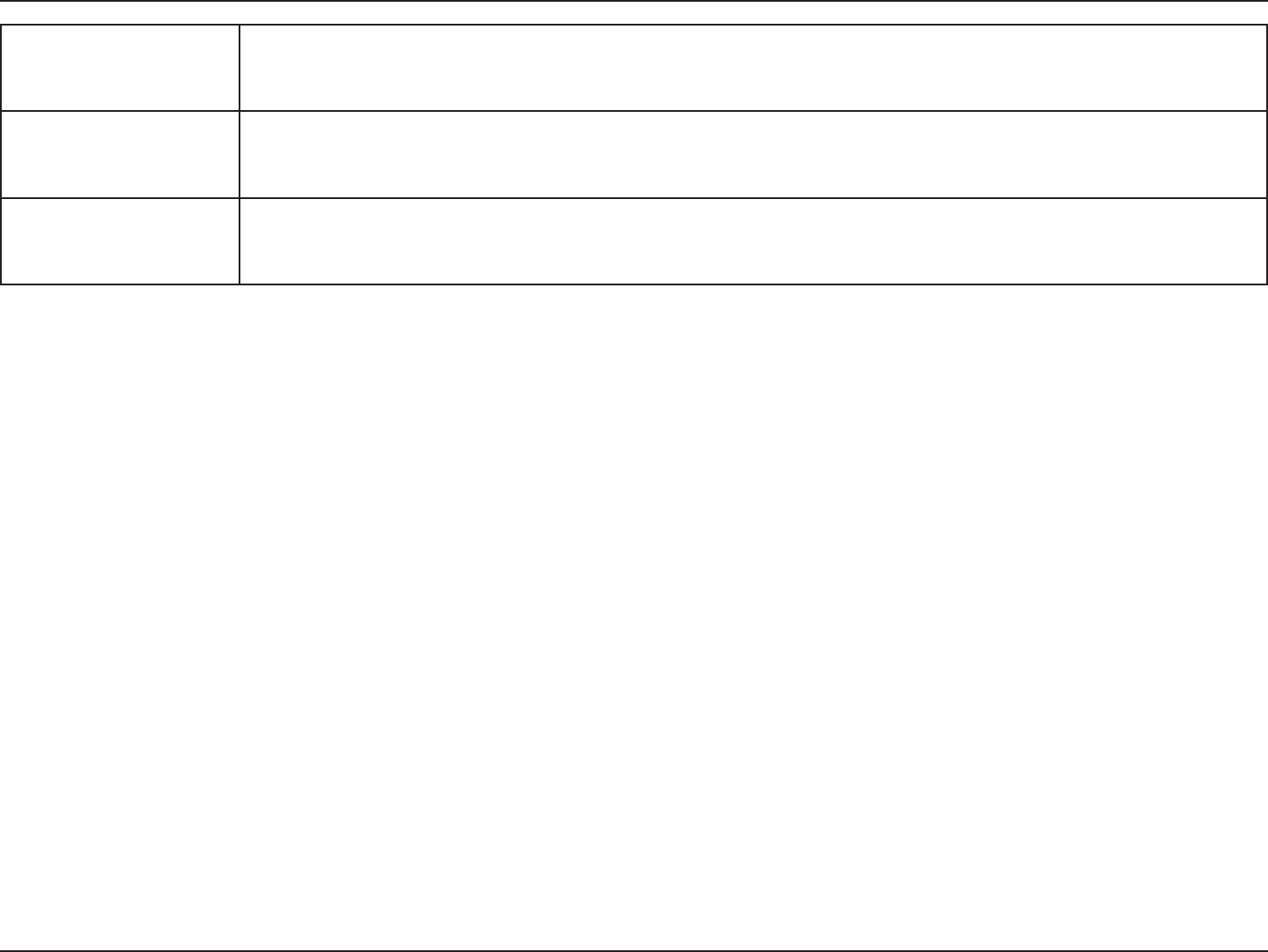
114D-Link DAP-1665 User Manual
Appendix C - Regulatory Information
Svenska[Swedish]
D-Link Corporation försäkrar härmed att denna produkt, tillbehör och programvara överensstämmer med
direktiv 2014/53/EU. Hela texten med EU-försäkran om överensstämmelse och produkt-rmware kan hämtas från
produktsidan på www.dlink.com.
Íslenska [Icelandic]
Hér með lýsir D-Link Corporation því yr að þessi vara, fylgihlutir og hugbúnaður eru í samræmi við tilskipun
2014/53/EB. Sækja má ESB-samræmisyrlýsinguna í heild sinni og fastbúnað vörunnar af vefsíðu vörunnar á www.
dlink.com.
Norsk [Norwegian]
Herved erklærer D-Link Corporation at dette produktet, tilbehøret og programvaren er i samsvar med direktivet
2014/53/EU. Den fullstendige teksten i EU-erklæring om samsvar og produktets fastvare er tilgjengelig for
nedlasting fra produktsiden på www.dlink.com.
Warning Statement:
The power outlet should be near the device and easily accessible.

115D-Link DAP-1665 User Manual
Appendix C - Regulatory Information
NOTICE OF WIRELESS RADIO LAN USAGE IN THE EUROPEAN COMMUNITY FOR WIRELESS PRODUCT ONLY:
• This device is restricted to indoor use when operated in the European Community using channels in the 5.15-5.35 GHz band to reduce the
potential for interference.
• This device is a 2.4 GHz wideband transmission system (transceiver), intended for use in all EU member states and EFTA countries. This
equipment may be operated in AL, AD, BE, BG, DK, DE, FI, FR, GR, GW, IS, IT, HR, LI, LU, MT, MK, MD, MC, NL, NO, AT, PL, PT, RO, SM, SE, RS, SK, ES,
CI, HU, and CY.
Usage Notes:
• To remain in conformance with European National spectrum usage regulations, frequency and channel limitations will be applied on the
products according to the country where the equipment will be deployed.
• This device is restricted from functioning in Ad-hoc mode while operating in 5 GHz. Ad-hoc mode is direct peer-to-peer communication
between two client devices without an Access Point.
• Access points will support DFS (Dynamic Frequency Selection) and TPC (Transmit Power Control) functionality as required when operating in
5 GHz band within the EU.
• Please refer to the product manual or datasheet to check whether your product uses 2.4 GHz and/or 5 GHz wireless.
HINWEIS ZUR VERWENDUNG VON DRAHTLOS-NETZWERK (WLAN) IN DER EUROPÄISCHEN GEMEINSCHAFT ( NUR FÜR
EIN DRAHTLOSES PRODUKT )
• Der Betrieb dieses Geräts in der Europäischen Gemeinschaft bei Nutzung von Kanälen im 5,15-5,35 GHz Frequenzband ist ausschließlich auf
Innenräume beschränkt, um das Interferenzpotential zu reduzieren.
• Bei diesem Gerät handelt es sich um ein zum Einsatz in allen EU-Mitgliedsstaaten und in EFTA-Ländern - ausgenommen Frankreich. Der
Betrieb dieses Geräts ist in den folgenden Ländern erlaubt: AL, AD, BE, BG, DK, DE, FI, FR, GR, GW, IS, IT, HR, LI, LU, MT, MK, MD, MC, NL, NO, AT,
PL, PT, RO, SM, SE, RS, SK, ES, CI, HU, CY
Gebrauchshinweise:
• Um den in Europa geltenden nationalen Vorschriften zum Nutzen des Funkspektrums weiterhin zu entsprechen, werden Frequenz und
Kanalbeschränkungen, dem jeweiligen Land, in dem das Gerät zum Einsatz kommt, entsprechend, auf die Produkte angewandt.
• Die Funktionalität im Ad-hoc-Modus bei Betrieb auf 5 GHz ist für dieses Gerät eingeschränkt. Bei dem Ad-hoc-Modus handelt es sich um eine
Peer-to-Peer-Kommunikation zwischen zwei Client-Geräten ohneeinen Access Point.
• Access Points unterstützen die Funktionen DFS (Dynamic Frequency Selection) und TPC (Transmit Power Control) wie erforderlich bei Betrieb
auf 5 GHz innerhalb der EU.
• Bitte schlagen Sie im Handbuch oder Datenblatt nach nach, ob Ihr Gerät eine 2,4 GHz und / oder 5 GHz Verbindung nutzt.

116D-Link DAP-1665 User Manual
Appendix C - Regulatory Information
AVIS CONCERNANT L'UTILISATION DE LA RADIO SANS FIL LAN DANS LA COMMUNAUTÉ EUROPÉENNE (UNIQUEMENT
POUR LES PRODUITS SANS FIL)
• Cet appareil est limité à un usage intérieur lorsqu'il est utilisé dans la Communauté européenne sur les canaux de la bande de 5,15 à 5,35 GHz
an de réduire les risques d'interférences.
• Cet appareil est un système de transmission à large bande (émetteur-récepteur) de 2,4 GHz, destiné à être utilisé dans tous les États-
membres de l'UE et les pays de l'AELE. Cet équipement peut être utilisé dans les pays suivants : AL, AD, BE , BG, DK, DE, FI, FR, GR, GW, IS, IT,
HR, LI, LU, MT , MK, MD, MC, NL, NO, AT, PL, PT, RO, SM, SE, RS, SK, ES, CI, HU, CY
Notes d'utilisation:
• Pour rester en conformité avec la réglementation nationale européenne en matière d'utilisation du spectre, des limites de fréquence et de
canal seront appliquées aux produits selon le pays où l'équipement sera déployé.
• Cet appareil ne peut pas utiliser le mode Ad-hoc lorsqu'il fonctionne dans la bande de 5 GHz. Le mode Adhoc fournit une communication
directe pair à pair entre deux périphériques clients sans point d'accès.
• Les points d'accès prendront en charge les fonctionnalités DFS (Dynamic Frequency Selection) et TPC (Transmit Power Control) au besoin lors
du fonctionnement dans la bande de 5 GHz au sein de l'UE.
• Merci de vous référer au guide d'utilisation ou de la che technique an de vérier si votre produit utilise 2.4 GHz et/ou 5 GHz sans l.
AVISO DE USO DE LA LAN DE RADIO INALÁMBRICA EN LA COMUNIDAD EUROPEA (SOLO PARA EL PRODUCTO
INALÁMBRICO)
• El uso de este dispositivo está restringido a interiores cuando funciona en la Comunidad Europea utilizando canales en la banda de 5,15-5,35
GHz, para reducir la posibilidad de interferencias.
• Este dispositivo es un sistema de transmisión (transceptor) de banda ancha de 2,4 GHz, pensado para su uso en todos los estados miembros
de la UE y en los países de la AELC. Este equipo se puede utilizar en AL, AD, BE, BG, DK, DE, FI, FR, GR, GW, IS, IT, HR, LI, LU, MT, MK, MD, MC, NL,
NO, AT, PL, PT, RO, SM, SE, RS, SK, ES, CI, HU, CY
Notas de uso:
• Para seguir cumpliendo las normas europeas de uso del espectro nacional, se aplicarán limitaciones de frecuencia y canal en los productos
en función del país en el que se pondrá en funcionamiento el equipo.
• Este dispositivo tiene restringido el funcionamiento en modo Ad-hoc mientras funcione a 5 Ghz. El modo Ad-hoc es la comunicación directa
de igual a igual entre dos dispositivos cliente sin un punto de acceso.
• Los puntos de acceso admitirán la funcionalidad DFS (Selección de frecuencia dinámica) y TPC (Control de la potencia de transmisión) si es
necesario cuando funcionan a 5 Ghz dentro de la UE.
• Por favor compruebe el manual o la cha de producto para comprobar si el producto utiliza las bandas inalámbricas de 2.4 GHz y/o la de 5
GHz.

117D-Link DAP-1665 User Manual
Appendix C - Regulatory Information
AVVISO PER L’USO DI LAN RADIO WIRELESS NELLA COMUNITÀ EUROPEA (SOLO PER PRODOTTI WIRELESS)
• Nella Comunità europea, l’uso di questo dispositivo è limitato esclusivamente agli ambienti interni sui canali compresi nella banda da 5,15 a
5,35 GHz al ne di ridurre potenziali interferenze. Questo dispositivo è un sistema di trasmissione a banda larga a 2,4 GHz (ricetrasmittente),
destinato all’uso in tutti gli stati membri dell’Unione europea e nei paesi EFTA.
• Questo dispositivo può essere utilizzato in AL, AD, BE, BG, DK, DE, FI, FR, GR, GW, IS, IT, HR, LI, LU, MT, MK, MD, MC, NL, NO, AT, PL, PT, RO, SM,
SE, RS, SK, ES, CI, HU, CY
Note per l’uso
• Al ne di mantenere la conformità alle normative nazionali europee per l’uso dello spettro di frequenze, saranno applicate limitazioni sulle
frequenze e sui canali per il prodotto in conformità alle normative del paese in cui il dispositivo viene utilizzato.
• Questo dispositivo non può essere attivato in modalità Ad-hoc durante il funzionamento a 5 Ghz. La modalità Ad-hoc è una comunicazione
diretta peer-to-peer fra due dispositivi client senza un punto di accesso.
• I punti di accesso supportano le funzionalità DFS (Dynamic Frequency Selection) e TPC (Transmit Power Control) richieste per operare a 5 Ghz
nell’Unione europea.
• Ti invitiamo a fare riferimento al manuale del prodotto o alla scheda tecnica per vericare se il tuo prodotto utilizza le frequenze 2,4 GHz e/o
5 GHz.
KENNISGEVING VAN DRAADLOOS RADIO LAN-GEBRUIK IN DE EUROPESE GEMEENSCHAP (ALLEEN VOOR
DRAADLOOS PRODUCT)
• Dit toestel is beperkt tot gebruik binnenshuis wanneer het wordt gebruikt in de Europese Gemeenschap gebruik makend van kanalen in de
5.15-5.35 GHz band om de kans op interferentie te beperken.
• Dit toestel is een 2.4 GHz breedband transmissiesysteem (transceiver) dat bedoeld is voor gebruik in alle EU lidstaten en EFTA landen. Deze
uitrusting mag gebruikt worden in AL, AD, BE, BG, DK, DE, FI, FR, GR, GW, IS, IT, HR, LI, LU, MT, MK, MD, MC, NL, NO, AT, PL, PT, RO, SM, SE, RS, SK,
ES, CI, HU, CY
Gebruiksaanwijzingen:
• Om de gebruiksvoorschriften van het Europese Nationale spectrum na te leven, zullen frequentie- en kanaalbeperkingen worden toegepast
op de producten volgens het land waar de uitrusting gebruikt zal worden.
• Dit toestel kan niet functioneren in Ad-hoc mode wanneer het gebruikt wordt in 5 GHz. Ad-hoc mode is directe peer-to-peer communicatie
tussen twee klantenapparaten zonder een toegangspunt.
• Toegangspunten ondersteunen DFS (Dynamic Frequency Selection) en TPC (Transmit Power Control) functionaliteit zoals vereist bij gebruik
in 5 GHz binnen de EU.
• Raadpleeg de handleiding of de datasheet om te controleren of uw product gebruik maakt van 2.4 GHz en/of 5 GHz.

118D-Link DAP-1665 User Manual
Appendix C - Regulatory Information
SAFETY INSTRUCTIONS
The following general safety guidelines are provided to help ensure your own personal safety and protect your product from potential damage.
Remember to consult the product user instructions for more details.
• Static electricity can be harmful to electronic components. Discharge static electricity from your body (i.e. touching grounded bare metal)
before touching the product.
• Do not attempt to service the product and never disassemble the product. For some products with a user replaceable battery, please read
and follow the instructions in the user manual.
• Do not spill food or liquid on your product and never push any objects into the openings of your product.
• Do not use this product near water, areas with high humidity, or condensation unless the product is specically rated for outdoor application.
• Keep the product away from radiators and other heat sources.
• Always unplug the product from mains power before cleaning and use a dry lint free cloth only.
SICHERHEITSVORSCHRIFTEN
Die folgenden allgemeinen Sicherheitsvorschriften dienen als Hilfe zur Gewährleistung Ihrer eigenen Sicherheit und zum Schutz Ihres Produkts.
Weitere Details nden Sie in den Benutzeranleitungen zum Produkt.
• Statische Elektrizität kann elektronischen Komponenten schaden. Um Schäden durch statische Auadung zu vermeiden, leiten Sie
elektrostatische Ladungen von Ihrem Körper ab,
(z. B. durch Berühren eines geerdeten blanken Metallteils), bevor Sie das Produkt berühren.
• Unterlassen Sie jeden Versuch, das Produkt zu warten, und versuchen Sie nicht, es in seine Bestandteile zu zerlegen. Für einige Produkte mit
austauschbaren Akkus lesen Sie bitte das Benutzerhandbuch und befolgen Sie die dort beschriebenen Anleitungen.
• Vermeiden Sie, dass Speisen oder Flüssigkeiten auf Ihr Produkt gelangen, und stecken Sie keine Gegenstände in die Gehäuseschlitze oder
-önungen Ihres Produkts.
• Verwenden Sie dieses Produkt nicht in unmittelbarer Nähe von Wasser und nicht in Bereichen mit hoher Luftfeuchtigkeit oder Kondensation,
es sei denn, es ist speziell zur Nutzung in Außenbereichen vorgesehen und eingestuft.
• Halten Sie das Produkt von Heizkörpern und anderen Quellen fern, die Wärme erzeugen.
• Trennen Sie das Produkt immer von der Stromzufuhr, bevor Sie es reinigen und verwenden Sie dazu ausschließlich ein trockenes fusselfreies
Tuch.

119D-Link DAP-1665 User Manual
Appendix C - Regulatory Information
CONSIGNES DE SÉCURITÉ
Les consignes générales de sécurité ci-après sont fournies an d’assurer votre sécurité personnelle et de protéger le produit d’éventuels
dommages. Veuillez consulter les consignes d’utilisation du produit pour plus de détails.
• L’électricité statique peut endommager les composants électroniques. Déchargez l’électricité statique de votre corps (en touchant un objet
en métal relié à la terre par exemple) avant de toucher le produit.
• N’essayez pas d’intervenir sur le produit et ne le démontez jamais. Pour certains produits contenant une batterie remplaçable par l’utilisateur,
veuillez lire et suivre les consignes contenues dans le manuel d’utilisation.
• Ne renversez pas d’aliments ou de liquide sur le produit et n’insérez jamais d’objets dans les orices.
• N’utilisez pas ce produit à proximité d’un point d’eau, de zones très humides ou de condensation sauf si le produit a été spéciquement
conçu pour une application extérieure.
• Éloignez le produit des radiateurs et autres sources de chaleur.
• Débranchez toujours le produit de l’alimentation avant de le nettoyer et utilisez uniquement un chion sec non pelucheux.
INSTRUCCIONES DE SEGURIDAD
Las siguientes directrices de seguridad general se facilitan para ayudarle a garantizar su propia seguridad personal y para proteger el producto
frente a posibles daños. No olvide consultar las instrucciones del usuario del producto para obtener más información.
• La electricidad estática puede resultar nociva para los componentes electrónicos. Descargue la electricidad estática de su cuerpo (p. ej.,
tocando algún metal sin revestimiento conectado a tierra) antes de tocar el producto.
• No intente realizar el mantenimiento del producto ni lo desmonte nunca. Para algunos productos con batería reemplazable por el usuario,
lea y siga las instrucciones del manual de usuario.
• No derrame comida o líquidos sobre el producto y nunca deje que caigan objetos en las aberturas del mismo.
• No utilice este producto cerca del agua, en zonas con humedad o condensación elevadas a menos que el producto esté clasicado
especícamente para aplicación en exteriores.
• Mantenga el producto alejado de los radiadores y de otras fuentes de calor.
• Desenchufe siempre el producto de la alimentación de red antes de limpiarlo y utilice solo un paño seco sin pelusa.

120D-Link DAP-1665 User Manual
Appendix C - Regulatory Information
ISTRUZIONI PER LA SICUREZZA
Le seguenti linee guida sulla sicurezza sono fornite per contribuire a garantire la sicurezza personale degli utenti e a proteggere il prodotto da
potenziali danni. Per maggiori dettagli, consultare le istruzioni per l’utente del prodotto.
• L’elettricità statica può essere pericolosa per i componenti elettronici. Scaricare l’elettricità statica dal corpo (ad esempio toccando una parte
metallica collegata a terra) prima di toccare il prodotto.
• Non cercare di riparare il prodotto e non smontarlo mai. Per alcuni prodotti dotati di batteria sostituibile dall’utente, leggere e seguire le
istruzioni riportate nel manuale dell’utente.
• Non versare cibi o liquidi sul prodotto e non spingere mai alcun oggetto nelle aperture del prodotto.
• Non usare questo prodotto vicino all’acqua, in aree con elevato grado di umidità o soggette a condensa a meno che il prodotto non sia
specicatamente approvato per uso in ambienti esterni.
• Tenere il prodotto lontano da caloriferi e altre fonti di calore.
• Scollegare sempre il prodotto dalla presa elettrica prima di pulirlo e usare solo un panno asciutto che non lasci lacce.
VEILIGHEIDSINFORMATIE
De volgende algemene veiligheidsinformatie werd verstrekt om uw eigen persoonlijke veiligheid te waarborgen en uw product te beschermen
tegen mogelijke schade. Denk eraan om de gebruikersinstructies van het product te raadplegen voor meer informatie.
• Statische elektriciteit kan schadelijk zijn voor elektronische componenten. Ontlaad de statische elektriciteit van uw lichaam (d.w.z. het
aanraken van geaard bloot metaal) voordat uhet product aanraakt.
• U mag nooit proberen het product te onderhouden en u mag het product nooit demonteren. Voor sommige producten met door de
gebruiker te vervangen batterij, dient u de instructies in de gebruikershandleiding te lezen en te volgen.
• Mors geen voedsel of vloeistof op uw product en u mag nooit voorwerpen in de openingen van uw product duwen.
• Gebruik dit product niet in de buurt van water, gebieden met hoge vochtigheid of condensatie, tenzij het product speciek geclassiceerd is
voor gebruik buitenshuis.
• Houd het product uit de buurt van radiators en andere warmtebronnen.
• U dient het product steeds los te koppelen van de stroom voordat u het reinigt en gebruik uitsluitend een droge pluisvrije doek.

121D-Link DAP-1665 User Manual
Appendix C - Regulatory Information
Disposing of and Recycling Your Product
ENGLISH EN
This symbol on the product or packaging means that according to local laws and regulations this product should be not be disposed
of in household waste but sent for recycling. Please take it to a collection point designated by your local authorities once it has
reached the end of its life, some will accept products for free. By recycling the product and its packaging in this manner you help to
conserve the environment and protect human health.
D-Link and the Environment
At D-Link, we understand and are committed to reducing any impact our operations and products may have on the environment. To minimise
this impact D-Link designs and builds its products to be as environmentally friendly as possible, by using recyclable, low toxic materials in both
products and packaging.
D-Link recommends that you always switch o or unplug your D-Link products when they are not in use. By doing so you will help to save energy
and reduce CO2 emissions.
To learn more about our environmentally responsible products and packaging please visit www.dlinkgreen.com.
DEUTSCH DE
Dieses Symbol auf dem Produkt oder der Verpackung weist darauf hin, dass dieses Produkt gemäß bestehender örtlicher Gesetze
und Vorschriften nicht über den normalen Hausmüll entsorgt werden sollte, sondern einer Wiederverwertung zuzuführen ist. Bringen
Sie es bitte zu einer von Ihrer Kommunalbehörde entsprechend amtlich ausgewiesenen Sammelstelle, sobald das Produkt das Ende
seiner Nutzungsdauer erreicht hat. Für die Annahme solcher Produkte erheben einige dieser Stellen keine Gebühren. Durch ein auf
diese Weise durchgeführtes Recycling des Produkts und seiner Verpackung helfen Sie, die Umwelt zu schonen und die menschliche
Gesundheit zu schützen.
D-Link und die Umwelt
D-Link ist sich den möglichen Auswirkungen seiner Geschäftstätigkeiten und seiner Produkte auf die Umwelt bewusst und fühlt sich verpichtet,
diese entsprechend zu mindern. Zu diesem Zweck entwickelt und stellt D-Link seine Produkte mit dem Ziel größtmöglicher Umweltfreundlichkeit
her und verwendet wiederverwertbare, schadstoarme Materialien bei Produktherstellung und Verpackung.
D-Link empehlt, Ihre Produkte von D-Link, wenn nicht in Gebrauch, immer auszuschalten oder vom Netz zu nehmen. Auf diese Weise helfen
Sie, Energie zu sparen und CO2-Emissionen zu reduzieren.
Wenn Sie mehr über unsere umweltgerechten Produkte und Verpackungen wissen möchten, nden Sie entsprechende Informationen im Internet
unter www.dlinkgreen.com.

122D-Link DAP-1665 User Manual
Appendix C - Regulatory Information
FRANÇAIS FR
Ce symbole apposé sur le produit ou son emballage signie que, conformément aux lois et règlementations locales, ce produit ne
doit pas être éliminé avec les déchets domestiques mais recyclé. Veuillez le rapporter à un point de collecte prévu à cet eet par les
autorités locales; certains accepteront vos produits gratuitement. En recyclant le produit et son emballage de cette manière, vous
aidez à préserver l’environnement et à protéger la santé de l’homme.
D-Link et l’environnement
Chez D-Link, nous sommes conscients de l'impact de nos opérations et produits sur l'environnement et nous engageons à le réduire. Pour limiter
cet impact, D-Link conçoit et fabrique ses produits de manière aussi écologique que possible, en utilisant des matériaux recyclables et faiblement
toxiques, tant dans ses produits que ses emballages.
D-Link recommande de toujours éteindre ou débrancher vos produits D-Link lorsque vous ne les utilisez pas. Vous réaliserez ainsi des économies
d’énergie et réduirez vos émissions de CO2.
Pour en savoir plus sur les produits et emballages respectueux de l’environnement, veuillez consulter le www.dlinkgreen.com.
ESPAÑOL ES
Este símbolo en el producto o el embalaje signica que, de acuerdo con la legislación y la normativa local, este producto no se debe
desechar en la basura doméstica sino que se debe reciclar. Llévelo a un punto de recogida designado por las autoridades locales una
vez que ha llegado al n de su vida útil; algunos de ellos aceptan recogerlos de forma gratuita. Al reciclar el producto y su embalaje
de esta forma, contribuye a preservar el medio ambiente y a proteger la salud de los seres humanos.
D-Link y el medio ambiente
En D-Link, comprendemos y estamos comprometidos con la reducción del impacto que puedan tener nuestras actividades y nuestros productos
en el medio ambiente. Para reducir este impacto, D-Link diseña y fabrica sus productos para que sean lo más ecológicos posible, utilizando
materiales reciclables y de baja toxicidad tanto en los productos como en el embalaje.
D-Link recomienda apagar o desenchufar los productos D-Link cuando no se estén utilizando. Al hacerlo, contribuirá a ahorrar energía y a reducir
las emisiones de CO2.
Para obtener más información acerca de nuestros productos y embalajes ecológicos, visite el sitio www.dlinkgreen.com.

123D-Link DAP-1665 User Manual
Appendix C - Regulatory Information
ITALIANO IT
La presenza di questo simbolo sul prodotto o sulla confezione del prodotto indica che, in conformità alle leggi e alle normative locali,
questo prodotto non deve essere smaltito nei riuti domestici, ma avviato al riciclo. Una volta terminato il ciclo di vita utile, portare il
prodotto presso un punto di raccolta indicato dalle autorità locali. Alcuni questi punti di raccolta accettano gratuitamente i prodotti
da riciclare. Scegliendo di riciclare il prodotto e il relativo imballaggio, si contribuirà a preservare l'ambiente e a salvaguardare la
salute umana.
D-Link e l'ambiente
D-Link cerca da sempre di ridurre l'impatto ambientale dei propri stabilimenti e dei propri prodotti. Allo scopo di ridurre al minimo tale impatto,
D-Link progetta e realizza i propri prodotti in modo che rispettino il più possibile l'ambiente, utilizzando materiali riciclabili a basso tasso di
tossicità sia per i prodotti che per gli imballaggi.
D-Link raccomanda di spegnere sempre i prodotti D-Link o di scollegarne la spina quando non vengono utilizzati. In questo modo si contribuirà
a risparmiare energia e a ridurre le emissioni di anidride carbonica.
Per ulteriori informazioni sui prodotti e sugli imballaggi D-Link a ridotto impatto ambientale, visitate il sito all'indirizzo www.dlinkgreen.com.
NEDERLANDS NL
Dit symbool op het product of de verpakking betekent dat dit product volgens de plaatselijke wetgeving niet mag worden weggegooid
met het huishoudelijk afval, maar voor recyclage moeten worden ingeleverd. Zodra het product het einde van de levensduur heeft
bereikt, dient u het naar een inzamelpunt te brengen dat hiertoe werd aangeduid door uw plaatselijke autoriteiten, sommige
autoriteiten accepteren producten zonder dat u hiervoor dient te betalen. Door het product en de verpakking op deze manier te
recyclen helpt u het milieu en de gezondheid van de mens te beschermen.
D-Link en het milieu
Bij D-Link spannen we ons in om de impact van onze handelingen en producten op het milieu te beperken. Om deze impact te beperken, ontwerpt
en bouwt D-Link zijn producten zo milieuvriendelijk mogelijk, door het gebruik van recycleerbare producten met lage toxiciteit in product en
verpakking.
D-Link raadt aan om steeds uw D-Link producten uit te schakelen of uit de stekker te halen wanneer u ze niet gebruikt. Door dit te doen bespaart
u energie en beperkt u de CO2-emissies.
Breng een bezoek aan www.dlinkgreen.com voor meer informatie over onze milieuverantwoorde producten en verpakkingen.

124D-Link DAP-1665 User Manual
Appendix C - Regulatory Information
POLSKI PL
Ten symbol umieszczony na produkcie lub opakowaniu oznacza, że zgodnie z miejscowym prawem i lokalnymi przepisami
niniejszego produktu nie wolno wyrzucać jak odpady czy śmieci z gospodarstwa domowego, lecz należy go poddać procesowi
recyklingu. Po zakończeniu użytkowania produktu, niektóre odpowiednie do tego celu podmioty przyjmą takie produkty
nieodpłatnie, dlatego prosimy dostarczyć go do punktu zbiórki wskazanego przez lokalne władze. Poprzez proces recyklingu i
dzięki takiemu postępowaniu z produktem oraz jego opakowaniem, pomogą Państwo chronić środowisko naturalne i dbać o
ludzkie zdrowie.
D-Link i środowisko
D-Link podchodzimy w sposób świadomy do ochrony otoczenia oraz jesteśmy zaangażowani w zmniejszanie wpływu naszych działań i produktów
na środowisko naturalne. W celu zminimalizowania takiego wpływu rma D-Link konstruuje i wytwarza swoje produkty w taki sposób, aby były
one jak najbardziej przyjazne środowisku, stosując do tych celów materiały nadające się do powtórnego wykorzystania, charakteryzujące się
małą toksycznością zarówno w przypadku samych produktów jak i opakowań.
Firma D-Link zaleca, aby Państwo zawsze prawidłowo wyłączali z użytku swoje produkty D-Link, gdy nie są one wykorzystywane. Postępując w
ten sposób pozwalają Państwo oszczędzać energię i zmniejszać emisje CO2.
Aby dowiedzieć się więcej na temat produktów i opakowań mających wpływ na środowisko prosimy zapoznać się ze stroną Internetową www.
dlinkgreen.com.
ČESKY CZ
Tento symbol na výrobku nebo jeho obalu znamená, že podle místně platných předpisů se výrobek nesmí vyhazovat do komunálního
odpadu, ale odeslat k recyklaci. Až výrobek doslouží, odneste jej prosím na sběrné místo určené místními úřady k tomuto účelu.
Některá sběrná místa přijímají výrobky zdarma. Recyklací výrobku i obalu pomáháte chránit životní prostředí i lidské zdraví.
D-Link a životní prostředí
Ve společnosti D-Link jsme si vědomi vlivu našich provozů a výrobků na životní prostředí a snažíme se o minimalizaci těchto vlivů. Proto své
výrobky navrhujeme a vyrábíme tak, aby byly co nejekologičtější, a ve výrobcích i obalech používáme recyklovatelné a nízkotoxické materiály.
Společnost D-Link doporučuje, abyste své výrobky značky D-Link vypnuli nebo vytáhli ze zásuvky vždy, když je nepoužíváte. Pomůžete tak šetřit
energii a snížit emise CO2.
Více informací o našich ekologických výrobcích a obalech najdete na adrese www.dlinkgreen.com.

125D-Link DAP-1665 User Manual
Appendix C - Regulatory Information
MAGYAR HU
Ez a szimbólum a terméken vagy a csomagoláson azt jelenti, hogy a helyi törvényeknek és szabályoknak megfelelően ez a termék
nem semmisíthető meg a háztartási hulladékkal együtt, hanem újrahasznosításra kell küldeni. Kérjük, hogy a termék élettartamának
elteltét követően vigye azt a helyi hatóság által kijelölt gyűjtőhelyre. A termékek egyes helyeken ingyen elhelyezhetők. A termék és
a csomagolás újrahasznosításával segíti védeni a környezetet és az emberek egészségét.
A D-Link és a környezet
A D-Linknél megértjük és elkötelezettek vagyunk a műveleteink és termékeink környezetre gyakorolt hatásainak csökkentésére. Az ezen hatás
csökkentése érdekében a D-Link a lehető leginkább környezetbarát termékeket tervez és gyárt azáltal, hogy újrahasznosítható, alacsony károsanyag-
tartalmú termékeket gyárt és csomagolásokat alkalmaz.
A D-Link azt javasolja, hogy mindig kapcsolja ki vagy húzza ki a D-Link termékeket a tápforrásból, ha nem használja azokat. Ezzel segít az energia
megtakarításában és a széndioxid kibocsátásának csökkentésében.
Környezetbarát termékeinkről és csomagolásainkról további információkat a www.dlinkgreen.com weboldalon tudhat meg.
NORSK NO
Dette symbolet på produktet eller forpakningen betyr at dette produktet ifølge lokale lover og forskrifter ikke skal kastes sammen
med husholdningsavfall, men leveres inn til gjenvinning. Vennligst ta det til et innsamlingssted anvist av lokale myndigheter når
det er kommet til slutten av levetiden. Noen steder aksepteres produkter uten avgift. Ved på denne måten å gjenvinne produktet
og forpakningen hjelper du å verne miljøet og beskytte folks helse.
D-Link og miljøet
Hos D-Link forstår vi oss på og er forpliktet til å minske innvirkningen som vår drift og våre produkter kan ha på miljøet. For å minimalisere denne
innvirkningen designer og lager D-Link produkter som er så miljøvennlig som mulig, ved å bruke resirkulerbare, lav-toksiske materialer både i
produktene og forpakningen.
D-Link anbefaler at du alltid slår av eller frakobler D-Link-produkter når de ikke er i bruk. Ved å gjøre dette hjelper du å spare energi og å redusere
CO2-utslipp.
For mer informasjon angående våre miljøansvarlige produkter og forpakninger kan du gå til www.dlinkgreen.com.

126D-Link DAP-1665 User Manual
Appendix C - Regulatory Information
DANSK DK
Dette symbol på produktet eller emballagen betyder, at dette produkt i henhold til lokale love og regler ikke må bortskaes som
husholdningsaald, mens skal sendes til genbrug. Indlever produktet til et indsamlingssted som angivet af de lokale myndigheder,
når det er nået til slutningen af dets levetid. I nogle tilfælde vil produktet blive modtaget gratis. Ved at indlevere produktet og dets
emballage til genbrug på denne måde bidrager du til at beskytte miljøet og den menneskelige sundhed.
D-Link og miljøet
Hos D-Link forstår vi og bestræber os på at reducere enhver indvirkning, som vores aktiviteter og produkter kan have på miljøet. For at minimere
denne indvirkning designer og producerer D-Link sine produkter, så de er så miljøvenlige som muligt, ved at bruge genanvendelige materialer
med lavt giftighedsniveau i både produkter og emballage.
D-Link anbefaler, at du altid slukker eller frakobler dine D-Link-produkter, når de ikke er i brug. Ved at gøre det bidrager du til at spare energi og
reducere CO2-udledningerne.
Du kan nde ere oplysninger om vores miljømæssigt ansvarlige produkter og emballage på www.dlinkgreen.com.
SUOMI FI
Tämä symboli tuotteen pakkauksessa tarkoittaa, että paikallisten lakien ja säännösten mukaisesti tätä tuotetta ei pidä hävittää
yleisen kotitalousjätteen seassa vaan se tulee toimittaa kierrätettäväksi. Kun tuote on elinkaarensa päässä, toimita se lähimpään
viranomaisten hyväksymään kierrätyspisteeseen. Kierrättämällä käytetyn tuotteen ja sen pakkauksen autat tukemaan sekä ympäristön
että ihmisten terveyttä ja hyvinvointia.
D-Link ja ympäristö
D-Link ymmärtää ympäristönsuojelun tärkeyden ja on sitoutunut vähentämään tuotteistaan ja niiden valmistuksesta ympäristölle mahdollisesti
aiheutuvia haittavaikutuksia. Nämä negatiiviset vaikutukset minimoidakseen D-Link suunnittelee ja valmistaa tuotteensa mahdollisimman
ympäristöystävällisiksi käyttämällä kierrätettäviä, alhaisia pitoisuuksia haitallisia aineita sisältäviä materiaaleja sekä tuotteissaan että niiden
pakkauksissa.
Suosittelemme, että irrotat D-Link-tuotteesi virtalähteestä tai sammutat ne aina, kun ne eivät ole käytössä. Toimimalla näin autat säästämään
energiaa ja vähentämään hiilidioksiidipäästöjä.
Lue lisää ympäristöystävällisistä D-Link-tuotteista ja pakkauksistamme osoitteesta www.dlinkgreen.com.

127D-Link DAP-1665 User Manual
Appendix C - Regulatory Information
SVENSKA SE
Den här symbolen på produkten eller förpackningen betyder att produkten enligt lokala lagar och föreskrifter inte skall kastas i
hushållssoporna utan i stället återvinnas. Ta den vid slutet av dess livslängd till en av din lokala myndighet utsedd uppsamlingsplats,
vissa accepterar produkter utan kostnad. Genom att på detta sätt återvinna produkten och förpackningen hjälper du till att bevara
miljön och skydda människors hälsa.
D-Link och miljön
På D-Link förstår vi och är fast beslutna att minska den påverkan våra verksamheter och produkter kan ha på miljön. För att minska denna påverkan
utformar och bygger D-Link sina produkter för att de ska vara så miljövänliga som möjligt, genom att använda återvinningsbara material med
låg gifthalt i både produkter och förpackningar.
D-Link rekommenderar att du alltid stänger av eller kopplar ur dina D-Link produkter när du inte använder dem. Genom att göra detta hjälper
du till att spara energi och minska utsläpp av koldioxid.
För mer information om våra miljöansvariga produkter och förpackningar www.dlinkgreen.com.
PORTUGUÊS PT
Este símbolo no produto ou embalagem signica que, de acordo com as leis e regulamentações locais, este produto não deverá ser
eliminado juntamente com o lixo doméstico mas enviado para a reciclagem. Transporte-o para um ponto de recolha designado pelas
suas autoridades locais quando este tiver atingido o m da sua vida útil, alguns destes pontos aceitam produtos gratuitamente. Ao
reciclar o produto e respectiva embalagem desta forma, ajuda a preservar o ambiente e protege a saúde humana.
A D-Link e o ambiente
Na D-Link compreendemos e comprometemo-nos com a redução do impacto que as nossas operações e produtos possam ter no ambiente.
Para minimizar este impacto a D-Link concebe e constrói os seus produtos para que estes sejam o mais inofensivos para o ambiente possível,
utilizando meteriais recicláveis e não tóxicos tanto nos produtos como nas embalagens.
A D-Link recomenda que desligue os seus produtos D-Link quando estes não se encontrarem em utilização. Com esta acção ajudará a poupar
energia e reduzir as emissões de CO2.
Para saber mais sobre os nossos produtos e embalagens responsáveis a nível ambiental visite www.dlinkgreen.com.